- +9779851276377
- 977 01 5348594
- [email protected]
- Follow us on:

Manaslu Circuit Trek
Bimthang base camp, view of mount manaslu, you can also, things to know before trip, trip introduction.
Manaslu Circuit Trek is a wonderful opportunity to encircle the world’s eighth highest peak ( Mt. Manaslu ) and explore the rugged trails along with spectacular views of the Himalayas and cultural insights. The trekking trail was an ancient salt trading route that let us pass through beautiful rhododendron forests.
At the same time, we explore local Buddhism and visit monasteries embracing magical landscape views while making our way through the high passes of Larkya La Pass.
Overview of Manaslu Circuit Trek
We start our Manaslu Circuit Trek after you arrive at Kathmandu followed by cultural sightseeing around world heritage sites. Initially, we take a long drive from Kathmandu to Baseri for about 8 to 9 hours. After arrival at Baseri, the starting point of our trekking activity; we cross suspension bridges. And make our way through beautiful forests and Gurung villages towards Maccha Khola.
Further, we make our way through several ascends-descends, natural and cultural exploration while passing through Budhi Gandaki River, ridges, and villages of Jagat, Deng, Namrung, and Samagaon. And hike to a nearby old monastery named Pungyen Gompa.
For proper acclimatization, we take a day’s rest at Samdo. We’ll pass the highest point of the trek, the Larkya La Pass. The Larkya la Pass offers magnificent views of the Annapurna Himalayas, Kangaru, Chio Himal, and Himlung Himal, etc. And each step we take during our ascends and descends seems worthwhile while we see such rejoicing scenery.
In this way, we discover the diversity in culture and topography and finally descend towards Tilije, Tal, and Syange. And finally, after exploring the Manaslu region for about 2 weeks, our Manaslu circuit trekking is accomplished. Then we’ll get back to Kathmandu with all the memories and joy from the Himalayas.
Who can join this trek and how?
The best seasons for Manaslu Circuit Trek would be from March to late May in the spring and early September to late November in autumn. Being on a challenging trek for more than two weeks, it is important to be in good shape and fit.
Hence, a trekker embarking on the Manaslu Round Trek must be physically and mentally prepared before joining the trip. Nepal Mountain Trekkers’ crew will take care of proper acclimatization and all other safety measures. You just need to make sure that you are ready for challenges that come with unforgettable experiences around the Himalayas.
Simply fill out the booking form and let us know about your interest. Or you can contact us directly by sending us an email to join this amazing trek in the Manaslu Region .
If this itinerary doesn’t suit your requirement or if you want to customize it, please feel free to contact us. This trek could be customized as per your required time frame and budget limits.
- Day 1 Arrival in Kathmandu [1,300m/4,264 ft]:
- Day 2 Kathmandu: Sightseeing and Trek Preparation:
- Day 3 Kathmandu to Maccha Khola [1,400m/4,593 ft]: 8 - 9 hours:
- Day 4 Maccha Khola to Jagat [1,410m/ 4,625 ft]: 6 – 7 hrs:
- Day 5 Jagat to Deng [1,804m/5,917 ft]: 6 – 7 hrs:
- Day 6 Deng to Namrung [2,630m/8,626ft]: 6 – 7 hrs:
- Day 7 Namrung to Lho (3,180 m / 10,433 ft) - 4 hours:
- Day 8 Lho to Samagaon [3,530m/11,578 ft]: 5 hours:
- Day 9 Hike to Pungyen Gompa: 6 – 7 hours exploration:
- Day 10 Samagaon to Samdo [3,860m/12,660 ft]: 4 – 5 hours:
- Day 11 Samdo to Dharmasala [4,460m/14, 628 ft]: 4 – 5 hours:
- Day 12 Dharamsala to Larkya la Pass [5,160m/16, 924 ft] to Bimthang [3,720m/12, 201 ft]: 8 – 9 hours:
- Day 13 Bimthang to Tilije [2,300m/7,544ft]: 5 – 6 hours:
- Day 14 Tilije – Tal [1,700m/5,576 ft]: 5 – 6 hours:
- Day 15 Tal – Besishar -Kathmandu 8-9 hours drive.:
- Day 16 Explore at Kathmandu with shopping:
- Day 17 Departure Day:
Detail Itinerary
Day 1 : Arrival in Kathmandu [1,300m/4,264 ft]::
As soon as you arrive at the capital city, Kathmandu, you will be met by a representative from Nepal Mountain Trekkers at International Airport terminals and he will take you to your respective hotel ( Hotel Green Horizon or a similar standard). After checking into the hotel, you can enjoy your free time relaxing in the cozy room or stroll around the tourist hub Thamel area until the end of the day.
Day 2 : Kathmandu: Sightseeing and Trek Preparation::
After having our early meal, we start our day with a visit to Nepal Mountain Trekkers office at Thamel. After being introduced to our team including the tour guide, trekking leader, and director of operations, we head for necessary trekking preparations, getting needed equipment with the initiation of Kathmandu sightseeing around world heritage sites. Kathmandu Durbar Square, Swayambhunath Stupa, Pashupatinath Temple, and Boudhanath Stupa are UNESCO world heritage sites that we explore till sunset. Overnight stay at a hotel in Kathmandu. B included.
Day 3 : Kathmandu to Maccha Khola [1,400m/4,593 ft]: 8 - 9 hours::
Our Manaslu Circuit Trek begins as we drive from Kathmandu to Machha Khola, located across the Budi Gandaki river. We will drive along the Mahesh River and Trishuli River before we continue driving toward the Maccha Khola. Overnight stay at Maccha Khola.
Day 4 : Maccha Khola to Jagat [1,410m/ 4,625 ft]: 6 – 7 hrs::
Today we make all the way through Maccha Khola following trails toward small settlements and enjoying the natural hot springs at Tatopani. Even though trials might challenge us quite a few times, excellence in natural and cultural exploration is just unmatched. In this way, we continue our Manaslu Circuit Trek towards Jagat where we decide to stay overnight.
Day 5 : Jagat to Deng [1,804m/5,917 ft]: 6 – 7 hrs::
We take a gradual descent crossing a river stream in our Manaslu Circuit Trail and walk uphill to Saguleri. Enjoying awesome views of Singri peak while crossing the Gata river, and finally, we arrive at Deng at the end of the day.
Day 6 : Deng to Namrung [2,630m/8,626ft]: 6 – 7 hrs::
We start our day with awesome views of the Himalayas. Revolving the Mani Walls, we push ourselves further crossing the Budi Gandaki river, walking through pasture land, and enjoying the best of nature before we arrive at Namrung. Overnight stay at Namrung.
Day 7 : Namrung to Lho (3,180 m / 10,433 ft) - 4 hours::
An easy half days walk to Lho with great views of Himalchuli at the head of Hinang Glacier before Sho- famous for apples. In the afternoon you will walk up to the large and prosperous-looking Ribung Monastery and climb up to the top of the hill behind, for clear views of the Manaslu Massif. You can also walk up a short distance from the hotel to a popular viewing point near Ribung Monastery to watch the magnificent sun rising on Manaslu.
Day 8 : Lho to Samagaon [3,530m/11,578 ft]: 5 hours::
We get nice views of nearby snow-capped mountains including Ganesh Himal, Himal Chuli, and Siring Himal from the local Village. In this way, we ascend toward densely forested lands with numerous Chortens alongside the terraced farming landscapes. With picturesque views of Manaslu Himalaya, Himal Chuli, and other Himalayan peaks, we finally stop for an overnight stay at Samagaon.
Day 9 : Hike to Pungyen Gompa: 6 – 7 hours exploration::
Today we will be going for an excursion around Pungyen Gompa. It is an ancient monastery that gives us a wonderful opportunity to witness the local Buddhism culture tradition and rituals. This monastery includes a small prayer hall too. This gompa or monastery along with great views of nearby landscapes will be the highlight of our day today. And we return to Samagaon for an overnight stay.
Day 10 : Samagaon to Samdo [3,860m/12,660 ft]: 4 – 5 hours::
We trek downhill towards the river banks of Budhi Gandaki River, experiencing the best of refreshing natural views. After a certain while, we cross the river through a beautiful wooden bridge and climb. We will then pass between two forks of the river and arrive at Samdo at the end of our trekking day. Overnight stay at a local tea house or tented camping in Samdo.
Day 11 : Samdo to Dharmasala [4,460m/14, 628 ft]: 4 – 5 hours::
Following the river banks of Budi Gandaki River, today we begin our trekking activity while ascending gradually crossing the beautiful river streams with excellent views of glacier moraines and further ascending towards a stone-built guest house or shelter known as Dharmasala. As we approach a high altitude of around 5,000m, we have plenty of time to acclimatize during the rest of the day. We stay overnight at Dharmasala.
Day 12 : Dharamsala to Larkya la Pass [5,160m/16, 924 ft] to Bimthang [3,720m/12, 201 ft]: 8 – 9 hours::
Leaving Dharmasala behind, we will gradually climb towards glacier moraines that offer excellent views of nearby Larka Peak and surrounding peaks and valleys. Eventually, we make our way through steep terrain and arrive at the highest point of our trek, Larkya La Pass. From this highest pass, never seen before view of Annapurna 2, Cheu Himal, Himlung Himal, and other surrounding peaks visible with very close Manaslu Himalaya in front of us just amazes us. We stay overnight at Bimthang.
Day 13 : Bimthang to Tilije [2,300m/7,544ft]: 5 – 6 hours::
Excellent views of Mt. Manaslu with Himlung Himal, Lamjung Himal, and other peaks are being offered while walking on the ridges at Bimthang. The trail slowly goes down through the pasture land of Sangre Kharka and crosses a bridge leading us all the way through beautiful rhododendron forests that blossoms magically during the spring months. In this way, we again walk through open areas taking us up towards the ridges, and finally arrive at Tilije for an overnight stay.
Day 14 : Tilije – Tal [1,700m/5,576 ft]: 5 – 6 hours::
Today after having our healthy meal at a tea house, we follow our trails towards the beautiful village of Thonje Village, crossing the Milky white river above the bridge. Further, we connect to the Annapurna circuit trail at Dharapani and cross over a Marsyandi River bridge, witnessing beautiful waterfalls before arriving at Tal. Overnight stay at Tal.
Day 15 : Tal – Besishar -Kathmandu 8-9 hours drive.::
Today early morning wake up and drink tea or coffee and head a drive to Besisahar first with local transport ( jeep) then Besishar have lunch and start to drive to Kathmandu evening overnight at Kathmandu Hotel
Day 16 : Explore at Kathmandu with shopping::
Today you could stay without a guide and porter relax your self and do the shopping for your family and friends and the Evening time Nepal Mountain trekkers offer a farewell dinner in a Nepali culture restaurant and back to the hotel make ready your bag pack for the next day your departure
Day 17 : Departure Day::
Today will be your final day in Nepal, and after you get ready for your international flight, we drop you at Tribhuvan International Airport for your scheduled international flight towards your onward destination.
Price Includes
- Airport Pick-up and drop service
- 4-night Hotel in Kathmandu( Hotel Green Horizon or similar standard)
- Kathmandu sightseeing with tour licensed guide and car/ jeep/bus depending upon the group size
- Sanitation: The accommodation we provide will be neat and clean with warm hospitality and quality services.
- Single/Twin-sharing Accommodation (as per budget): Your group won’t have to share your accommodation with anyone else so your privacy is protected.
- We provide hygienic and safe meals to re-energize you.
- We request you not to waste your meals for it is difficult to transport food in the rural area.
- You are not allowed to share your meals with anyone else from another group.
- Transportation costs: Comfortable Drive from Kathmandu to Trekking Starting Point (Maccha Khola) and Trekking Ending Point (Tal) to Besishare by Local Jeep and Besishare to Kathmandu by car/jeep/ or local bus. (depending upon the price and group size )
- Local Staff: Our guides are locals of the region which ensures that you will surely get to explore a bit more during the trek than with any other guides.
- Experienced: With an experience of more than a decade of working in this field, our trekking guides possess excellent knowledge of briefing during the trek as well as they are experts in handling all kinds of critical situations which might occur during the trek.
- Insurance: Nepal Mountain Trekkers have an insurance policy for all our trekking staff.
- Local Staff: The porters we hire belong to the same region where we trek to provide employment opportunities to the locals as well as to make you explore every prospect of the region.
- Trekking permits: Manaslu Conservation Area fees , Manaslu Special Permit (seven days only), Annapurna Conservation Permit , and TIMS card
- First aid medical box
- All required trekking gear like sleeping bags and down jackets made available on rent
- T-shirt, Duffel Bag, and Trekking Map with company logo
- Rescue Management Service
- 13% VAT and 10% company service charge
- Farewell Dinner
Price Excludes
- Visa fee to enter Nepal ( Visa Information )
- International flight tickets and extra baggage charges
- Extra night accommodation and meal costs in Kathmandu due to any change in the scheduled itinerary
- Travel insurance / Rescue operation costs
- All personal expenses (laundry, electronic device charging cost, all alcoholic beverages, and soft drinks, etc)
- Tip for guide and porters
Trip Gallery
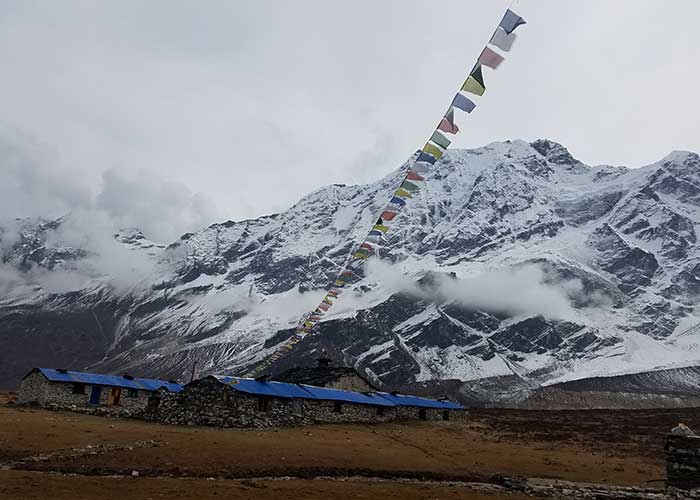
- Sun hat or scarf
- Light balaclava or warm fleece hat
- Suncreams(40+) and Lip Balms
- Cotton t-shirts and thermals
- Fleece jacket
- Waterproof jacket
- Down jacket
- Lightweight cotton pants (long)
- Waterproof pants
- Inner thermals
- Thin inner socks (3 pairs)
- Thick, warm wool hiking socks
- Comfortable hiking boots
- Shower sandals
- Gloves (Cotton and Waterproof)
Accessories
- Sleeping bag rated to -10°C +
- Trekking bag (Rucksack)
- Large plastic bags (for keeping items dry inside trek bag)
- Trekking poles (optional, recommended)
- Water bottle or camel bag
- Toiletries and Tissue Papers
First Aid Kits
- Personal Regular Medicines
- Blister Tape
Fixed Departures
- 29/02/2024 1-9 Yes Book
- 03/03/2024 3-9 Yes Book
- 18/03/2024 2-10 Yes Book
- 27/03/2024 2-10 Yes Book
Related Trips
You will also like …
- View Details
- Enquire Now
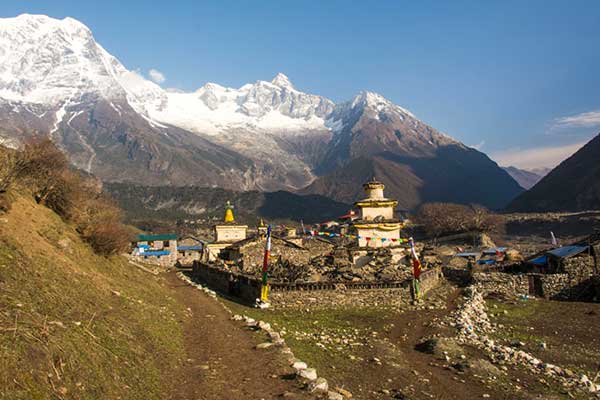
Manaslu Tsum Valley Trek
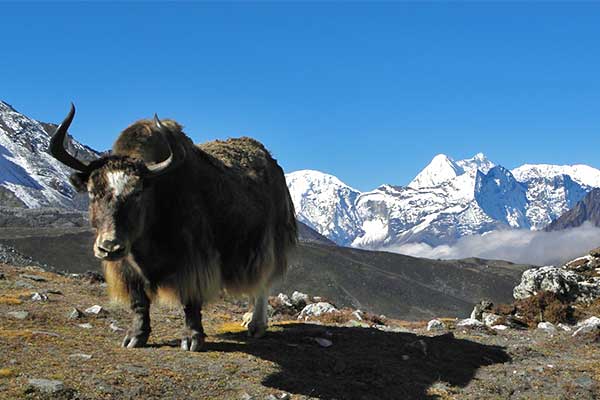
Rupina La Plus Larke Trek
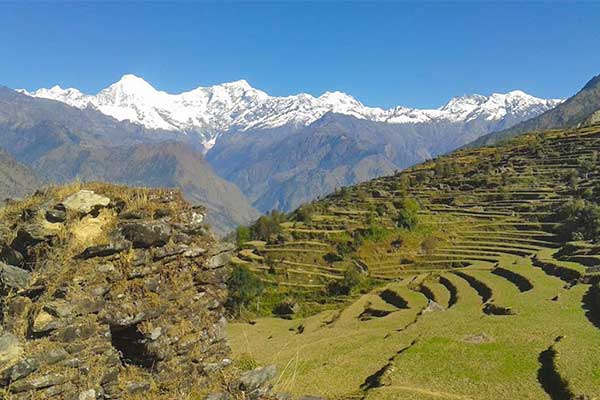
Ganga Jamuna Gorkha Trek
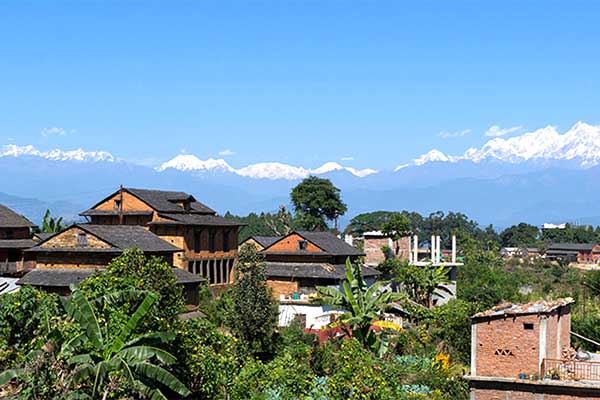
Gorkha Bandipur Adventure Tour
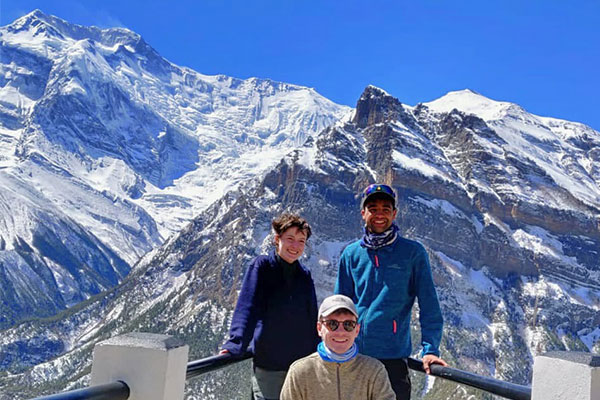
Annapurna Circuit Trek
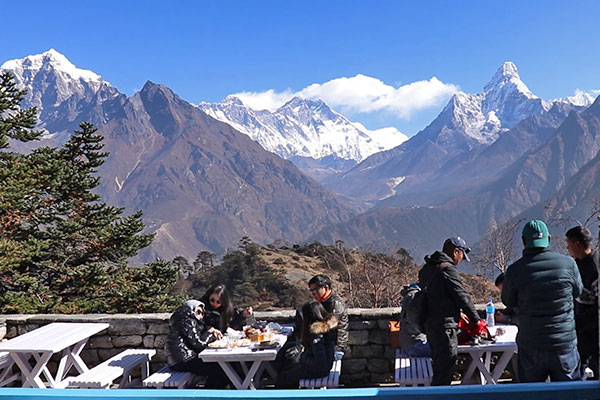
Everest View Trek
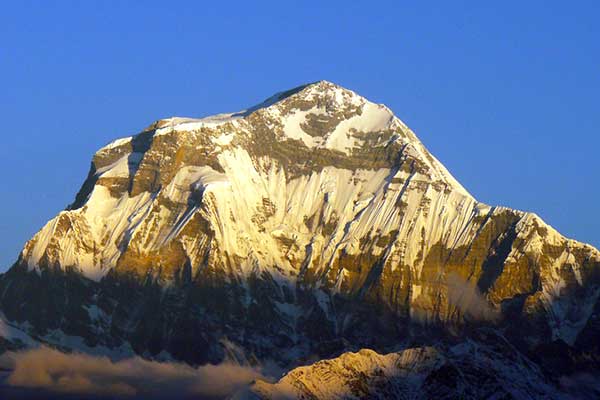
Dhaulagiri Round Trek
Clients review.
What our customers say about us
Reliable and experienced trekking service
We organized a guided Manaslu circuit trek while staying at Hotel Green Horizon. With the help of Suman, who was originally from the Manaslu region, we managed to arrange the trek in a way that suited us perfectly (being able to continue to Annapurna circuit on our own). With Suman and his experience and knowledge about the treks in Nepal, it felt we were able to arrange exactly the kind of trek WE wanted. As for the guide, we could not have asked for a better one in Sonam, who was professional, informative and considered our opinions. Sonam was such a lovely person!
Unfortunately, we were not able to finish our trek due to dengue fever. However, Sonam was very helpful and made us feel safe while we were sick in the mountains. In the end, Suman and our guide Sonam arranged us an evacuation back to Kathmandu. You could feel how sorry they were for us for not being able to continue the trek but they cheered us and helped us out to arrange other stuff in Nepal.
Communication with both Suman and Sonam was fluent in English.
Personal and professional
I booked two treks with Nepal mountain Trekkers, the Manaslu circuit and the Upper Mustang. It fitted perfectly in my traveling schedule. Suman arranged everything perfectly.
Let’s start with the Manaslu circuit, I had a great guide called Mod. He was very kind and it was a true pleasure to trek with him through the mountains. However due the heavy rainfalls we had to turn around. Safety first. Mod was very helpful and professional in rearranging the trip back down. Mother Nature is the boss and we only can anticipate!
The upper Mustang. Wow, what a track. I was with a fellow traveler and that was a great fit. The guide Sabin was very professional and kind. It was a true pleasure to spend this time in one of the most beautiful areas of Nepal with him and the my fellow traveler. Everything was perfectly arranged.
Thank you! 🙏
Tsum Valley Manaslu
Thank you to Ramesh at Nepal Mountain Trekkers and Expeditions for organising our group trip. We could not fault this company everything ran smoothly, our very experienced and knowledgeable guide TB kept us safe. TB went way beyond his duties of a trekking guide, even providing us with bed tea each morning. His infectious laughter and sense of humour kept our spirits high. We would not hesitate in recommending this fantastic company
LynTaylor_13
Fantastic trekking services.
We just finished a two month stay in Nepal. From the airport our taxi driver recommended we go through Nepal Mountain Trekkers to book all our trekking-related needs, and drove us immediately to Ramesh’s shop outside his Hotel Green Horizon. Through Ramesh, we purchased our flights to Lukla for our Three Passes Trek, a jeep ride to the Manaslu Circuit trailhead, and our required guide for Manaslu. The entire experience was extremely smooth. Ramesh was very professional, friendly, and knowledgeable and helped ensure our experience in Nepal was a great one. Our Manaslu trek guide, Krishna, was also great. Ramesh’s Hotel Green Horizon in Kathmandu is beautiful, quiet, and clean.
Christopher C
Fantastic, highly recommended.
We did a 2 weeks Manaslu trek with Min and Rojan, and it was a truly fantastic experience. Min was professional, knowledgeable and very helpful. Min shared a lot about Nepal history and went out of his way to make us feel comfortable, well acclimatised, and not to mention, very well fed! If you are looking for a best in class trekking guide in Nepal, this is the right company to do it with.
Manaslu Circuit Trek (18 April – 1 May 2019)
We had an enjoyable 14-day trek with Min as our guide and Rojan as our porter.
Special mention to Min who went out of his way – he was helpful and responsive during the planning of the trek and when we started the trek, he took great care of us both in terms of safety and comfort (he knows the teahouses with great food!). Through him, I learnt alot about the mountains and the history of Nepal – some of the many topics that Min is knowledgeable on, which makes me appreciate the trek even more. As both my friend and I were doing a high-altitude trek for the first time , I also appreciate Min setting a good pace and providing great advice on how to deal with the high altitude.
All-in-all, I really enjoyed the trek and will definitely recommend Nepal Mountain Trekkers with Min as a guide for a Nepal trekking trip.
Siok Chen A
Nur zu empfehlen.
Wir waren mit unserem Guide Krishna im April 2019 auf dem Manaslu Trek unterwegs. Auf Vorschlag des Agenturchefs Ramesh konnten wir die ersten Tage auf einer Alternativroute abseits der Touristenströme unvergessliche Einblicke in das Dorfleben gewinnen und im Gegensatz zur Hauptroute im Tal tolle Ausblicke auf Manaslu, Himalchuli und Ganesh Himal genießen. Während des Treks hat uns Krishna mit viel Humor und Kompetenz begleitet und ist zum Freund geworden. Auch der Passübergang klappte dank Krishnas Gespür für Wetter und Timing bestens. Es waren für uns unvergessliche drei Wochen in Nepal. Bei unserem zweiten Besuch in Nepal hatten wir Dank Ramesh und Krishna den Eindruck, das Land erstmals wirklich kennengelernt zu haben. Wir werden unseren nächsten Trek sicher wieder von nepalmountaintrekkers organisieren lassen und können die Agentur nur wärmstens empfehlen!
Fantastic trek in the Manaslu Conservation Area
An absolutely terrific trekking experience. We did a 12 day trek in the Manaslu conservation area in Oct 2018 organised by the always-smiling Ramesh at Nepal Mountain Trekkers, and led by our trusty guide Min (Sanjeep). Right from the start, Min took care of everything and gave us a tremendous and care-free two weeks in the mountains. It was my second trek with Min (having also done the Annpurna circuit in 2011) and like last time, his local knowledge, warm temperament and great organisational skills meant we had a hugely successful trip. He secured us accommodation in all villages, guided us through the acclimatization process and ensured we passed safely over the 5,100 Larka La High Pass. Our porter Sukman was also a delightful young man, and was well treated. Would not hesitate to recommend this agency.
Manaslu Trek. Eine Herausforderung, die mit Daljit Gurung zu einer schönen Erfahrung geworden ist.
In Kathmandu angekommen wird man gleich von einem Mitarbeiter der Nepal Mountain Trekkers empfangen und ins Hotel gebracht. Ich ruhe mich aus und der Staff legt gleich mal los, alle Papiere fürs Trekking vorzubereiten. Zeit ist kostbar. Da ich Kathmandu schon ganz gut kenne, habe ich es vorgezogen am Sightseeing Tag erst mal Freunde zu besuchen. Und am nächsten Tag ging es in aller Frühe los nach Baseri. Schon auf Weg wurden mir alle Fragen beantwortet. Erst mal landen und am nächsten Tag gehts weiter. Daljit ist ein wahrer Gentleman. Mein Rucksack war schwerer als seiner, also haben wir einfach mal getauscht. Juhu, ich konnte mich der Aussicht und dem Weg widmen und musste mich nicht mehr um schweres Gepäck sorgen. Teilweise sah es schon etwas wackelig aus, aber dafür hatte ich ja Daljit, der mir gezeigt hat, wie ich mich vorwärts bewegen muss. So bin ich ganz gut durch gekommen. Wine Wahre Augenweide sind die Rhododendron Wälder und natürlich immer wieder der Blick auf den Schnee bedeckten Gipfel. Super fand ich den Besuch der Pungyen Gompa. Und natürlich auch die lieben und herzlichen Menschen auf der Strecke. Ich muss sagen, das ganze Team hat mir einen unvergesslichen Trekk organisiert. Selbst am Ruhetag in Samdo wurde ich nicht einfach alleine gelassen. Mein Guide war immer für mich da. Auch bei dem Ansieg nach Dharamsala, Wo ich trotz des Ruhetages arg an meine Grenzen gekommen bin. Hat Daljit mich nicht aus den Augen gelassen und natürlich seinen Rucksack auch noch getragen. Danke noch mal dafür. Auch bei der Auswahl der Teehäuser und der Rastplätze hat sich das gute Händchen der Agentur bewährt. Einfach ein klasse Team. Ich konnte auf der Rückfahrt im Bus schlafen. Musste mir nie Sorgen um mich und meine Sachen machen. Wieder zurück in Kathmandu wurde ich nach einer ausgiebigen Dusche noch zum Abendessen eingeladen. Wir waren in einem tollen Tamang Restaurant. Vielen Dank an das gesamte Team der Nepal Mountain Trekkers.
Auch der zweite Besuch war ein tolles Erlebnis!
Vor mehr als drei Jahren habe ich zufällig Ramesh Dhakal kennengelernt, als ich auf der Suche nach einem Hotel war; Ramesh war Teilhaber einer Trekkingagentur in den Räumen des Hotel “Horizon” (auch dieses ist sehr zu empfehlen!). Ramesh hat mich mit seinem Mitarbeiter Krishna zusammengebracht, der mich auf einer zweiwöchigen Tour durch Helambu und Langtang begleitet hat: Ein wunderbares Erlebnis und ein sehr entspannendes Wandern. Bisher war ich – sechs Mal in 38 Jahren – immer nur allein im Himalaya unterwegs gewesen. Nun wurde ich rundum von Krishna versorgt; Ramesh hatte die Tour auch perfekt vorbereitet. Deshalb war es auch keine Frage für mich, dass ich die nächste Tour wieder mit diesen Freunden mache. Schon von Deutschland aus habe ich angefragt; Ramesh hat dann mit seiner neuen Agentur Nepalmountaintrekkers, deren Inhaber er ist, alles vorbereitet: Mein alter Guide und Träger Krishna hat mich schon am Flughafen abgeholt, alles war geregelt und zusammen sind wir diesmal um den Manaslu gewandert: Alles wieder perfekt organisiert und durchgeführt: Kompetent, zuverlässig, freundlich – kann ich sehr gerne weiterempfehlen und wünsche der Agentur Nepalmountaintrekkers und den Mitarbeitern alles Gute!
WE ARE ASSOCIATED WITH
SEND US A MESSAGE

- Best Hikes In The World
- Appalachian Trail
- European Hikes
- Nepal Hikes
- Patagonia Hikes
- See All Hikes
- Mount Kenya
- Mount Kilimanjaro
- Mount Toubkal
- See All Mountains
- South Africa
- New Zealand
- Switzerland
- United Kingdom
- Packing Lists
Manaslu Circuit Trek – Hikers Guide To This Classic Circuit Hike
Asia , Nepal
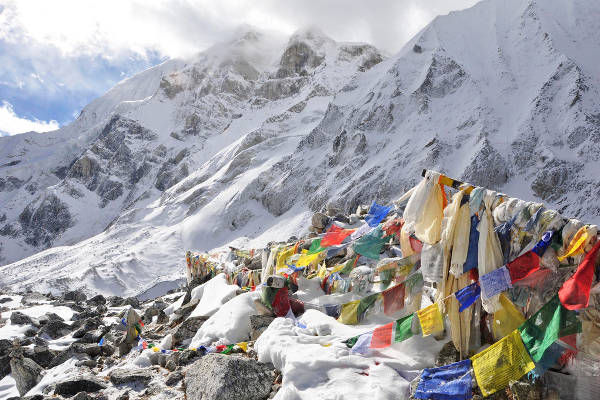
The Manaslu Circuit hike passes ten Himalayan peaks of more than 21,300 feet, including the 8000er , Manaslu (26,781 feet), which is the eighth-highest mountain on Earth .
The Manaslu trek is a 110-mile hike that is a great alternative to Everest Base Camp hike or the Annapurna Circuit hike . The trek usually takes between 14 and 17 days. There are some who do it in 12 days.
Here is my hikers guide to the Manaslu Circuit trek.
Manaslu Trek Guide
The Manaslu Circuit trek resembles the Annapurna Circuit trek of decades past. The area covers six climatic zones. Robin Boustead, author of Nepal Trekking & the Great Himalaya Trail: A Route & Planning Guide , has said, “many would argue that the Manaslu Circuit trail is the best trek in Nepal .”
The Manaslu Circuit hike runs through a restricted area and, while growing ever more popular, is nowhere near as developed as the Khumbu (i.e. Everest) and Annapurna regions. The scenery is similar to that of the Annapurna region and the level of difficulty is similar to the Annapurna Circuit.
A good portion of the trek is spent above 10,000 feet, which is more demanding, but the acclimatisation profile is good, with the trek starting at just under 2,000 feet and taking a week to reach 10,000 feet.
Around 2,000 people undertake this trek each year, much less than hikes in the Annapurna region or to Everest Base Camp, with over half coming in October. You will probably see more yaks and donkeys than trekkers.
The first reason why the Manaslu trek is less frequented is that camping used to be the only option due to a lack of Nepal tea houses . This has since changed with many tea houses being built over the last decade. Admittedly, what tea houses now exist are basic compared to those found on the Annapurna Circuit, but most are relatively comfortable and have electricity. A warm 4-season sleeping bag should be taken as the bedding in some tea houses isn't great and rooms get very cold at night.
The second reason for the Manaslu Circuit hike’s lesser popularity is that the area is restricted and so requires a permit and a registered guide.
Please Note: The highest point is Larkya La (5,213m), which is widely regarded as one of the most dramatic pass crossings in the Himalayas . Sitting as it does in the near-permanent shadow of Manaslu’s north face, snow conditions can be severe. It takes five or six hours to trek to the top.
Manaslu Regional Map
The Manaslu Circuit trek is in western Nepal, a few miles from Tibet inn the North and north-west of Kathmandu in Nepal.
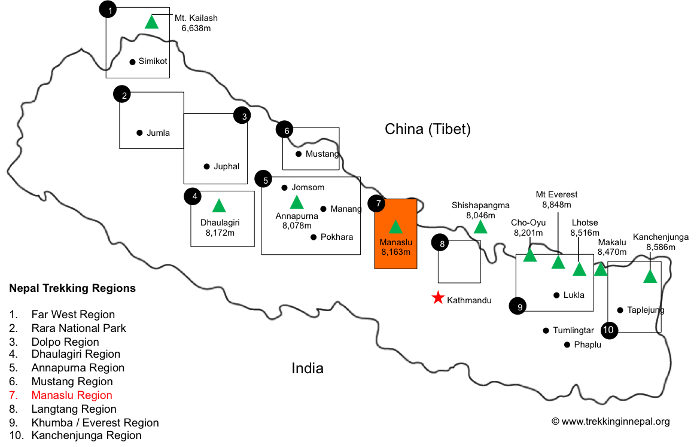
Recommended Manaslu Map
In terms of a good map for the Manaslu Circuit, we recommend: Manaslu and Ganesh Himals Region: 1:125,000 Trekking Map (The Great Himalaya Trail Series Maps) (NP106).
In terms of a single detailed map we recommend the Himalayan MapHouse’s, New Annapurna Trekking Trails Map , which can be bought in Kathmandu, Pokhara or on Amazon.
We have also provided links and recommendations to guidebooks below.
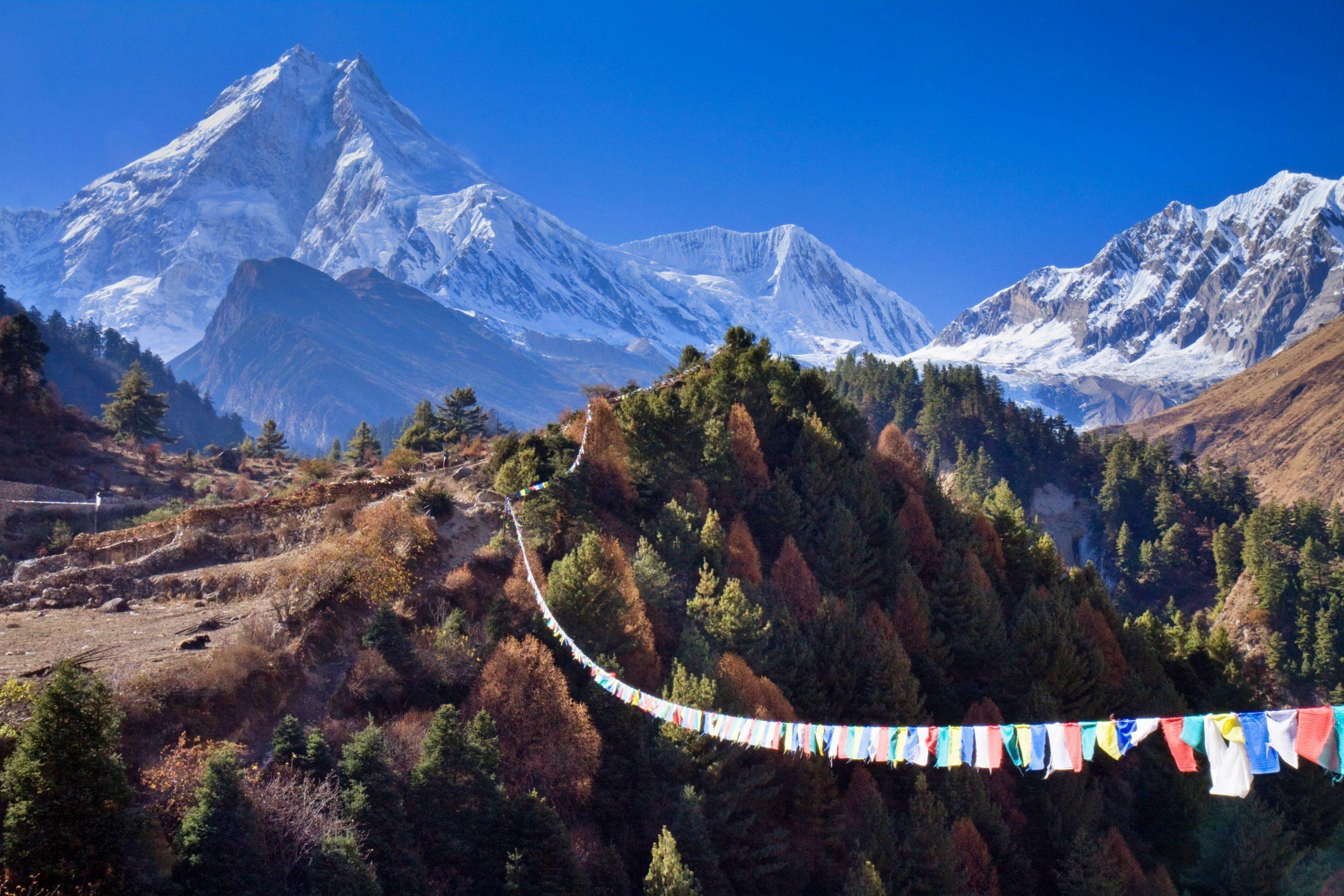
Manaslu Trek Itinerary
Because of the spacing of tea houses at higher altitudes, the Manaslu trek is best done anti-clockwise. It is possible to stay in nothing but tea houses, but you may want to camp as well.
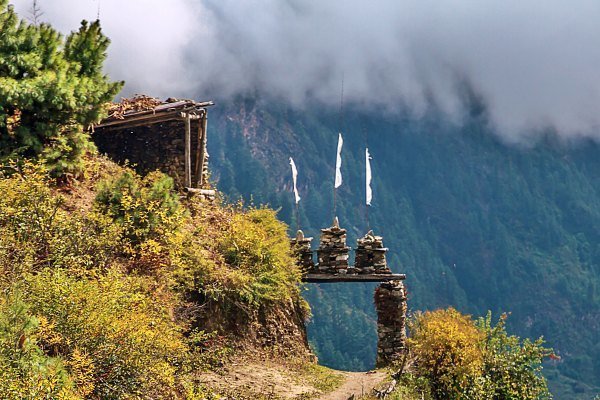
There are several Manaslu Circuit itineraries that can be done. Most start in Arughat, which can be reached by bus from Kathmandu (be prepared for a bumpy ride). Much of the trek follows the Buri Gandaki.
On the lower reaches you will pass lots of farmland, but as you ascend the landscape will become a lot more barren and glaciated.
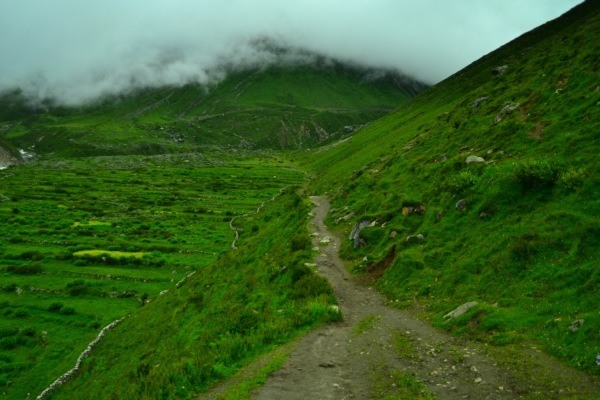
There are many mountain views, the most impressive I think are those of Naike Peak, Manaslu North and Manaslu.
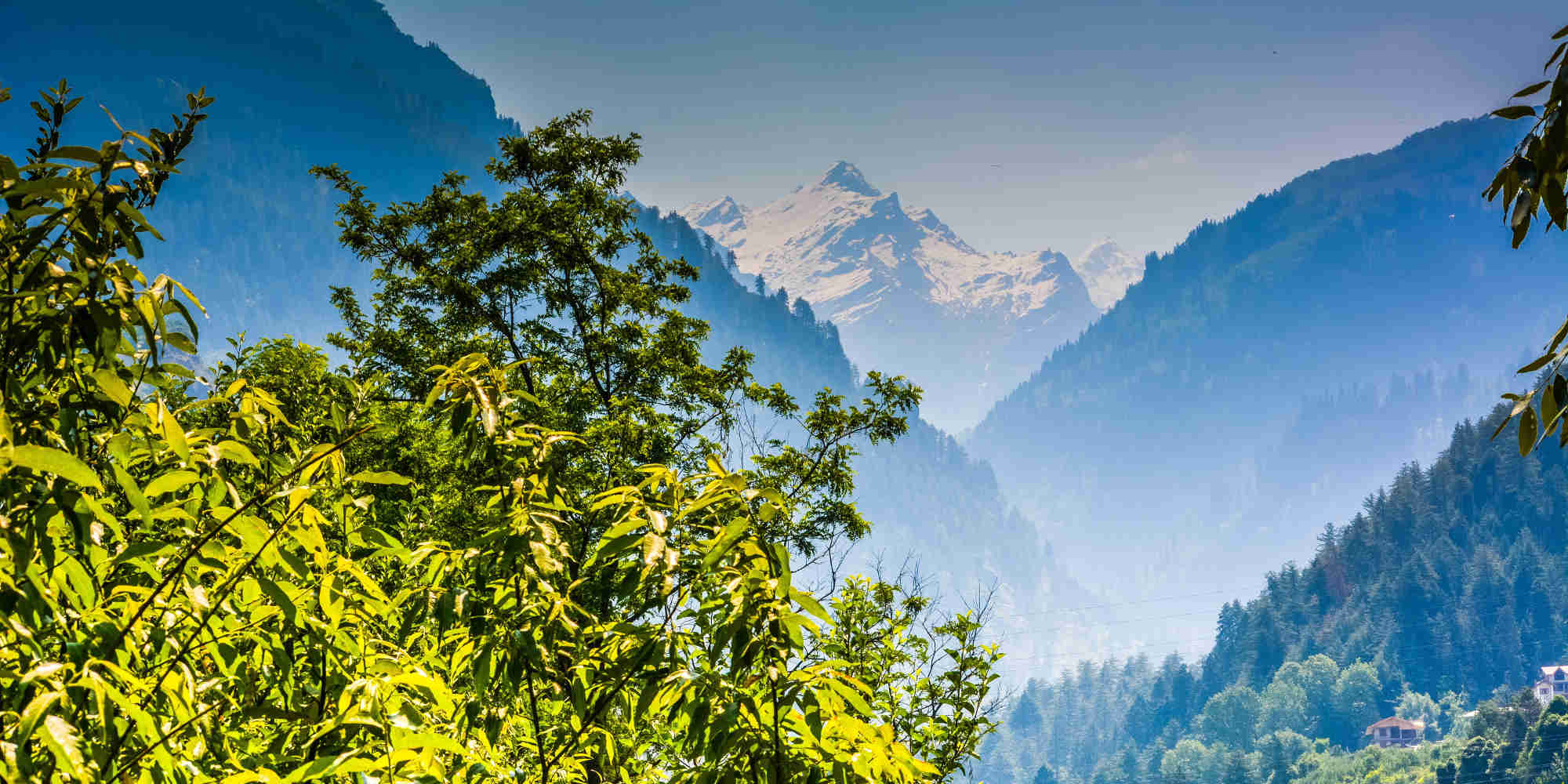
Manaslu Circuit Trek FAQ
When is the best time to trek manaslu.
The best time to trek Manaslu is October or November . Overall, this is the overall best time to trek in Nepal with April and May being the next best times.
How much does the Manaslu Circuit trek cost?
Prices can vary widely, from $2,000 per person at the bottom end to $4,000 per person at the top end. There are over 1000 local trekking agencies in Nepal , so make sure you pick a good, well reviewed operator.
Are permits required for the Manaslu Circuit trek?
Yes, permits are required for the Manaslu Circuit Trek. You need a Restricted Area Permit which costs $50 a week, a Manaslu Conservation Area Project permit which costs $30 and an Annapurna Conservation Area Project permit which costs $30. You will also need four passport-sized photographs.
How difficult is the Manaslu trek?
The Manaslu Circuit Trek is considered quite challenging, but still a possibility for first time trekkers. Altitude is often over 10,000 feet and there may be sections with snow. A good level of fitness is required as the trek is quite long and often steep.
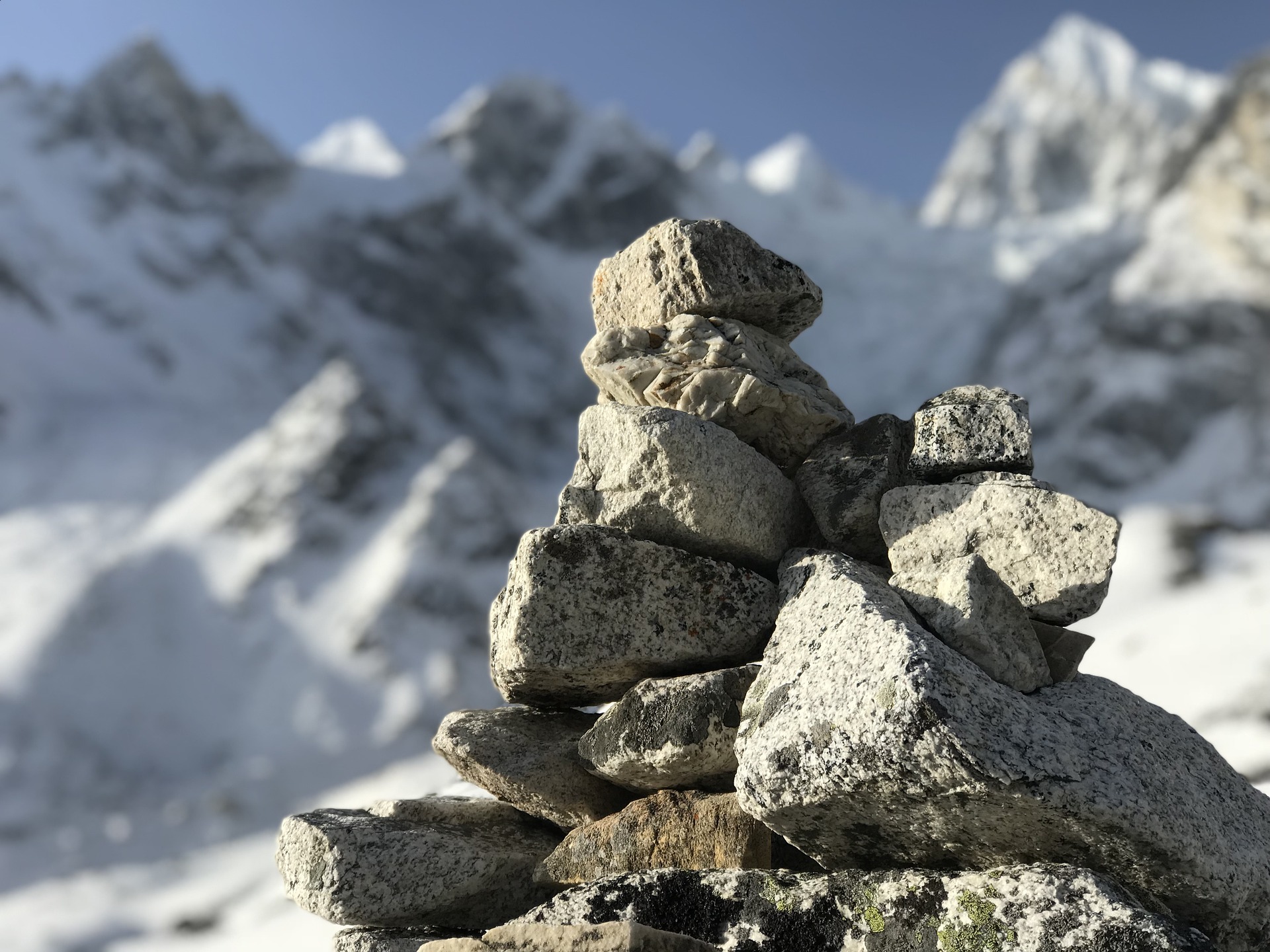
Is altitude sickness a risk on the Manaslu Circuit trek?
Yes, altitude sickness is a risk on the Manaslu Circuit trek because it ascends to some high-altitude points. At its highest point, Larkya La, you will reach an altitude of 5,213 meters (17,100 feet). There are steep sections on this trek where you will ascend very rapidly.
Therefore, it is important to have a solid understanding of the risks associated with high altitude trekking and how the body acclimatises to high altitude. We recommend you read our detailed article on altitude sickness .
What gear do I need for the Manaslu Circuit?
Trekking the Manaslu Circuit requires a number of essential pieces of trekking gear. The trail is long and moderately difficult, exposing you to a range of altitudes where temperatures fluctuate dramatically between night and day.
At a minimum you should take:
- 4-season sleeping bag
- Good hiking boots and 6-8 pairs of hiking socks
- Layered clothing including base layers and a warm down jacket
- Warm gloves
- 60-70L backpack
- Hydration pack
- Trekking poles and polarised glasses

Are there any recommended guidebooks for the Manaslu Circuit Trek?
There are two guidebooks dedicated to the Manaslu Circuit hike that I recommend.
The first one and my personal favourite is A Trekking Guide to Manaslu and Tsum Valley: Lower Manaslu & Ganesh Himal by Sian Pritchard-Jones and Bob Gibbons. As a great alternative, I recommend Trekking in the Nepal Himalaya (Walking Guide) by Lonely Planet.
There is also a collector's book available online called Manaslu: A Trekker’s Guide by Kev Reynolds, which was published in 1999.
You are also welcome to have a look at our recommended list of Nepal books and guidebooks for more options.
Continue browsing
See more information on Nepal . Or check out these other Nepal hiking articles:
- Short Nepal Trekking Tours
- Easy Hikes in Nepal
- Kala Patthar Trek
- Kanchenjunga Base Camp Hike
- Trekking to Rara Lake
- Mera Peak Trek
- Best things to do in Nepal
- Helambu Trek
- Hiking the Mustang Circuit
- Gokyo Lakes Trekking Guide
- Makalu Base Camp Trek
- Gosainkunda Hike
- Hiking to Limi Valley
About the author
Mark Whitman
Mark has trekked extensively in Asia, Europe, South America and Africa. He founded Mountain IQ in 2014 with the sole aim to be the best online information portal to some of the most popular mountain destinations around the world. When not writing for Mountain IQ, Mark is out exploring the outdoors with his wife!
Leave a Reply
Your email address will not be published. Required fields are marked
I am planning on traveling to Nepal this mid May to early June with two friends.
I am a Wilderness First Responder and have guided backpacking trips in California and Alaska, so I consider myself quite competent in the backcountry and would be more than happy to carry my own gear for the duration of a trek.
Is there a particular region in Nepal (or Bhutan or India) that lends itself to off-trail travel without a trekking company? I am still open to hiring a local guide because I think it adds a lot to the experience, but I would prefer to be in a region that provides a competent backpacker with more flexibility.
I’d appreciate any input or direction!
Hi David, in terms of Nepal I would recommend the Annapurna Circuit, Goyko Lakes Trek or the Manaslu Circuit – all offer great backcountry hiking, but are sufficiently well trodden with decent facilities (tea houses) to make one’s experience fun and enjoyable.
Thanks so much for the input Mark.
On the three treks that you mentioned, should we prepare to stay on the common trail the whole trip, or is it feasible/desirable to ever travel off-trail to explore a little more?
Last question, I promise. Thanks!
We work with local guides to offer great value adventures at unbeatable prices

Manaslu Circuit Trek: The Ultimate Guide
Jackson Groves
Posted on Last updated: July 10, 2023
Categories HIKING , NEPAL
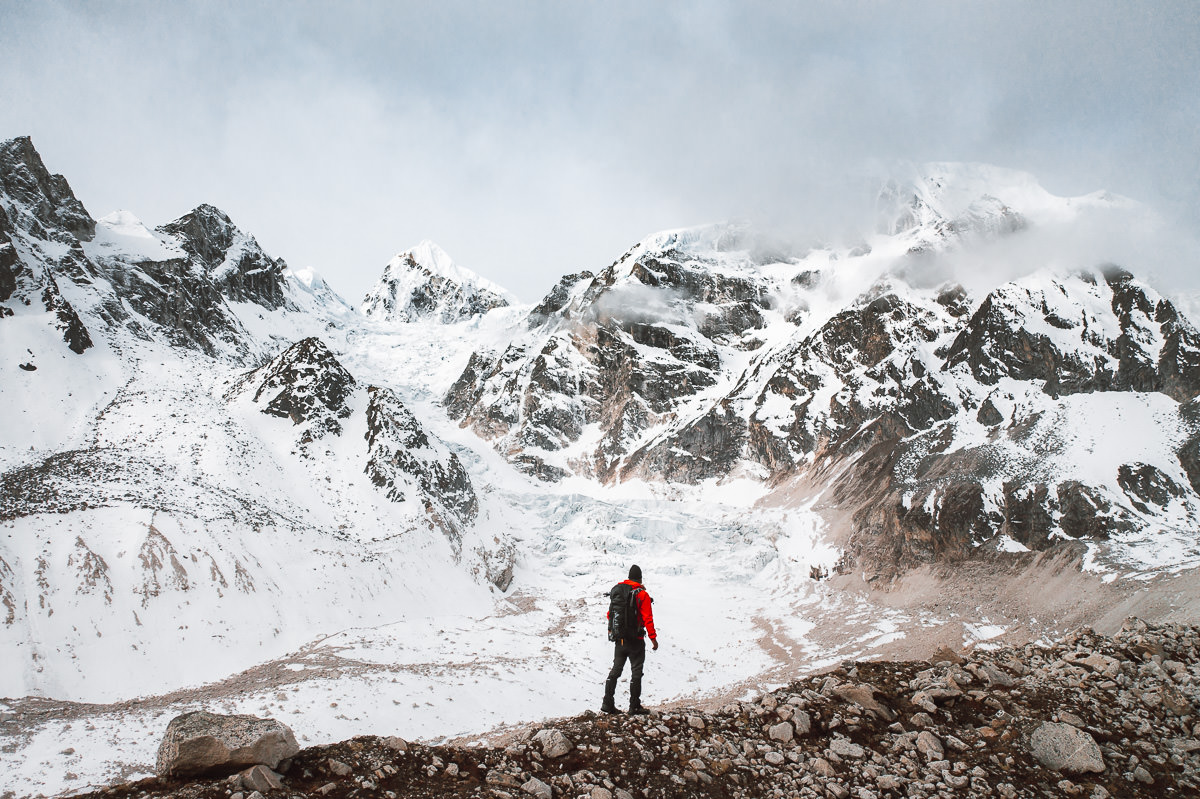
The Manaslu Circuit Trek is an off-the-beaten-path trail in the Himalayas of Nepal. The route leads you up and around the base of Mount Manaslu as you stay each night in different Tibetan villages along the way. The scenery is incredible, especially the last few days of the circuit as you reach heights of above 5000 meters while crossing the Larke Pass, also known as Larkya La Pass.
TRY THE 3 BEST TREKS IN NEPAL

Manaslu Circuit : My personal favorite 2-week trek through Tibetan villages and stunning scenery. Less crowded and more authentic.
Annapurna Circuit : The most beautiful & scenic 2-week trek in Nepal although can be crowded at times.
Everest Base Camp Trek : The most iconic 2-week route reaching the famous (EBC) Everest Base Camp at 5,300m.
I highly recommend this circuit for those who looking to avoid the crowds of Annapurna Circuit and the Everest Base Camp Trek. The highlight of this circuit is the authentic culture of the Tibetan villages along the way and takes you around Manaslu, the world’s eighth-highest mountain at 8,163 meters (26,781 ft).
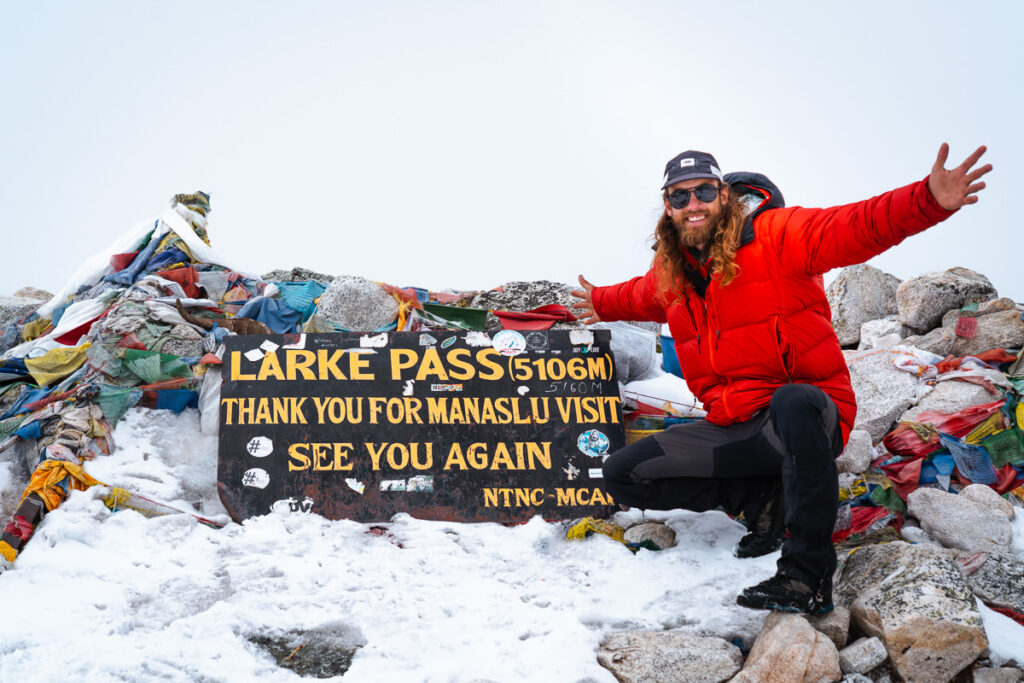
Before sharing my experience on the trek with One Globe Travel in the second section of this blog post, I will detail all of the information you have to know in this complete guide about the Manaslu Circuit Trek.
You can use my discount code ‘ JACKSON5 ‘ for 10% off the total price of your trek with One Globe Travel , which is a pretty handy saving of almost $200! To book the trek with One Globe Travel you can visit their site by CLICKING HERE or contact them via the details below:
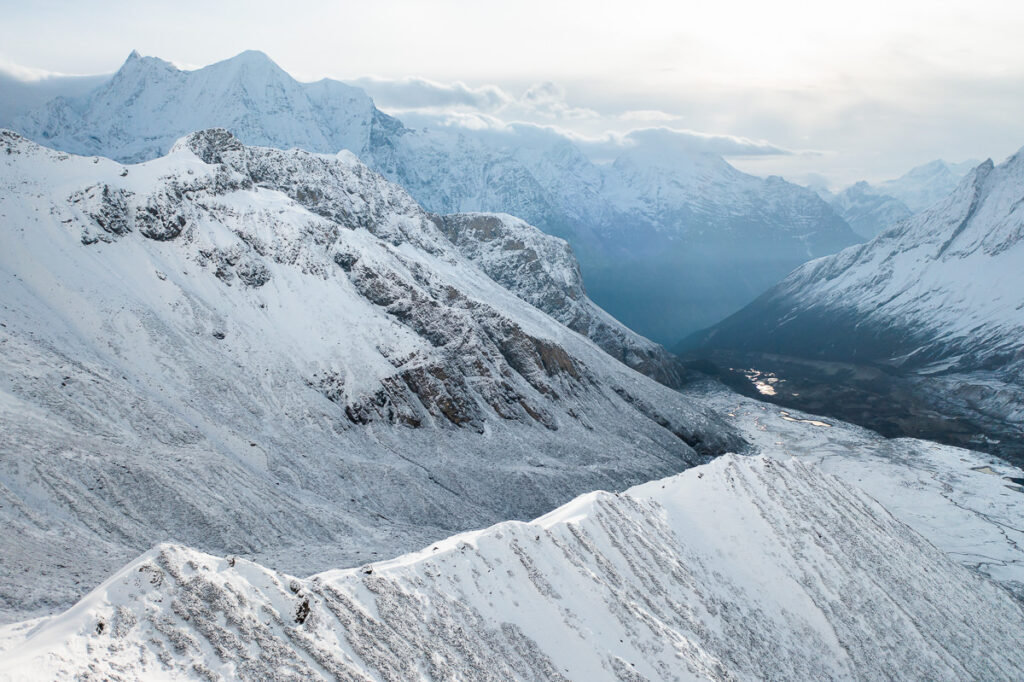
Table of Contents
THE MANASLU CIRCUIT TREK GUIDE
In this blog post, I will cover everything you need to know about the logistics of the Manaslu Circuit Trek and also share with you my experience on each day of the trek in the form of a short journal entry and my photos from that day. This will give you an idea of what to expect and a great insight into the scenery you will find on each day of the trek.
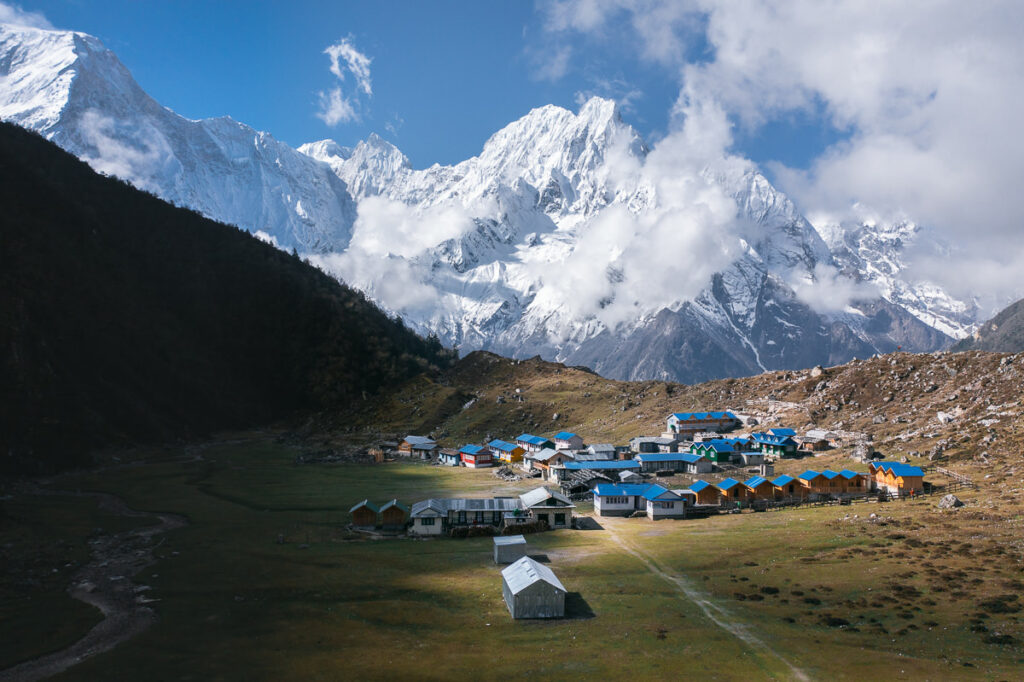
MANASLU CIRCUIT TREK DETAILS
- Distance : 180 km through-hike from Machhakola to Dharapani
- Days required : 12 days
- Total Incline : ( with undulation) – 11,000 m
- Total Decline :(with undulation) – 9,800 m
- The highest point on the trek : 5200m, which was just above the Larke Pass (Larkya La Pass) on day 11.
- Difficulty : This trek was much harder than Everest Base Camp Trek as it was 30% longer, much steeper, and less commercialized. Having said that, it was basic walking and there was nothing technical. Our longest day was 27km with 1600m of incline. If you can handle the altitude of 5,200m and can walk each day for 6-10 hours, you will be fine on this trek. The acclimatization profile was very good as you have 11 days to reach the highest point, so it eases you into it.
- Permits : Your tour operator will take care of these in each town and for the Manaslu Circuit Trek it isn’t possible to hike independently. You must hike with a guide and there must be at least two in your group, as well as the guide.
- Guide : A guide is required on this trek and the guide manages all of the logistics, distances, directions, and tea houses. The directions weren’t always very clear like on the Everest Base Camp trek and having the guide manage all of the logistics was great. I went with One Globe Travel and highly recommend them.
- Accommodation: Guest Houses, also known as Tea Houses, are available along the way where you will sleep in a comfortable bed and have access to showers (extra charge) and restaurant facilities. Very comfortable accommodation and great after a long day of hiking. Most of the villages were Tibetan, which gave us a great insight into their unique culture.
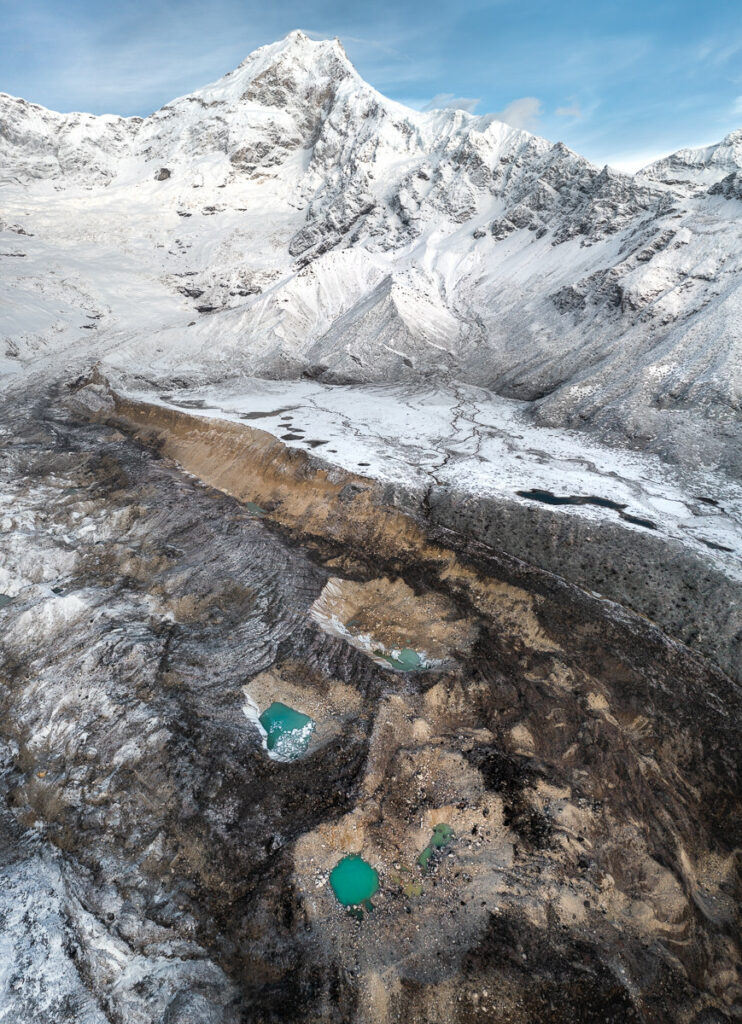
TOP 3 PLACES TO STAY IN KATHMANDU

- Ultimate Luxury: The Dwarika’s Hotel – Luxury, Spa-service, Pool
- Best Value : Aloft Kathmandu Thamel – Swimming Pool, Gym & Great Restuarant
- Budget Choice: Hotel Jampa is easily the top cheap hotel in Kathmandu
KEY POINTS ABOUT THE MANASLU CIRCUIT TREK
- This circuit is way less crowded than Everest Base Camp and the Annapurna Circuit. It is growing in popularity but it’s still a great time to trek this circuit before it hits the mainstream.
- The Manaslu Circuit trek is off-the-beaten-path and remote. However, there are teahouses in each village along the way so each night you get a great sleep in a bed with blankets, have access to showers, eat great meals in a restaurant, and can charge your electronics and cameras.
- The trailhead can be reached by car so there is no need to pay for expensive domestic flights.
- The first few days of the circuit run along the trail next to the river in a deep gorge called the Buri Gandaki with lots of suspension bridge crossings. The trek transitions to the snow for the last few days although you can trek with regular hiking boots while enjoying the massive snowy mountains on either side of the trail.
- The scenery is constantly changing and you will experience a subtropical jungle while at lower elevations before entering the Himalayan foothills. Finally, you will reach the Larkya La above 5,100 meters / 17,000 feet.
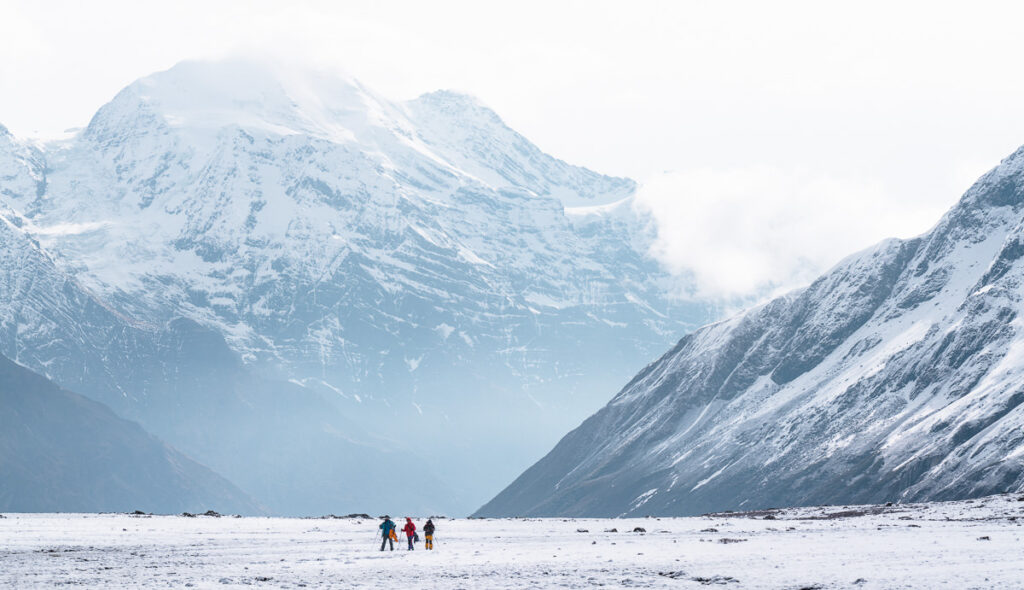
BOOKING A GUIDE FOR THE MANASLU CIRCUIT
The Manaslu Circuit Trek does require a guide. Everest Base Camp and Annapurna Circuit can be done independently but the rules on the Manaslu Circuit are stricter about having a guide. I did the trek with Samip from One Globe Travel , which is one of the top trekking companies when it comes to Manaslu Circuit. The owner, Nawang, is a Tibetan himself, which is the main culture you will experience along the circuit.
The trek costs around $1800 USD with One Globe Travel as of 2021 and includes all transfers, accommodation, meals, drinks permits, and even the hotel stay before and after the trek at a 4.5-star hotel with a rooftop pool. I honestly had a great time, the guide was great and I can wholeheartedly recommend One Globe Travel. They even helped me many weeks after the trip during the lockdown in Kathmandu.
Book now: One Globe Travel
Email: [email protected]
Phone Number: +977-01-4003071/72/73
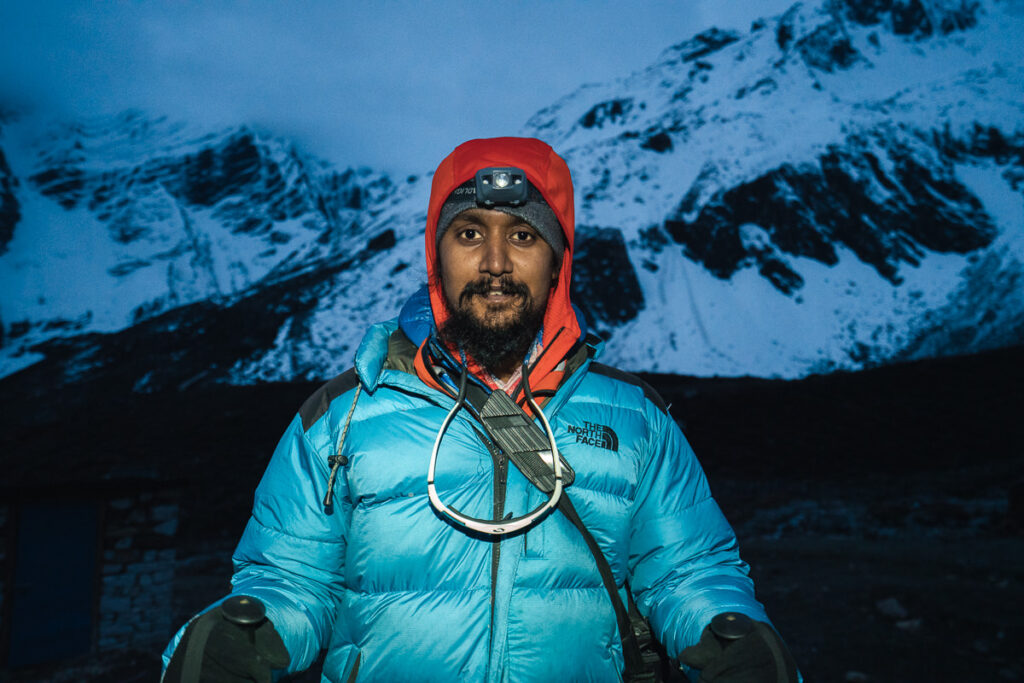
MANASLU CIRCUIT TREK PACKING LIST
I pack pretty light and managed to wash most of my clothes each afternoon/night for the first half of the trip. In the latter stages of the trip, it was pretty cold so we weren’t sweating as much and we wore our warm gear basically nonstop while at the teahouses and there was no real need for multiple outfits. This is just a guide and it worked quite well for me with no complaints from my set-up.
You won’t need a sleeping bag as there are blankets in each guesthouse and when it got cold I just wore my down jacket. This meant I didn’t have to carry a sleeping bag for 12 days, although our guide did.
- 1 pair of pants that maybe convert to shorts
- 1 pair of shorts
- 1 Warm or thicker pair of hiking pants
- 1 Long sleeve quick-dry shirt
- 1 Long-sleeve thermal shirt
- 2 Short-sleeve t-shirts
- 1 Thermal long underwear
- 4 pairs of quick-dry underwear
- 1 Lightweight down jacket
- 1 Heavy-duty summit down jacket
- 1 Neck Buff
- Hiking boots
- Microspikes
- 1 pair of warm summit socks
- 2 pairs of regular socks
- Trekking poles
- Water filter
All of this should fit into a backpack no bigger than 50L and be less than 15kg. I actually took a 40L camera bag, which you can see in the photos so I went super light. My camera gear included a DJI Mavic Pro 2 drone, 100-400mm, Mirrorless body, 16-35mm lens, 24-105mm lens, GoPro Max, Sony RX100, and a tripod. Without all of that, a 30L backpacking bag would have been enough.
Having said that, our guide and one of the girls on the trek had an 80L pack. I would say a 60L pack would be just about right for this trek and you would have lots of space assuming you wouldn’t need to fill it up.
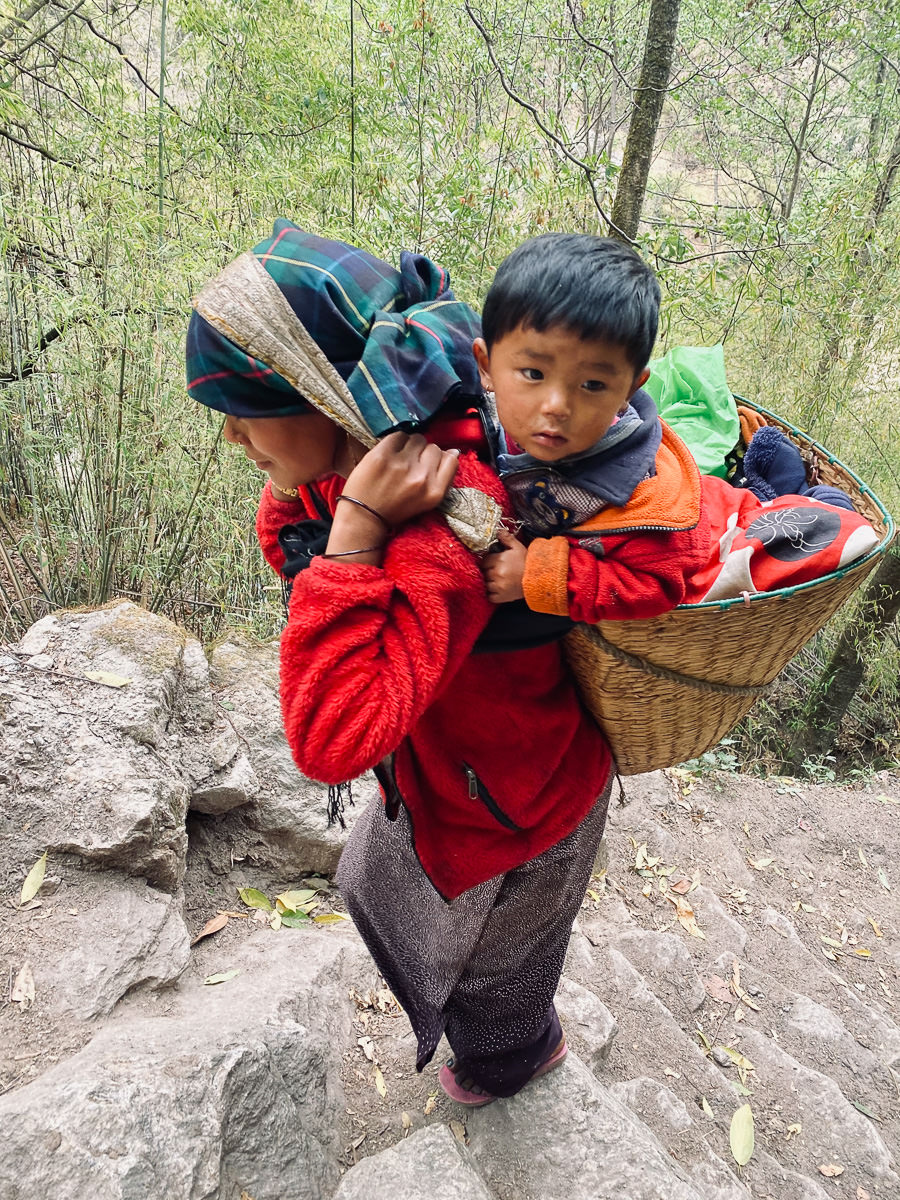
TREKKING THE MANASLU CIRCUIT: WIFI/ELECTRICITY AVAILABILITY
Wifi: Costs anywhere from $free to $4 to use wifi at the guesthouses. Buy an NTC Sim before you go. It worked early on in the trek with a weak signal and I was able to get emails and chat on Facebook messenger all the way up until about day seven and then we were off-grid.
Lots of the tea-houses say they have free wifi but then will blame the weather that it isn’t working. If you really do need it, test the wifi before picking your tea-house. Overall we had some minimal connection about 40% of the time on the trek. Samaguan had decent wifi and we stayed there for two nights so caught up with all of the news and action online.
Electricity: You will have to pay anywhere from $free at low elevations to $5 to charge your power banks, cameras, and phones. The key is to get a fat power bank. Pay to charge that then charge everything from your power bank. My power bank lets me charge my phone and four camera batteries before it would be done.
Most of the places we stayed let us charge our gear for free but when it is busy they usually charge as they run off gas or solar in many of the tea houses.
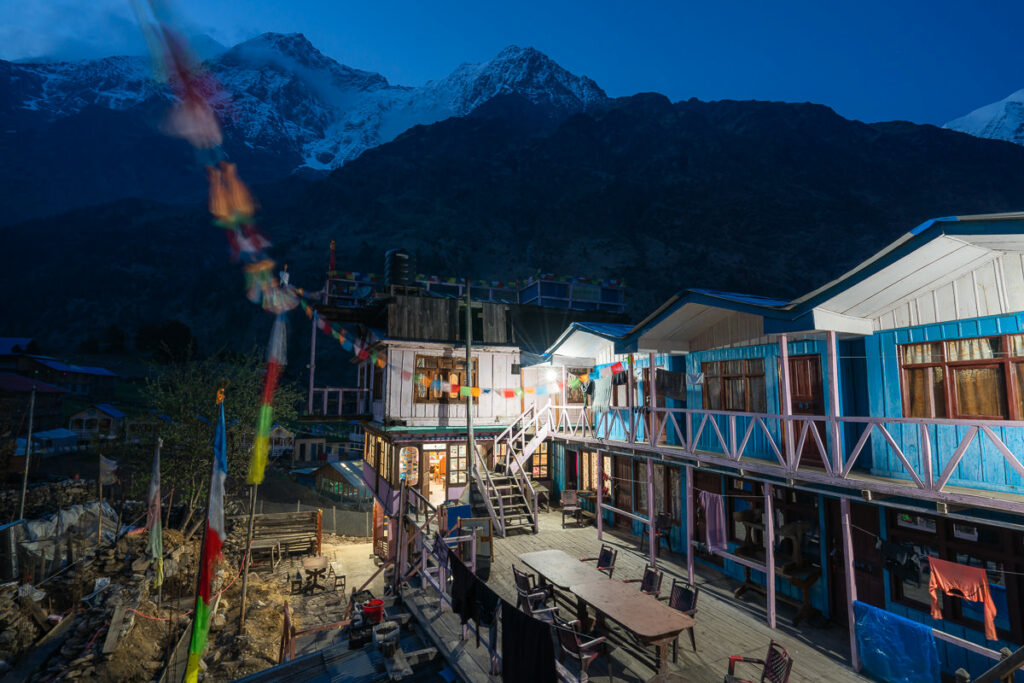
MANASLU CIRCUIT ITINERARY
There are many ways to alter the route on the Manaslu Circuit just as there are lots of different options for day trips on your acclimatization days. However, for the sake of giving you a rough idea of what your itinerary and acclimatization profile will look like this is a proposed itinerary and what my trek entailed but depending on the weather, your guide, and your preference it can be altered.
- Day 1, Machhakholagaon (862m) to Jagat (1,330m) – Distance: 26km, Incline 1512m
Day 2, Jagat (1,330m) to Deng (1880m) – Distance: 21km, Incline 1636m
Day 3, Deng (1880m) to Prok (2275) – Distance: 14km, 1082m
Day 4, Acclimatisation day: Prok day-trip to Kal Tal Lake (4100m) – Distance: 13km, Incline 1600m
Day 5, Prok (2275m) to Namrung (2661m), Distance: 10km, Incline 660m
Day 6, Namrung (2661m) to Lho (3200m), Distance: 11km, Incline 900m
Day 7, Lho (3200m) to Samagaon (3500m), Distance 8km, Incline 600m
Day 8, Acclimatisation day: Day trip to Pungen Gumba (4200m), Distance 17km, Incline: 800m
Day 9 , Samagaon (3514m) to Samdo (3862m), Distance: 9km, Incline 600m
Day 10, Samdo (3862m) to Dharma Shala (4466m), Distance 7km, Incline 700m
- Day 11, Dharma Shala (4466m) to Bhimtang (3709m) via Larke Pass 5134m, Distance: 18km, Incline 800m
Day 12, Bhimtang (3709m) to Dharapani (1860m), Distance: 25km, Incline 350m
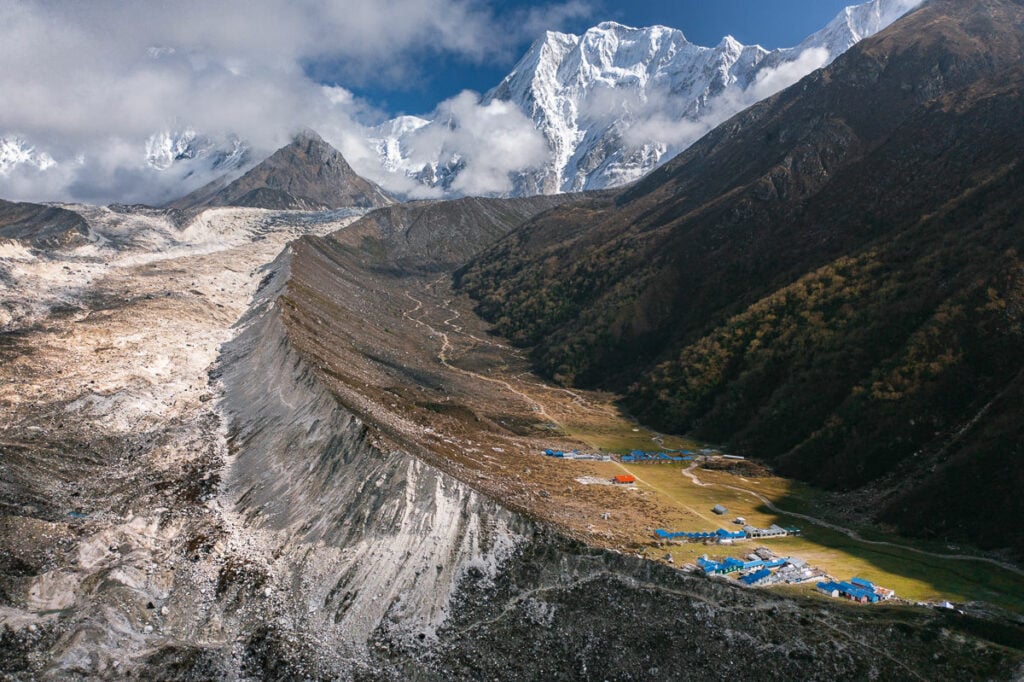
MY MANASLU TREK VIDEO
I filmed from start to finish to give you an insight into how the trek looks and what to expect. I hope you enjoy the video.
MY EXPERIENCE ON THE MANASLU CIRCUIT TREK
For each day of the trek, I will share the details of the route for that day, a few highlights of mine personally that I wrote each night while trekking, and some of my favorite photos from that section of the route.
Day 1 , Machhakholagaon (862m) to Jagat (1,330m) – Distance: 26km, Incline 1512m
The first day of the trek begins in the small town of Machhakholagaon . You will quickly find your place alongside the Budhi Gandaki River, which follows the gorge. The trail is a dusty road blasted into the cliffside for the most part although there are a few narrow sections including a number of river crossings (no wet feet) and suspension bridges. Expect to be exposed to the sun with little tree cover and be greeted by some steep staircases that will be a shock to the legs on the first day of trekking.
Day 1 Highlights:
- Setting off out of the town in golden light. Felt lucky to be here and excited for what was to come. With little idea of the landscapes in store, it was a truly adventurous atmosphere surrounding our group.
- Following the raging river, all day provided some stunning scenes. Around each turn and beyond each set of stairs we found a beautiful view. Mountains high our necks hurt towered above us on either side, with the river winding its way through like a serpent.
- On a very hot day, the Coca-Cola at our lunch break really hit the spot. Temperatures stung the skin as we battled through 25km and 1500m of incline underneath a piercing sun.
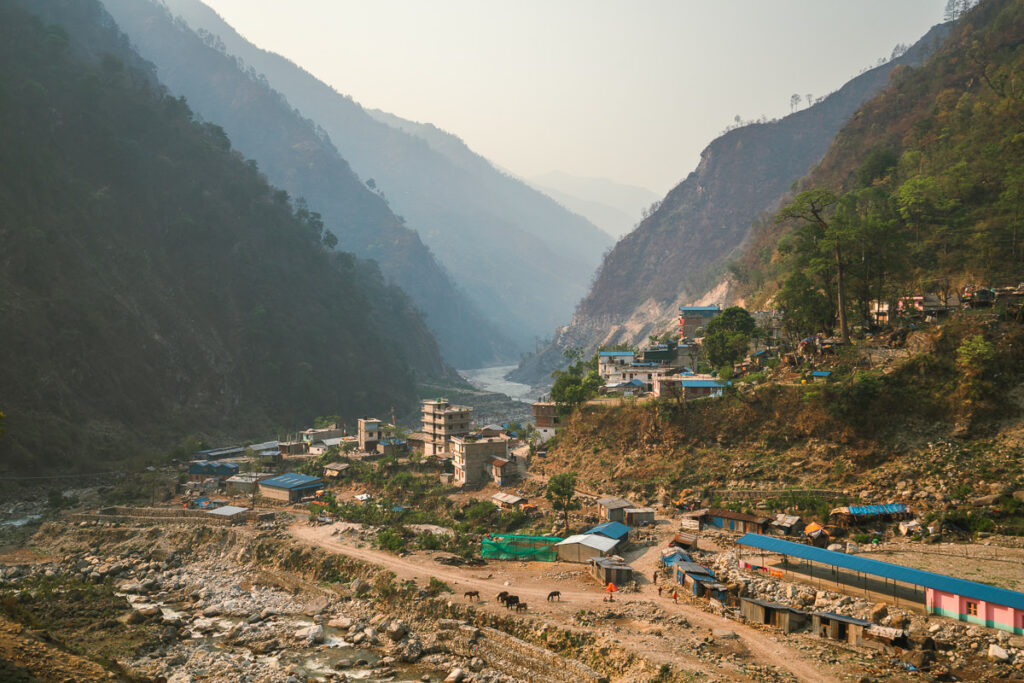
We woke a little bit sore and tired as our bodies adjusted to life on the trekking route. From Jagat, the trail wound through sub-tropical forests, alongside small rivers and quiet villages where we often stopped for a cup of tea.
The valley opens up in the early stages of the trail, which reaches Ghatta Khola river. One of the interesting parts about the route today is the very long suspension bridge in Philim, which is a large Gurung village. Later in the day, the route passes through a wild gorge as you criss-cross the river on suspension bridges before passing through the bamboo forests to the Deng Khola river. After crossing the river, you’ll reach the tiny village of Deng.
Day 2 Highlights:
- The layers of mountains were sometimes five or six deep as I began to wonder how we could be so high, yet so far below these peaks.
- Reaching camp today just before sunset was a great feeling. Back-to-back days of 20Km+ day with 1500m of climb means I surely deserved a Gorkha beer!
- The suspension bridges are always fun and today we crossed a couple of very high passes. There’s always an element of risk and excitement with these suspension bridges as they’re tattered with holes and battered by rockfall.
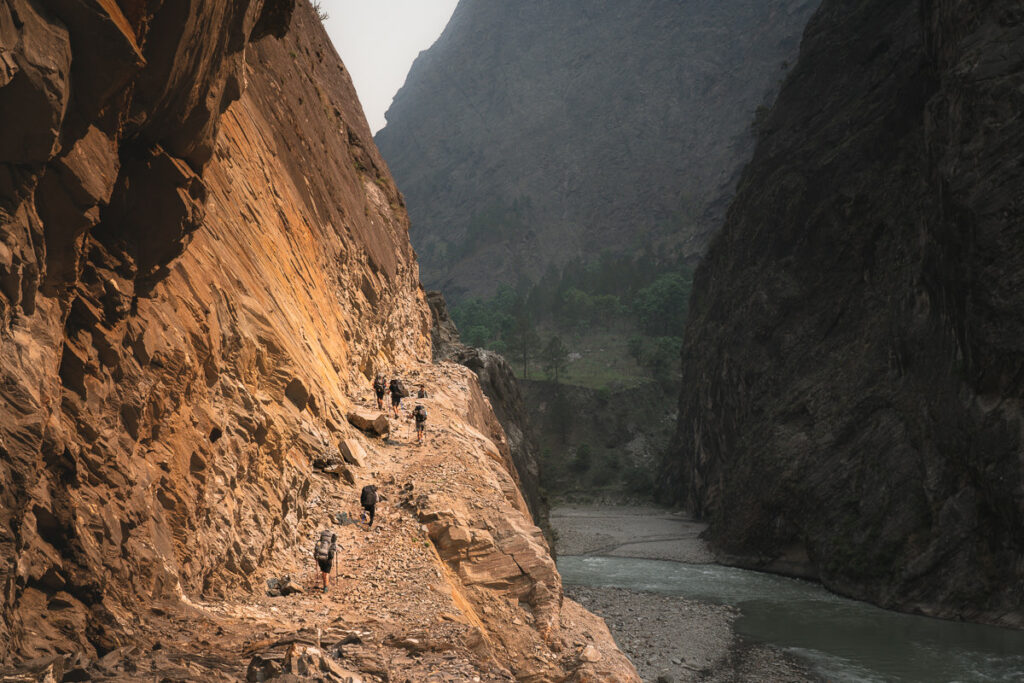
After breakfast in Deng, the trail takes you to one of the most important and culturally significant sections of the trek. Firstly, you will cross the Budhi Gandaki river and make the climb up to the bridge, where you’ll ascend further to join a trail from Bhi. The trail then leads you through the lush forests, alpine vegetation, and small villages. This is the first time the major peaks will start to appear in the distance.
Today is a shorter day and after a final ascent through the forest, you will reach Prok, a Tibetan village situated on a very scenic plateau beneath towering peaks. Green and yellow farming fields create a patchwork display of colors in this traditional town. It’s time to settle in because on this itinerary, we stay in Prok for two nights.
Day 3 Highlights:
- Sitting inside a tiny tea house, precariously perched on a cliff-side when a storm hits. As the rain hits the tin roof and the wind blows wildly all I can think about is how isolated people in this region are and how inhospitable the weather can be. That gets more and more apparent the higher we climb.
- A few stunning suspension bridges today with a lush green forest below contrast against the cool hues of the glacial river. Nepal is truly beautiful.
- We reached our guest house for the night in Prok, which is a very small village. I sat in the kitchen loft with the 81-year-old grandmother and the wife for Tibetan tea as we watched the Daal baht process. The kitchen and entire house were traditional Tibetan style. The grandmother spun her prayer wheels and through our guide’s translation told us she feels Tibetan, not Nepali. Having two of the guys on the trek translate gave us unique insight into the experiences and life of a Tibetan from the pre-Chinese occupation era.
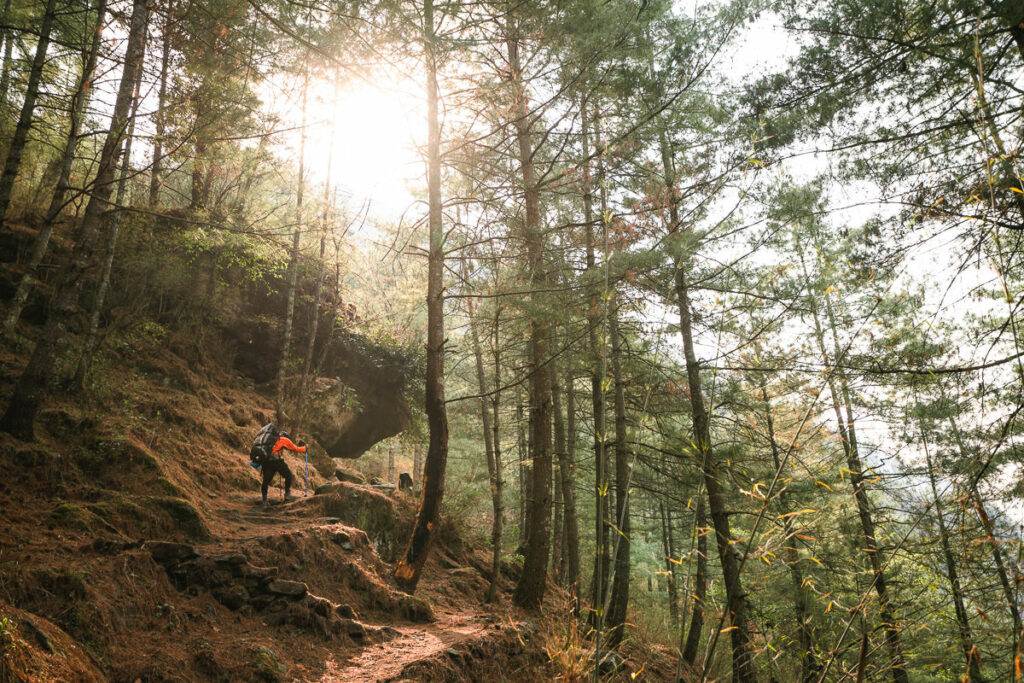
Today was a pretty heavy day with a very steep climb up to Kal Tal lake. The route is basically straight up and winds along switchbacks through the forest. Along the way, we passed a beautiful monastery and several meditation huts and accommodations scattered throughout.
The total climb was more than 1500m over less than seven kilometers so it is very steep and coming down gave the legs a huge workout. Today capped off over 6000m of an incline in just four days so it was a pretty aggressive start to the trek.
On a sunny day, this alpine lake is spectacular. Crystal clear water and towering, snowy mountain peaks provide an epic backdrop. We were a bit unlucky with the weather as it was grey and gloomy but still spectacular.
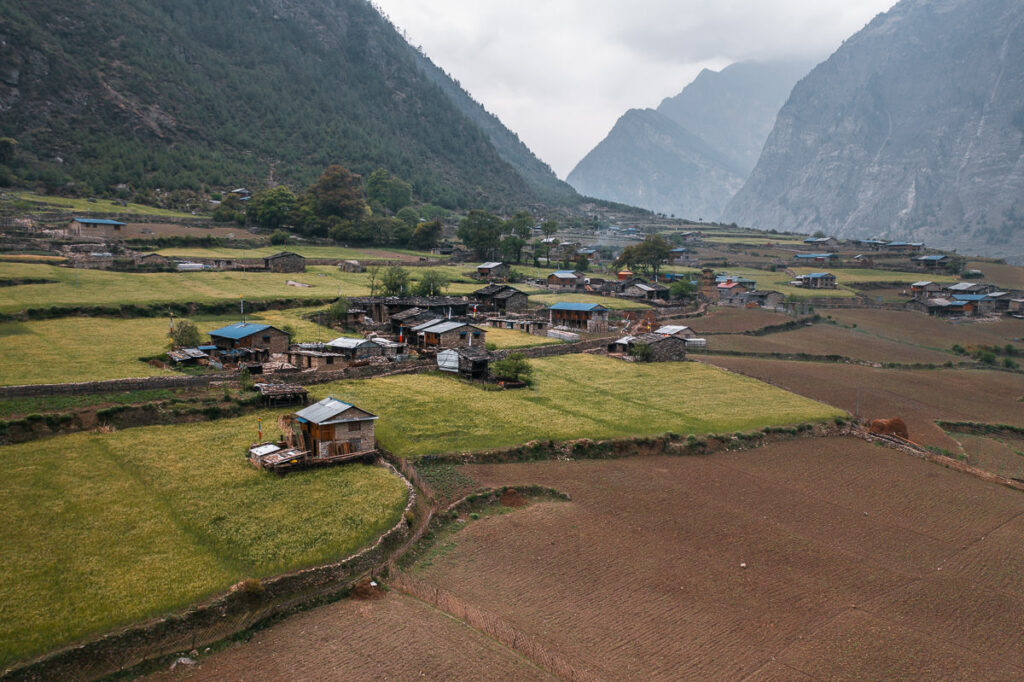
View this post on Instagram A post shared by Jackson Groves (@jackson.groves)
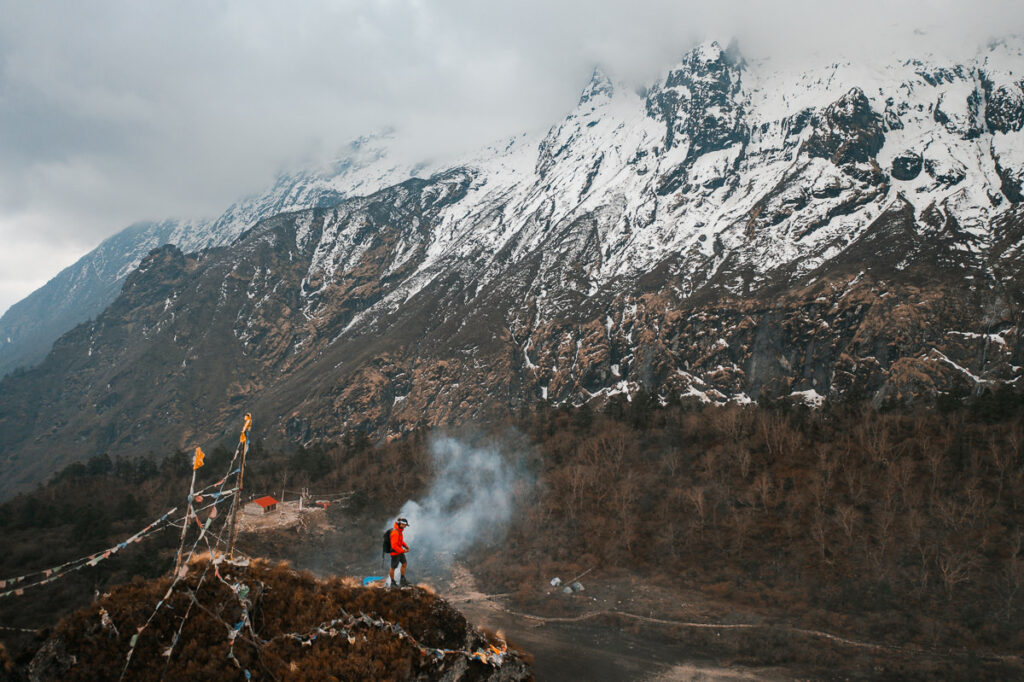
Finally, an easy day arrived and we all needed it badly. After 6000m of incline and 80km on the first four days of the trek in some pretty heavy sun, we were spent. Today seemed like a stroll in the park as we meandered our way to Namrung, taking just a few hours.
The path today is in the phase of switching out of the sub-tropical forest into the alpine forest so it had a mix of everything. At the entrance to each town, we can now find lots of ancient scripts displayed at the entry path.
Day 5 Highlights:
- A shorter day from Prok to Namrung was just what the doctor ordered so when we rolled into Namrung in the early afternoon, we all breathed a sigh of relief to have time to rest our bodies.
- A steaming hot shower for $2.50 on the fifth day of a trek is always money well spent. Clean, refreshed, and ready to push on.
- We bought a pack of cards for $1 at Namrung and had a few different games rolling throughout the night. It’s fun to enjoy the good vibes amongst this really chill group from Nepal.
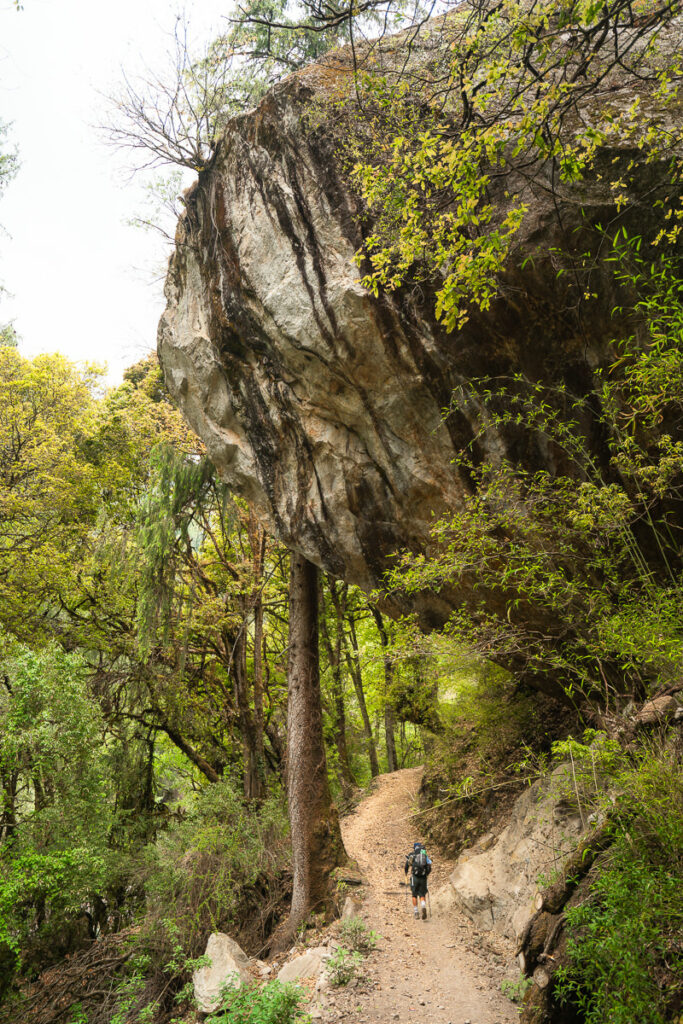
The trek to Lho leads us through wild sections of oak, fir, and rhododendron forests throughout the climb higher up into the valley. The air is beginning to thin for the first time so the pace is slightly slower today but with just 11km to cover, it was a touristic day with some nice cultural sites and stupas throughout the route.
Day 6 Highlights
- Larkye our Manaslu dog has officially joined us. Despite being asleep as we headed off from Namrung, he quickly caught up to us and has hardly left my side since.
- Lunchtime was at a small village with an epic view across the fields and up towards towering hills. Spicy noodles out in the sunshine had us feeling incredibly relaxed and on the recovery after the first four savage days of the trek.
- Sunset from Lho was very grey and cloudy but in the midst of blue hour, Manaslu appeared. It was the first time we’d all laid eyes on the 8000er and it was a pretty majestic moment.
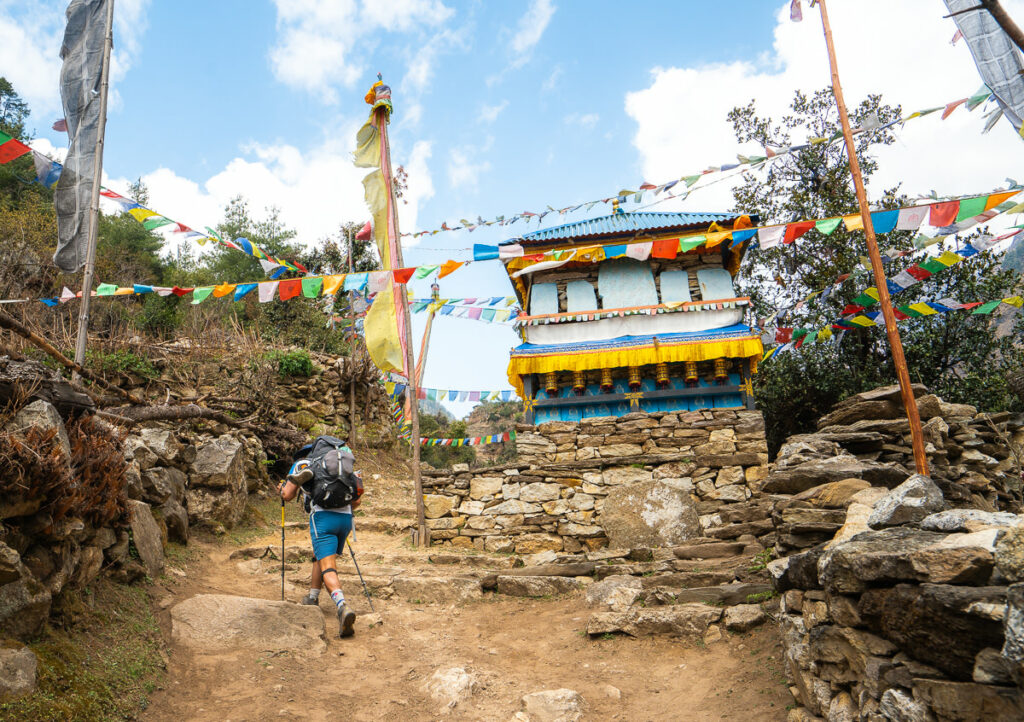
Today the climb continues up the valley and enters the high alpine pastures. Expect to see lots of Yaks grazing across the expansive hills and steep mountainside. One of the best suspension bridges of the trip with a huge mountain backdrop was the highlight of the day.
At our tea break, we had views of snow peaks in all directions and that’s where I shot most of the photos you can see below. From our lodge, we will have an incredible view directly up at Mount Manaslu that towers over the valley and we would stay here for two nights.
Day 7 Highlights
- A blue hour from the rooftop and an incredible sunrise with views of Manaslu was such a memorable start to the day. I felt like I was in Switzerland. We all had breakfast together on the rooftop and it might just be the most scenic fruit muesli I’ve ever had.
- A tea break on our way to Samaguan gave us the best views yet as the clouds were yet to engulf the surrounding peaks. I ripped out the 100-400mm and got some incredible shots of the snowy ridges as the clouds swept through.
- Our first WiFi of the trip at Samaguan was a great chance to catch up on the real world. We quickly realized nothing much had changed and were grateful to be out in the wilderness of the Himalayas.
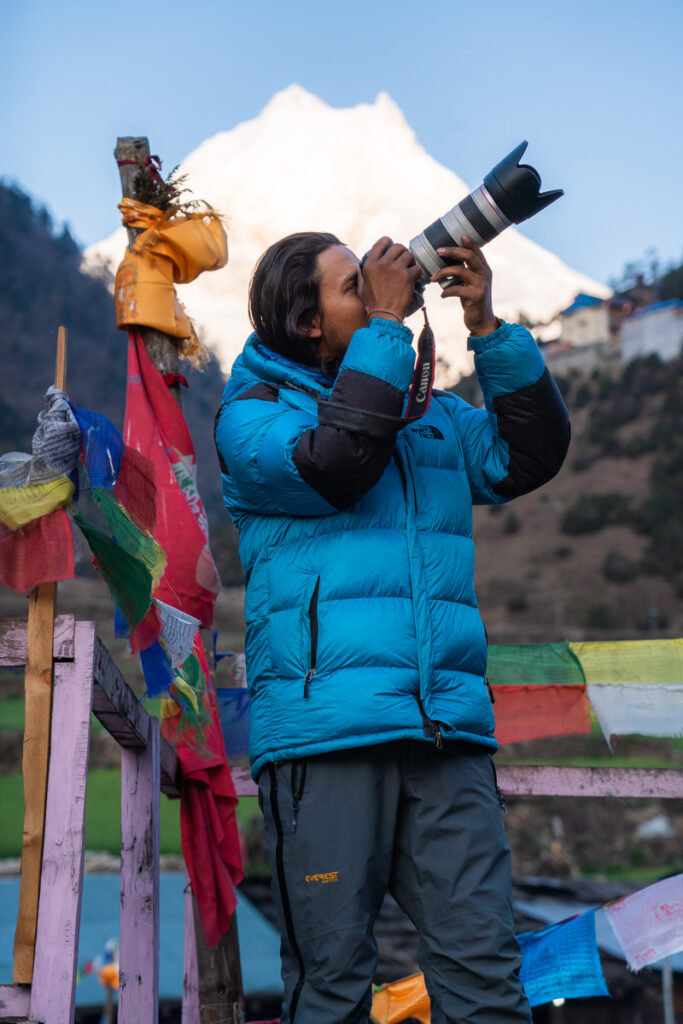
This was by far one of my favorite days of the trip aside from the Larke Pass day. Pungen Gumba is a monastery site at 4200 meters. It sits directly beneath Mount Manaslu at the top of a huge plateau in an ampitheater of mountains. I set off on my own at 4 am to make the 8-kilometer trek in the dark hoping to see some alpenglow or sunrise colors with a clear Mount Manaslu.
The weather gods shined on me and the effort up the rocky hill to the monastery provided me with the best views of the entire trip.
Day 8 Highlights
- After a rainy night before we committed to a sunrise mission. I left solo at 4 am to Puneng Gumba, a monastery built into the cliffs at 4,100. The others joined me a little later and our efforts were rewarded with clear views of Manaslu and one of the most stunning locations I’ve ever explored. One of the best mornings of my life, just me and the dog up at 4,100 meters taking it all in.
- Sitting in the sun at the monastery, the other three finally arrived and brought some tea. Sipping on my cup I was just incredibly grateful to be out here. The views were just jaw-dropping.
- Yaks, foxes, and marmots up in the snow at Pungen Gumba were quite a cool wildlife sighting and the latter two came unexpectedly.
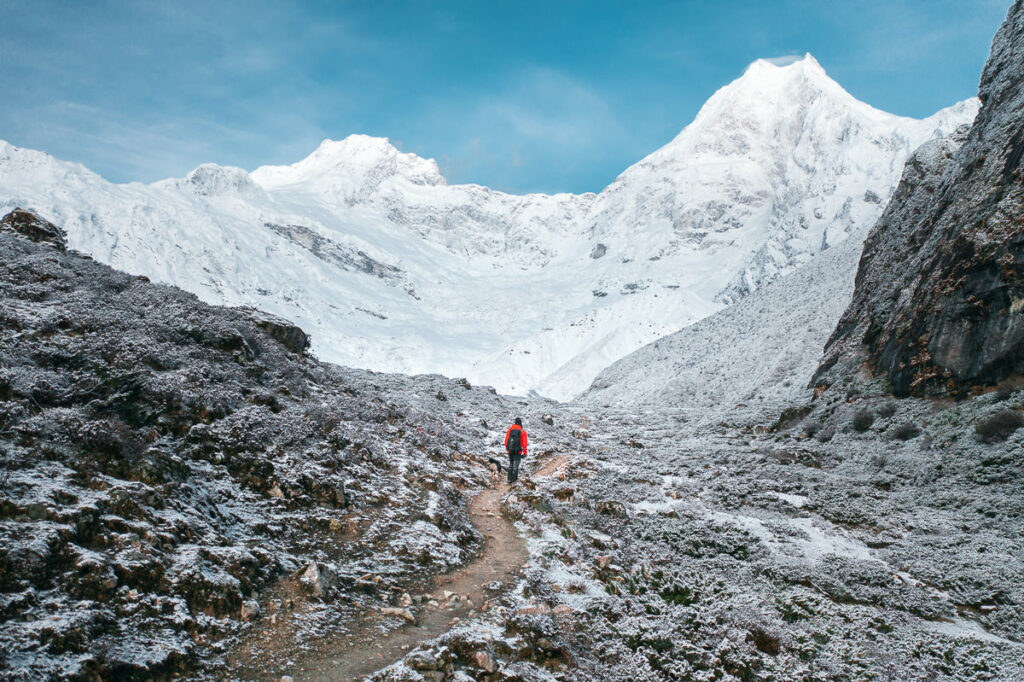
On day nine we began with a short visit to Birendra Lake before breakfast and then the trek heads up through the valley to the Tibetan village of Samdo. This is actually the highest Tibetan refugee camp in Nepal and is pretty remarkably perched on the cliffside.
Sunset at Samdo is truly a spectacle with peaks in all directions. Along the way, we will pass through Birch forests and we will see a few Marmots running to hide from us in their little holes. We will have the afternoon to relax and enjoy the views from our cute little village
Day 9 Highlights
- Our first rain was endured on the short trek to Samdo, a town at almost 4000m of elevation. Along the way, we passed hundreds of huge yaks who were more interested in grazing than us trekking through.
- Samdo was freezing but a warm fire at night in the tea house kept our spirits high. Cards, coffee, and incredible sunset sends us into day ten full of energy.
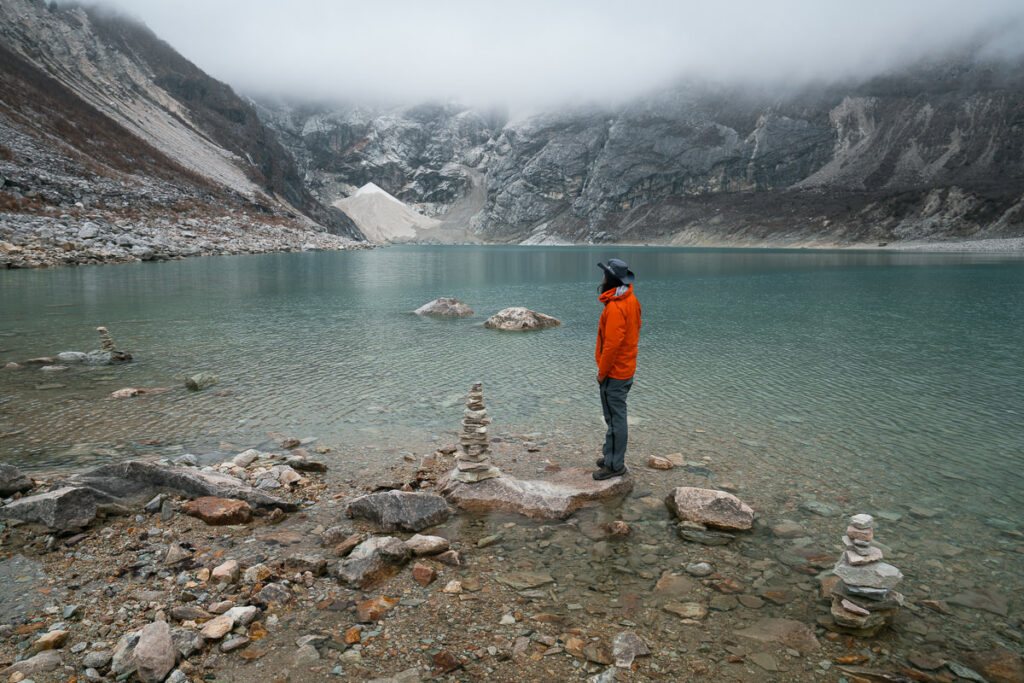
There’s just one day left until we cross Larke La tomorrow so today we ascend to the small base camp of Dharma Shala for the night. It’s bloody freezing here at almost 4500m and there’s no heater. It’s literally just a bunch of rooms perched up on the hill with one small kitchen. It’s a short walk to reach Dharama Shala taking just a few hours but you are at altitude, so you may begin to have a small headache if you are unlucky.
Day 10 Highlights
- I woke up and opened my door to the sight of fresh snow falling in Samdo. In the morning, the Tibetan refugee village was incredibly isolated and covered in a thick blanket of snow, which only exacerbated that feeling of being hidden in the mountains.
- At 4,460m, Dharma Shala is a freezing place to stay the night. With no fire or heater, we slept in all of our winter trekking gear. The hot bottle of water was the only thing adding any warmth to our bodies as we enjoyed our last sleep before attempting the Larke Pass.
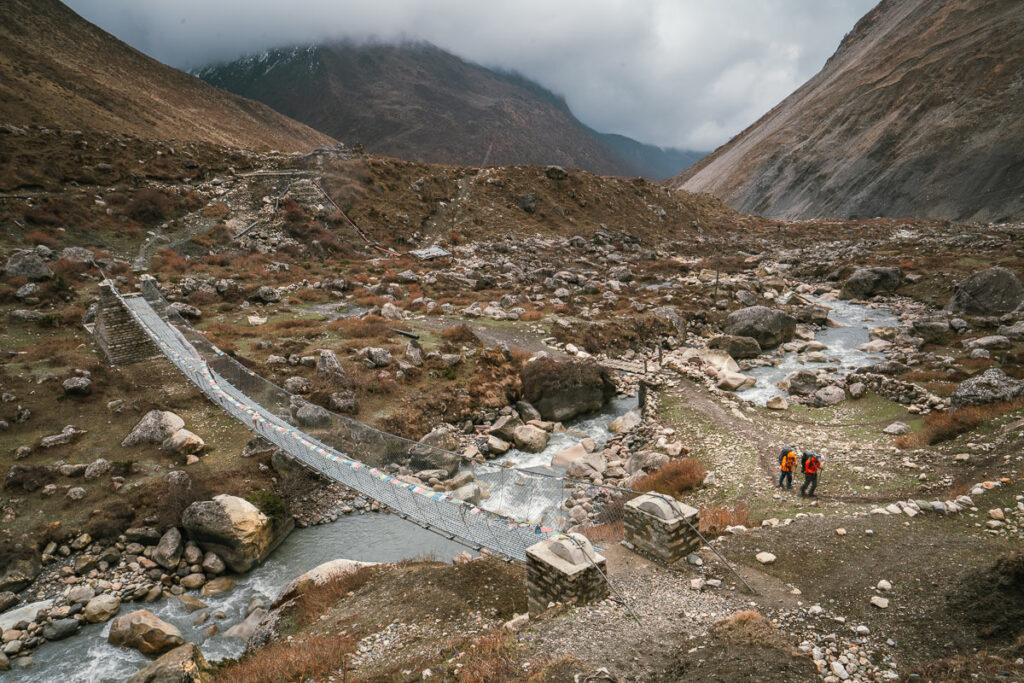
Day 11, Darmashala (4466m) to Bhimtang (3709m) via Larke Pass 5134m, Distance: 18km, Incline 800m
Today is the big day. We woke at 3:30 am and set off just after 4:30 am in time to catch the first moments of the blue hour and sunrise. It takes about three to four hours to reach Larke La at 5106 meters. Along the way, you have an amazing corridor with huge peaks on either side. This was one of my favorite sections of trail throughout the entire route.
At Larke Pass, it is time to have the prayer flags and take in the view and the achievement! The descent is quite steep and I even put on the micro-spikes for a portion of the downhill. The first village we reach is Bhimtang where we will stay for the night and enjoy a good rest.
Day 11 Highlights
- After a rainy and cloudy night, we were a little worried about our journey to Larke Pass would lack the incredible views it had promised. Upon waking up at 3:30 am, we could faintly make out the lines of the mountain ridges. We knew we had lucked out and were in for a day of clear weather.
- I walked the Larke Pass alone for the most part. I turned on some music as my head tilted from side to side trying to etch these incredible peaks and mountain views into my mind. I never wanted to leave nor forget this incredible corridor in the Himalayas of Nepal.
- Reaching Larke Pass at 5,106m was a milestone and something we had spent 11 days working towards. With just a slight headache, I was glad to reach the collection of prayer flags at the top and take it all in.
- The snowy descent down to Bhimthang was the type of adventure I crave. With microspikes on and a few slips, we enjoyed the high-tempo descent into town. We were thankful for a hot coffee and noodles as we huddled around the kitchen fire in Bhimthang. We had made it, safe and sound.

The final day of trekking is long and downhill. Your legs are tired from the day before but thankfully the incline is very rare and you basically just walk your way out of the alpine zone, into the forest, and then emerge to Dharapani beside the river. It was a long day with more than 25 kilometers to tick off but the walking was easy and going down in altitude is always a refreshing change. It was a good journey through the beautiful forests to reflect on the trek.
Day 12 Highlights
- Spicy noodle soup at mid-morning in a small hut with a lovely local serving us.
- A well-deserved beer (or two) at the Heaven Hotel in Dharapani to cap off an incredible journey.
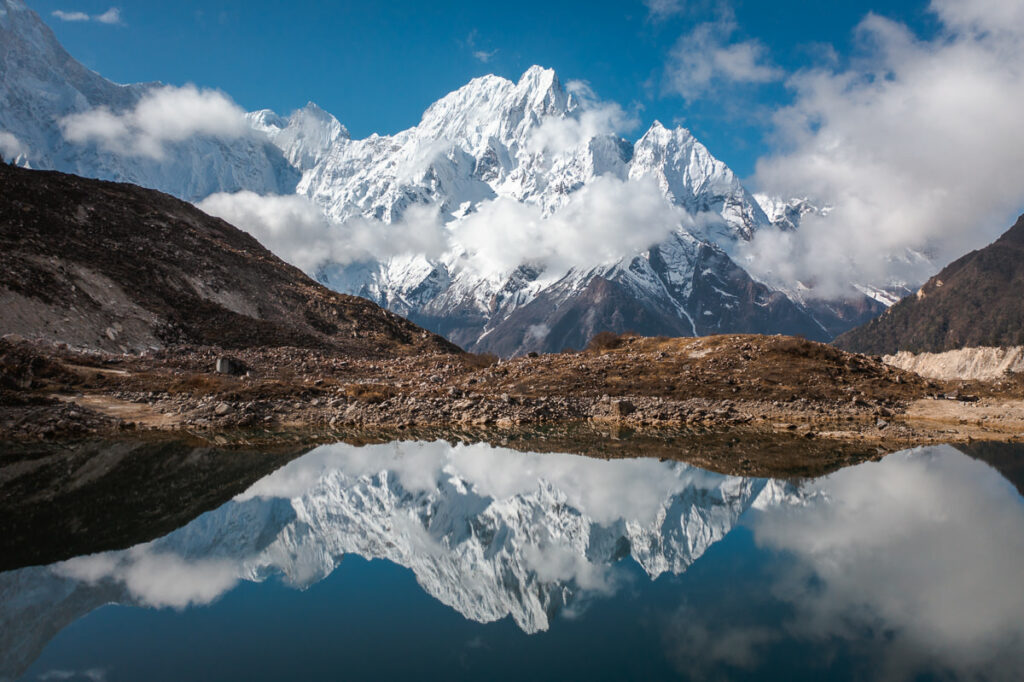
I hope you enjoyed this massive wrap-up of the Manaslu Circuit Trek. I loved photographing and filming the expedition and I truly loved the trail. I think it offers much more adventure than the other popular circuits in Nepal although let’s face it, any trek amidst the Himalayas is probably going to be epic. Do leave me a comment below if you have any questions or want to share any thoughts about your trek on the Manaslu Circuit. Happy hiking!
HAVE YOU READ MY OTHER NEPAL BLOGS?
I’ve been lucky enough to have many awesome adventures in Nepal, which you can check out below where I’ve listed some of my favorite blog poss from Nepal.
- The Most Iconic route: Everest Base Camp Trek
- The Most Scenic Route: Annapurna Circuit Trek
- My Favorite Trek in Nepal: Manaslu Circuit Trek
- An Easy Nepal Trek: Langtang Valley Trek
- A great beginner peak: Island Peak Climb (6,165m)
- My Favorite Climb in Nepal: Climbing Ama Dablam (6,812m)
- My first 8000er: Climbing Manaslu (8,163m)
- My toughest climb in Nepal: Climbing Makalu (8,463m)
- Where to stay: 16 Best Places to Stay in Kathmandu

Tuesday 11th of April 2023
Beautiful photographs! I am also wondering what time of year you went?
Sunday 29th of August 2021
Bonjour, merci pour ce généreux partage et vos très belles images. A quel période de l'année avez vous fait ce trek ? Je vous souhaite une belle poursuite à vos projets.
Saturday 15th of May 2021
Well done, Jackson! Those sunrises and sunsets in the mountains look incredible. Can't believe you got to visit Tibetan villages before me too! Next time eat the tsampa with your hands haha
Ken McKinney
What a great writeup! I have a couple of questions: 1) what time of year did you do this trek? 2) I've previously hiked Annapurna and EBC, but I am older now and less fit. Would it be possible to make the Manaslu Circuit less difficult by doing shorter daily stages, or does lack of teahouses make this impossible?
Wednesday 22nd of June 2022
@Ken McKinney, He did it in March 2020. See his remarks about lockdown. And yes, it is possible to make it more manageable, the number of lodges is about the same as the number of lodges on the Annapurna Circuit in the 1990's.
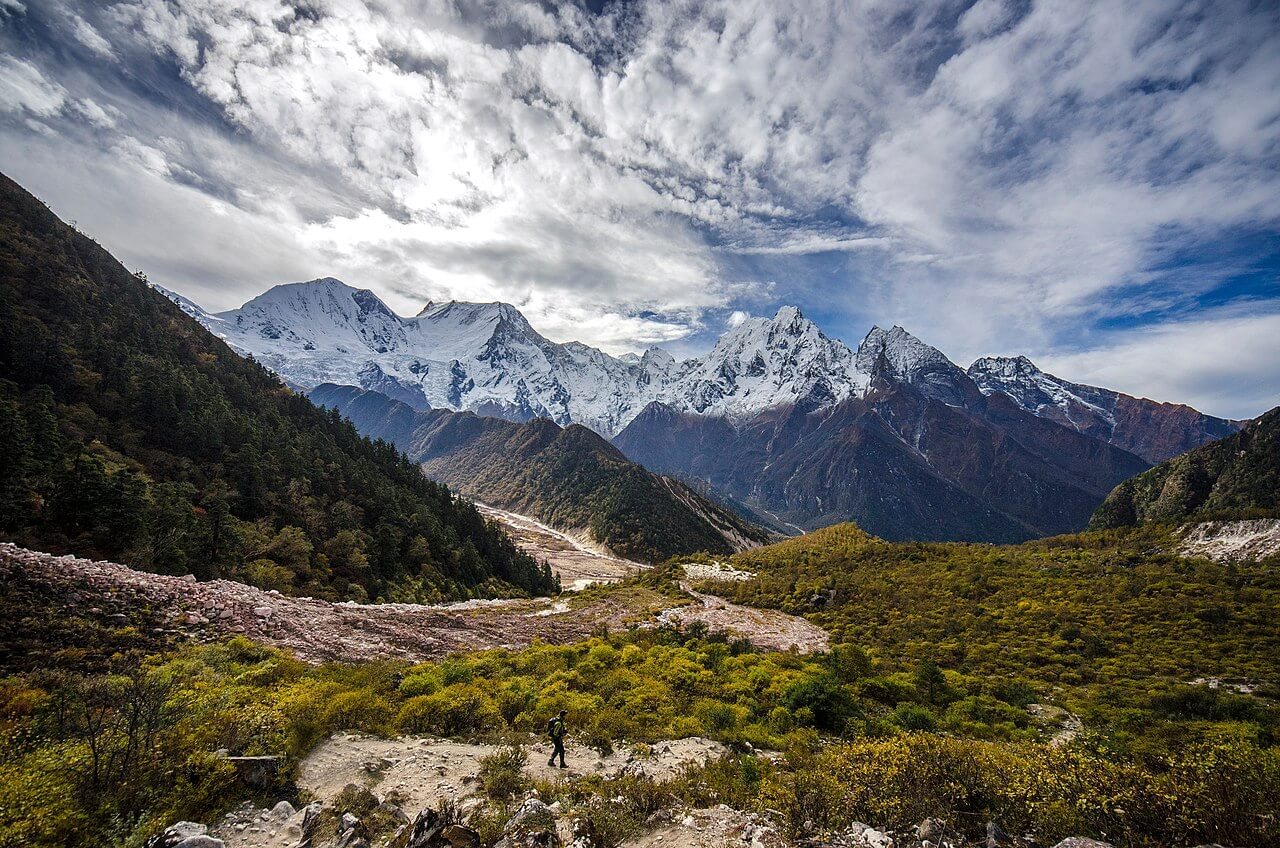
Manaslu Circuit Trek
Manaslu Circuit Trek stands less beaten and secluded compared to treks like Everest or Annapurna , but it is equally as impressive as other classic treks.
Manaslu Circuit Trek is the most beautiful as well as demanding treks in Nepal . Trekking in Manaslu is a delightful experience with a blend of adventure, scenery, culture, lifestyle, and wildlife. Located in the western part of Nepal, this trek provides you with an opportunity to encircle around the world’s 8th highest massif, Mt. Manaslu.
Manaslu Circuit Trek rewards you with magnificent spectacles of some of the highest mountains in the world, including Manaslu and Annapurna. With diverse landscapes, unique cultures, rare flora, and fauna, Manaslu is one of the most sought out destinations for avid trekkers. Most of the travelers who choose this trek tend to enjoy less trodden mountain trails rather than the well-known trekking destinations.
Throughout the trail, this trek takes you via the high valleys, isolated villages, ancient monasteries, tranquil lakes, and high Himalayan passes.
Table of Content
Manaslu Circuit Trek Facts
Highlights of manaslu circuit trek.
- Comparatively remote and off the beaten trekking destination in the Himalayas of Nepal.
- Diverse landscapes ranging from subtropical forests to the high Himalayan passes.
- Crossing over Larkya La Pass (5,135m), the highest elevation point on the trek.
- Discover the timeless culture and lifestyle of the Manaslu region.
- Enjoy the epic mountain sights as this trek offers glimpses of Mt. Manaslu, Himalchuli, Ngadi Chuli, Ganesh Himal, and Larke Himal.
- Discover rare and abundant wildlife. Manaslu is home to 33 different species of mammals, 110 species of birds, and 211 species of butterflies.
Getting There and Away
Start of the trek.
You’ll start your adventure with a scenic drive from Kathmandu to Soti Khola in Budhi Gandaki Valley. You can drive to Soti Khola (141 km) via 4×4 Jeep (8 hours) or by a local bus (10 hours).
End of the Trek
The endpoint for Manaslu Circuit Trek is Dharapani. You’ll have to take a jeep from Dharapani to Besisahar and switch the vehicle back to Kathmandu.
14 Days Outline Itinerary of Manaslu Trek
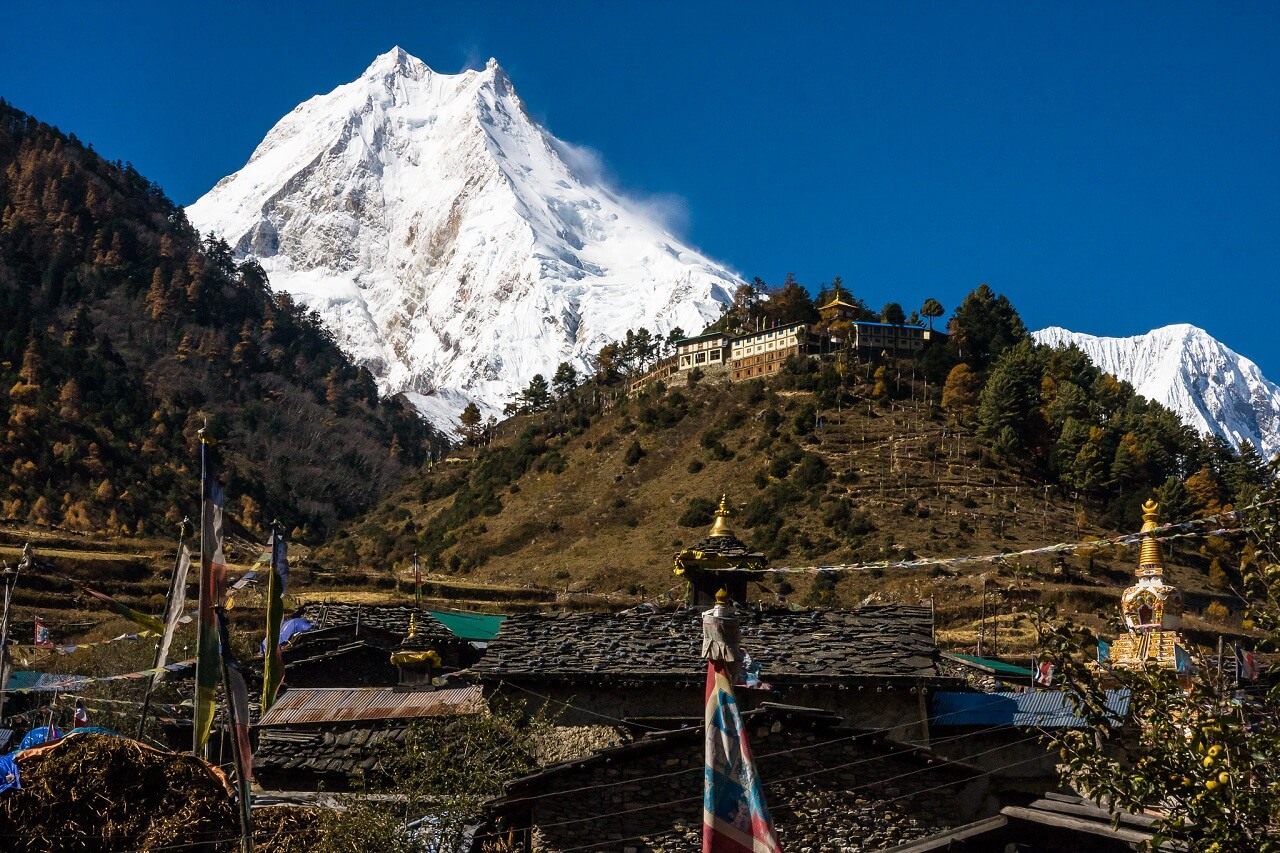
Manaslu Circuit Trek 14 Days Detailed Itinerary
Day 1: drive from kathmandu (1,400m) to soti khola (815m) via arughat (941m) – 8 to 10 hours.
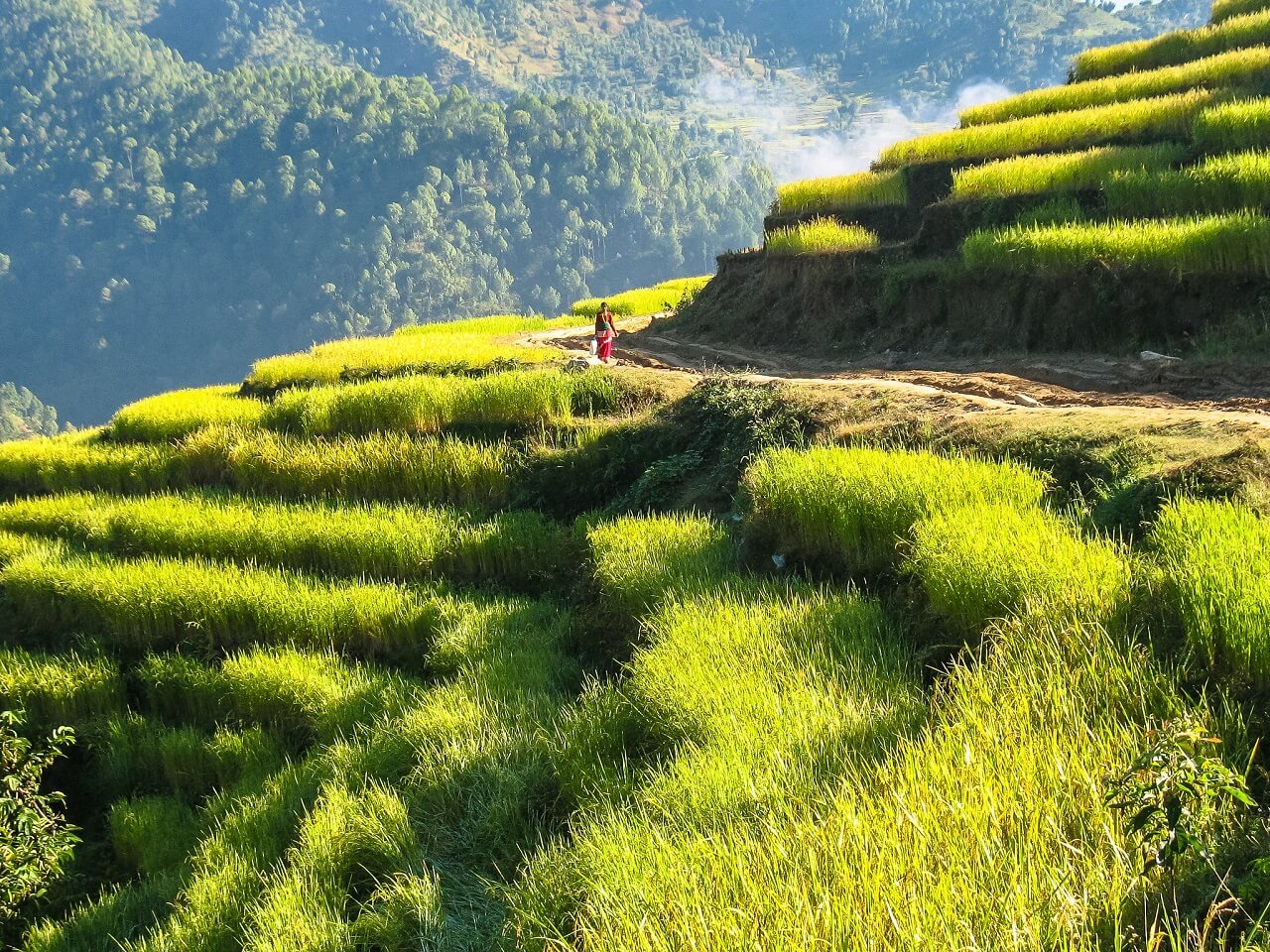
Your adventure to Manaslu Circuit Trek begins with an early morning drive westwards to Soti Khola via the Prithivi Highway. This scenic drive alongside the mighty Trishuli River passes through occasional small towns, breathtaking terrace fields, and lush green hillsides.
Upon reaching the Malekhu Bridge, the vehicle will take a turn towards Dhading Besi, away from the highway. Eventually, you’ll be traveling on a rutted, dirt path towards Arughat as the views of mountains like Annapurna, Manaslu, Ganesh Himal, and Langtang Himal start unfolding in the horizon.
After about 8 to 10 hours of driving, you’ll reach Soti Khola.
Day 2: Trek from Soti Khola (815m) to Machha Khola (900m) – 6 to 7 hours
On this day, your trek starts by crossing the bridge over Soti Khola with a splendid view of the waterfalls. The trail leads to the dense forest before ascending onto the ridge right above the Budhi Gandaki River.
After hiking through the rocky terrain, you’ll arrive at the village of Khursane. Eventually, after descending past the paddy fields, you’ll trek around the Gurung settlement of Lapubesi. Walking along the sandy beds of Budhi Gandaki River, you’ll go down towards the Naulikhola.
Upon crossing the suspension bridge over the river, you’ll arrive at the tiny settlement of Machha Khola.
Day 3: Trek from Machha Khola (900m) to Jagat (1,370m) – 6 to 7 hours
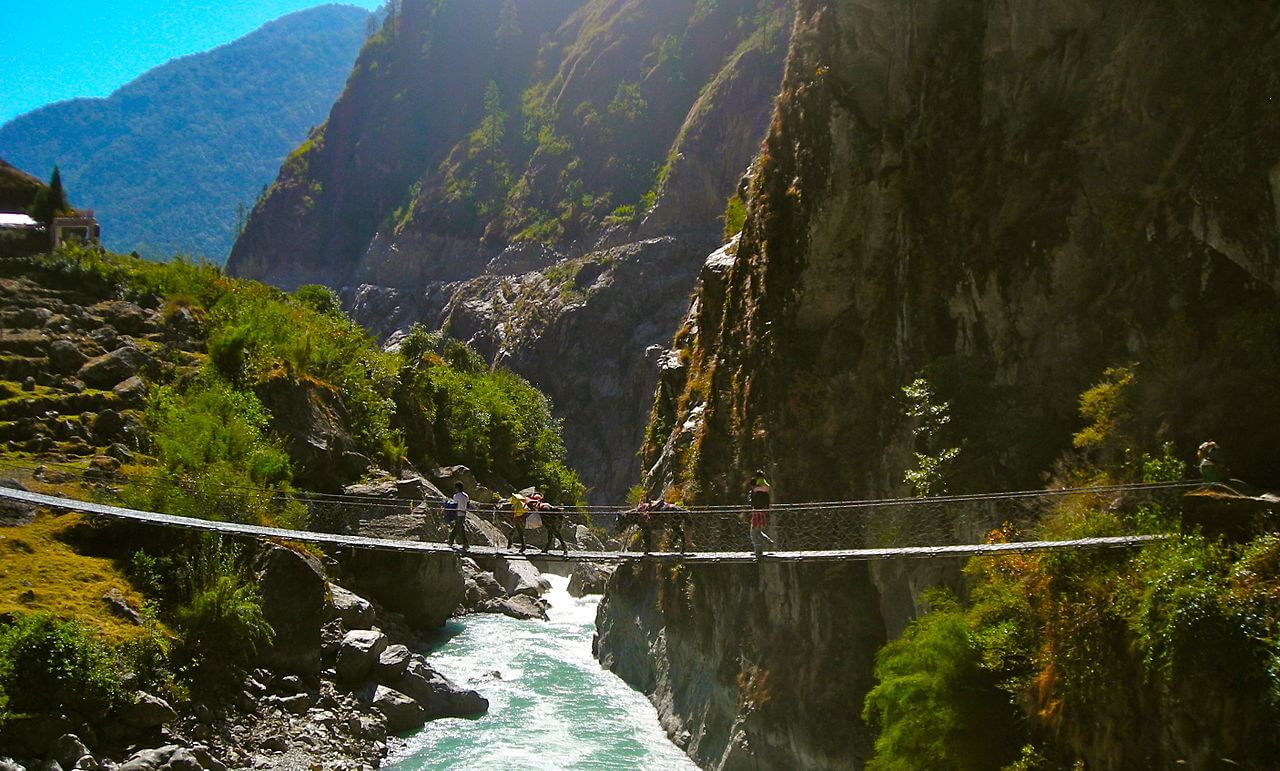
Today, the day may get slightly strenuous as the trail to Maccha Khola leads to several uphills and downhills. Your day begins following the narrow paths along the gorge with a gentle uphill and downhill. After a while, you will cross Tharo Khola to reach another Gurung village at Khorla Besi.
As the trail ascends and descends, you will arrive at a natural hot spring in Tatopani. After arriving at Tatopani, you’ll climb a steep ridge then cross the Budhi Gandaki River via a suspension bridge. The trail then heads over the hill towards Doban after climbing up the stone steps.
After crossing the suspension bridge over Yarkhu Khola, the trail leads to another steep section of the stone staircase. The trail then navigates towards the river before ascending through some more stone steps towards Thado Bharyang.
Heading across the west bank of Budhi Gandaki River, you’ll climb over the ridge and walk alongside the river towards Jagat. The village of Jagat is the entry point of the Manaslu Conservation Area (MCA).
Day 4: Trek from Jagat (1,370m) to Deng (1,865m) – 6 to 7 hours
You begin the day with a steep ascent over the rocky ridge to Salleri, then make a gentle descend towards Sirdibas. Then, continue trekking towards Ghatta Khola and cross a long suspension bridge to arrive at Philim, a large Gurung village.
The trail now heads northward across the millet fields to Ekle Bhatti. You navigate through the sloppy grasslands then cross the Budhi Gandaki river. After you walk along the riverbank, the narrow trail opens up through the valley. You’ll then walk in the shades of bamboo forests towards the Deng Khola. Upon crossing the river, you’ll reach your destination, Deng.
Day 5: Trek from Deng (1,865m) to Namrung (2,630m) – 6 to 7 hours
After leaving Deng behind, you commence the day by crossing the Budhi Gandaki river. From the bridge, make a gentle ascend to reach the trail from Bhi. Now, head westwards up the Budhi Gandaki Valley and walk past the lush green jungles and traditional villages of Manaslu.
Although there are a few alternative options, this itinerary takes the route that passes through the village of Prok. The viewpoint of the settlement offers a magnificent view of the Siringi Himal. You cross the Budhi Gandaki river time and again today and walk past the ancient monasteries en route to Namrung.
The trail navigates along the river upstream under the shade of the dense bamboo forest until you reach Namrung.
Day 6: Trek from Namrung (2,630m) to Samagaon (3,525m) – 6 to 7 hours
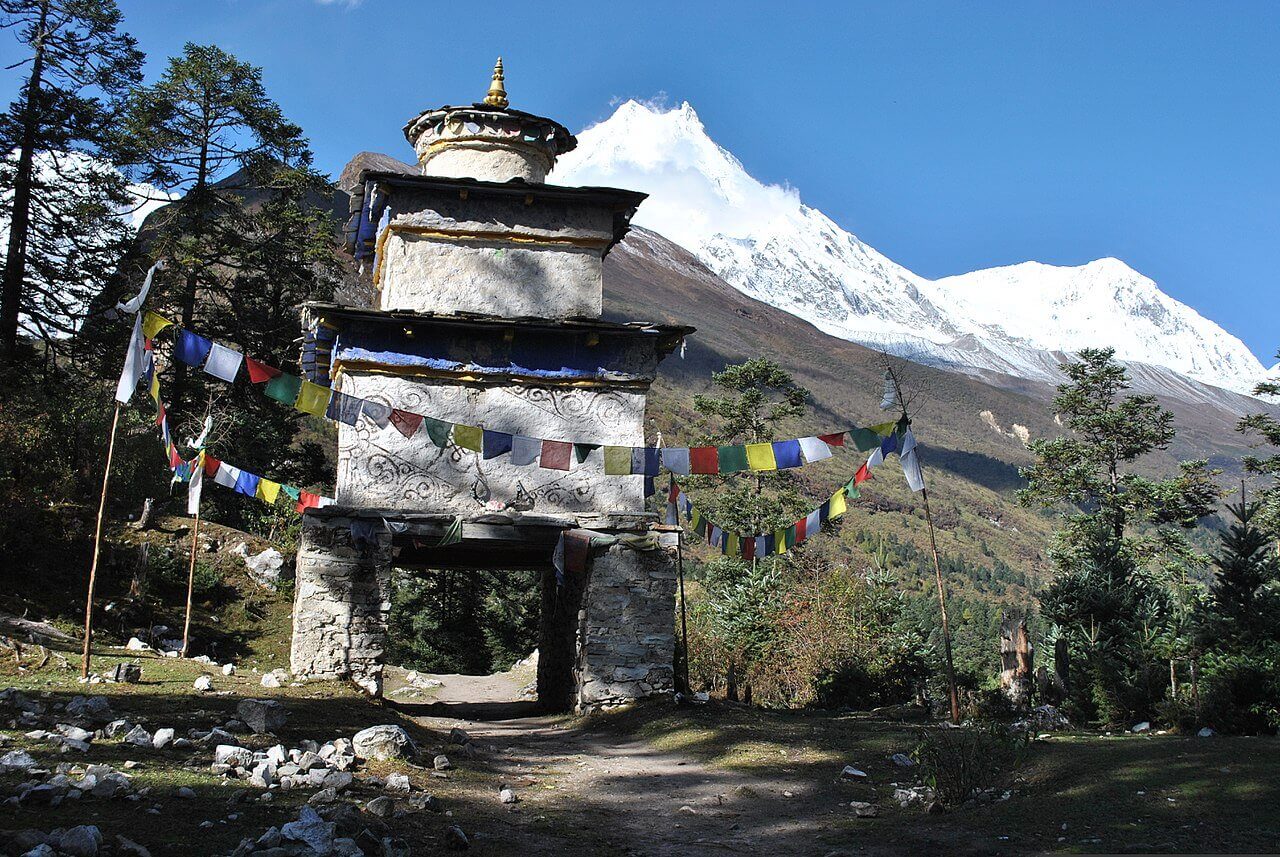
Namrung village offers a magnificent sight of Siring Himal, Ganesh Himal, and Mt. Himal Chuli. After enjoying the morning spectacles of the Himalayas, the trail leads uphill through the lush green forest to reach Lihi village.
Furthermore, you walk past several remote villages like Sho, Lho, and Shyala before arriving at Samagaon. Upon reaching Lho, you will enjoy the extraordinary view of the world’s 8th highest mountain, Mt. Manaslu. Snow-capped mountains surround Shyala village from all directions — Himal Chuli and Peak 29 (Ngadi Chuli) on the left, Mt. Manaslu and its glacier up ahead, and Ganesh Himal on the far right.
Your adventure for the day ends as you reach Samagaon.
Day 7: Acclimatization Day at Samagaon (3,525m)
A much-required rest day at Samagaon to acclimatize with the higher altitudes. On this day, you can choose to take a rest in the teahouse or hike around the nearby destination to keep your feet stretched.
For those who want to explore around instead, you can take a short hike up to an old monastery, Pungyen Gompa. This ancient monastery offers an excellent view of the glacier.
Day 8: Trek from Samagaon (3,525m) to Samdo (3,850m) – 4 hours
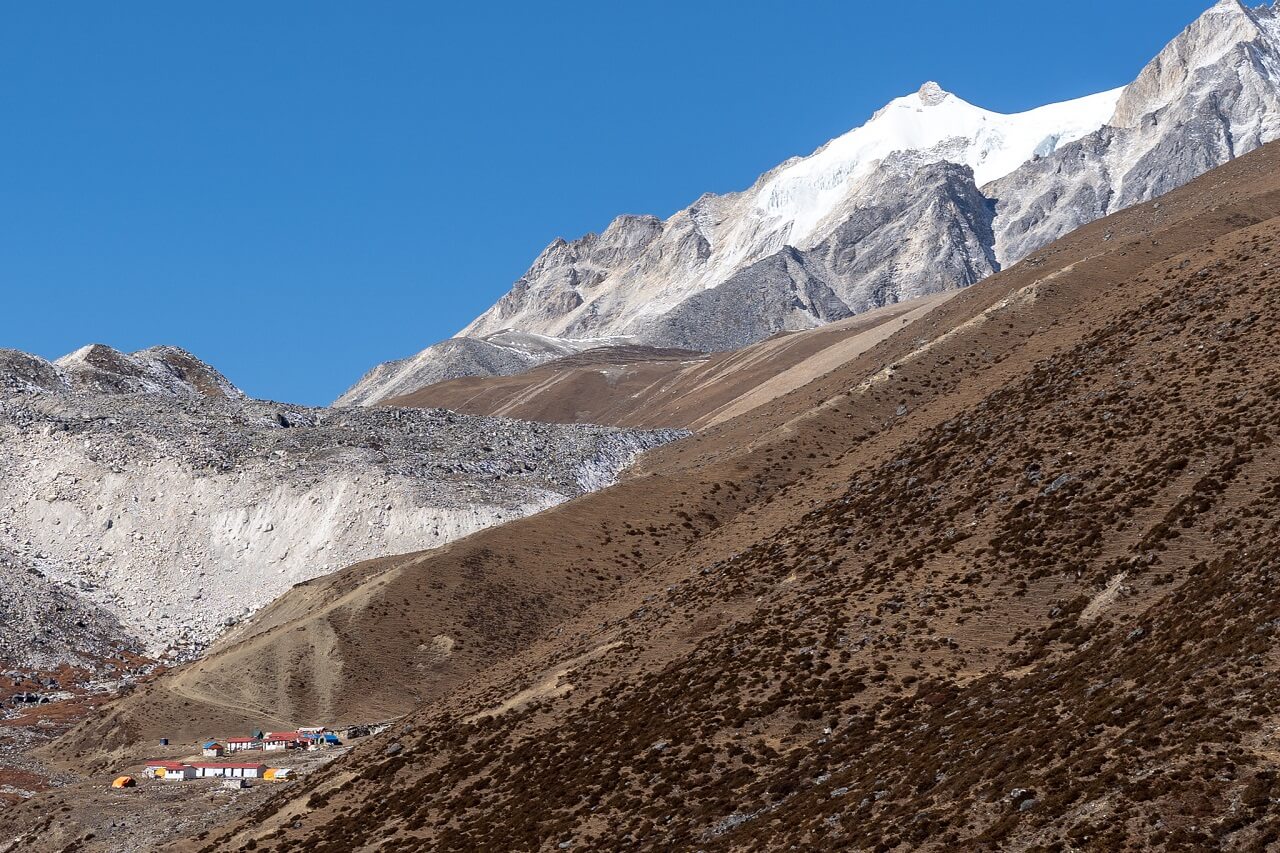
Begin your day with a slight descend to Budhi Gandaki River then head towards the bridge over a side stream. The valley begins to open spread out as you walk across several Mani walls. Enjoy the magnificent views of the mountains along the trail as you edge closer to the Tibetan border.
Then, the trail leads to an accessible route right above the river under the shades of birch and juniper forests. Samdo offers an excellent view of the mountains, especially Mt. Manaslu. Since Samdo is a village of Tibetan refugees, Tibetan Buddhism widely dominates the area.
Day 9: Acclimatization Day at Samdo (3,850m)
Another acclimatization day at Samdo begins before heading to the challenging sections of the trek. There are a couple of alternatives for day hikes in Samdo.
The first option is an easy walk to the valley directly behind the Samdo village. The trail offers magnificent mountain views including Mt. Manaslu, Hiunchuli, Simrang, Ngadi, and Larke Peak.
Another option is to hike towards Gya La, a long pass north of the village. Excursion to Gya La is slightly longer and more strenuous than the first one.
Day 10: Trek from Samdo (3,850m) to Dharmasala (4,460m) – 4 to 5 hours
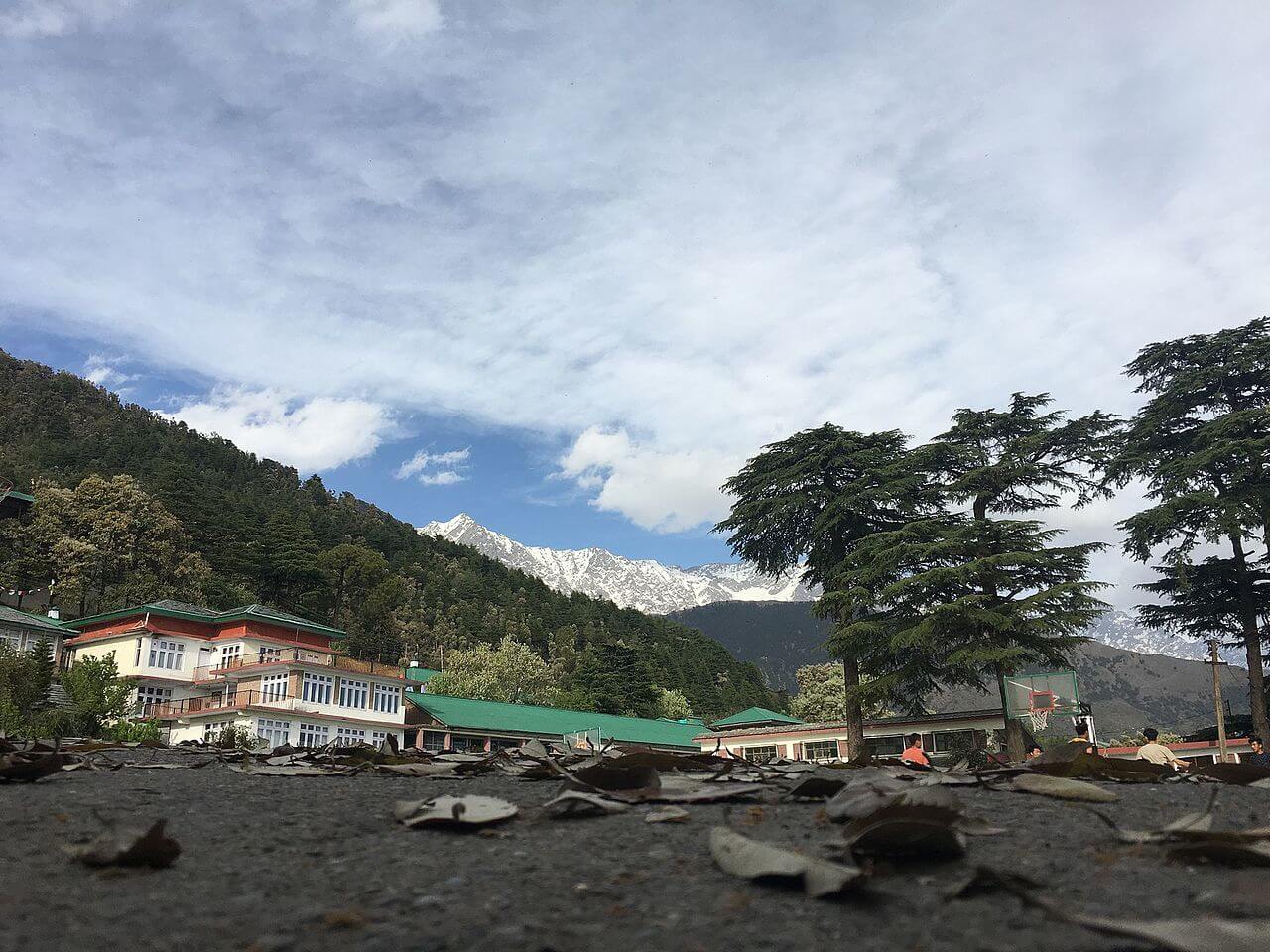
Upon leaving Samdo, you’ll walk past Larke Bazar, a seasonal Tibetan market, then descend towards the Budhi Gandaki river and cross the small wooden bridge. You’ll pass a couple of streams while relishing the Larkya Glacier.
After trekking around the valley of Salka Khola, you’ll climb steep uphill towards Dharmasala.
Day 11: Trek from Dharmasala (4,460m) to Bhimtang (3,590m) via Larkya La Pass (5,135m) – 8 to 9 hours
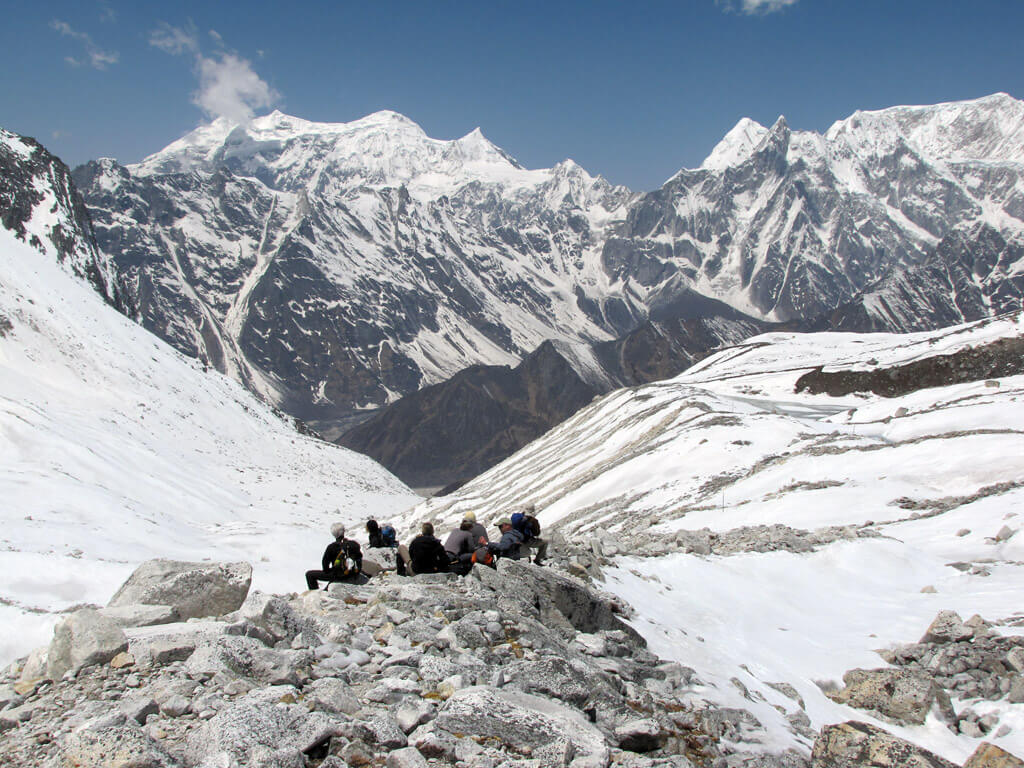
Today marks as the most prolonged and most strenuous day of the entire Manaslu Circuit. Therefore, make sure to begin your adventure early in the morning. Your journey starts with a gentle uphill to a small valley north of Larkya Glacier. The valley provides breathtaking views of Larkya Peak and Cho Danda.
Furthermore, make a gradual ascent across the moraine of the glacier until you reach the upper section of the pass. In the upper reaches of Larkya La Pass, the climb becomes steeper. However, the pass is rewarding with beautiful spectacles of the mountains, including Annapurna II, Himlung Himal, and Cheo Himal.
The trail then descends to the low pastures until you arrive at Bhimtang.
Day 12: Trek from Bhimtang (3,590m) to Tilije (2,300m) – 5 to 6 hours
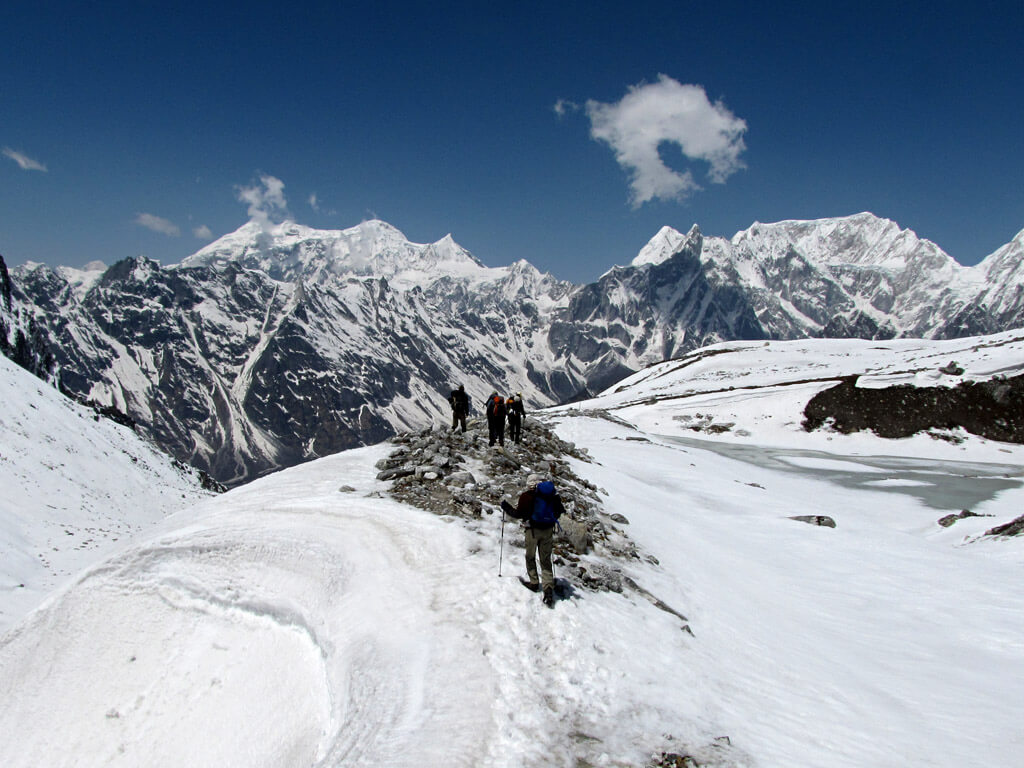
After a long day at Larkya La Pass, you commence the day by descending the Budhi Gandaki river. After crossing the wooden bridge over the river, you’ll walk along the dense rhododendron forest and head toward the narrow valley towards Karche, the highest cultivated land of Budhi Gandaki Valley.
Following a few hours of walking on the river banks, you’ll arrive at the village of Gho. Then, continue walking until you reach your destination, Tilije.
Day 13: Trek from Tilije (2,300m) to Dharapani (1,860m) and Drive to Besisahar (760m) – 7 to 8 hours
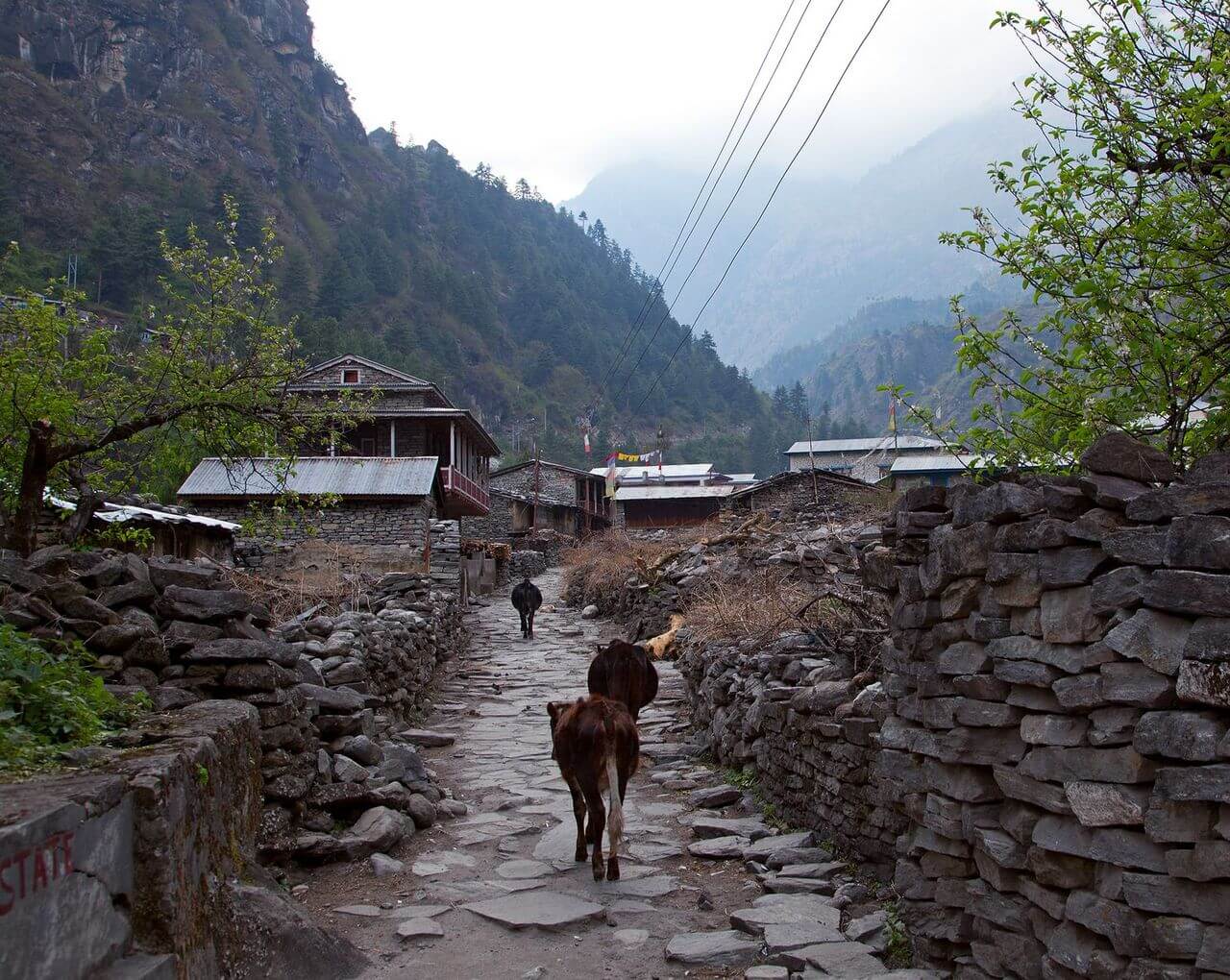
Walking through the beautiful villages, you cross the bridge over the Dudh Koshi river and head past several Mani walls and an arch to arrive at Thonje village. The trail further leads to the occasional police check-posts before entering the route to Annapurna Circuit at Dharapani.
From here, you can hire a jeep or even take a local bus to Besisahar from Dharapani. It makes you about 4-5 hours to reach Besisahar from Dharapani.
Day 14: Drive from Besisahar (760m) to Kathmandu (1,400m) – 5 to 6 hours
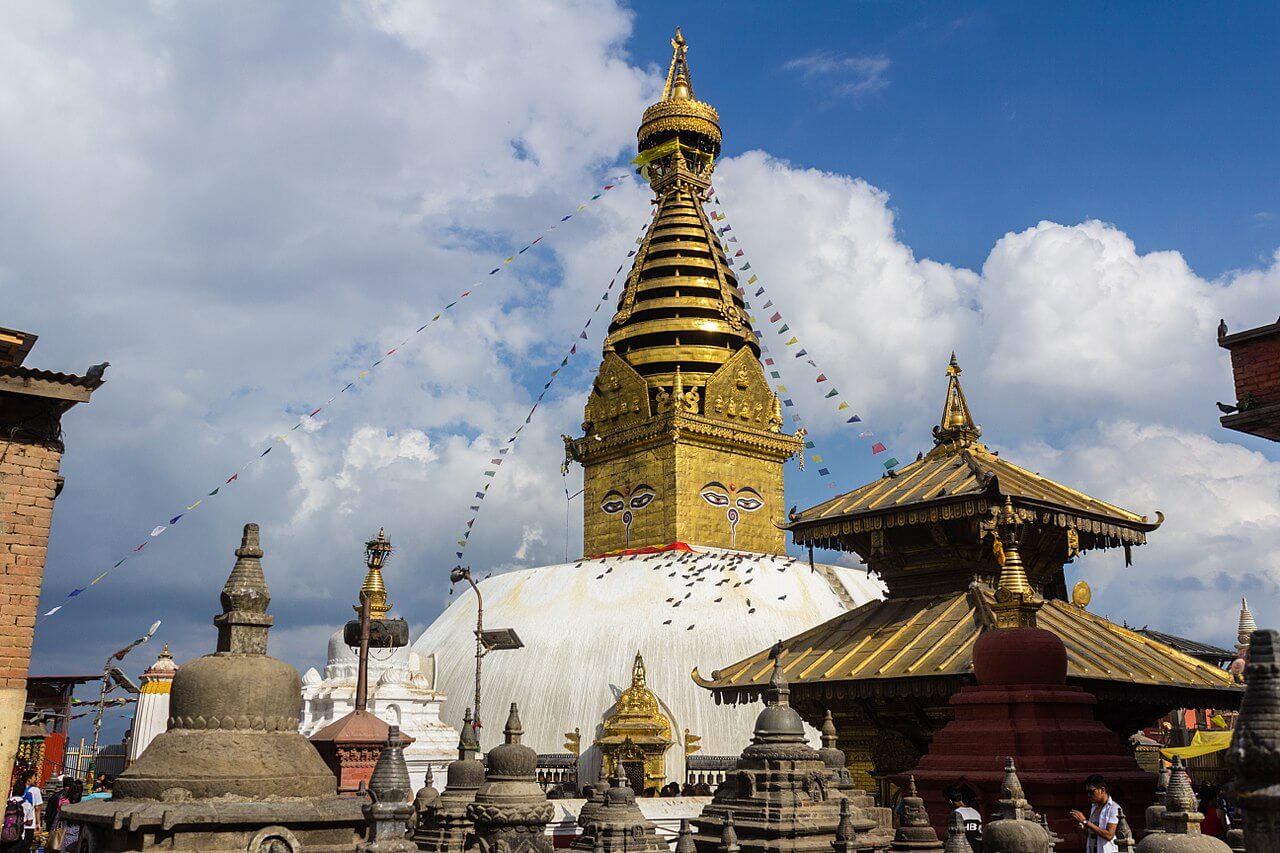
Begin in the morning with a scenic drive across several small villages. You drive along the Prithivi Highway, enjoying the beautiful scenery of hills, flowing rivers, terrace fields, small towns, and occasional mountains.
After driving for about 5-6 hours, you’ll reach Kathmandu.
Tsum Valley Extension
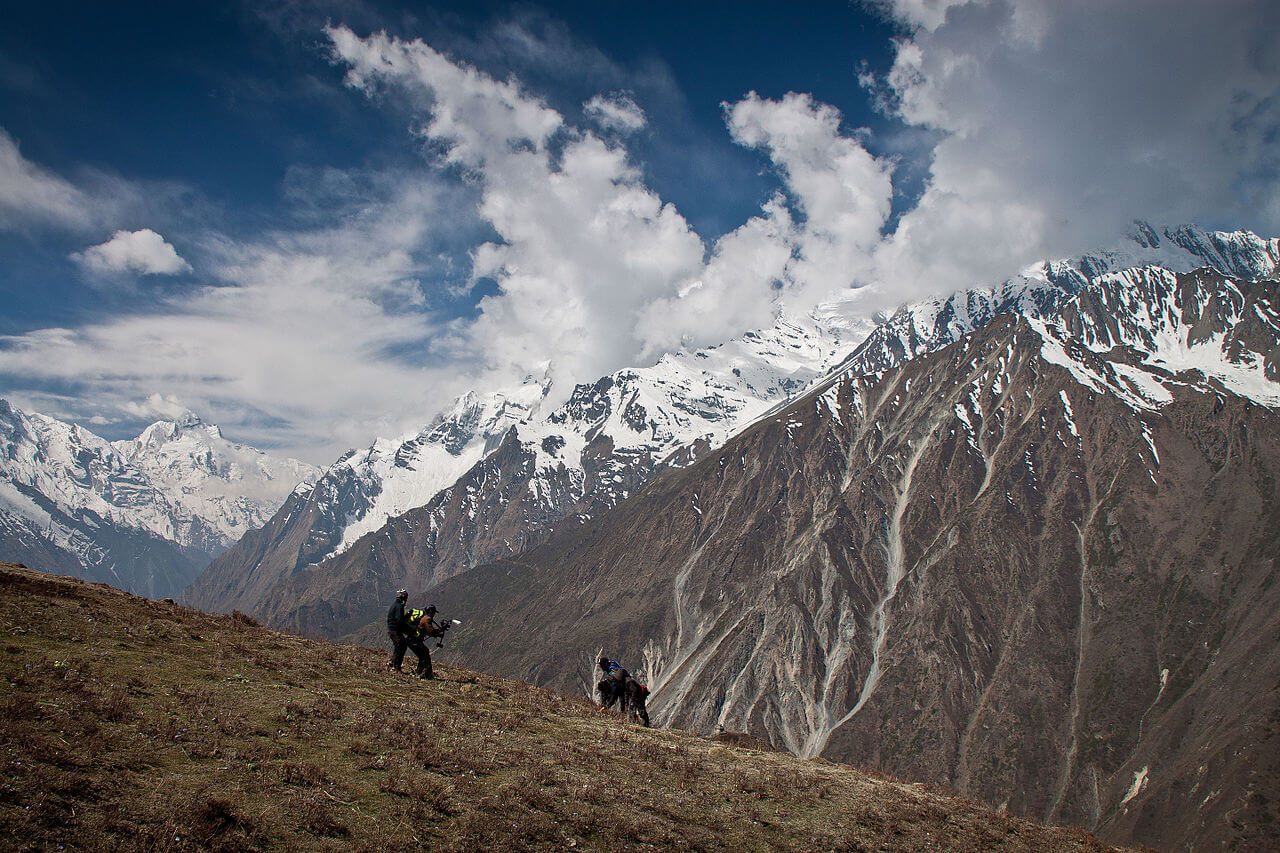
If you have a few extra days, you can extend your Manaslu trek for another week by adding Tsum Valley Trek to your itinerary. The trail to Tsum Valley is even more isolated and remote compared to that of Manaslu Circuit.
Tsum Valley Trek offers an authentic experience with ancient art culture, Himalayan valleys, and spectacular mountain scenery. This trek rewards the incredible mountain spectacles with Ganesh Himal, Shringi Himal, and Boudha Himal surrounding the trail.
Tsum Valley Trek is an opportunity for local experiences as the trek is well-known for its warm hospitality and traditional homestays. You’ll also get an insight into Tibetan Buddhism as you will be exploring the ancient Buddhist monasteries, including Milarepa’s Cave, Mu Gompa, and Rachen Gompa.
Side Trips of Manaslu Trek
If you have a day or two, Manaslu Trek offers plenty of marvelous side trips you can take along with the standard route. Manaslu Circuit has a few more remote and off-the-beaten destinations where only a few dedicated travelers make their ways. Therefore, if there is enough time, we highly recommend you consider some of these options along the trail.
1. Manaslu Base Camp (4,848m)
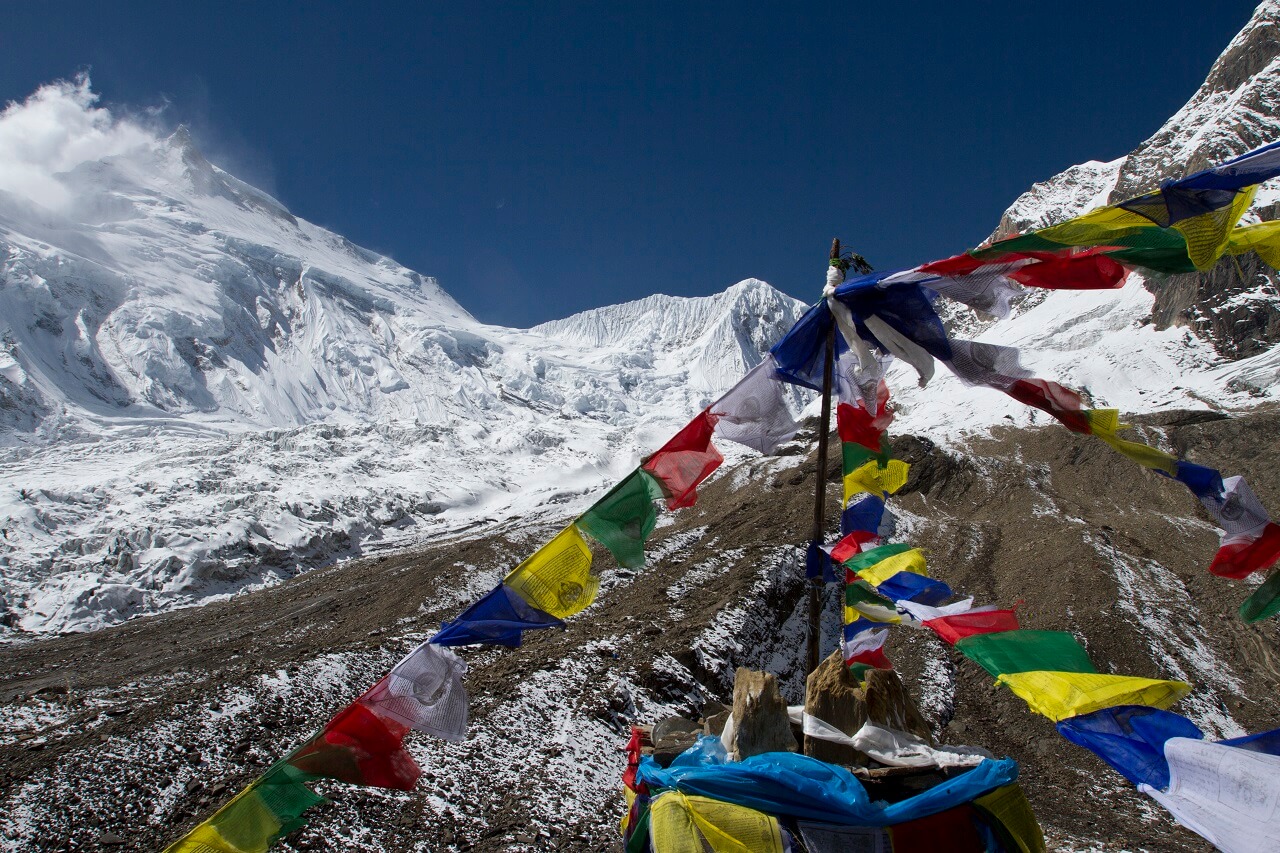
Manaslu Base Camp is an excellent side trip of Manaslu Circuit Trek. The entire trip to the base camp of the world’s 8th highest mountain takes about 6 hours for average trekkers.
The trail to the Manaslu Base Camp diverts from the Manaslu Circuit route in Samagaon. There are two different alternatives to go to the base camp. The first one is to take the course to Birendra Lake, then head to the base camp. Another one is to walk out of Samagaon, take the left lane, and head directly to the base camp. A small Chorten surrounded with colorful prayer flags marks the Manaslu Base Camp.
2. Birendra Lake (3,620m)
Birendra Lake is by far the most popular side trip in Manaslu Circuit Trek. Formed from the melting ice of Manaslu, you can reach this glacial lake in about half an hour from Samagaon.
Most of the trekkers visit this pristine lake on the acclimatization day in Samagaon. To visit this lake, you’ll have to follow the trail opposite to Mount Manaslu Hotel. The roads to the lake can be slightly tricky, so keep your eyes on the path.
3. Kalmachum Lake (3,800m)
Kalmachum Lake, also known as Kal Tal, is a high altitude lake situated at an elevation of 3,800m. You’ll have to hike for an entire day from the village of Prok to reach this lake.
Dense forests with Langurs, fir, and pine surround the trail to Kalmachum Lake. The first few hours of the hike is steep uphill, which later turns to a gradual walk until you arrive at the lake. You can see the splendid view of Prok and Kok village from the top.
4. Hinang Gompa (3,100m)
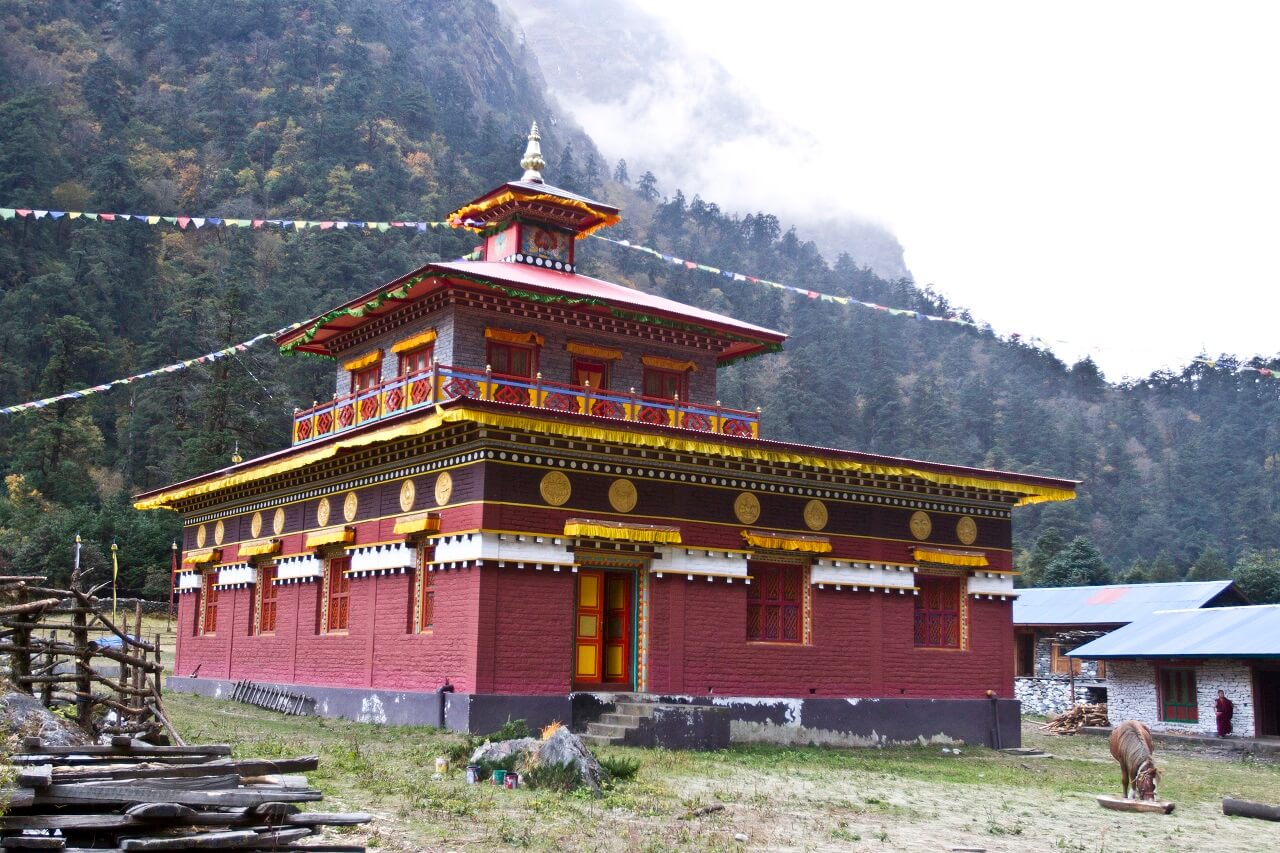
Hinang Gompa is a beautiful monastery that sits on the top of a hill decorated with Mt. Himalchuli in the backdrop. The road to this monastery diverts from 20 minutes away from Lihi village.
This monastery is a decade old and currently also serves as a Lama school. If you hike further up from the monastery, you’ll also get to visit Hinang glacier.
5. Serang Gompa (3,100m)
Located in the foothills of Shringi Himal, Serang Gompa is one of the most secluded and spiritual monasteries in Manaslu Circuit. Since the valley surrounding gompa is said to be the place where Guru Padmasambhava once meditated, it is one of the must-visit side trips in the trek.
Shringi Himal on the backdrop also carries a religious significance. Dense woodland, beautiful Chorten, Mani walls, and suspension bridge encompass the route to the monastery.
Best Time to Trek Manaslu Circuit
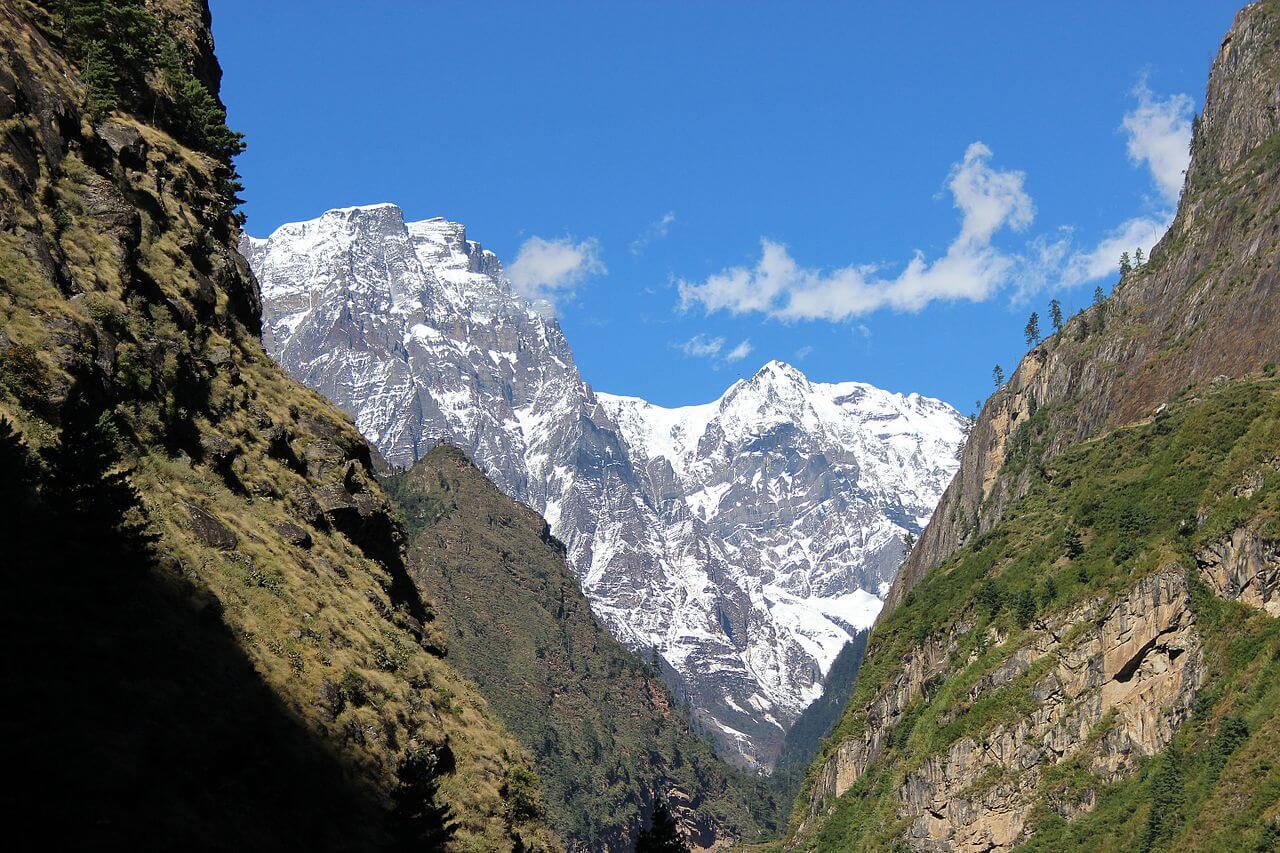
The best time to trek in Manaslu Circuit is during Spring (March to May) and Autumn (September to November). Since the weather conditions during these seasons tend to be moderate, and the skies are usually clear, people consider it to be the most favorable time to go trekking in Nepal.
Traveling during Spring and Autumn means the temperature is relatively moderate for walking and tends to remain more stable. You also enjoy the marvelous views of the mountains and landscapes as the skies remain clear even during the days.
Unlike most of the treks in Nepal, Manaslu is not a year-long trekking destination. Since you’ll be walking through the landslide-prone areas, it is not advisable to trek to Manaslu during the Monsoon (June to August).
Winter (December to February) are usually cold and snowy. You’ll have to walk through the moraines of the glaciers and cross over Larkya La Pass on this trek. Therefore, trekking in winter will be quite tricky. So, it is not advisable to trek to Manaslu during this time of the year.
Here’s a table with average temperature and rainfall details throughout the year for locations en-route to Manaslu Circuit:
Manaslu Circuit Trek Difficulty
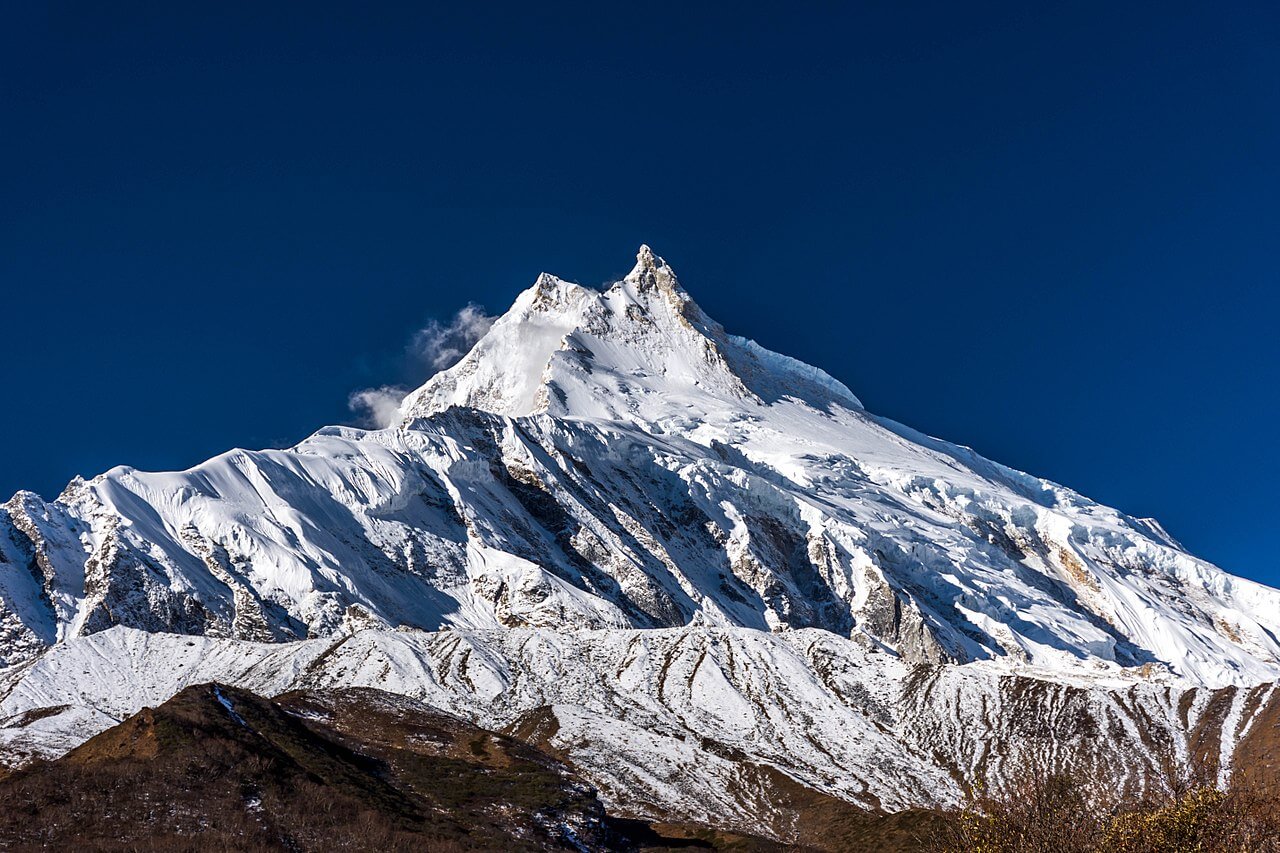
Manaslu Circuit Trek is a wild and remote adventure destination in the high Himalayas of Nepal. This trek is considered to be relatively strenuous and challenging as the trekkers will have to hike through rustic villages, diverse terrains, moraines, and Himalayan passes.
The trek covers approximately 177 km of the total distance. On the standard 18-days itinerary, you’ll have to walk around 10-12 days averaging 15-20 km per day.
This trek also covers massive altitudinal variations, starting from 815m at Soti Khola to 5,135m at Larkya La Pass. The biggest challenge of the entire trek is to cross the Larkya La Pass. Therefore, it is advisable to be cautious regarding the altitude and make sure to know the symptoms of Acute Mountain Sickness (AMS).
The weather in the Himalayas is unpredictable and harsh, especially in the upper reaches of the trek. Although the days are moderately warmer, the temperature drops extensively during the nights. Therefore, it is highly recommended to prepare yourself for the harsh weather. A waterproof hiking boot, decent down jacket, and a proper sleeping bag are highly advisable while trekking in Manaslu.
Physical fitness and mental preparation should be highly considered to take on the challenge of Manaslu. Before committing yourself to the adventure, make sure to train well, and engage yourself in the cardio-related activities as much as possible.
Manaslu Trek Permits
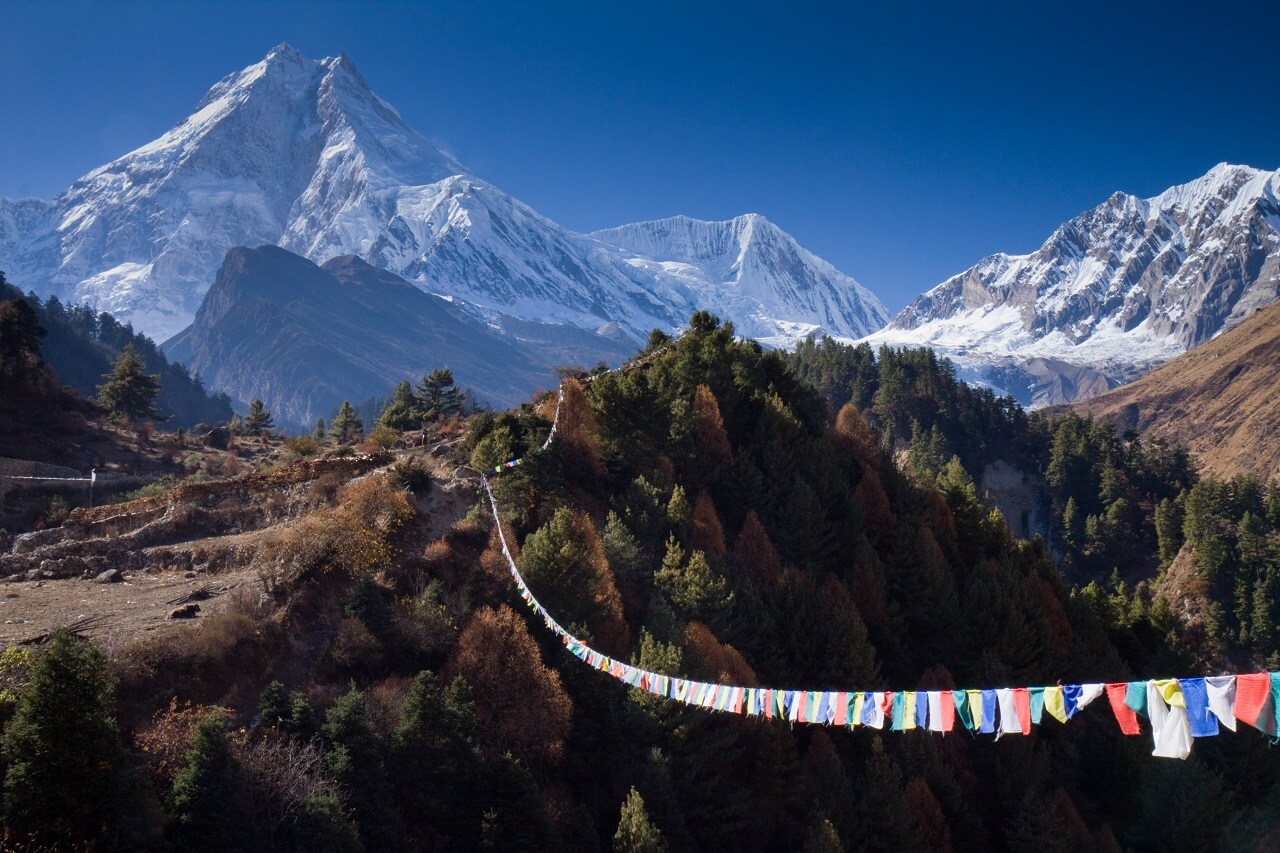
To maintain sustainability, the government of Nepal has declared the Manaslu region as a restricted area applicable from Jagat to Dharapani. So, you need to acquire a special restricted area permit (Manaslu RAP) while trekking to Manaslu. In the Autumn season (September to November), the cost of the special permit for Manaslu is $70 per person for the first week with an additional fee of $10 each day after that. For the rest of the year, the cost drops to $50 for the first week with an additional fee of $7 per day. You do not require a printed photograph for the special permit as the photograph will be uploaded online and printed out with the permit.
You will also need to acquire MCAP (Manaslu Conservation Area Project) Permit as well as ACAP (Annapurna Conservation Area Project) Permit for this trek. Both ACAP and MCAP cost about $27 per person for international trekkers. For SAARC nationals, the cost of both the permits is only $2. The price of these permits remains the same throughout the year. Both these permits require printed photographs.
You can issue the restricted area permit (Manaslu RAP) from the Department of Immigration. You can fill up the permit form online at http://online.nepalimmigration.gov.np/trekking-permit .
You can issue the MCAP and ACAP at following Entry Permit Counters:
- Nepal Tourism Board, Kathmandu – ACAP & MCAP
- Nepal Tourism Board, Damside, Pokhara – ACAP
- ACAP Entry Permit Center, Besisahar, Lamjung – ACAP
Usually, you can not issue the entry permits from any other counters in the trail. However, in exceptional circumstances, other permit counters also grant the licenses with a 100% additional charge.
Additionally, if you choose to extend your Manaslu Circuit Trek with Tsum Valley, you’ll have to issue a separate restricted area permit. It will cost you $40 per person for the first seven days with an extra $7 each after the week during the Autumn. During the rest of the year, the cost drops to $30 per person for the first week with an additional $7 each.
Also, trekking independently is not allowed in the Manaslu region. The government rules state a minimum of 2 trekkers along with a guide/porter is mandatory to do the Manaslu Circuit Trek.
Insurance for the Trek
We recommend you to get travel insurance while trekking in Manaslu Circuit Trek. Unlike most of the trekking routes in Nepal, trekking in Manaslu is quite a challenge and requires serious commitment.
Since this trek is remote and isolated, there are no proper health posts on the trail. If any trekkers get into severe medical conditions, the only way out of this trek is helicopter evacuation.
Make sure to buy individual travel insurance that comprises all the necessary medical costs, helicopter evacuation, trip cancellation charges, theft, and natural disasters. If you’re looking for decent travel insurance, we recommend you to buy it from World Nomads.
Guided vs. Independent Trek
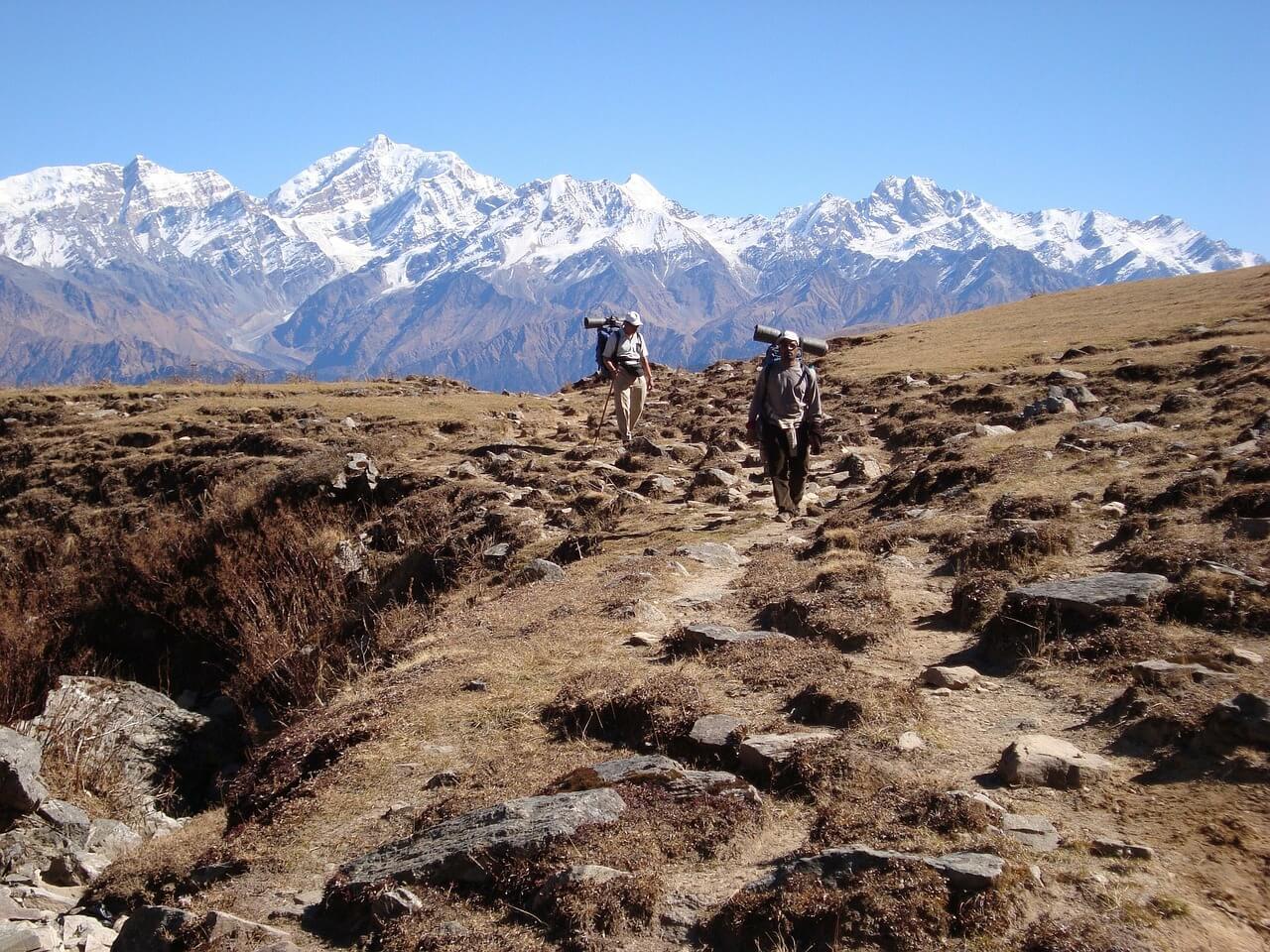
Manaslu Circuit Trek falls under the restricted area, which requires a mandatory trekking staff, either a registered guide or porter cum guide, to trek in this region. The Government of Nepal has declared that any foreign trekkers trekking to the Manaslu region must have a special permit to travel the area.
As per the policies, a minimum of two trekkers with a registered trekking guide is mandatory for this trek. Therefore, trekking independently in Manaslu Circuit is not possible for foreign tourists.
The trail to Manaslu is remote and challenging with very few dedicated trekkers making their way in this region. Additionally, there are a few places, marked landslide-prone zone. Therefore, it is essential to have a guide while trekking in Manaslu Circuit.
However, if you’re willing to go without a guide, the only alternative is to hire a porter cum guide. While hiring a porter-guide may cost you a little cheaper than registered guides, most of them do not speak fluent English.
Accommodation and Food
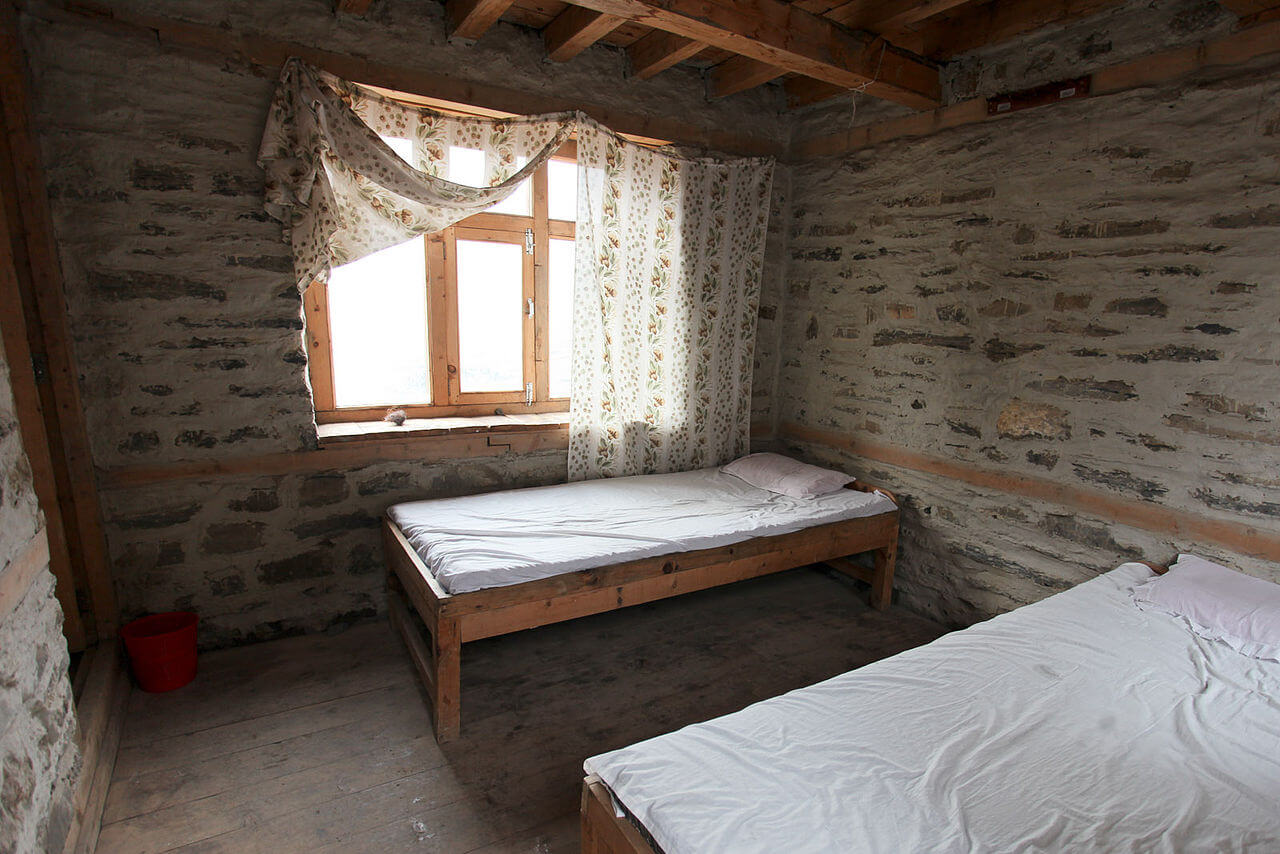
Teahouses and local lodges facilitate the entire trail of Manaslu Circuit, except in Dharmasala. In Dharmasala, you may occasionally have to sleep under a tent. The local communities of the region operate the teahouses and lodges in the Manaslu region.
The rooms are quite basic, with two standard single beds. The toilets are mostly shared and are outside the teahouse at some places. The heating facility is only available in the dining hall.
Unlike Everest and Annapurna treks, there are no luxury hotels in Manaslu. Most of the lodges do provide a hot shower facility; however, you may have to pay extra money for the service.
The teahouses of Manaslu also provide a menu with a variety of western food. The food somewhat costs cheap in the lower reaches of the trek and increases along with the elevation rise. Also, the food choices on the menu will get limited in the higher section of the trek.
Although the menu offers a variety of western foods, Dal Bhat is the most popular food during the trek.
Manaslu Circuit Trek Cost
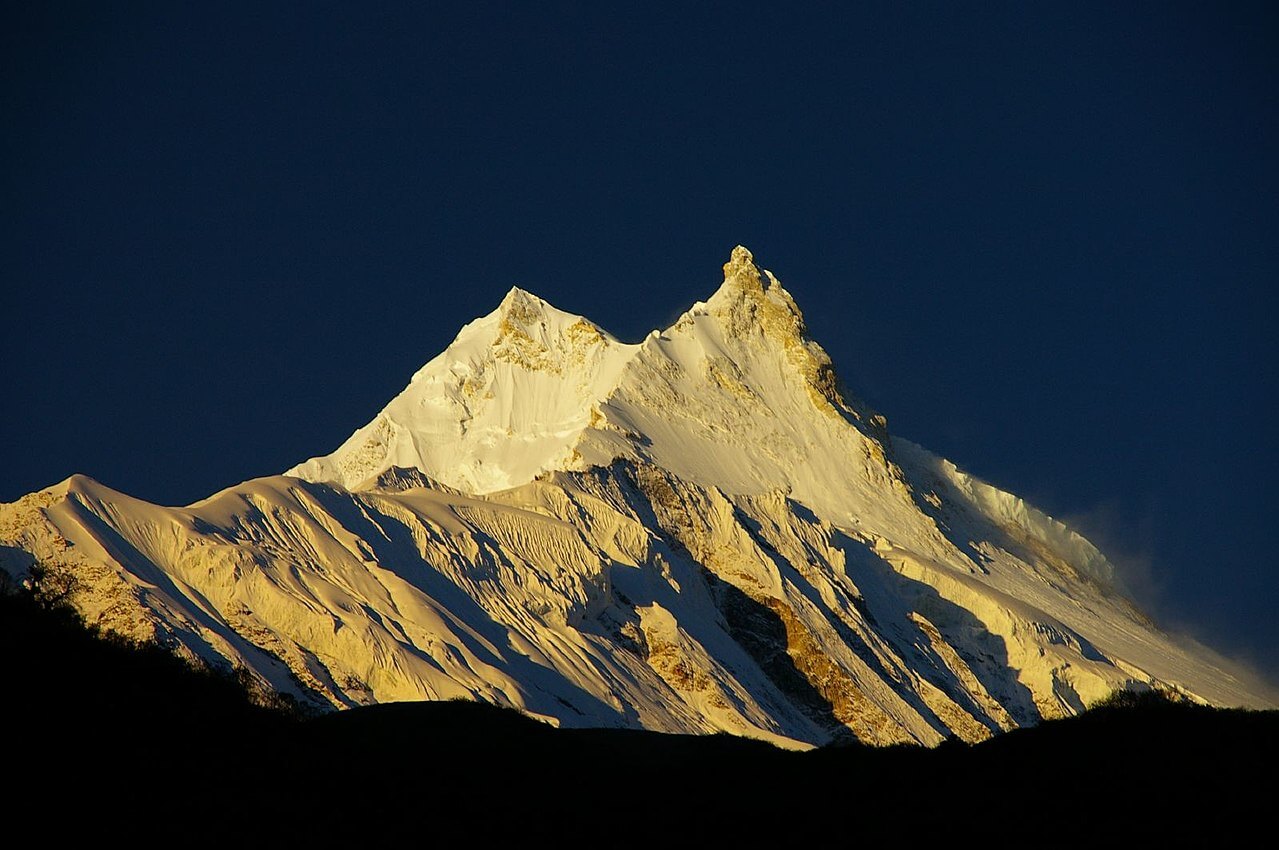
The cost of Manaslu Circuit Trek depends upon various factors such as duration, mode of transportation, lodging, and food. Although this trek is slightly expensive compared to Langtang Valley or Annapurna Base Camp, the remote and untouched beauty of Manaslu is worth every penny.
Since Manaslu trek lies in the restricted zone, you need a restricted area permit to enter the region. The special permission for Manaslu is $70 per person for one week. After the first week, it’ll cost an additional fee of $10 each day during the Autumn. However, the cost drops to $50 with an additional fee of $7 each day for the rest of the year. You’ll also need ACAP and MCAP for Manaslu trek, which will cost you approximately $27 each.
Additionally, if you choose to extend your Manaslu Circuit Trek with Tsum Valley, you’ll have to get a separate restricted area permit. The charge of Tsum Valley permits costs $40 per person for the first seven days with an extra $7 each after the week during the Autumn. For the rest of the year, the cost drops to $30 per person for the week with an additional $7 each day.
The teahouses are relatively cheap in Manaslu, costing you as little as $6 to $9 per night with an additional $5 per meal. The local buses to Soti Khola from Kathmandu costs you about $10 per person. However, traveling by jeep is more expensive, costing you roughly $150 to $200 per person.
Since Manaslu Circuit Trek lies in the restricted area, it is mandatory to have a licensed guide or a porter on the trek. A licensed guide will cost you about $20 to $25 per day while porters cost you about $15 to $20 per day. You can hire a porter-guide which will cost you $18 to $22 per day.
Packing List for Manaslu Trek
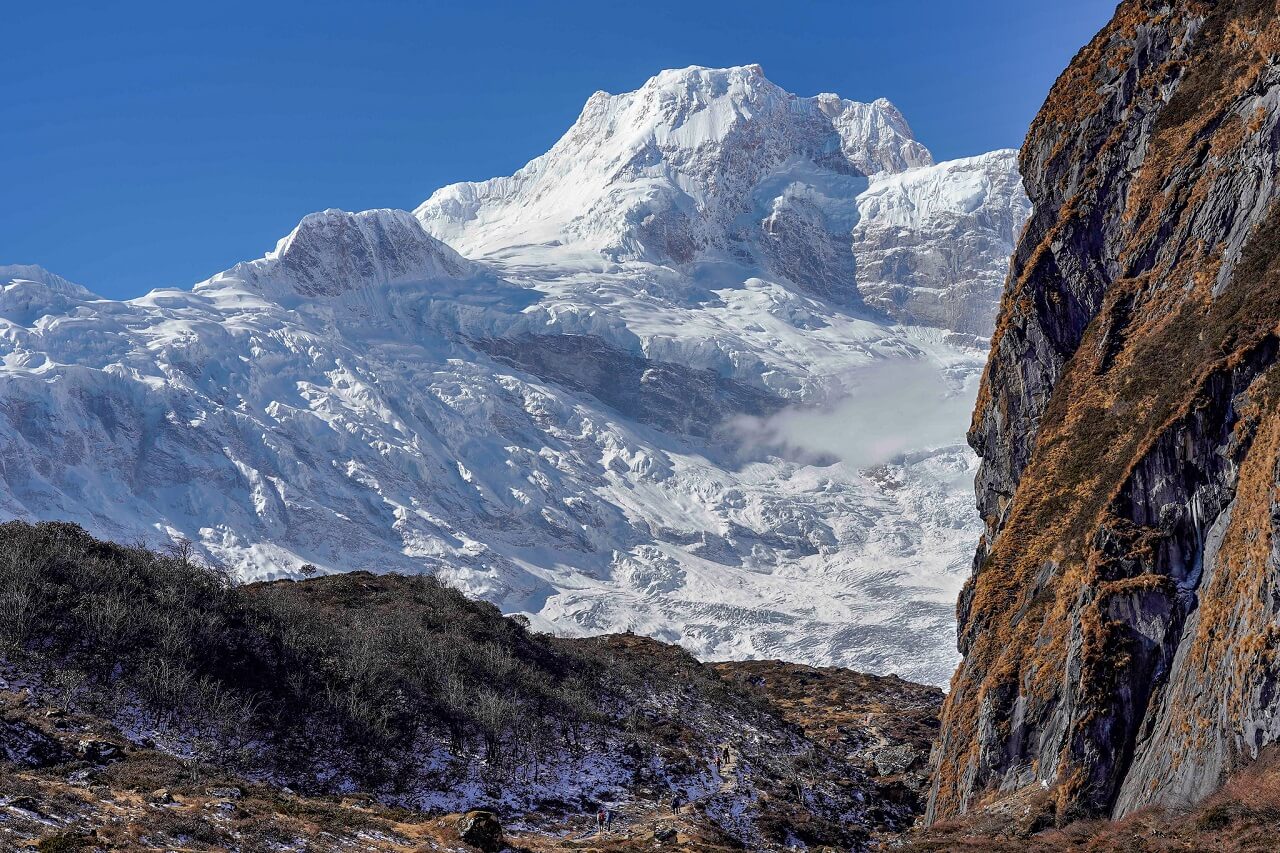
If you’re planning to experience the thrill of trekking to the remote and inaccessible areas of Manaslu, make sure you’re carrying the right equipment. While it is quite a dilemma when it comes to what to pack for the trek, it matters how and when you’re planning to travel.
Since Manaslu does not permit the individual travelers, you’ll have to hire a porter. The porter will carry the substantial portion of the weight, leaving you with the daypack. Hiring a porter does not mean you should be packing everything you can think of for the trek. Although you’ll have someone to help you with the luggage, make sure to pack your bags with right gears.
Here are some of the essential gears you need to pack while trekking to Manaslu Circuit:
- Duffel Bags
- Trekking Shirt: 5-7 shirts, make sure to balance both long and short.
- Trekking Trousers: We recommend you to pack at least 2 trekking trousers along with a couple of shorts.
- Base Layer: Make sure to pack a couple of wool base layers to keep yourself warm in the upper reaches of the trek.
- Insulation Layer: A decent quality of fleece jacket will do!
- Outer Layer: Warm down jacket that will mainly be used in the higher altitudes when the weather gets extreme.
- Waterproof Shell Jacket: Pack a pair of waterproof jackets as you may encounter rain in the trail.
- Breathable Underwear: We recommend you to carry 5-6 pairs of moisture-wicking underwear.
- Hiking Boots: Invest in high-quality waterproof hiking boots. Make sure the boot is lightweight and comfortable.
- Trainers/Sandals: It is handy to carry a pair of either trainers or sandals to wear them in the teahouses.
- Hiking Socks: You should carry 4-6 pairs of hiking socks. Any brand or label works as long as they are breathable and moisture-wicking. Do not bring cotton socks as they soak easily and may lead to blisters.
- Thermal Socks: We recommend you to pack at least a pair of thermal socks to keep your feet protected from the cold in the higher altitudes.
Head Wears:
- Sun Protection Hat: It is mandatory to carry a protection hat to keep your face protected from the harsh sun.
- Beanie: An absolute must to keep yourself warm, especially during the evening and night.
- Buff/Neck Gaiter: This small piece of gear comes in handy to protect your neck from the cold winds and also helps you stay protected from the dust.
- Inner Gloves: Pack light inner gloves as they can be useful when the temperature is moderate.
- Outer Gloves: You’ll be wearing them in the upper reaches of the trek. Outer gloves need to be insulated, warm, and waterproof.
Sleeping Bags:
Sleeping bags are hands down one of the most crucial gears when it comes to trekking in Manaslu region. With basic rooms and sleeping facilities, you can never rely on the teahouses for warm, decent blankets.
In the lower altitudes, this may not seem much of a problem, but once you get above 3,000m, the temperature even inside the teahouses can get cold.
Therefore, investing in a high-quality, 4-season sleeping bag is an absolute must! If you’re not willing to any chances, buy a sleeping bag that has the minimum rating of -10 degrees Celsius.
Important Accessories:
- Trekking Poles
- Water Bottle
- Basic Medical Kits
- UV Protection Sunglasses
- Water Purification Tablets
- Hand Sanitizers
- Sunscreen/Lip Balm
- Trekking Towels
- Portable Chargers
Network Information
If you’re willing to stay connected with your family and friends, we suggest you use CDMA networks over any other service providers in the region. Although NTC and Ncell are the two major telecommunication service providers in the country, they barely come to work while trekking to Manaslu.
One thing you should know beforehand with CDMA networks is that they do not work with every other mobile phone. Therefore, you should buy a phone in Kathmandu to make the most out of their service. The CDMA phones are available in nearly all the mobile shops in the city, and they come quite cheap.
Useful Tips
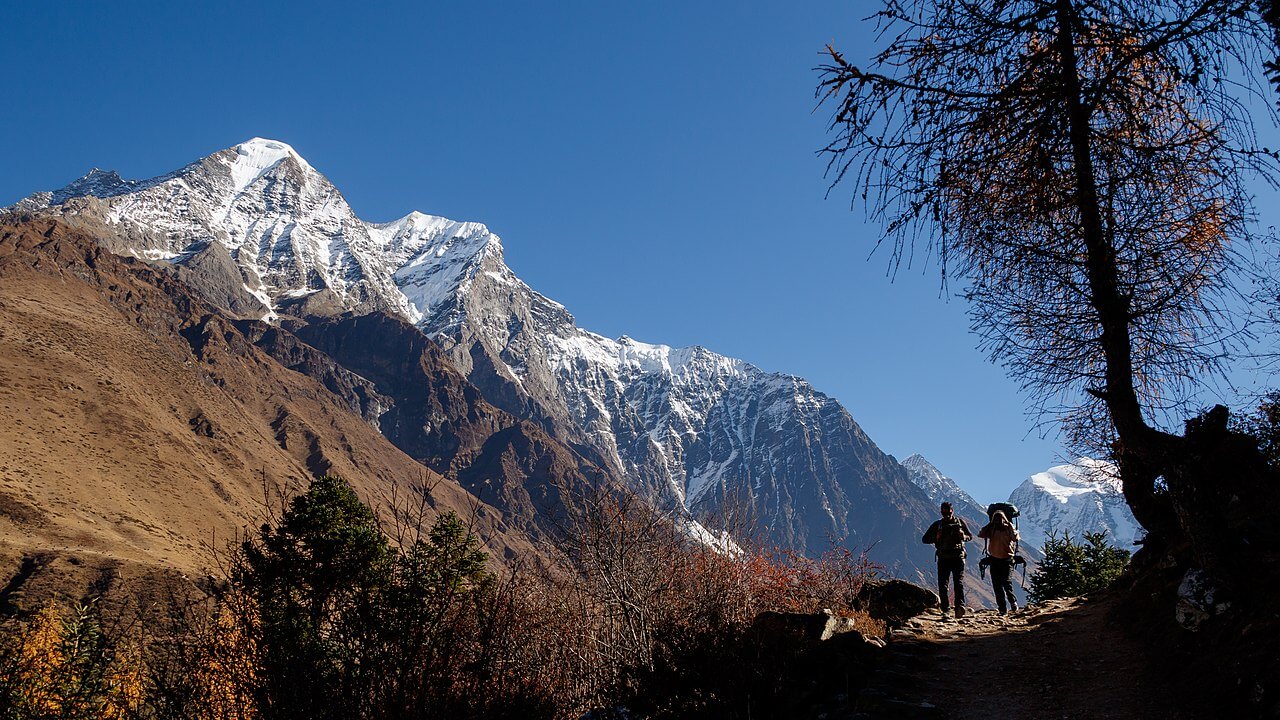
- Manaslu Circuit is one of the most remote and strenuous treks in Nepal. Please make sure to prepare yourself both physically as well as mentally before heading off to the wild.
- Altitude is a constant threat. As the highest elevation point of the trek is whooping 5,135m, it is essential to acclimatize well, take the necessary precautions, and stay hydrated throughout the trail.
- The trails in the Manaslu region are not appropriately marked. Be aware of the route. Always walk with a guide/porter and do not wander off alone in the trail.
- There are several landslide-prone areas in the region. Be careful and watch out for the rocks!
- The trail can be slightly risky when wet and snowy. Therefore, invest in high-quality hiking boots and make sure to pack well for the trek.
- Drinking water may not be safe to drink. A water purifier will be great to have.
- Not all tea houses provide charging facilities. Carrying a portable charger would be handy.
Accommodation in Kathmandu
Thamel is the major tourist hub of Kathmandu. Surrounded by hotels, travel agencies, shops, and restaurants, here you can find accommodations for any budget from cheap hotels to luxury hotels.
However, there are plenty of places outside Thamel where you can find decent hotels in Kathmandu. Some of the accommodation options in Kathmandu are:
Recommended Travel Agencies for Manaslu Circuit Trek
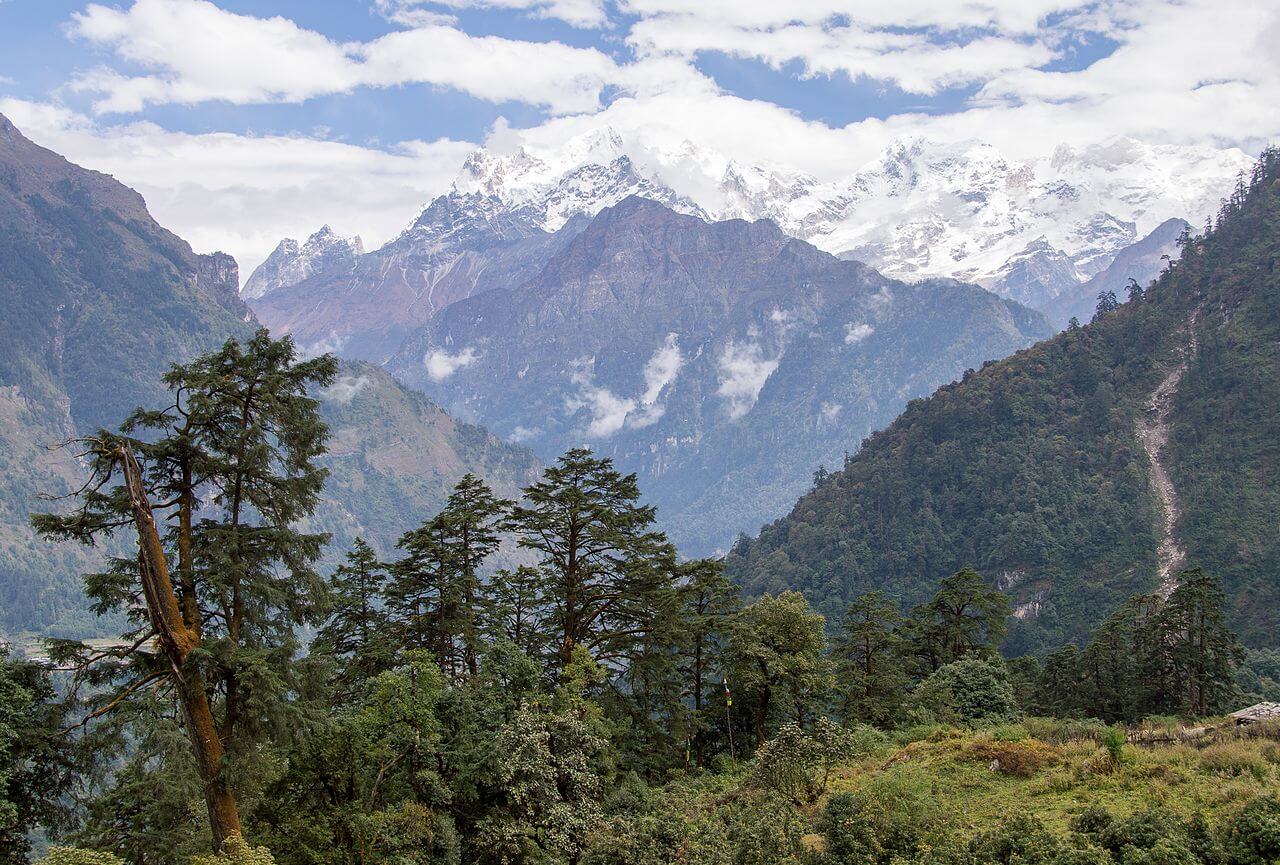
There are thousands of trekking companies that operate the Manaslu Circuit Trek in Nepal. Make sure you’re traveling with an authorized trekking company while trekking in Nepal.
While trekking in the remote and challenging trail of Manaslu Circuit, it is essential to book the trip with an experienced company that ensures breathtaking experience while concerning the clients’ safety.
Some of the best trekking companies in Nepal for Manaslu Circuit Trek are:
- Himalayas on Foot
- Magical Nepal
- Mosaic Adventure
- Nepal Eco Adventure
Recommended Books and Guidebooks
- Manaslu: A Trekker’s Guide
- Lonely Planet Nepal (Travel Guide)
- The Rough Guide to Nepal
- Birds of Nepal
- The Climb: Tragic Ambitions on Everest
- Into Thin Air: A Personal Account of the Mount Everest Disaster
- High Adventure
- The Snow Leopard
1. Is Manaslu Circuit Trek doable?
Although Manaslu Circuit Trek is strenuous and challenging trekking routes in Nepal, this trek is entirely doable. However, you have to maintain a certain level of physical fitness to do this trek. Be aware! Since this is a high altitude trek, you’re also at risk of suffering from Acute Mountain Sickness (AMS).
2. Can I do the Manaslu Circuit Trek solo/independently?
No, the government of Nepal does not permit solo or independent trek in the Manaslu region. As per the government’s rules, it is mandatory to have a minimum of two trekkers accompanied by either a guide or a porter to trek in the Manaslu region.
3. What is the standard of accommodation in Manaslu?
The teahouses and lodges in Manaslu Circuit are basic with two single beds and no heating facilities. The toilets are standard and on sharing basis throughout the trail. Most of the tea houses provide a hot shower but will charge you extra bucks for it.
On the upper reaches of the trek, the accommodations might get draughty and dark. Therefore, we recommend you bring a sleeping bag and a headlamp for this trek. Teahouses are available throughout the trek with the only exception in Dharmasala. At Dharmasala, you may have to spend the night in a tent.
4. Is it safe to drink water in the trek?
No, the water in teahouses is mostly from tap or streams, which is not safe to drink directly. Bottled water is also available throughout the trail. However, the bottled water is slightly expensive and adds more trash on the trail. Therefore, we highly recommend you to carry a water purifier or tablets.
5. Do I need travel insurance before trekking to Manaslu?
Yes, travel insurance is highly advisable while trekking in Manaslu. Since Manaslu is a remote and isolated trek, we suggest you have specific travel insurance for this trek. Make sure your travel insurance covers the cost of necessary medical facilities, theft, natural disasters as well as helicopter evacuations.
Manaslu Circuit Trek is an excellent alternative to the commercial trekking routes like Annapurna and Everest Base Camp. Tucked in the remote region in the Himalayas of Nepal, Manaslu is a sanctuary for adventure enthusiasts and avid trekkers.
As this is one of the most demanding treks of Nepal, this trek demands a serious commitment and physical fitness.
Similar Posts
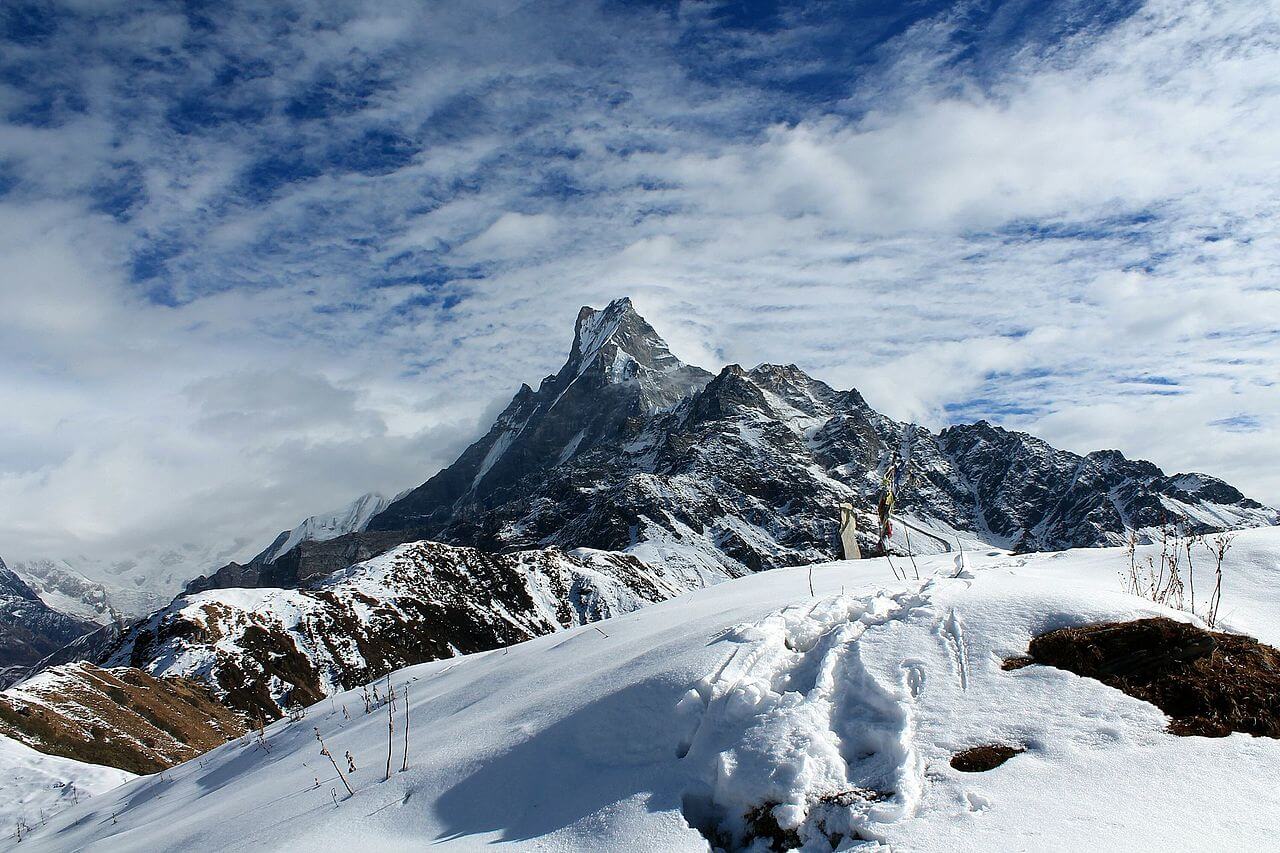
Mardi Himal Trek
Mardi Himal Trek is a hidden gem for the dedicated trekkers and backpackers. Located eastwards of the classic Annapurna Base Camp, this trekking route is yet to witness a large crowd like other commercial treks in Nepal though it officially opened for all in 2012. The richly diverse terrains of Mardi Himal takes you across…
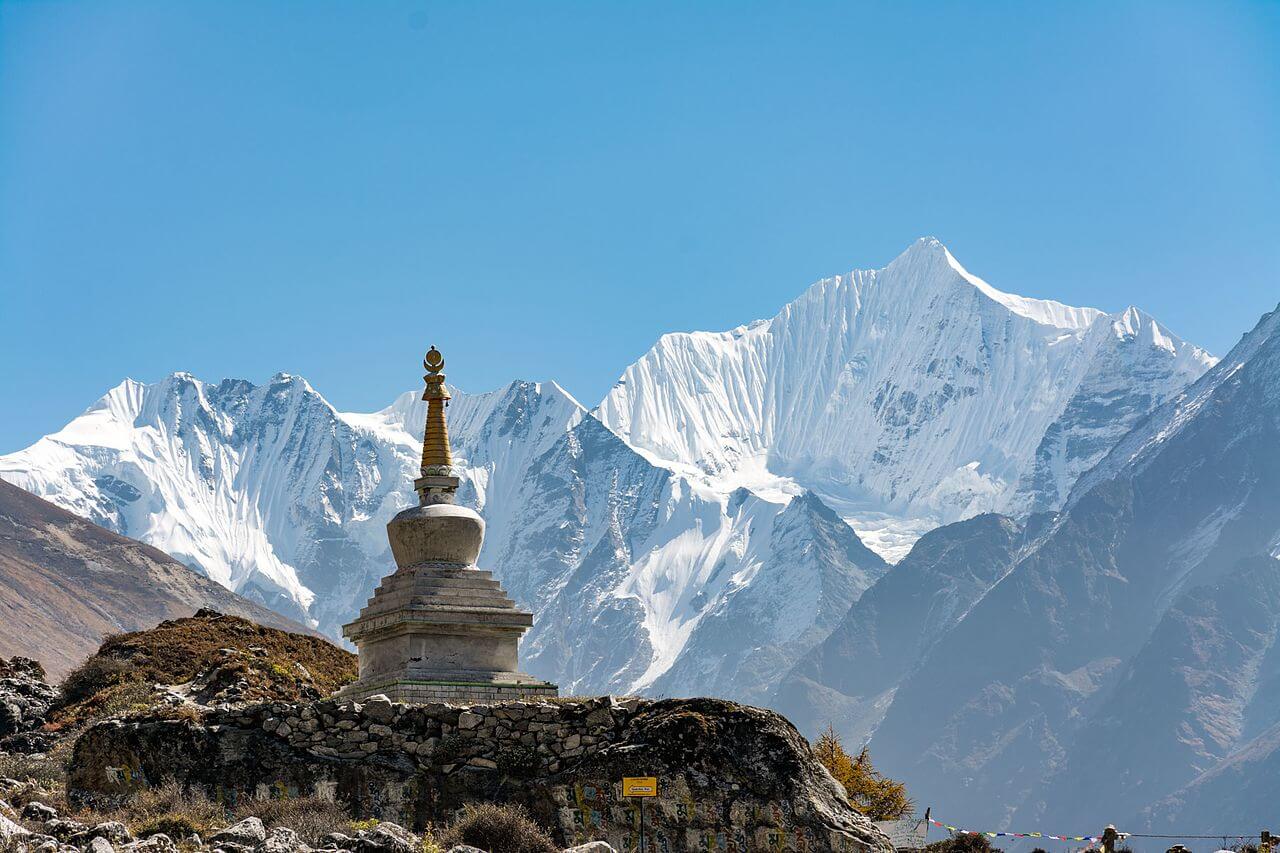
Langtang Valley Trek
Langtang Valley is a classic trekking destination, located only 61.8km away from aerial distance, north of Kathmandu. Although the Langtang Valley Trek is relatively short, accessible, and cheap, the trails are quieter with less number of trekkers compared to other classic trekking destinations in Nepal. The trek is ideal for both experienced trekkers as well…
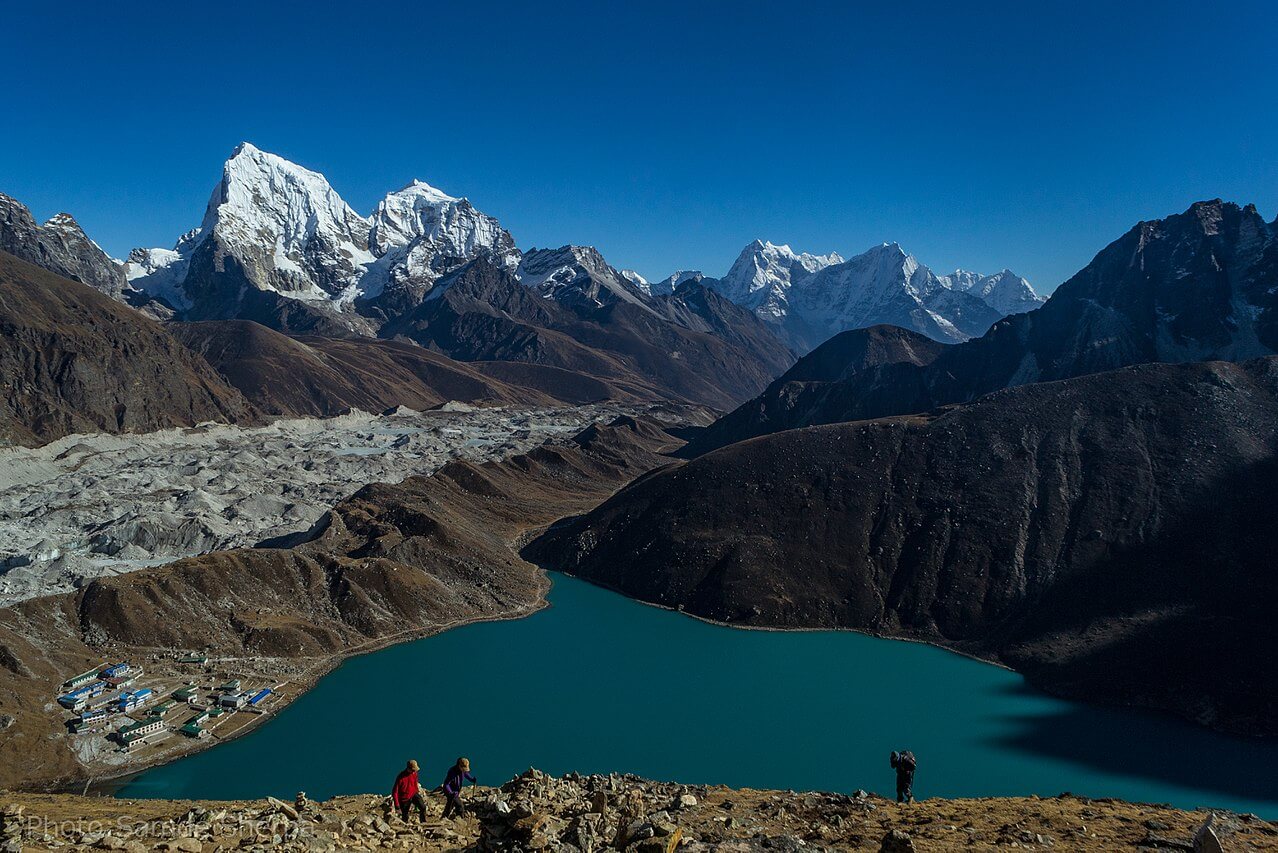
Gokyo Ri Trek
Gokyo Ri Trek, the best alternative trail to the Everest Base Camp Trek, offers exceptional views of the Himalayan peaks along with lakes and glaciers. Gokyo Ri Trek is a moderate trek in the high Himalayas of the Everest region. Instead of traveling to the more commercial Everest Trek, trekkers often choose this itinerary to…
- Trip Advisor Reviews View our clients reviews on Trip Advisor.

- Email us Now [email protected]

- 24/7 Phone Support +9771-4410281 +977-9843098218
The Ultimate Guide to the Manaslu Circuit Trek
8th Nov, 2023
Nestled in the heart of the Nepalese Himalayas, the Manaslu Circuit Trek is widely regarded as one of the best moderate multi-day treks in Nepal. Circumnavigating the spectacular Mount Manaslu (8,163m), the eighth highest mountain in the world, this thrilling journey takes you through remote valleys, high mountain passes, and charming villages.
As you follow ancient trade routes across the Manaslu region, you’ll be rewarded with some of Nepal’s most stunning scenery and fascinating cultural encounters. From the lush forests of the Budhi Gandaki river valley to the arid high-altitude landscapes of the Tibetan plateau, the astonishing diversity of this trek appeals to all hikers.
While less crowded than popular treks like the Everest Base Camp and Annapurna Circuit treks, the Manaslu Circuit Trek still offers all the magic of the Himalayas. Read on to discover everything you need to know to plan your ultimate Manaslu Circuit trekking adventure.
Overview of the Manaslu Circuit Trek
The Manaslu Circuit Trek typically takes between 13-18 days to complete a full circuit of Mount Manaslu. The trek starts and finishes in the town of Arughat after completing a clockwise loop around the mountain.
The total trekking distance is around 160km, with most days covering between 5-8 hours of walking. You’ll cross over several high mountain passes exceeding 5000m in elevation. Proper acclimatization to the high altitude is essential.
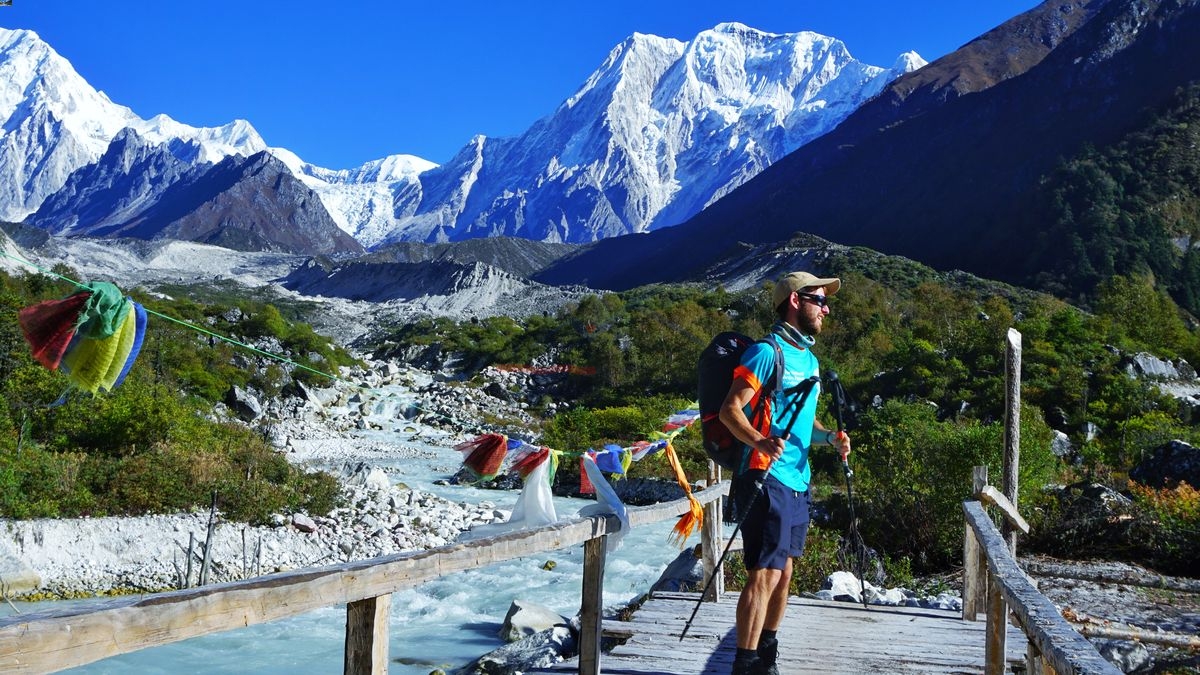
The route passes through remote areas with basic accommodation in tea houses or camping. As this region has only recently opened for trekking, the trails are less crowded than other major treks in Nepal.
The journey combines nature and culture as you witness incredible mountain landscapes as well as traditional Tibetan and Nepali villages. With the stunning scenery and warm hospitality, you’ll be captivated by the magic of the Manaslu region.
Key Highlights of the Manaslu Circuit Trek
- Breathtaking views of Mount Manaslu (8163m) and surrounding peaks like Ngadi Chuli (7871m).
- Crossing the high Larkya La pass (5213m) which links the Marshyangdi and Budhi Gandaki valleys.
- Seeing monasteries, chortens, and mani walls reflecting Tibetan culture and Buddhism.
- Visiting charming villages like Lho, Samagaon, and Bihi showcasing local Nepali lifestyle.
- Trekking through diverse landscapes from sub-tropical to alpine high mountain zones.
- Following quiet trails away from large trekking crowds.
- Spotting exotic wildlife like blue sheep, golden eagles, and Himalayan tahr.
When is the Best Time for the Manaslu Circuit Trek?
The Manaslu Circuit Trek is open from March to May in spring and September to November in autumn. These seasons offer ideal weather for trekking before and after the monsoon rainy season.
During spring, the trails are lined with vibrant rhododendron blooms while autumn showcases clear skies and the Himalayas at their best. Daytime temperatures average 15-20°C in the lower areas. Up high, temperatures drop below freezing at night.
Deep winter from December to February brings harsh cold along the trek, especially at higher elevations and passes. Travel can be hindered by snow. The summer monsoon from June to August sees heavy rain making the trails very wet and slippery.
Therefore, the prime times to trek the Manaslu Circuit are March-May and late September-November. This avoids the extremes of winter and monsoon seasons.
How Difficult is the Manaslu Circuit Trek?
The Manaslu Circuit Trek is considered a moderately difficult trek suitable for avid hikers with prior multi-day trekking experience at high altitude. Proper fitness level, acclimatization, and quality trekking gear are essential.
Here are some key points on the difficulty level:
- Days are long with 5-8 hours of walking on average. Fitness is key.
- High elevation with several passes over 5000m means good acclimatization is vital.
- Trail conditions can be rough or slippery in parts, especially over the Larkya La.
- Cold temperatures at higher altitudes coupled with strong winds.
- Basic tea house accommodation in small villages with shared long-drop toilets.
- Limited health facilities along the remote route.
With sound preparation, a moderate level of fitness, and gradual acclimatization to altitude, most people can complete the Manaslu Circuit Trek. Some strenuous days are compensated by more relaxed walking.
Trekking slowly and allowing extra rest days aids acclimatization. You must be comfortable with multi-day hiking and basic living conditions. Previous experience above 4000m helps considerably.
How to Get to the Manaslu Circuit Trek?
Most people begin the Manaslu Circuit Trek by bus from Kathmandu to Arughat (2 days) or Soti Khola (1 day) to reach the starting point. Jeeps can also drive to Arkhet which shortens the first day’s walk. You can arrange local transportation and permits through a trekking agency.
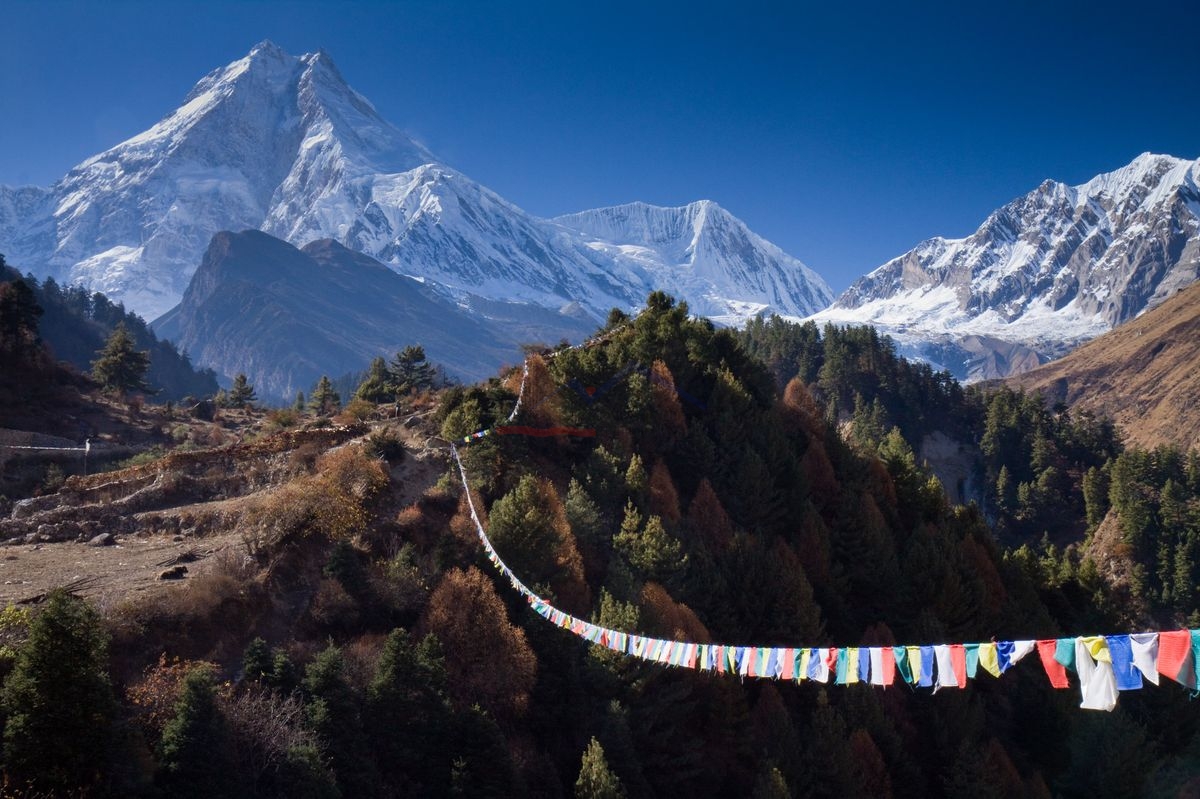
Here is an overview of reaching the Manaslu Circuit Trek start point:
- Local bus from Kathmandu to Arughat takes around 8 hours. From Pokhara, take a bus to Abu Khaireni then change.
- Jeeps can drive from Kathmandu to Arkhet in around 6-7 hours. Shorten day one walking.
- For the fastest start, hire a private jeep to Soti Khola which takes around 4-5 hours.
- Flights from Kathmandu to Tumlingtar then drive 3 hours to Soti Khola. Expensive but saves 2 days.
Arughat is the classic starting point to begin your Manaslu Circuit trek by foot. Travel time is compensated by spectacular overland journeys showcasing rural Nepal before reaching the trails.
Manaslu Circuit Trek Itinerary Overview
While the exact itinerary can vary slightly depending on your start point, pace and acclimatization needs, here is an overview of the standard Manaslu Circuit trek outline over 14 days:
- Day 1: Drive Kathmandu to Soti Khola
- Day 2: Trek to Machha Khola (Fish tail River)
- Day 3: Trek to Jagat village
- Day 4: Trek to Deng village
- Day 5: Trek to Namrung village
- Day 6: Acclimatization day in Namrung
- Day 7: Trek to Samagaon
- Day 8: Acclimatization day in Samagaon. Optional day hike.
- Day 9: Trek to Samdo
- Day 10: Trek to Dharmshala
- Day 11: Cross Larkya La Pass (5213m). Trek to Bimtang
- Day 12: Trek to Gho village
- Day 13: Trek to Dharapani then drive to Besisahar
- Day 14: Drive from Besisahar to Kathmandu
Detailed Day by Day Manaslu Circuit Trek Itinerary
Now let’s look at what each day of the Manaslu Circuit trek entails including highlights and important notes for trip planning:
Day 1: Drive from Kathmandu to Soti Khola (700m)
The journey to Soti Khola takes around 4-5 hours by private jeep. This arterial road leads into the heart of the Manaslu region. Enjoy views of rice terraces and jungle-clad hills before following the Budhi Gandaki River gorge. Stay overnight in simple local lodges.
Day 2: Trek Soti Khola to Maccha Khola (Fish Tail River) (870m)
(Walking: 6-7 hours)
After breakfast, cross the suspension bridge north over the Budhi Gandaki River. The trail leads through Sal forest and ascends on stone steps to the Gurung village of Labubesi. Descend back to the river bank at the confluence with the tributary Khola River. Cross another suspension bridge to Maccha Khola village for overnight stop.
Day 3: Trek Maccha Khola to Jagat (1410m)
Following the Budhi Gandaki, today’s trail climbs over several ridges along the empty riverbank. A tough climb takes you to the charming Gurung village of Jagat where the valley opens up. The entrance stone steps signify arrival in the Nepal Manaslu Conservation Area. Overnight in Jagat in local lodges.
Day 4: Trek Jagat to Deng (1860m)
(Walking: 5-6 hours)
Crossing the river early on, the trail weaves uphill through forests revealing views of Sringi Himal (7187m). Descend to cross the Budhi Gandaki on a long suspension bridge to Deng village. Surrounded by cliffs, Deng is the last permanent settlment until the trek returns here on the circuit.
Day 5: Trek Deng to Namrung (2660m)
Leaving Deng, enter the Budhi Gandaki gorge clad with pine forests. The walking involves lots of ups and downs today. Notice the change in architecture and people, reflecting Tibetan influences. Reach Namrung village, at the doorstep of the high Himalaya.
Day 6: Acclimatization Day in Namrung
wise to spend an extra acclimatization day here enjoying short walks around the village. This helps prepare for higher elevations ahead. Namrung Monastery is worth a visit to view morning puja.
Day 7: Trek Namrung to Samagaon (3530m)
Today crosses the Buddhi Gandaki on a bridge festooned with prayer flags then ascends steeply up the stone steps to the village of Lho. The trail stays high above the river with grand views of Manaslu. The hike ends at Samagaon with its famous monastery and Mount Manaslu views.
Day 8: Acclimatization Day in Samagaon
Spend a second acclimatization day exploring Samagaon. Hike up to the Buddhist nunnery of Pungen Glingsgompa or take the day hike to Pungyen Gompa for closer views of Manaslu. Careful preparation is key before the high pass crossing.
Day 9: Trek Samagaon to Samdo (3860m)
(Walking: 3-4 hours)
A relatively easier day follows the Budhi Gandaki River to the tiny seasonal herding settlements of Dharamsala. The trail finally enters the Tibetan-style village of Samdo. Incredible views of Mt Manaslu, Simnang Himal, Rupina La pass and Larke Peak surround.
Day 10: Trek Samdo to Dharmshala (4460m)
Continue following the Budhi Gandaki north as the valley opens into a wider plateau. Pass more seasonal dwellings like Larkya Bazaar. The high altitude landscape becomes starker and windier. Reach Dharmshala for the night before the big pass crossing.
Day 11: Cross Larke La Pass (5213m), trek to Bimtang (3720m)
(Walking: 8-10 hours)
The longest day begins with a steep ascent over moraine to cross the highest point, Larke La pass (5213m). Enjoy stunning mountain views then begin the long knee-jarring descent to Bimtang. Pass glaciers and summer grazing land to enter the quiet Bhudi Gandaki valley.
Day 12: Trek Bimtang to Gho (2515m)
From Bimtang, follow the Burdin Khola River downstream through rhododendron forests. The landscape becomes greener with classic Nepali hill scenery. The pretty village of Gho is a welcome sight after the high pass crossing. Enjoy a hot shower!
Day 13: Trek Gho to Dharapani, drive to Besisahar (760m)
The last day of walking reaches Dharapani village back on the Annapurna Circuit. From here take a jeep or bus down to Besisahar. Celebrate completing the Manaslu Circuit Trek!
Day 14: Drive Besisahar to Kathmandu (1300m)
The 7-8 hour bus ride back to Kathmandu gives time to reflect on the amazing Manaslu trek. You’ll arrive tired but elated after conquering this ultimate Himalayan adventure!
What to Pack for the Manaslu Circuit Trek?
Planning your gear and packing list is an important part of preparing for the Manaslu Circuit trek. You will need clothing and equipment suitable for both warm and colder mountain conditions.
As you will be carrying your own pack each day, it is essential to pack as lightly as possible without sacrificing essential items. Here is a recommended Manaslu Circuit trek packing checklist:
- Hiking boots – waterproof with good ankle support
- Trekking poles – help with steep ascents and descents
- Quick-dry hiking shirts and pants
- Fleece jacket and insulated down jacket for warmth
- Waterproof shell jacket and pants
- Warm hat, gloves and buff/scarf
- Under layers including thermal leggings and long sleeve tops
- Comfortable socks and underwear
- Sleeping bag – rated down to -10°C or lower
- Inner sleep sheet for tea house lodges
- Hydration pack or water bottles
- Sunglasses and sunscreen
- Headlamp with spare batteries
- Small first aid kit
- Toiletries – eco-friendly soap, toothbrush etc
- Light towel – quick dry travel towels are best
- Any personal medications you require
Hire local porters to carry the majority of gear or join a fully organized camping trek to minimize your load. Good fitness will allow you to enjoy the trek rather than struggle under a heavy pack.
Is a Guide Required for the Manaslu Circuit Trek?
Booking through a registered trekking agency allows you to trek the Manaslu Circuit with an experienced local guide. This is recommended for navigation, arranging accommodation and permits, porters, and gaining insight into the region. Guides also ensure your safety and proper acclimatization.
You can trek independently without a guide and arrange tea house stays as you go. However, a guide provides security in case of emergencies along this remote route. Guides carry safety equipment like satellite phones, oxygen and first aid kits.
Having a guide helps bridge language barriers when interacting with locals. A knowledgeable guide will enhance your overall trekking experience while allowing you to focus on enjoying the trail.
Manaslu Circuit Trek Difficulty and Altitude Considerations
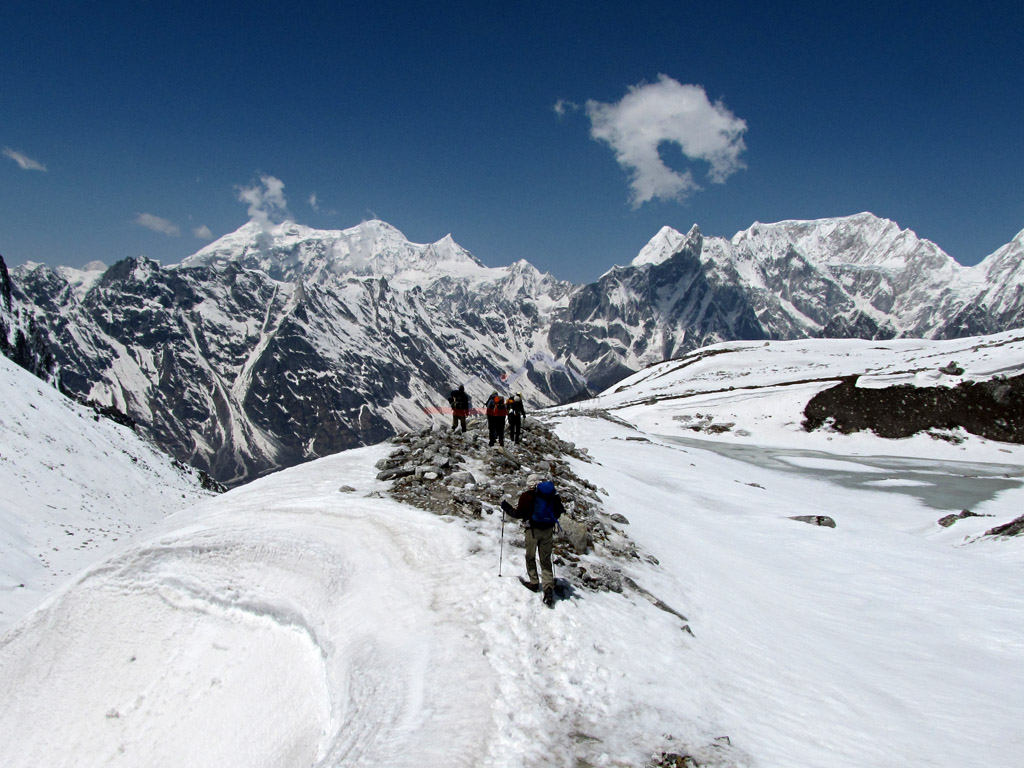
The Manaslu Circuit involves long days hiking at altitude with rough trail conditions in sections. Take care to build your fitness, walk at a gradual pace, and allow rest days to acclimatize. Here are some tips to help overcome the difficulties:
Acclimatization
- Trek slowly. Limit gains in sleeping elevation to 300-400m per day.
- Schedule 2 full rest days in Namrung and Samagaon villages to acclimatize.
- Stay hydrated and eat carbohydrate-rich meals.
- Avoid alcohol and smoking.
- Listen to your body and rest if feeling unwell.
Altitude Sickness
- Recognize signs of AMS (headache, nausea, fatigue). Descend immediately if severe.
- Bring prescription medication like Diamox to aid acclimatization.
- Trek with an agency that provides emergency oxygen if needed.
Trail Conditions
- The circuit has steep ascents and descents, especially around the Larkya La.
- Trails can be slippery or unstable. Use trekking poles for balance and stability.
- Start hiking early to avoid afternoon storms and freezing temperatures.
- Follow your guide’s pace and route for optimal safety.
- Wear proper hiking boots with sturdy ankles.
By taking precautions and working within your physical limits, the Manaslu Circuit trek is achievable for fit hikers who take time to acclimatize. Reap the rewards of completing one of Nepal’s greatest treks!
Permits and Costs for the Manaslu Circuit Trek
The Manaslu region was opened for trekking only in 1991 and still maintains strict permit regulations. You must trek with an official guide as independent trekking is not allowed. All trekkers require:
- Manaslu Conservation Area Project (MCAP) Permit – $70 per week
- Manaslu Restricted Area Permit – $100 per week
- Annapurna Conservation Area Permit – $20 (if finishing in Dharapani)
Expect to pay around $1500 to $2000 per person for a fully organized moderate standard Manaslu Circuit trek including guide, porters, accommodation, permits, and transportation. Budget more for better hotels or camping treks.
A barebones teahouse-only budget trek can be done for under $1000 excluding international flights. Carefully compare packages to see what is included. Most trek prices are all-inclusive except meals and tips.
Is the Manaslu Circuit Trek Worth It?
For moderate multi-day trekkers seeking incredible scenery, cultural encounters and fewer crowds, the Manaslu Circuit Trek absolutely lives up to its reputation as one of Nepal’s finest journeys.
The natural beauty of Mount Manaslu coupled with the raw adventure of crossing the Larkya La pass rewards you with stunning vistas and immense satisfaction of completing this ultimate circuit. Varied landscapes, Tibetan culture and charming villages add rich layers of interest.
While more logistical planning is required than for mainstream treks, the extra rewards of immersing yourself in this remote trans-Himalayan region make the Manaslu Circuit trek worth every step. Be prepared for basic accommodation and travel delays, but don’t let that deter you from discovering the magic of Manaslu!
Customize Trip
Select Country Afghanistan Albania Algeria Andorra Angola Anguilla Antigua & Barbuda Argentina Armenia Australia Austria Azerbaijan Bahamas Bahrain Bangladesh Barbados Belarus Belgium Belize Benin Bermuda Bhutan Bolivia Bosnia & Herzegovina Botswana Brazil Brunei Darussalam Bulgaria Burkina Faso Myanmar/Burma Burundi Cambodia Cameroon Canada Cape Verde Cayman Islands Central African Republic Chad Chile China Colombia Comoros Congo Costa Rica Croatia Cuba Cyprus Czech Republic Democratic Republic of the Congo Denmark Djibouti Dominican Republic Dominica Ecuador Egypt El Salvador Equatorial Guinea Eritrea Estonia Ethiopia Fiji Finland France French Guiana Gabon Gambia Georgia Germany Ghana Great Britain Greece Grenada Guadeloupe Guatemala Guinea Guinea-Bissau Guyana Haiti Honduras Hungary Iceland India Indonesia Iran Iraq Israel and the Occupied Territories Italy Ivory Coast (Cote d'Ivoire) Jamaica Japan Jordan Kazakhstan Kenya Kosovo Kuwait Kyrgyz Republic (Kyrgyzstan) Laos Latvia Lebanon Lesotho Liberia Libya Liechtenstein Lithuania Luxembourg Republic of Macedonia Madagascar Malawi Malaysia Maldives Mali Malta Martinique Mauritania Mauritius Mayotte Mexico Moldova, Republic of Monaco Mongolia Montenegro Montserrat Morocco Mozambique Namibia Nepal Netherlands New Zealand Nicaragua Niger Nigeria Korea, Democratic Republic of (North Korea) Norway Oman Pacific Islands Pakistan Panama Papua New Guinea Paraguay Peru Philippines Poland Portugal Puerto Rico Qatar Reunion Romania Russian Federation Rwanda Saint Kitts and Nevis Saint Lucia Saint Vincent's & Grenadines Samoa Sao Tome and Principe Saudi Arabia Senegal Serbia Seychelles Sierra Leone Singapore Slovak Republic (Slovakia) Slovenia Solomon Islands Somalia South Africa Korea, Republic of (South Korea) South Sudan Spain Sri Lanka Sudan Suriname Swaziland Sweden Switzerland Syria Tajikistan Tanzania Thailand Timor Leste Togo Trinidad & Tobago Tunisia Turkey Turkmenistan Turks & Caicos Islands Uganda Ukraine United Arab Emirates United States of America (USA) Uruguay Uzbekistan Venezuela Vietnam Virgin Islands (UK) Virgin Islands (US) Yemen Zambia Zimbabwe
Select Destination Nepal Tibet India Bhutan
[recaptcha]
Pristine Nepal Treks
Explore, Trek, and Experience Nepal's Best

A Complete Guide to Manaslu Circuit Trek
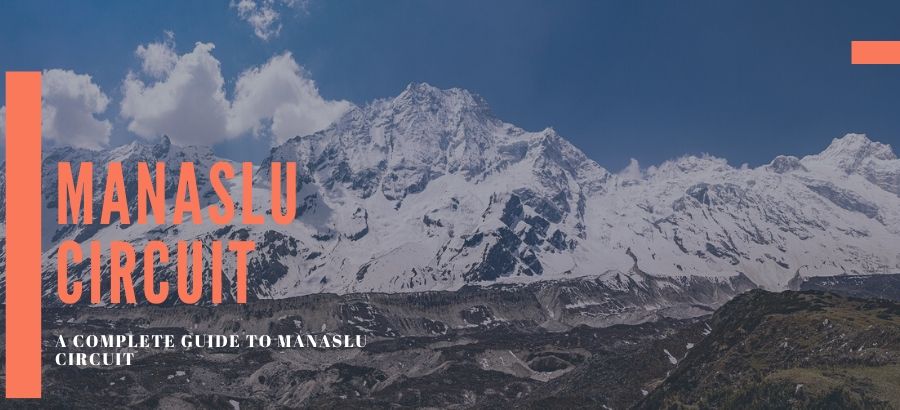
The Manaslu Circuit Trek is one of the popular off-the-beaten-trek in Nepal that will take you to the foot of Eight Highest Mountain in the world, Mount Manaslu. To help you prepare for this amazing trek in Nepal, we present you “A Complete Guide to Manslu Circuit Trek” which will cover:
- Basic Outline Itinerary for Beginners
- Best time to do Manaslu Circuit Trek
- A full Map of Manaslu Circuit
- Required Permits and Permisiions
- Accommodation during the Trek
- Circuit Trek Difficulty Explanation
- Packing List for the Trek
- Some important Q&A about the Trek
If you already know everything then you might like this 15 Days Manaslu Circuit Trek | Off-Limits
Manaslu Cicuit Trip Short Details:
Note*= At least 2 people is mandatory for Manaslu Circuit Trek. Solo trek in this region is impossible.
Outline Itinerary of Manaslu Circuit:
The ititnerary depends upon your physical condition and the route you choose. Considering for the safety of the trekkers, here is the perfect 15 days itinerary of Manaslu Circuit.
- Day 01 Arrival in Kathamndu & Transfer to Hotel
- Day 02 Preparation and Sightseeing Day
- Day 03 Drive to Macha Khola (930m)
- Day 04 Trek to Jagat (1,410 m)
- Day 05 Jagat to Deng (1,800m)
- Day 06 Trekking to Namrung (2,630m)
- Day 07 Namrung to Syala (3,500m)
- Day 08 Trek to Sama Gaon (3,530m) & Visit Pungyen Gumba – 5hrs
- Day 09 Acclimatization day at Sama Gaon
- Day 10 Trekking to Samdo (3,860m)
- Day 11 Trek to Dharamsala/Lake Phedi (4,470m)
- Day 12 Larke-La Pass with 5,106m altitude and to Bhimthang-3,720m
- Day 13 Trek back to Dharapani 1,860m
- Day 14 Drive back to Kathmandu which is the starting point.
- Day 15: Departure From Kathamndu
Best Time & Weather to do Manaslu Circuit Trek:
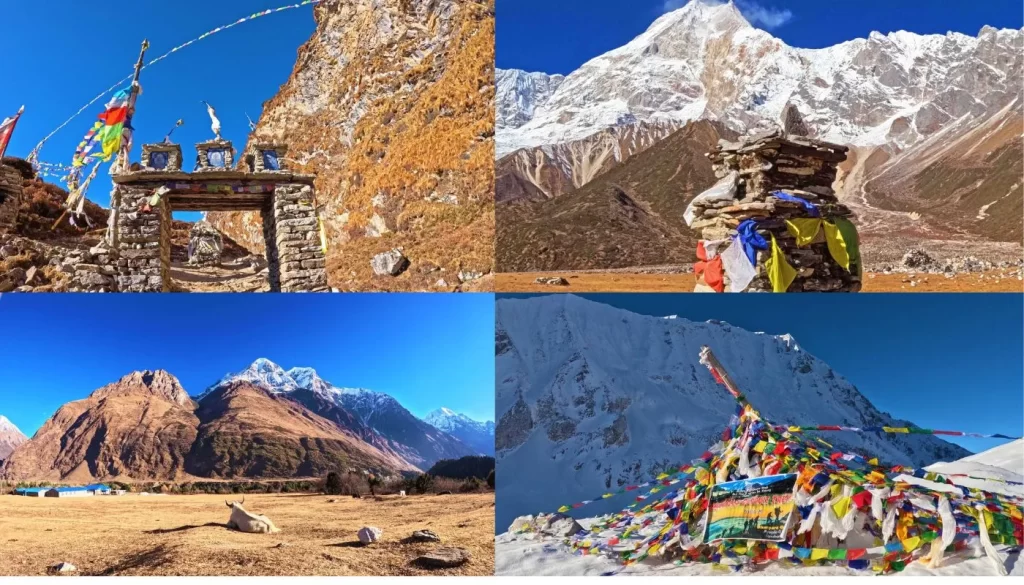
The best weather for Manaslu Circuit Trek is from September to Novermber , and from March to May which are the Autumn & Spring season . During this time, the weather are mostly clear and warm with temperatrures ranging from 15°C to 25°C during day.
See the details of each month and find how you can trek during Monsoon and Winter season too.
Spring Season for Manaslu Circuit:
During the spring season, the weather is generally pleasent as well as less crowded than Autumn season. Manaslu Circuit Trek during this time offers clear view of mountains and lush Rhododendron forests. Here is short information about each month in Spring season.
- March : This month is the starting of Spring season and the good time to do Manaslu Circuit Trek as it will be less crowded. The temperature will change according to the elevation. Normally, 10°-20°C is expected during the day & 0°-10°C duing nighttime.
- April : It brings you along with Nepali New Year. The weather & temperature is similer to month of March however with possibility of rain or snow.
- May= It ends the spring season and slowly temperatures start to increase. The temperature is fairly warm at this time. Trekking in this month makes you break a sweat but not miserably hot. Even though the temperature is quite hot at lower altitudes, it’s mildly cold at higher altitudes.
Summer Season for Manaslu Circuit:
The summer season is also known as the monsoon season in Nepal, which means that weather will be wet & more humid. The trail is also dangerous during this time with slippery roads, risk of landslides or floods. Despite the potential danger, people still manage to do the Manaslu Circuit Trek.
If you are well-prepared and want to take challenge then starting of June and end of August can be the best time.
Autumn Season for Manaslu Circuit:
The autumn season is the best season to trek any trekking trails in Nepal due to its warm days and cool nights . The weather is generally dry & clear, with fields full of different types of crops, and the main festival of Nepalese people i.e. Dashain and Tihar also fall in this season.
- Septembe : September is the first month of the autumn season. Basically, the monsoon ends in the middle of September. So, most of the rain is experienced in September. This month provides stable and glorious weather conditions. The average temperature this month is 7.7°C.
- October : October is the best month for trekking in this Manaslu circuit. After September there is no chance of downpour, days are always moderate which is the perfect weather for trekkers. This month, you can examine awesome mountain views and you’ll be surrounded by eye-catching snow-capped mountains.
- November : November is the final month of this autumn season where the temperature starts to decrease remarkably. This month brings you cold and dry weather. Trekking in this month too provides eye-catching snow-capped mountains.
Winter Season for Manaslu Circuit:
During winter, the the days are shorter, with much more cold temperature and bad weather possibility. The temperature easily goes down to -20°C during night and morning. However, it is still possible to trek during this season.
If you ever go trek during Winter then you will face tough challenges however best experience and views. The trail will be so empty that there won’t be anyone to disturb you.
Manaslu Circuit Trek Map:
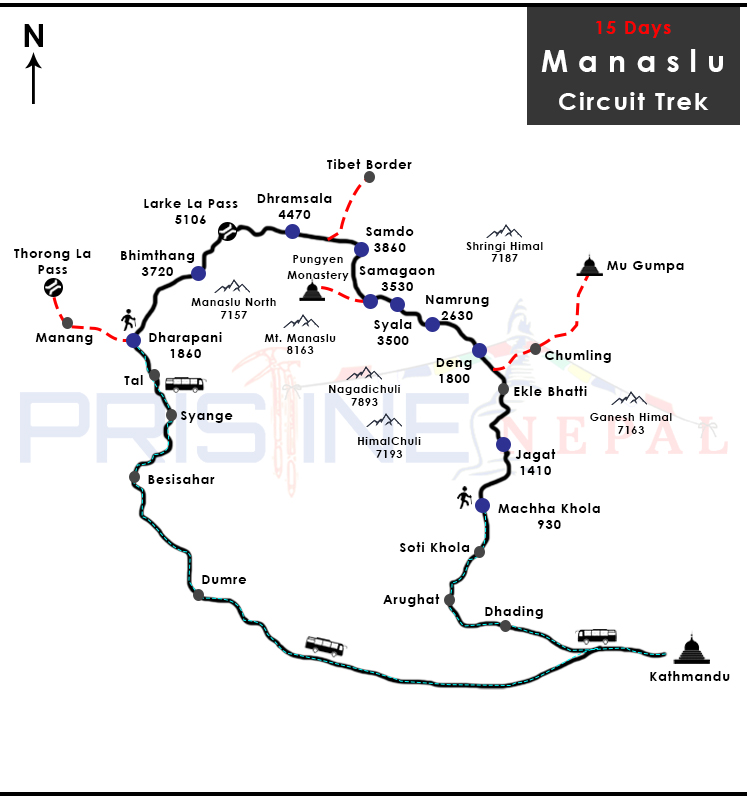
This Manaslu circuit trek map is designed according to our Manaslu circuit trek itinerary. As seen on the map, you will trek in anticlockwise starting from Soti Khola & ending at Dharapani.
Permits & Costs for the Manaslu Circuit Trek:
Manaslu Circuit Trek was opened for trekking in 1991 A.D & falls under the restricted area of West Nepal, Manaslu Conservation area. To be able to trek in this region, you will need the following permits which can be obtain from Nepa Government or trekking agenciws like us.
Note:* Permits are not issued for independent trekkers. There must be a minimum of two trekkers along with one local guide.
Special Restricted Permits for Manaslu (RAP) :
Remember this permit relies upon the month & the number of days you will spend in this region.
- September to November : USD 100 per person for the initial seven days and USD 15 for each extra day from the eighth day onwards.
- December to August : USD 75 per person for the initial seven days and USD 10 for each extra day from the eighth day onwards.
Manaslu Conservation Area Permit (MCAP) :
This Manaslu trek permit is required as soon as you enter the Manaslu Conservation Area. The price of this permit remains constant throughout the year.
- MCAP fee for SAARC Nationals : NRS 1000 / Approx. USD 10
- MCAP fee for other Nationals : NRS 3000 / Approx. USD 30
Annapurna Conservation Area Permit (ACAP)
This Manaslu permit is required from Dharapani until you exit Annapurna Conservation Area in Besishar. Similar to MCAP the price is constant throughout the year.
- ACAP fee for SAARC Nationals : NRS 1,000 / Approx. USD 10
- ACAP fee for other Nationals : NRS 3,000 / Approx. USD 30
Trekkers’ Information Management System (TIMS)
Many agencies state that TIMS is not necessary for the Manaslu Circuit trek but that is not completely true. TIMS is needed in every trekking trail to ensure the safety & security of trekkers.
- TIMS fee for SAARC Nationals : NRS 300 / Approx. USD 3
- TIMS fee for other Nationals: NRS 1000 / Approx. USD 10
- TIMS for FIT (Free Individual Trekker) : NRS 2000 / Approx. USD 20
Where to get these trekking permits?
On the off chance that you are doing this trek individually, at that point you can get these permits from Nepal Tourism Board Office situated on Pradarshani Marg, Kathmandu or in Pokhara at the Nepal Tourism Board Service Center. Extra Notice *
- No entrance fee required for children under 10 years
- Should carry MCAP & ACAP individually
- 4 passport size photos for permit
Accommodation During Manaslu Circuit Trek:
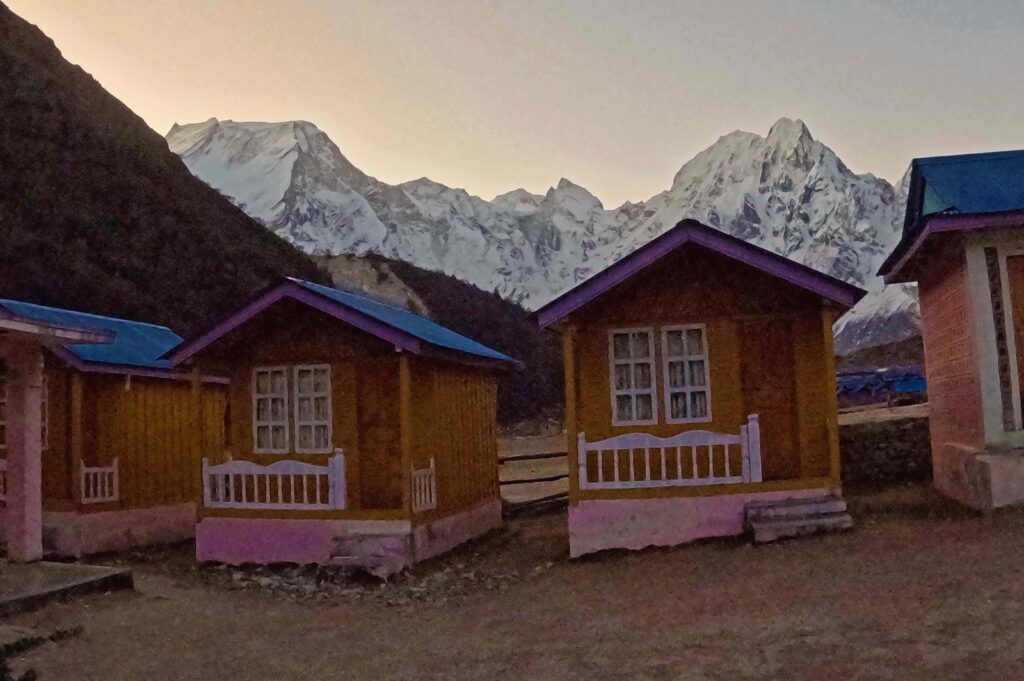
Manaslu circuit trek is one of the restricted and isolated trekking regions of Nepal. You will find tea houses in the form of accommodation in Manaslu Circuit trail. Tea Houses offers basic facilities that includes private room, shared bathrooms, & a dining room.
Similarly, the avaibality of accommodation in the higher elevation is limited which is why it is important to book in advance or secure your stay. Overall, it is hard to find rooms during peak season.
If you have done this trek before then you might recall the name of the tea houses that I have listed below.
Accommodation in Soti-Khola :
- Satkar Guest House
- Tsum Valley Guest House
- Green Valley Guest House
- ABC Guest House
- Fulbari Guest House
All these guest houses provide the basic facilities i.e. food and rooms. Similarly, each guest house provides wifi service and telephone services.
Machha Khola :
- Everest Guest House
- Larkey Guest House
- Hilltop Guest House
Jagat is 7hrs away from Machha Khola and it is the third day of the Manaslu trek. Like Machha Khola trekkers will find just four guest houses here too. All those guest houses provide wifi and satellite phone facilities like Machha Khola & trekkers can find four guest houses in Jagat too. They are:
- Manaslu Santi Guest House
- Himalayan Tourist Guest House
- Jagat Guest House
- Rubi Nala Guest House
From Jagat restricted permit for Manaslu as well as Tsum valley starts. Trekkers can see the check post where they need to show their permit and register it.
- Shangri-La Cottage
- Windy Valley Guest House
- New Manaslu Guest House
All of these guest houses have wifi facility but they don’t have a hot shower.
- Nubri Four Season Resort
- Namrung Thakali Guest House
- Namrung Guest House
- Lama Guest House
- Tashi Dalek Guest House
- Majestic Manaslu Guest House
- Namaste Guest House
Sama Gaun :
- Nobri Guest House
- Norling Guest House
- Mount Manaslu Guest House
- Sama Gaun Guest House
- Gurung Cottage Guest House
- Peace Heaven Guest House
- Jambala Guest House
- Tibetan Twin Hotel
Dharmasala :
- Sushma Guest House
- Ganga Guest House
- Himalayan Guest House
- Apple Garden
- Mountain Ponker Cottage
Dharapani :
Dharapani is the last stop of this Manaslu circuit trek. Here, trekkers can find lots of guest houses with lots of facilities according to your budget. Trekkers can find a room with an attached toilet too. As well as trekkers also can find wifi and hot water shower service easily. Basically, the cost of accommodation in Manaslu differs on the basis of season. Likewise, the higher the altitude-higher the cost of accommodation will be. The cost of accommodation starts from $3-$5 in peak seasons in the lower altitude where at higher altitude the cost starts from $7-$10. While in off-season trekkers can find accommodation in $2-$3 in lower altitude and $5-$7 in higher altitude.
Manaslu Circuit Trek-Difficulty Level:
In terms of difficulty, Manaslu Circuit Trek is considered as moderate to challenging level trek which can be done by beginner to avid trekkers. However, why it can be hard for some trekkers? Here are the reasons why Manaslu Circuit Trek can be hard.
Difficulty by Distance:
Located in the west-central part of Nepal, the total distance of the Manaslu circuit covers is about 177 km . You’ll be walking for 15-20km on daily basis for about 10 to 12 days , which can be real trouble for beginners’ trekkers. Basically, the treks start from either Barpark or Soti Khola.
The first few days of trekking will be a little difficult as the Budi Gandaki George is harsh steep. Also, you have to walk through a lot of uphill’s & downhills frequently . The trail can be breezy while crossing the suspension bridge above the Budi Gandaki River.
Difficulty by Elevation & Acclimatization:
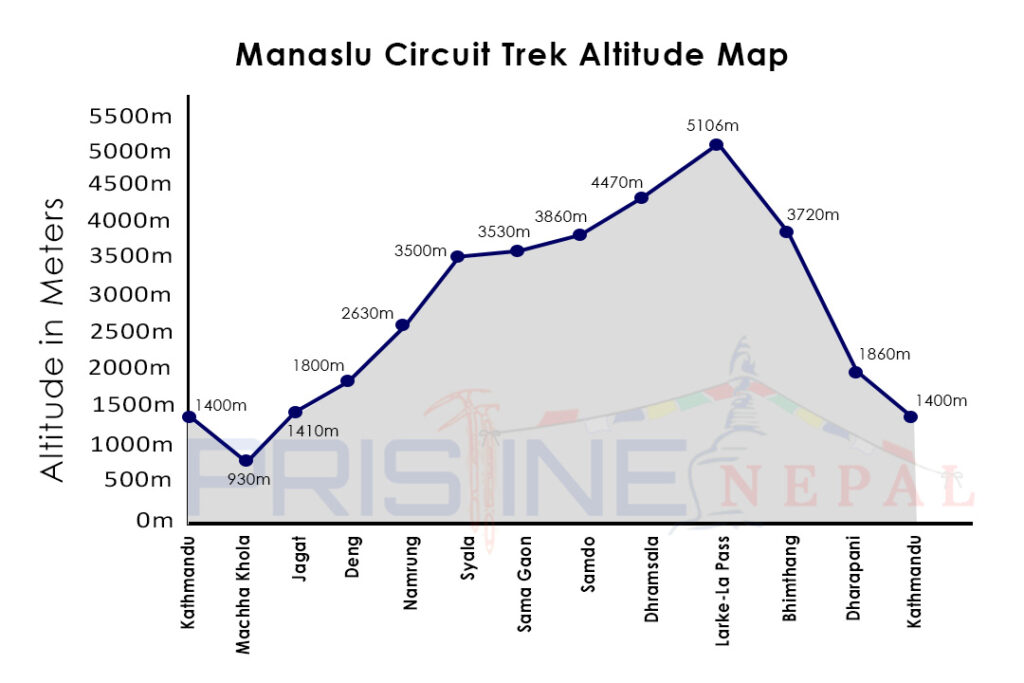
Manaslu trek is widely varied, taking you from its lowest point at 730m (Soti Khola) to the highest point of Manaslu, Larke Pass at 5,106m. Also, crossing Larke Pass at an altitude of 5,106m is the biggest challenge of this trek. Throughout the trek, you’ll walk for about 6 to 8 hours on a daily basis gaining 500m to 700m of elevation. Altitude sickness can be a major problem for most trekkers. So good physical fitness is a must to complete this trek. Drinking plenty of water, walking slowly, taking regular rest along the way can help you stay away from altitude sickness. Note*: If you find any disorder in your body such as shortness of breath, dizziness, headache, vomiting, loss of appetite then immediately inform your guide . In case if you are alone seeking help from fellow travelers or quickly descend to lower altitudes. Altitude sickness or AMS is a serious condition & is fatal most of the time. On our standard 15 days Manaslu circuit trek itinerary, you’ll rest at Sama Gaun (3,520m) for acclimatization. The rest day is very important for your body to adjust to higher altitudes.
Preparations for Manaslu Circuit Trek:
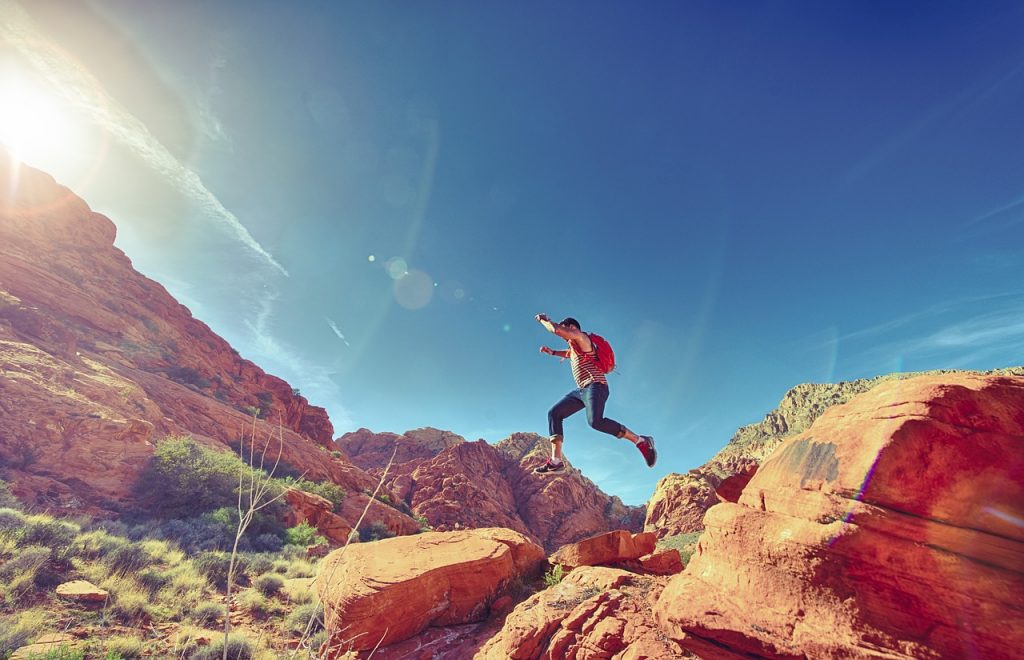
Trekking in Nepal may not be as easy as you thought. Walking uphill & downhill frequently for 5 to 8 hours per day with your daypack is definitely not a joke. It requires a good level of physical strength & mental preparation. As mention already, Manaslu is a moderately difficult trek. You have to walk via steep hills, rocky paths, jungles & suspension bridges as well.
So how do you prepare for this trek?
- Strengthen your legs, since trekking is done all by walking. For leg workouts you can include leg press, squat, walking lunge, reverse table-up & so on.
- Have good cardiovascular fitness. This will help to supply oxygen-rich blood to the working muscle tissue.
- During the Manaslu trek as you gain elevation, the amount of oxygen level decreases. So in order to cope with this situation, you need to build cardiovascular fitness. To build cardiovascular fitness do activities like cycling, jogging, running & swimming.
- Do yoga & meditations. It is a must to keep yourself calm & handle stress in different conditions. In most cases, I have seen many trekkers worrying about the altitude. Don’t worry, just go slow & enjoy your trek.
Transportation in Manaslu Circuit Trek
Manaslu Circuit trekking journey starts from Soti Khola & ends at Dharapani. And there are two options to reach Soti Khola either go by local bus or by private vehicle. If you plan to go by public bus note that there is no direct bus access to Soti Khola from Kathmandu . You will make a transit in Arughat. The total distance from Kathmandu to Arughat is 136km & from there to Soti Khola is roughly 18 km & in total it will take you around 7-8 hours which depends on the road condition. Riding by private vehicles is a perfect decision. This is a hassle-free alternative as you don’t need to hang tight for and search for open transports. Private jeeps with a visitor plate ( in green shading ) can take you directly to Soti Khola without stopping in Arughat. On the other hand, private jeeps with a red plate, then again, need to stop in Arughat, from where you have to change to a privately reserved jeep to keep on Soti Khola.
What to pack for Manaslu Circuit Trek?
I know it’s a nerve-racking task when it comes to packing for trekking in Nepal and the same goes for Manaslu circuit trek as well. Here is why we have prepared you a complete packing list for the Manaslu Circuit trek to help you get a head start.
Quick tip: Try to make your backpack as light as possible. Avoid bringing unnecessary items.
Is it possible to buy all the trekking items in Nepal?
Yes, of course. There are lots of trekking gear shops in Thamel, Kathmandu where you can easily buy every trekking gear & equipment. These shops sell quality clothes, gears & accessories at a reasonable price. Also, you can get sleeping bags & down jackets in rent for which they will be charging you per day.
- Sleeping bag charge: Nrs 100/ $1
- Down Jacket charge: Nrs 100/ $1
Thank you for reading the full blog. If you are interested in more of the blogs then don’t forget to look the blog sections.
About Author
As the head of Pristine Nepal Treks and Expedition, he is the inspiration for all the young generation who wants to work in the trekking field. As he is working in the tourism/trekking field from a young age he is always interested to learn and exploring more about the Himalayas, Culture, History, and politics too.
With a very friendly nature, smart personality, and kindness he is an expert in the tourism sector and has already organized countless trekking trips and going on.
Leave a Reply Cancel reply
You must be logged in to post a comment.
- You are here:
A Comprehensive Guide to the Manaslu Circuit Trek- things you must know
- Modified on Nov 29, 2023
Discover the hidden gem of trekking in Nepal with the Manaslu Circuit Trek . Nestled in the heart of the Himalayas, this trek offers a unique and less-crowded alternative to the more popular routes, providing an authentic Himalayan experience. In this guide, we'll delve into the details that make the Manaslu Circuit Trek a must-visit for adventurers seeking breathtaking landscapes, cultural richness, and a genuine connection with the mountains.
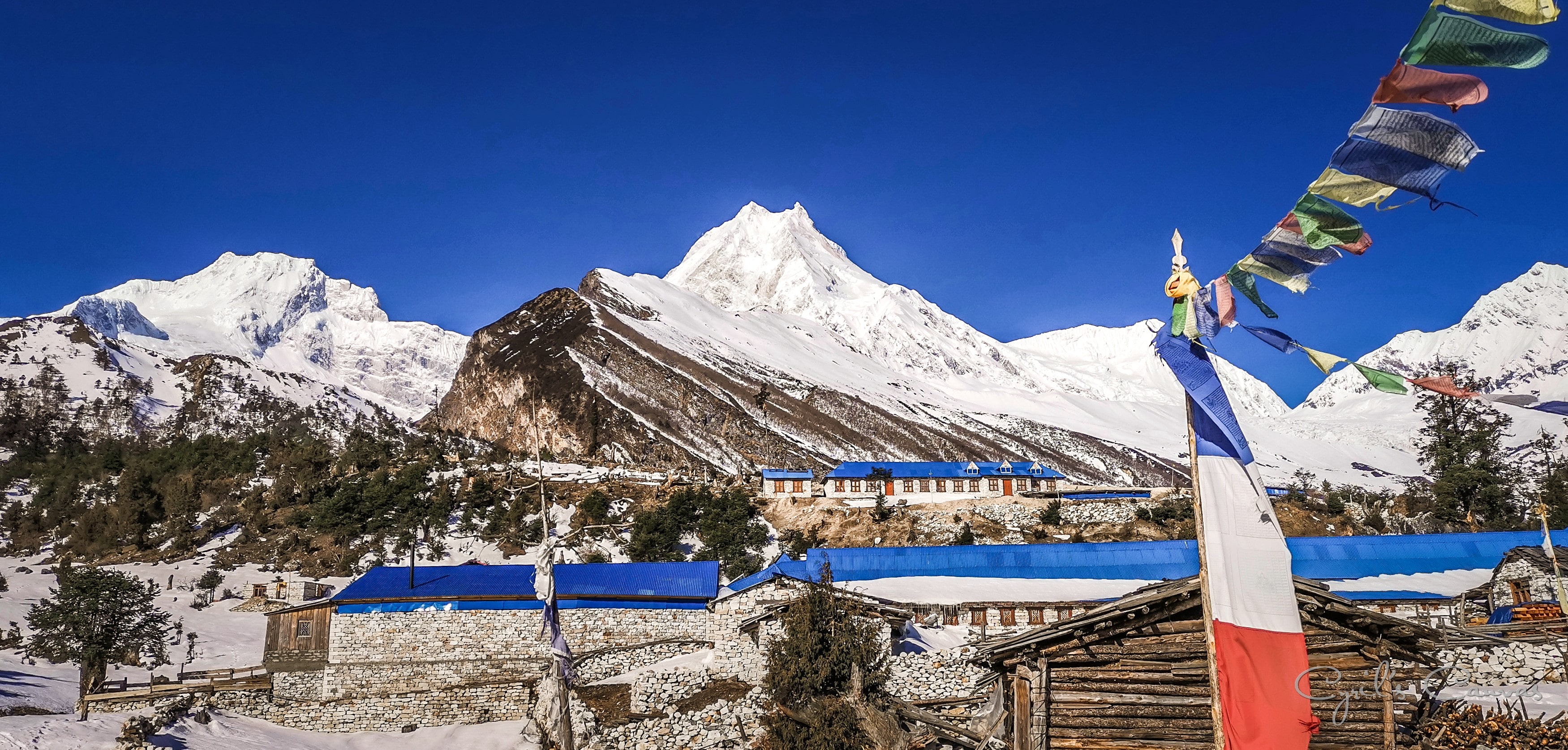
Table of Contents
Trekking route:.
Embark on an unforgettable journey as you navigate the circuit around Mount Manaslu, the eighth-highest peak globally. The trek commences in Arughat or Soti Khola, guiding you through enchanting villages, dense forests, and high-altitude landscapes. Key stops along the route include Deng, Namrung, Lho, Samagaon, and Samdo. The pinnacle of the trek is the challenging Larkya La Pass, standing at an awe-inspiring 5,160 meters.
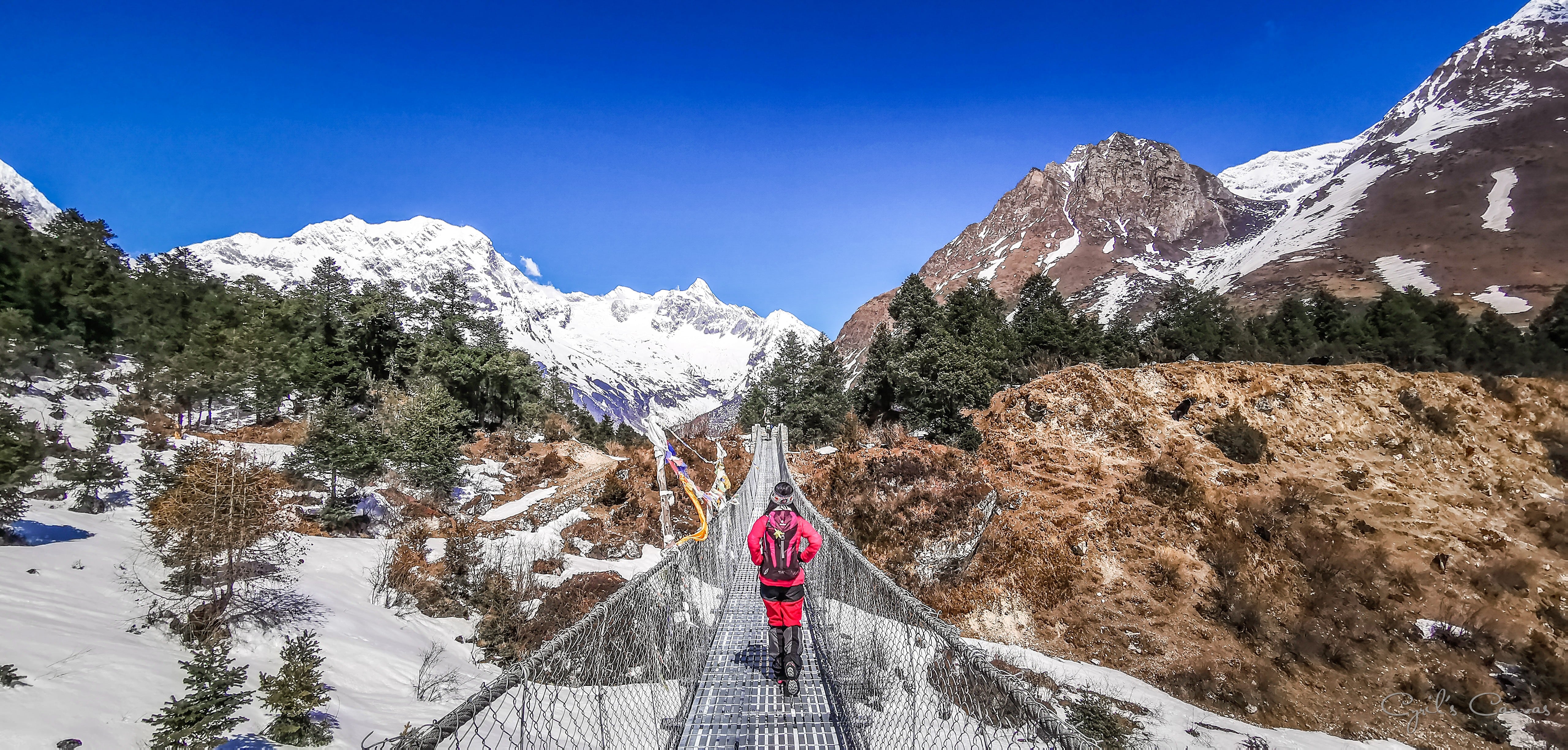
Prepare for your adventure by obtaining the necessary permits. A Manaslu Restricted Area Permit and a Manaslu Conservation Area Permit are essential, along with the requirement to be accompanied by a licensed guide.
Best Time to Trek:
Optimal trekking seasons are during the spring (March to May) and autumn (September to November), ensuring stable weather conditions and panoramic views of the surrounding peaks.
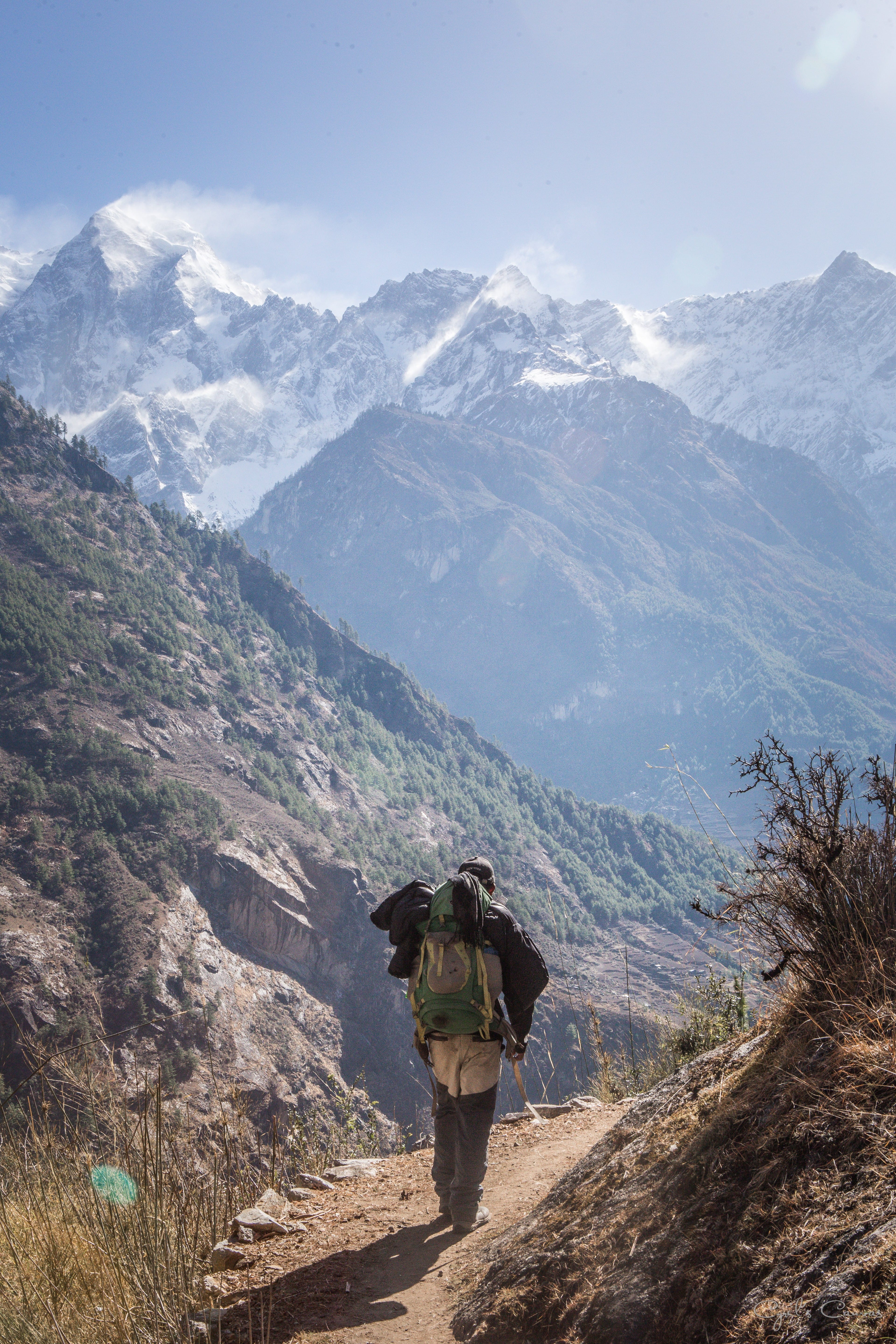
The trek usually takes around 14 to 18 days, depending on the chosen itinerary and acclimatization days.
Highlights:
- Scenic Beauty: The trek offers diverse landscapes, from lush green hills to alpine meadows and high mountain deserts.
- Cultural Experience: Encounter traditional Tibetan-influenced villages, monasteries, and the warm hospitality of the locals.
- Mount Manaslu: Enjoy stunning views of Mount Manaslu and other peaks like Himlung Himal, Cheo Himal, and Annapurna II.
- Larkya La Pass: Experience a challenging but rewarding ascent to Larkya La Pass, where you are surrounded by majestic snow-capped peaks.
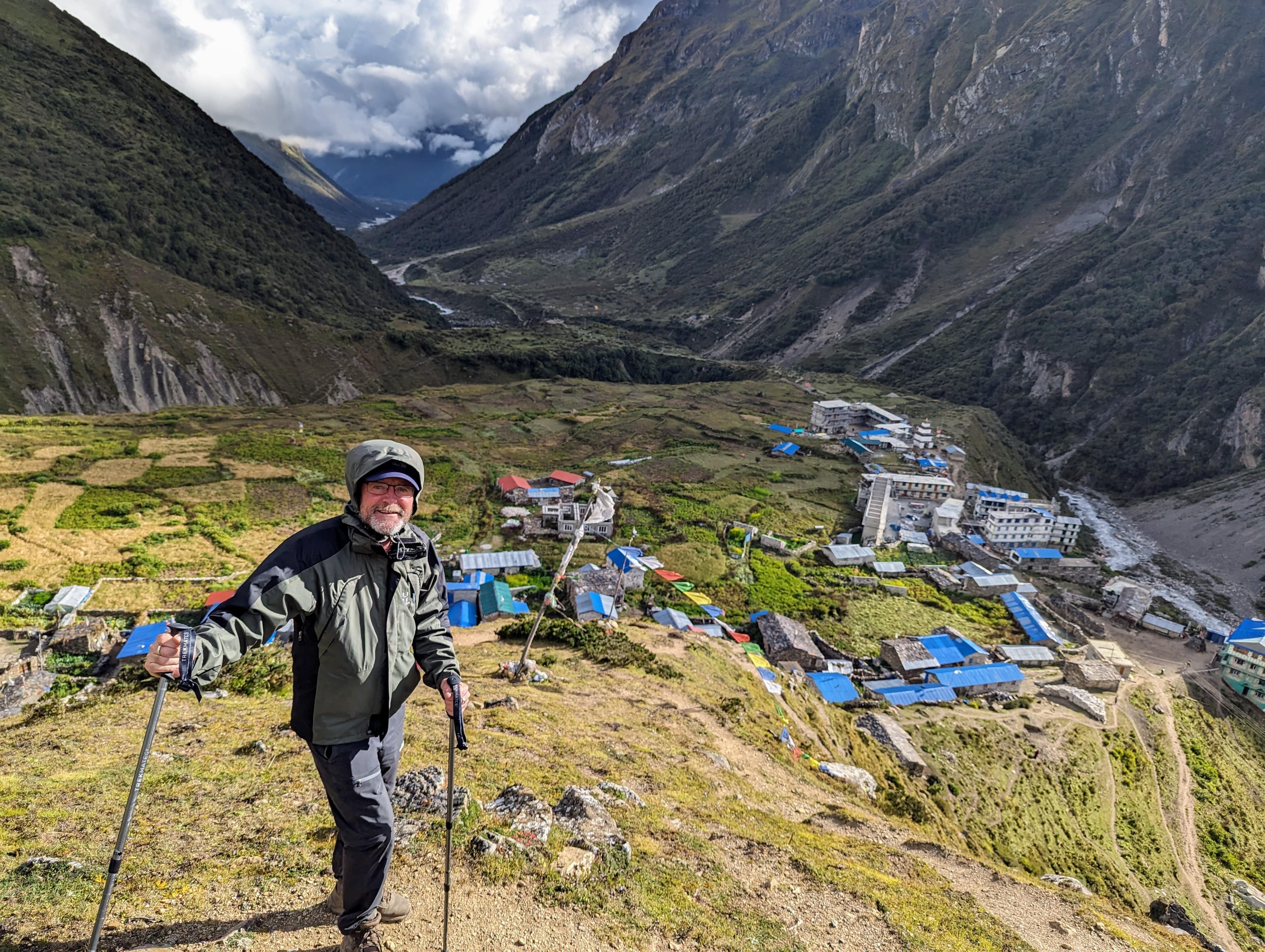
Difficulty Level:
The Manaslu Circuit Trek is moderately challenging, demanding physical fitness and proper acclimatization due to altitude changes and high mountain passes.
Accommodation:
Experience the warmth of tea houses and lodges along the route, offering basic yet comfortable accommodation. Booking in advance is recommended, especially during peak trekking seasons.
Preparation:
Physical fitness is essential for the trek, as there are steep ascents, descents, and the challenge of crossing high mountain passes.
Adequate gear, including warm clothing, a good pair of trekking boots, and a reliable backpack, is necessary. Trip Check list here
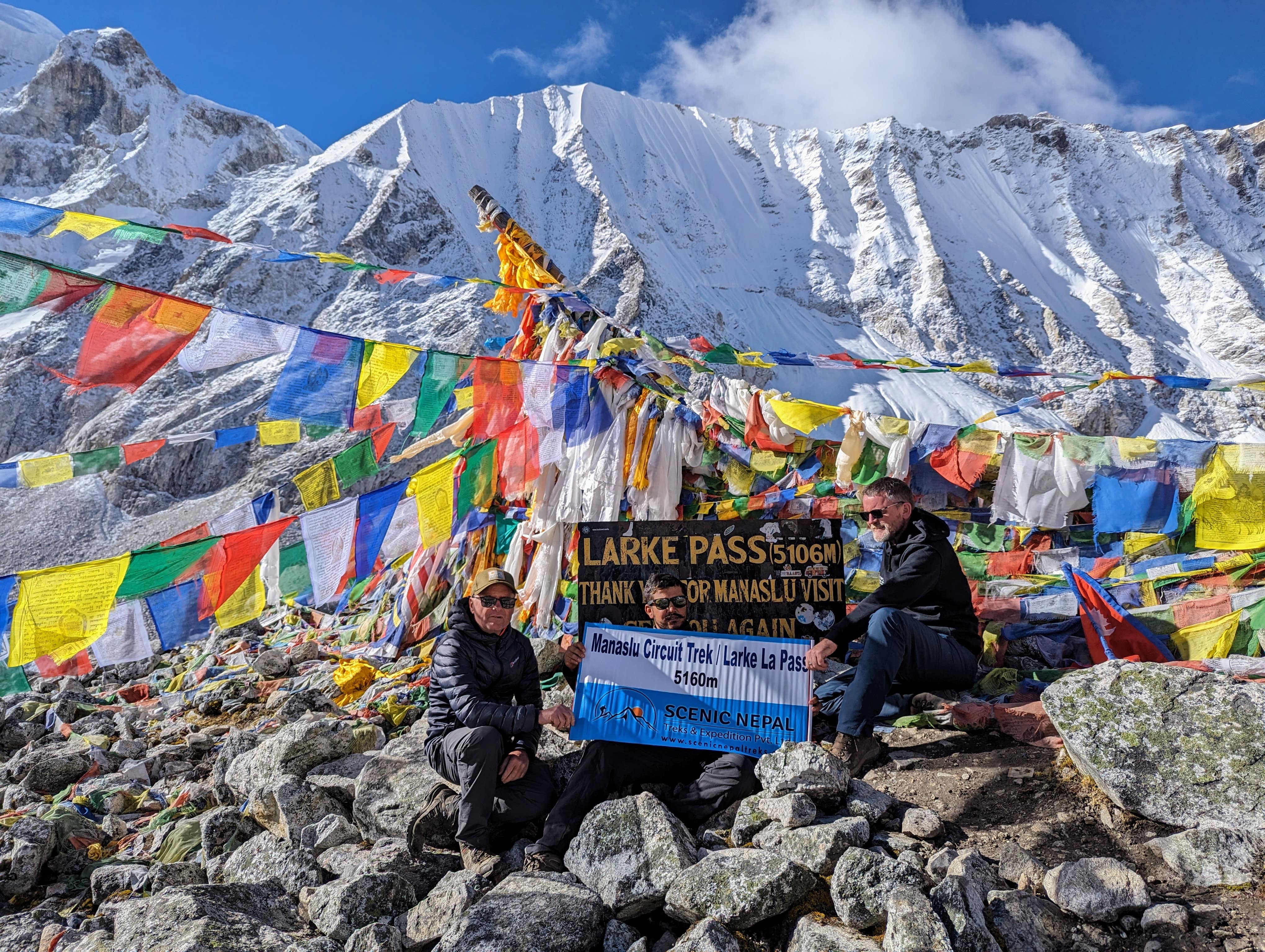
Cultural Sensitivity:
Respect local customs and traditions, embracing the strong Tibetan influence present in many villages along the route.
Hiring a Guide/Porter:
Consider the option of hiring a local guide or porter to enhance your experience, providing valuable support in navigation, cultural insights, and load-carrying. Scenic Nepal Treks offers you best guides.
Side Trips:
For a more immersive experience, explore side trips to Tsum Valley, a culturally rich and remote gem in the Manaslu region.
Unlock the wonders of the Manaslu Circuit Trek and create lasting memories as you traverse the captivating landscapes and cultural treasures of this Himalayan haven. Whether you're a seasoned trekker or a first-time adventurer, this trek promises an unparalleled journey into the heart of Nepal's majestic mountains.
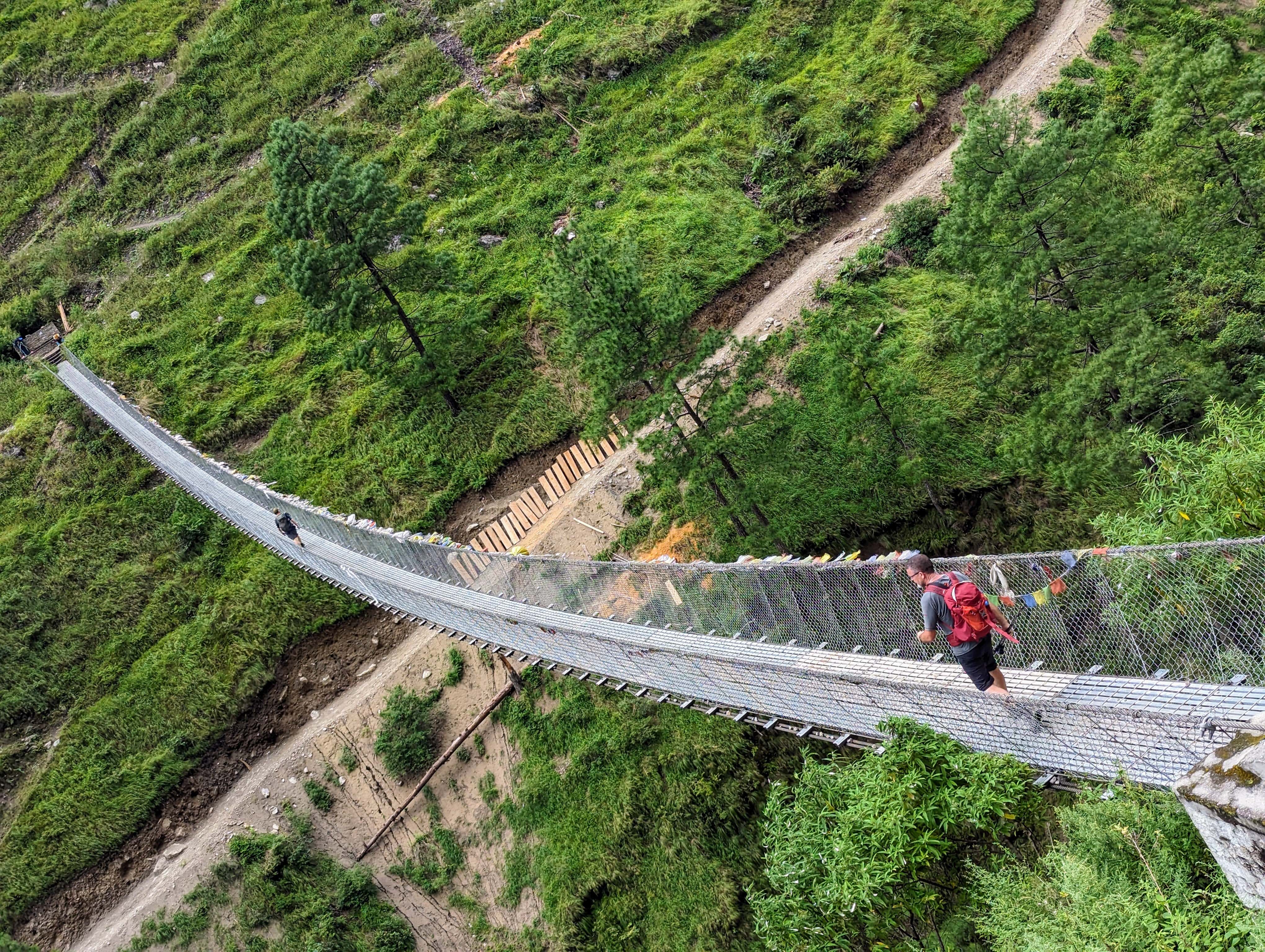
WHY manaslu circuit trek:
The Manaslu Circuit Trek offers a unique and captivating trekking experience in the Himalayas, presenting several compelling reasons for adventure enthusiasts to choose this trail:
Untouched Beauty:
The Manaslu region remains less frequented than popular trekking destinations like Everest and Annapurna, allowing trekkers to explore pristine landscapes in a more tranquil and untouched setting.
Cultural Immersion:
Trekking through traditional Tibetan-influenced villages provides an authentic cultural experience. Encounter the warmth of the locals, witness ancient monasteries, and gain insights into the unique customs of the region.
Stunning Mountain Vistas:
Revel in awe-inspiring views of Mount Manaslu, the eighth-highest peak in the world, as well as neighboring peaks like Himlung Himal, Cheo Himal, and Annapurna II. The diverse landscapes offer breathtaking panoramic vistas at every turn.
Challenging Larkya La Pass:
Conquering the Larkya La Pass at 5,160 meters is a thrilling challenge that rewards trekkers with unparalleled views. The sense of accomplishment upon reaching this high-altitude pass adds to the trek's allure.
Remote and Serene Atmosphere:
Unlike more popular trekking routes, the Manaslu Circuit offers a quieter and more serene atmosphere. Trekkers can enjoy the tranquility of nature and the Himalayan wilderness without the crowds.
Cultural Diversity:
The trail passes through diverse landscapes, from lush green hills to alpine meadows and high mountain deserts. This variety contributes to a rich and ever-changing trekking experience.
Tea Houses and Local Hospitality:
Accommodations along the route are provided by charming tea houses and lodges run by locals. This not only adds to the cultural experience but also ensures a cozy and welcoming atmosphere after each day's trek.
Moderate Crowds:
While the region has been gaining popularity, it still attracts fewer trekkers compared to more well-known routes. This results in a more intimate and personal trekking experience.
Adventure Off the Beaten Path:
For those who seek adventure off the beaten path, the Manaslu Circuit Trek offers an opportunity to explore a less-commercialized region while still enjoying the grandeur of the Himalayas.
In summary, the Manaslu Circuit Trek is a captivating choice for those who desire a unique blend of natural beauty, cultural immersion, and adventure in a less-explored and serene Himalayan region. Come and Join us. Send Inquary now
- Trekking in Nepal
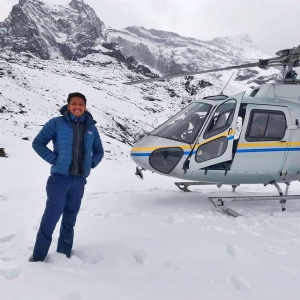
Dipendra Phuyal
I, Dipendra is an Adventure Specialist and founder of Scenic Nepal Treks and working in Mountain Travel and Tourism for more than a decade.
I have been leading different Hiking groups from all around the World to the Himalayas including Everest Base Camp, Annapurna Base Camp, and many more. Follow me for my adventure on Facebook and Instagram
Send us a message
Recent posts.
- Everest Base Camp Trek Guide: Essential Tips for a Successful Himalayan Adventure
- Top Three Adventure Holidays in Nepal in 2024 | Best Deals Guaranteed
- Best time of the year to trek in Nepal
- How hard is to trek to Everest Base Camp ?
- The Best Non-Technical Peak in Nepal for Beginner Climbers
- Walk In The Shadow Of Verdant Hills And Towering Mountains To Everest Base Camp
- Uncategorized

Want a tailor-made trip?
Your trip, your way, your budget, your time, your activities, planned by an expert.
We use cookies to ensure that we give you the best experience on our website.

Manaslu Circuit Trek: A Journey to the Untamed Himalayan Frontier
- Last Updated on Jul 7, 2023
If you are into remote trekking and love to push your limits, then the Manaslu circuit is one of the excellent adventure packages for you in Nepal. You can do this trek in 12 to 24 days, as per your availability. Remote trekking is one of the most popular tourist activities in the Himalayas of Nepal. And Manalsu circuit package is one of the most loved ones.
Table of Contents
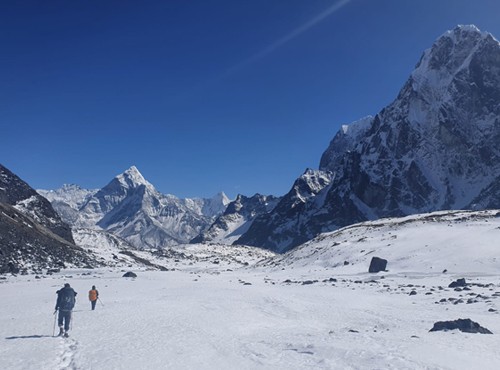
Everest Three passes Trek - 21 Days
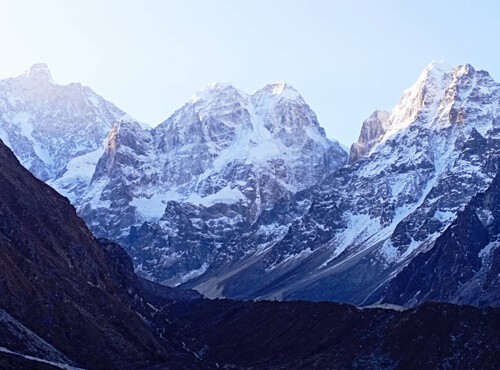
Kanchenjunga Circuit Trek - 19 Days
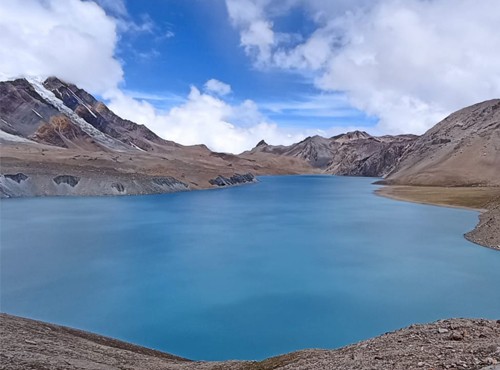
Annapurna Circuit Trek with Tilicho Lake - 19 Days
This trekking route has all the adventure, raw natural beauty, no crowd, and challenges. Unlike the Kanchenjunga circuit trek, Makalu base camp trek, and Upper Dolpo trek, which rely on camping, the Manaslu circuit will let you enjoy the same level of adventure and thrill while spending nights in teahouses.
*Note: The Manaslu region is a restricted area in Nepal, so travelers need special restricted area permits to trek.
Trekking in the Manaslu region is not just about physical adventure. It also offers a soul-stirring experience that connects you with nature's raw magnificence and the pristine spirit of the Himalayas. The region's untouched wilderness, gorgeous river valleys, rushing rivers, landslide areas, glacier paths, etc, make the journey a lifetime experience.
In this blog, we will talk about the famous and adventurous Manaslu circuit trek, where remote trails, towering peaks, and cultural encounters await. Get ready for an unforgettable journey in one of the hidden gems of the Himalayas.
Manaslu circuit trek
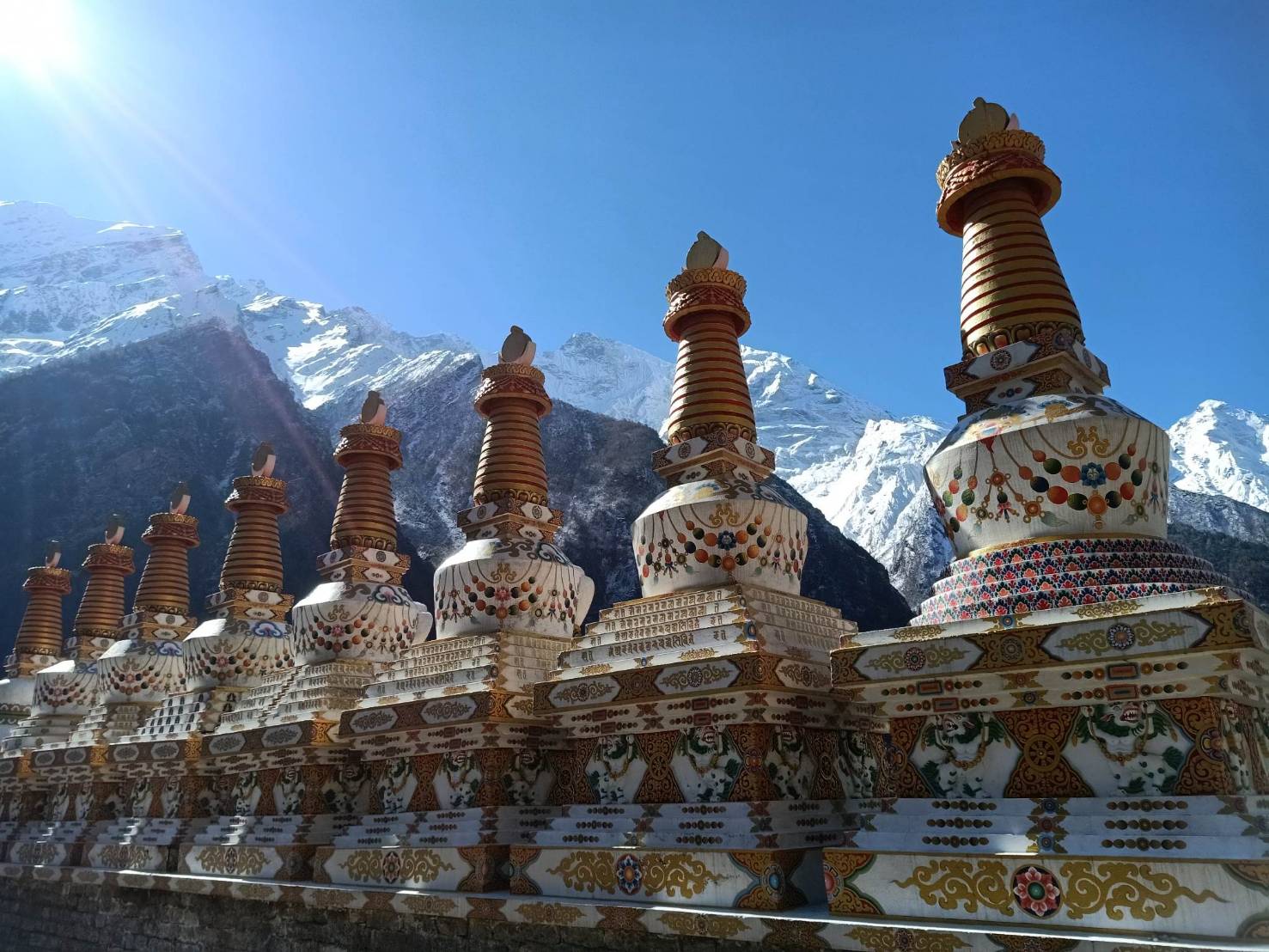
The Manaslu circuit is a renowned trekking route in the Himalayas, offering a unique and adventurous experience to trekkers. Situated in the western part of Nepal, the trek revolves around Mount Manaslu, the eighth-highest peak in the world. The region's remote and less-crowded trails provide an opportunity for trekkers to explore the pristine beauty of the Manaslu Conservation Area.
The trail takes trekkers through diverse landscapes, ranging from lush subtropical forests at lower elevations to rugged terrains and barren high-altitude areas as they ascend. The trek begins from Machha Khola, and as trekkers advance, they encounter several beautiful villages.
Crossing the Budi Gandaki River numerous times, the trail ascends through narrow gorges and leads to the Manaslu Base Camp (4400m.|14436ft.) and Birendra Lake (3691m.|12110ft.). Pun Gyen Gompa at 4800m.|15748ft. is also one of the highlights of this trek.
The terrain varies from steep ascents and descents to gentle rolling hills, challenging trekkers with its ruggedness and unpredictability. The most iconic part of the trek is the Larkya La pass, standing at an altitude of 5106m.|16751ft., offering breathtaking panoramic views of the surrounding peaks and glaciers.
Our carefully crafted Manaslu circuit trek itinerary takes into account the acclimatization needs of trekkers, allowing for a gradual ascent and proper rest days. Our experienced guides and porters will accompany you throughout the journey, ensuring your safety and providing valuable insights into the region's culture, history, and natural surroundings.
The Manaslu circuit trek is an opportunity to witness the raw beauty of the Himalayas away from the crowds. It is a chance to disconnect from the noise of modern life and immerse yourself in the serenity of nature. The trek challenges you physically and mentally, rewarding you with unforgettable memories and a sense of accomplishment as you conquer high mountain passes and overcome obstacles along the way.
We have multiple selections of trekking packages in the Manaslu region that you can check out here .
Best Manaslu circuit trek itinerary
Day 1: Arrival in Kathmandu (1400m.|4593ft.)
Day 2: Trek permit and preparation day (1400m.|4593ft.)
Day 3: Drive to Machha Khola (900m.|2953ft.)
Day 4: Trek to Jagat (1340m.|4396ft.)
Day 5: Trek to Deng via Phillim (1865m.|6102ft.)
Day 6: Deng to Namrung (2630m.|8626ft.)
Day 7: Namrung to Shyala (3500m.|11480ft.)
Day 8: Trek to Sama Gaon (3520m.|11549 ft.)
Day 9: Acclimatization Day in Sama Gaon
Day 10: Trek to Samdo (3875m.|12713ft.); with side trips
Day 11: Acclimatization Day in Samdo
Day 12: Trek to Dharamsala (4460m.|14633ft.)
Day 13: Trek to Bhimtang (3590m.|11775ft.) via Larkya La (5160m.|16751ft.)
Day 14: Trek to Dharapani (1930m.|6440ft.)
Day 15: Drive from Dharapani to Kathmandu (1400m.|4593ft.)
Day 16: Depart from Kathmandu
Discover the rich cultural heritage and natural beauty of the hidden Tsum Valley
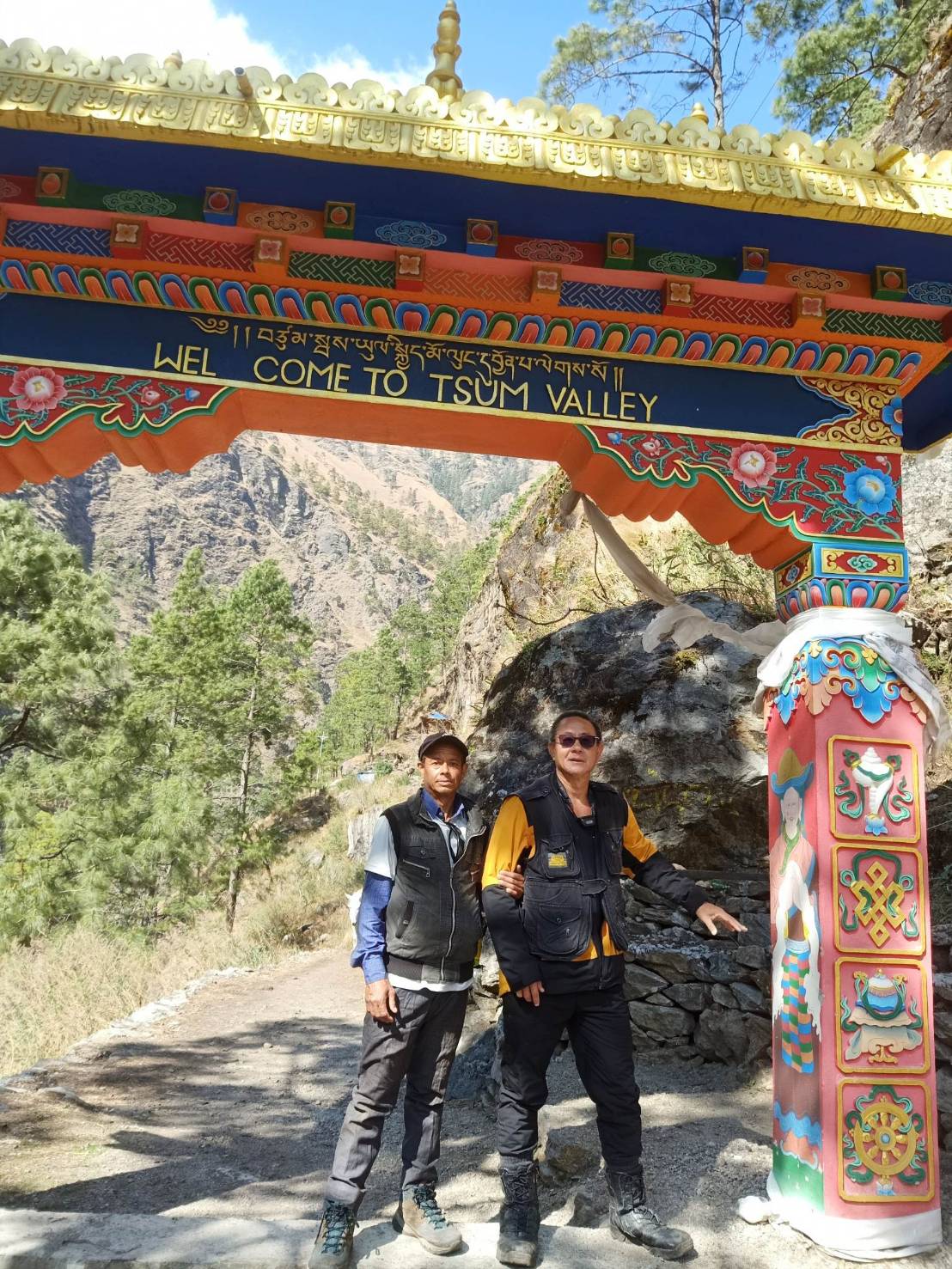
Tucked away in the lap of the majestic Himalayas, Tsum Valley was only opened in 2007 for foreign travelers. It is a hidden gem in the Manaslu region that offers a unique combination of rich cultural heritage and stunning natural beauty. The Tsum Valley is renowned for its ancient Buddhist monasteries, chortens (Buddhist shrines), and traditional villages that have preserved their norms and beliefs for centuries.
One of the highlights of the Tsum Valley is the Milarepa Piren Phu Cave (3361m.|11027ft.). It is believed that the revered Tibetan saint, Milarepa, meditated in this cave, leaving behind his footprints and handprints on the rocks. Pilgrims and trekkers visit this sacred site to pay their respects and soak in the spiritual atmosphere.
Tsum Valley is also home to several ancient monasteries, such as Rachen Gompa (3240m.|10630ft.) and Mu Gompa (3700m.|11026ft.), which serve as important religious and educational centers for the local community. These monasteries house intricate Buddhist murals, statues, and scriptures, offering visitors a glimpse into the region's rich religious and artistic heritage.
The natives of this valley are called Tsumbas. They are very friendly and welcoming. Their simple lifestyle and attachment to their ancestral roots will give you a fresh look at life. In villages like Chumling (2386m.|6692ft.), Chhokangparo (3010m.|9875ft.), Nile (3361m.|11026ft.), etc, you will get to interact with the locals and experience the mountain lifestyle.
Apart from its cultural significance, the Tsum Valley boasts breathtaking natural beauty. The valley is surrounded by soaring snow-capped peaks, including the Ganesh Himal and the Sringi Himal ranges. Trekking through the Tsum Valley rewards adventurers with surreal vistas of lush green valleys, cascading waterfalls, and terraced fields.
The region is blessed with diverse flora and fauna, making it a haven for nature enthusiasts. Rhododendron forests, oak groves, and alpine meadows dot the landscape. The valley is also home to rare and endangered wildlife species, such as the Himalayan tahr, snow leopard, and red panda, adding to its ecological significance.
For additional hikes, you can visit Gumba Lungdang (3200m.|10498ft.) and Ganesh Himal Base Camp (3691m.|12140ft.). You can combine the Tsum Valley excursion in our Manaslu circuit trek package or just trek to Tsum Valley as per your wish.
Conquer Larkya La Pass
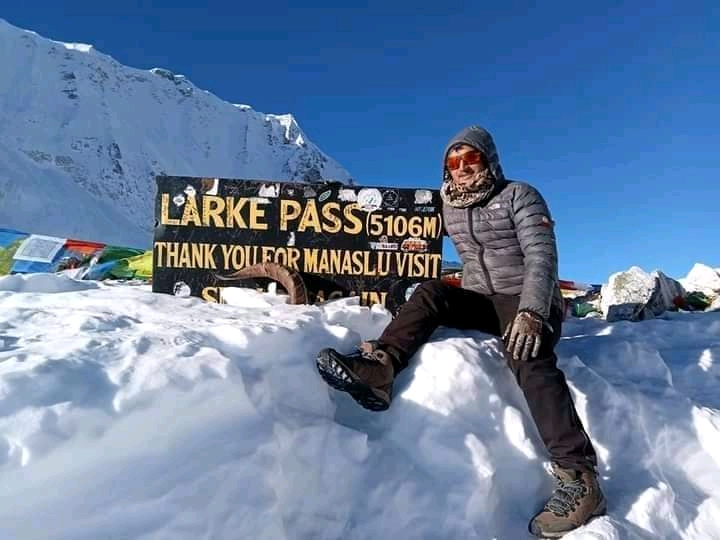
Larkya La pass is one of the highest mountain passes in Nepal, with a height of 5106m.|16752ft. above sea level. It is also the highest point during the Manaslu circuit trek. Navigating this pass is quite challenging and tests the endurance and determination of the trekkers. Below you can read more about what it takes to cross the Larkya La Pass, the views, terrain, etc.
The terrain and challenges:
Conquering Larkya La Pass requires physical fitness, mental strength, and the ability to acclimatize to the high altitude. The ascent to the pass involves a steady climb on a steep trail, navigating through rocky terrain and occasional snowy sections. Similarly, the thin air at such high altitudes adds to the physical challenge, making every step a test of endurance.
You have to pace yourself and listen to your body while trekking at these elevations. The mental fortitude to push through fatigue and overcome any doubts that may arise is equally important. Engage in pre-trek training and physical conditioning to build strength, endurance, and cardiovascular fitness. Likewise, mental resilience and determination are equally needed.
Adventurous descent:
While reaching the top of Larkya La pass is an accomplishment, the trek doesn't end there. The descent from the pass is equally thrilling and requires careful footing as you navigate the steep and sometimes icy trail. Trekking poles are incredibly helpful during the descent, providing stability and support.
As you make your way down, the landscape transforms, revealing a different facet of the Himalayas. The views of the Bimthang village, lush forests, and quaint villages in the distance provide a sense of tranquility and serenity amidst the exhilarating journey.
Unforgettable panoramas:
From the top of the pass, you get to see breathtaking panoramic views of the surrounding Himalayan peaks, including Mt. Manaslu (8163m.|26781ft.), Mt. Dhaulagiri (8167m.|26795ft.), Mt. Hiunchuli (6441m.|21132ft.), Mt. Annapurna (8091m.|26545ft.), and Ganesh Himal (7422m.|24350ft.). among others. The vastness of the mountain ranges, the play of light and shadow on the snow-capped summits, and the varying landscapes throughout the journey are mesmerizing.
Personal growth and reflection:
Conquering Larkya La Pass goes beyond physical challenges. It offers trekkers an opportunity for personal growth and reflection. The demanding nature of the trek pushes you to your limits, teaching valuable lessons in perseverance, resilience, and self-belief. The isolation of the Himalayas, coupled with the vastness of the landscape, provides a space for introspection and self-discovery. The sense of accomplishment and the memories made during this journey will stay with you long after you've returned from the trail.
Cultural significance
Beyond its physical grandeur, Larkya La Pass also holds cultural significance. It has been a traditional trading route between Nepal and Tibet for centuries, connecting the rich cultural heritage of these two Himalayan regions. As trekkers traverse the pass, they follow in the footsteps of ancient traders and nomads, experiencing a glimpse of the historical and cultural exchange that has shaped this region.
Teahouse Accommodations
Tea houses are not like lodges in the Everest base camp or Annapurna base camp trails. Neither is it like the guesthouses of Langtang region trails. Teahouses offer a perfect balance between lodges and guesthouses. The remotest parts of the Himalayas in Nepal, which were only accessible because of camping treks, now teahouses make some of those trails, including the Manaslu circuit and Tsum Valley, more approachable.
Thanks to the recent popularity of the Manaslu circuit trek, the trail has seen many new teahouses that serve as the primary accommodation for the trekkers. In less commercial and remote regions like Manaslu, the convenience of teahouse accommodations make the trail much more accessible and an enjoyable experience for trekkers.
Teahouses are basic but comfortable accommodations available along the Manaslu circuit trek route. These are typically run by local families and provide trekkers with a warm and welcoming environment to rest and rejuvenate after a day of hiking. The teahouses vary in size and facilities, ranging from cozy rooms with shared bathrooms to more spacious rooms with attached bathrooms.
While the amenities may not be luxurious, they offer all the essentials needed for a comfortable stay in the mountains. You will get clean bedding, blankets, and sometimes hot showers, which can be a true luxury at higher altitudes. Remember that the services may decrease as you ascend to more remote areas, so be prepared for furthermore basic facilities at the higher points of the trek.
*Note: Carry a high-quality sleeping bag during the Manaslu trek for an additional layer of warmth. Thamel has plenty of sleeping bag rental services, so you do not have to buy.
Simple Nourishing Meals
One of the highlights of trekking in Nepal is the delicious and hearty meals served in tea houses along the trail. Despite the remoteness of the Manaslu circuit trek, you'll be pleasantly surprised by the range of food options available, considering the limited resources in the mountains.
Teahouse meals typically consist of a combination of Nepali and international dishes. You'll find staples like dal bhat, momo, thukpa, noodles, pasta, & fried rice, along with porridge, soups, curries, chapati, sandwich, mashed potatoes, Tibetan bread, etc. These meals provide a good balance of carbohydrates, proteins, and essential nutrients to fuel your body for the challenging trek. Tea, coffee, soft drinks, etc, are common beverages.
Teahouses are accustomed to catering to trekkers with different dietary preferences and restrictions. However, note that the further you trek into remote areas, the more limited the menu options may become. It's wise to carry some energy bars or snacks as a backup for additional sustenance during long days of hiking.
Likewise, staying hydrated is crucial during any trek, especially in high-altitude regions. Most teahouses offer boiled water for a nominal fee, allowing you to refill your water bottles or hydration systems. Carrying water purification tablets is also recommended to ensure the safety of drinking water obtained from natural sources along the trail.
- Altitude Sickness
- Trekking Tips
- Mountain Guide
- Himalaya Trails
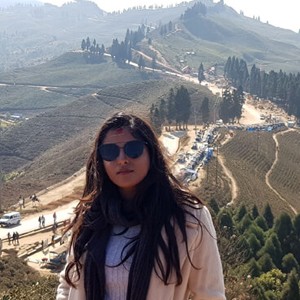
Benjila Dhital
Benjila has been an integral part of the Nepal Nirvana Trails as she writes passionately and learns about new spots, people, cultures, and languages. With a Bachelor's Degree from the reputed college NATHM in Bachelors of Tourism and Travel Management lately, she has been engaging in authoring web content and familiarizing new locations with the tourist out there.
Drop a message
Recent posts.
- Can you trek to Everest Base Camp in April?
- Trekking in Nepal in March 2024
- Unveiling the Hidden Gems of Kanchenjunga: Trekking Guide for Adventure Enthusiasts
- Best Time For Manaslu Circuit Trek
- Family-Friendly Trekking in the Annapurna Region: Creating Lasting Memories with Loved Ones
- Langtang Valley Trek: A Serene Himalayan Escape for Nature Lovers
Related Posts
- Langtang Trek Packing List
Travel Guides
- Annapurna Region Trek Guide
- Everest Three Passes Trek Guide
- Kanchenjunga Trek Guide
- Langtang Region Trek Guide
- Manaslu Region Trek Guide
- Nepal Travel Info
- Things to Do
- Travel Blog

Are you looking for the Nepal holiday? or need help to plan a trip, please do not hesitate to get in touch with us.
We use cookies to ensure that we give you the best experience on our website.
We offer excellent, independent, and inspiring service and advice for an amazing trip experience in Manaslu Circuit Trek. Feel easy to chat.
Manaslu Circuit Trek – A Complete Guide
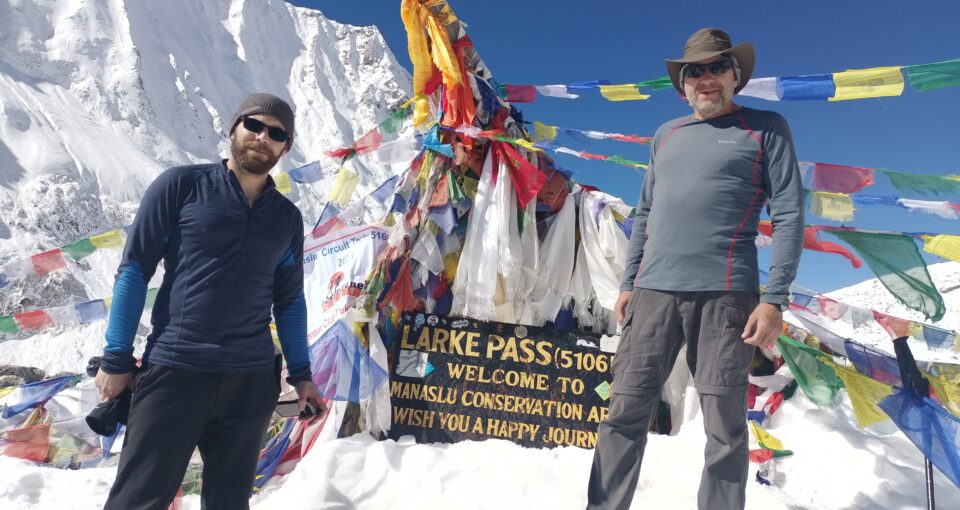
Manaslu Circuit Trek is the best for its unique culture, Buddhism, and teahouse trail which crosses Larkya La Pass 5106 m while simultaneously reaching the world’s 8th highest mountain – Mt. Manaslu (8163m) . The 12 Days Manaslu Circuit Trek is one of the most enthralling best seller trekking trails in Nepal just after EBC and ABC Trek .
Manaslu is a popular remote area located in the central west part of the Himalayas in Nepal. It reckons in the sub-tropical Himalayan foothill to dried Trans-Himalaya high meadow bordering Tibet, China. The elevation of its sub-tropical zone varies from 1000 meters to 2000 meters; whereas the sub-alpine zone ranges from 3000 meters to 4000 meters. Its zone above 4500 meters is called an arctic zone.
Mt Manaslu (8163m) is the main attraction of the Manaslu region which is the 8th highest mountain in the world. Besides Mt Manaslu (8163 m) , Ngadi Chuli (7871m), Himalchuli (7893m) , and Siringi Himal (7187m) are also major peaks located in this region, which are bordered on the east by Budhigandaki river and Ganesh Himal, on the west, the gorge of Marshyangdi and Annapurna Massif.
Table of Content [Collapse/Expand]
- Why to trek in Manaslu
- Detailed Itinerary
- Around Manaslu Trek at a Glance
- Around Manaslu Trek Trails and Routes
- Best Time to trek to Manaslu
- Accommodation in Around Manaslu Trek
- Around Manaslu Trek Difficulty
- Trekking Insurance
- Packing List for Manaslu Trek
- Manaslu Permit
- Communication Medium in Manaslu
- Visa Information
Manaslu Circuit Trek At a Glance
- A teahouse trek
- Best season to trek – Sept to Nov and March to May
- One of the less crowded trail
- The optimal shortest trail circuit is 178 km. However, it may vary on the exact route from where you start your trek.
- Highest point – Larkya La 5106m
- Close Resemblance of Tibetan Culture
- Explore the Gompas & Monastery
- Magnificent view of Mt Manaslu 8163m and its neighboring peaks
- Opened for trekking in 1991 but gain popularity since 2010 because of the teahouses built in the circuit.
- On-going road construction
Why trek in Manaslu Circuit
Manaslu Circuit Trek has all the elements and even more than other trekking regions of Nepal as it portrays the Buddhist culture , wildlife habitats, raging rivers with suspension bridges, greenery of the forest, and the remarkable necklace view of mountains. Manaslu Conservation Area which resides in Manaslu Region covers 1663 square kilometers. It was declared as a conservation area in 1998 since it is the home of many endangered animals, including red pandas, snow leopards, Himalayan tahr, Asian black bears, Himalayan musk deer, blue sheep, etc. More than 110 bird species, 35 mammals, and 3 reptiles live in this area. In addition, Himalayan honey bees whose scientific name is Apis Laboriosa, who is responsible to produce Mad Honey and best known for world’s largest honey bee is also found in the Manaslu region.
Nubri, Tsum, Bhutias, and Gurung ethnicities are the major inhabitants of Manaslu who have been living here for more than 700 years. Especially, Gurung is inhabited on the central hill of Manaslu, whereas, Nubri and Tsum live in Tsum Valley and are closer to the Tibet border. That is why their culture closely resembles Tibetan culture . A major number of people in this region follow Buddhism.
Before 1991, foreigners were not allowed to visit the Manaslu region. Now, it is a popular tea-house trekking route in Nepal. However, some of its areas still belong to a restricted or controlled zone. It literally means that foreigners cannot visit this place without special permits .
Detailed Itinerary of Manaslu Circuit Trek
Day 01 kathmandu to soti khola (720 m / 2,362 feet).
Manaslu Circuit Trek begins from Kathmandu offering scenic greenery views of the Hilly region of Nepal following the bank of Trishuli River until reaching Benighat, then moving toward Aarughat and finally Soti Khola. It takes an entire day to reach Soti Khola.
Day 02 Soti Khola to Machha Khola (900m / 2,920feet)
On the second day, you will find the true meaning of the trek as we start the trek from Soti Khola to Machha Khola. The journey will bless you with beautiful green forests, terrain rice fields, steep ridges, and a few suspension bridges.
Day 03 Machha Khola to Jagat (1370m / 4494feet)
After beginning the wonderful trek to Machha Khola, the trek then moves toward Jagat village leaving behind Tatopani and Dobhan villages. In between Machha Khola and Dobhan, there is a traditional Gurung village called Khorla Besi. On reaching Tatopani i.e hot water, you can take a warm bath and relax for a while. The trek continues following the bank of the Budhigandaki River and crosses a suspension bridge just to arrive at Dobhan. The Nepali meaning of Dobhan is the interflow of two rivers. Following the waves, you can see the river getting flattened at Yaru village where you need to cross a long cantilever suspension bridge to reach Jagat. Jagat – a Gurung village where you will see a checkpoint to verify the entry permits of the trekkers. From today, you are entering the restricted area.
Day 04 Jagat to Deng (1,804m / 5920 feet)
The very next day, the trek ascends to Salleri and descends to Sirdibas. Then the valley widens and reaches the Ghatte Khola River. Meanwhile, you will be blessed with several prayer flags and gompas. There are some stop points where you can get local alcohol to try. However, it’s all up to you whether you want to try it or not. On the trail, you will encounter beautiful rhododendron forests, hanging cliffs, and towering peaks which are the highlights of the trail.
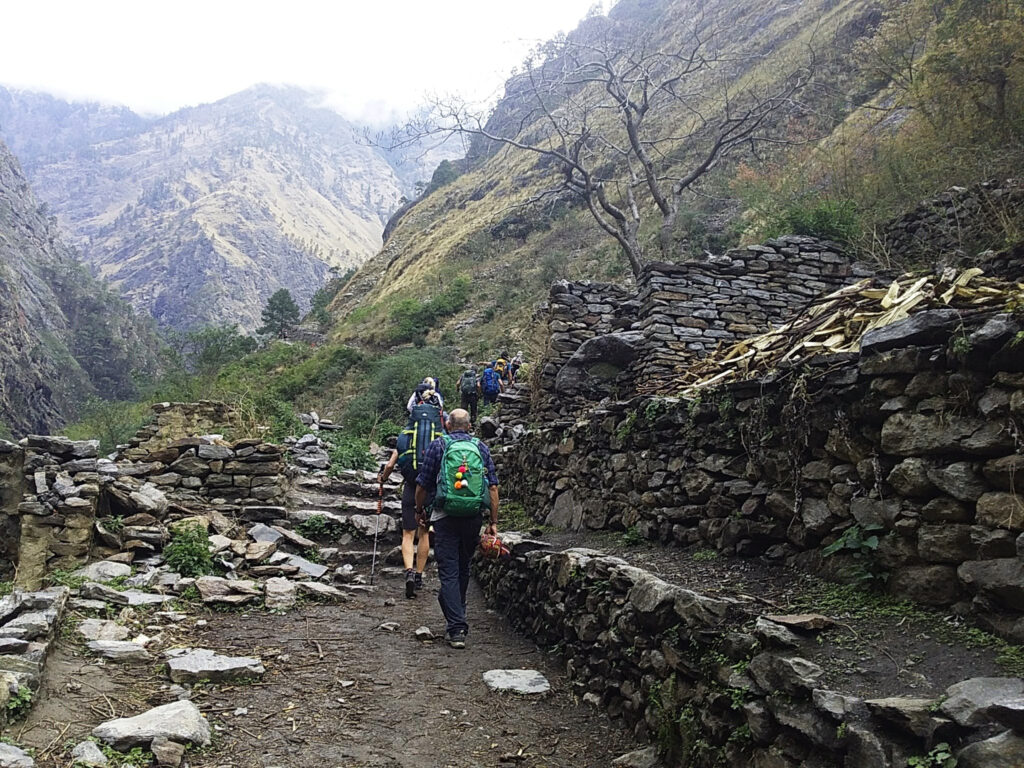
The trail continues walking upstream to a suspension bridge and reaches Philim – a Gurung village, and crosses the millet fields to the village of Ekle Bhatti. After a few minutes’ walk, the trail makes an entry to grassy slopes and crosses the Budhi Gandaki River. After that, trekking along the west bank for a while and crossing the east bank, you then return to the west side to follow the trail. Now, the trail widens and you pass through bamboo forests to Deng Khola and reach Deng village.
Day 05 Deng to Namrung (2,630m / 8628feet)
After having breakfast in Deng, you then further start your trek. This is one of the important days of the trek which you will be experiencing. First, cross a suspension bridge over the Budhi Gandaki River, and climb a ridge of Rana and Bihi Phedi. Now you will be passing through Lush forests and ethnic communities of the Manaslu region. Meanwhile, some beautiful peaks begin to appear in distance.
Today, you will be heading toward Prok which is a beautiful vintage point for the astounding view of snowcapped Siringi Mountain. Along the way, you will pass through several Gompas and crosses the Budhi Gandaki River. And the trail follows dense forests which reside inside the Manaslu Conservation Area, then you take a last steep climb to reach Namrung village.
Day 06 Namrung to Samagaon (3,530m / 11581 feet)
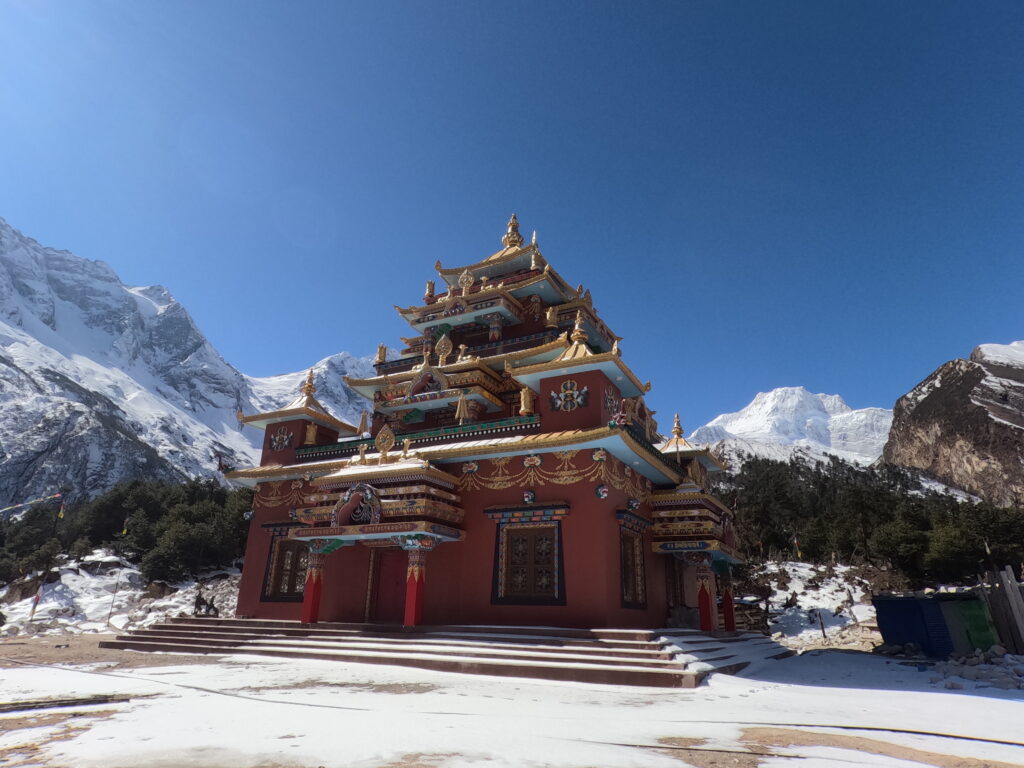
Today in the morning after having breakfast, you may like to walk around Namrung and get the best view of Siringi Himal, Ganesh Himal, and Himchuli. After that, you will pass through a few beautiful small villages like Lhi. Lhi is a beautiful small village having many stupas and barley terraces. In this area, you will get to witness the lifestyles of the Nubri people and explore the Tibetan lifestyle and cultures while passing through several mani walls, and lush terraces before entering Fir. You then encounter rhododendron and oak forest in between Lhi, Sho, and Shyala villages before reaching Samagaon. You will notice the amazing scenery of Mt Manaslu from Lho.
Day 07 Rest in Samagaon (Or take a hike)
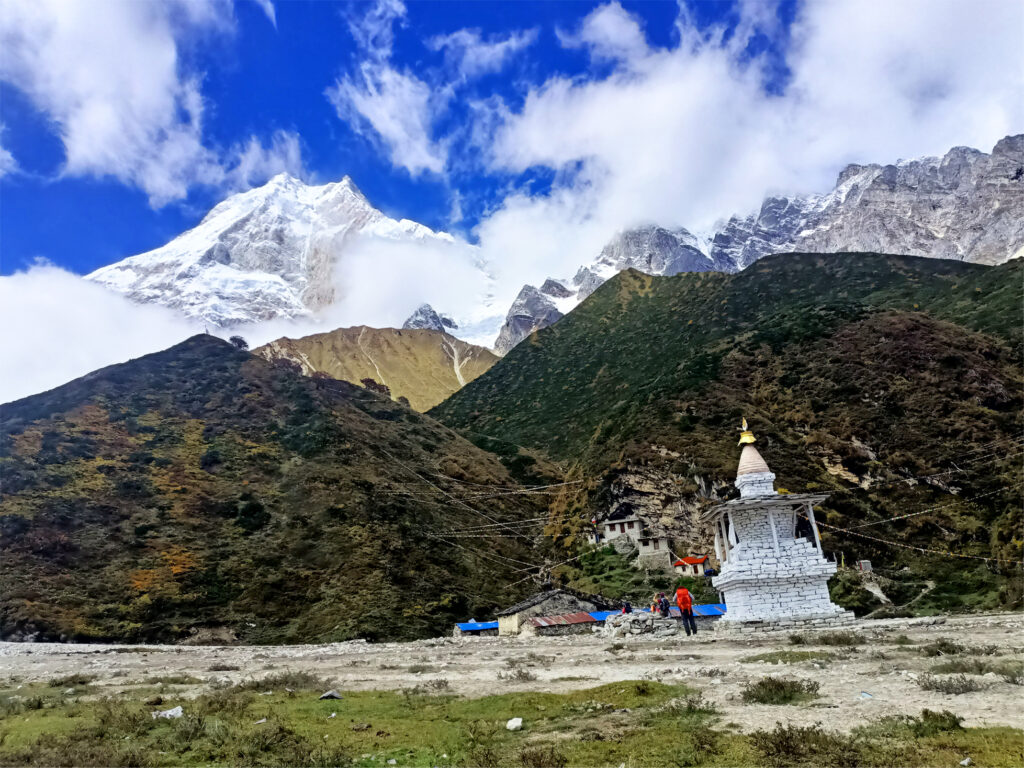
- Acclimatization day
- Have a refreshing breakfast and spend the day around Samagaon
- You can take a small hike on a little hill near Sama Village where you will find an old gompa called Pungyen Gompa while you may explore Sherpa culture and witness thousands of mani stones with a Buddhist text.
Day 08 Samagaon to Samdo (3,875m / 12713 feet)
- Descend to the Budhi Gandaki river and follow the bridge over the side stream
- Pass through several mani walls and get an amazing view of the mountain
- Get closer to the Tibetan border
- After reaching Samdo, explore nearby villages and hike to Samdo Peak. You can find the Larkya trail on the left side above the valley
Day 09 Samdo to Dharmasala (4,460m / 14632 feet)
- Climb to reach Dharmasala – an adventurous day
- Enjoy the scenic view of the Himalayan range while walking through a rugged trail.
Day 10 Dharmasala to Bhimtang (3590m / 11778 feet) via Larkya La (5160 m / 16929 feet)
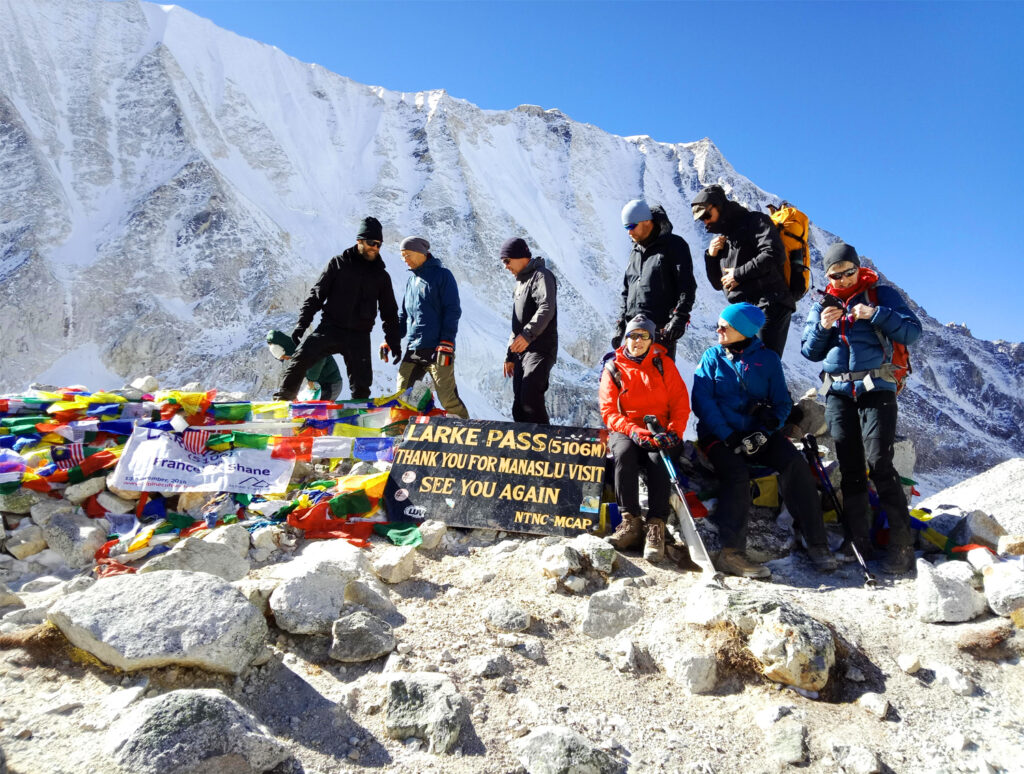
- Today is the special day of the trek – a challenging part of the trek
- Crosses Larkya La Pass steadily – the highest altitude of the trek before the afternoon
- Spend special time at the pass and get enjoyed the view of Himlung, Kang Guru, and Annapurna II
- And down toward Bimthang, it takes around 3 hours
Day 11 Bhimtang to Dharapani
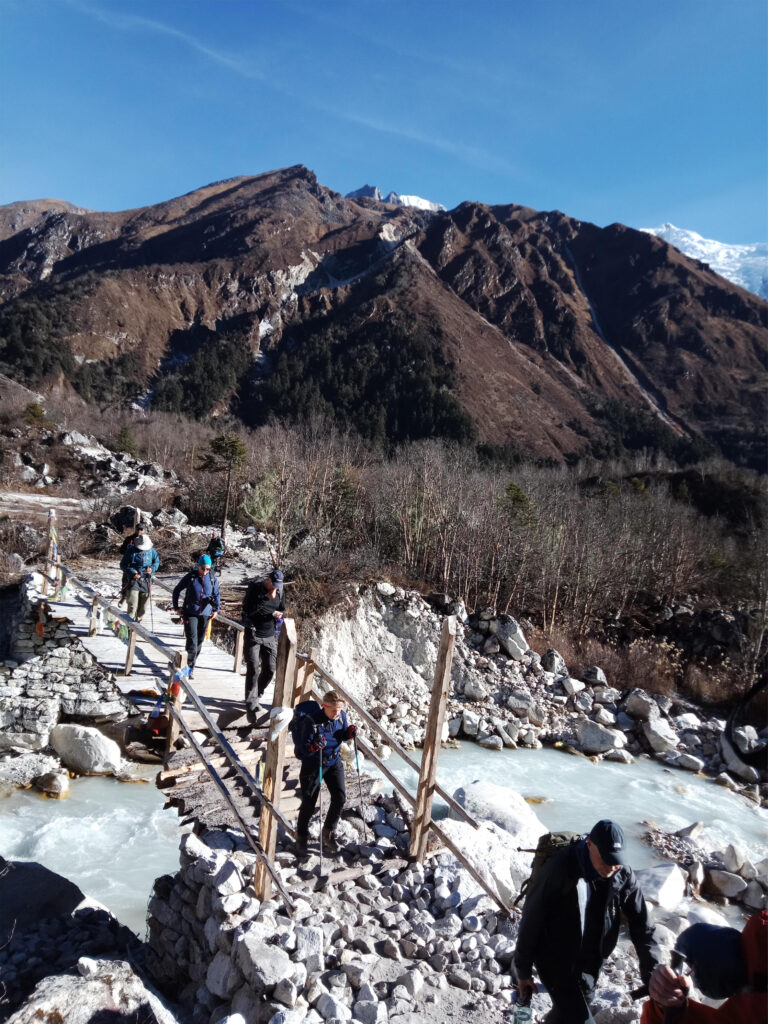
- Descend through pine and rhododendron forests, passing through several small settlements.
- Enjoy views of the Lamjung Himal and cross a river before reaching the village of Tilije.
- Overnight stay in Tilije.
- Continue descending through villages and terraced fields.
- Pass through the village of Thonje and cross a bridge to enter the Annapurna region.
- Reach Dharapani, where you’ll join the Annapurna Circuit trail.
- Overnight stay in Dharapani.
Day 12 Dharapani to Kathmandu
- Take a shared jeep or bus from Dharapani back to Kathmandu (approximately 7-8 hours).
- Arrive in Kathmandu and transfer to your hotel.
- Spend the evening relaxing and celebrating the completion of your trek.
Order a trek quote in your inbox
Manaslu circuit trek routes.
Trekking in Manaslu offers a remarkable experience for every adventurer as it passes through the 8th highest Mountain Manaslu (8163m). It combines the amazing mountain ranges with diverse flora and fauna along with rich cultural and archaeological sites. Around Manaslu Trek often called Manaslu Circuit Trek is one of the most popular treks which encircles Mt. Manaslu. During the trek, trekkers are gifted with a wide variety of stunning mountain sceneries as well as Tibetan origin culture.
Concerning Manaslu’s historical and cultural aspects, the government has issued a special permit for foreigners to visit this area. Foreigners must issue permits from the Department of Ministry. Mainly, Autumn and Spring are the best seasons and busiest times in Nepal. So booking the Manaslu trek earlier means securing a place on tour in Manaslu.
If you are interested in doing Manaslu Circuit Trek, check out the below itineraries.
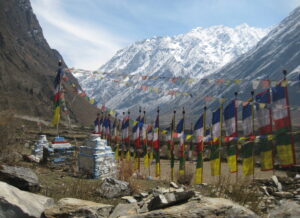
Tsum Valley Trek
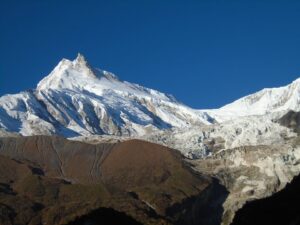
Manaslu Circuit with Tsum Valley Trek
Best time to trek manaslu circuit.
Apparently, there are two seasons for adventure in subtropical Nepal Himalayas – A dry season of winter begins around late August and ends at end of November, and a wet warmer season starts in early March and ends at end of May.
In fact, the most popular time to trek in Manaslu is Autumn (September to November) and Spring (March to May) . That is why trails become busy in these seasons. However, Manaslu is open for trekking. Even trekkers leave for trekking to Manaslu in winter (December to February) and summer (June to August). To be true, if you want to avoid crowds, winter and summer can also be the best time for you. Winter of Nepal is not like the winter of Canada and many European countries where the winter season is really a harsh one.
Nepal is diversified into 3 different geographical regions – Mountain, Hilly, and Plain regions. It causes variations in the temperature of Nepal in different places. But your trek begins in the Hilly region, goes through the Mountain region, and comes back to the Hilly region. Basically, the temperature in trekking zones tends to be average throughout the year, with an average high between 24 to 30 degrees Celsius and average lows of 12 to 1 degrees Celsius .
Click the article best time to trek in Nepal for the detail information regarding it.
Food and Accommodation in Manaslu Circuit Trek
While trekking the Manaslu Circuit, you will primarily be served Dal Bhat Tarkari, a typical Nepali meal, for lunch and dinner. The food options are somewhat limited compared to the more frequented Everest Region due to fewer teahouses and a smaller variety of available dishes. For breakfast, you can expect to find options such as Tibetan bread served with honey or jam, porridge with local honey, or eggs prepared to your liking (boiled, fried, or scrambled) accompanied by chapati or toast. Lunch often mirrors dinner with Dal Bhat being a common staple, but you may also find noodle soups like Thukpa, which are particularly comforting in cooler weather. Despite the limitations, the meals provided are nourishing and fitting for the trekking experience, ensuring you have the energy needed to explore this beautiful region. To get detailed information, click the article Manaslu Circuit Trek Food .
As you arrive in Kathmandu, you will be welcomed and picked up, then transferred to a Hotel if you order airport pick-up service. You stay in a hotel in Kathmandu. Several types of hotels can be found in Kathmandu. 5-star levels to homestay are available to stay overnight. However, we normally provide a 3-star level hotel with breakfast included . Each member will get a separate room. While you are trekking, you are provided tea house accommodation as there is no luxurious hotel or lodges in the Manaslu region. So the trek is also called a tea house trek . In fact, you can not find a deluxe hotel in the Nepal Himalayas.
Manaslu Circuit Trek Difficulty (Altitude Sickness, Acclimatization, and Training)
All trekking routes of Manaslu reach up to 5106 meters in altitude i.e Larkya La Pass. So it can cause altitude sickness to trekkers. While you are crossing Larkya La Pass, you may encounter altitude sickness. So, before you embark on your Manaslu trek, you should understand its symptoms and also should have knowledge of the process of acclimatization. And note that all the trekking in Manaslu is moderate but quite strenuous. Nevertheless, a trekker, aged between 58 – 65 years can also successfully complete this trek if s/he takes proper acclimatization during the trek. For detailed information, check out the Manaslu circuit trek difficulty .
Travel and Trekking Insurance for Manaslu Circuit Trek
Travel and Trekking insurance is mandatory for Manaslu Circuit Trek . Most of the trekking operators ask you to have proper travel and trekking insurance, although the risk of injury in Manaslu is relatively low. If something, unfortunately, goes wrong, you will need substantial insurance to cover your medical charges and any emergency evacuation costs.
It is important that your insurance must cover a maximum altitude of up to 6000 m. By the way, high altitude is not a standard policy on travel insurance ; it must be added separately. For more detail about travel insurance click here.
Manaslu Circuit Trek – Packing lists
The packing list for Manaslu Circuit Trek differs in different seasons, which includes some important items. Some of the items can be rented. But we suggest some personal things that you should bring with you to Nepal. Find a complete packing list for Manaslu Trek here .
Necessary Permit for Manaslu Circuit Trek
Foreigners need 3 different permits to trek. Moreover, it needs a special restricted permit, which requires at least 2 trekkers and a local guide to acquire.
For more detail about the Manaslu permit, go here .
Communication Medium in Manaslu Circuit Trek
Now Internet WiFi service is available in most of the teahouses. You also can get SAT phone to communicate with your friends and families paying a certain amount of charge. But local telephone hardly works in this region. Mobile networks (NTC and NCELL) do also provide coverage in this region.
Manaslu Trek Map
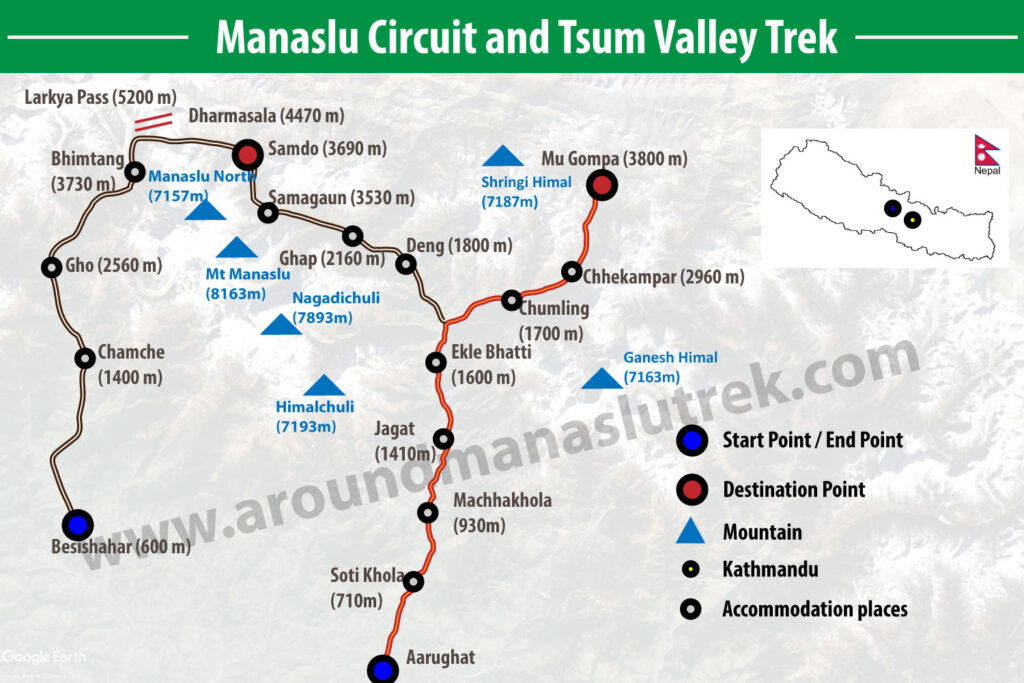
Tourist Visa Information for Manaslu Circuit Trek
All foreigners except Indian nationals require a visa to visit Nepal. Citizens of some countries like SAARC (South Asian Association for Regional Cooperation) countries and China do get free visas upon arrival in Nepal. However, the rest of the world’s people must issue visas to enter Nepal. You can easily get an arrival visa at Tribhuvan International Airport. You just require to have a passport with at least 6 months validity, a PP-size photo, and a visa fee, then you will get the visa in Nepal. As of now, the visa fee is $50 USD for 30 days which you can pay in cash.
There are a few countries like Ghana, Zimbabwe, Nigeria, Cameroon, Swaziland, Somalia, Liberia, Ethiopia, Iraq, Palestine, and Afghanistan; the citizen of these countries do not receive an on-arrival visa. They have to contact the embassy of Nepal or the nearest consulate.
FAQs of the Manaslu Circuit Trek
How much does manaslu circuit trek cost.
To get detailed information about it, look at our article titled Manaslu Circuit Trek cost .
Can I trek to Manaslu without a guide and porter?
No, you can’t trek to Manaslu without a guide but without a porter it is possible. As per the rule of the government of Nepal in order to visit a restricted area, one should have a special permit. So, you need to issue a special permit to trek to Manaslu, whereas a special permit can not be issued without a guide. Hence, foreigners can not visit Manaslu without a guide.
How far is Manaslu from Kathmandu?
The trekking point of Manaslu is nearly 126 km far from the capital Kathmandu. However, it is about 123 km of aerial distance from Kathmandu valley.
How do I reach Manaslu from Kathmandu?
You either choose a local bus or a private vehicle to reach Manaslu. There is no fly route or waterways to reach Manaslu. It takes around 8 hrs to get there by local or private vehicle.
Where is Manaslu located?
Manaslu is located northwest of Kathmandu bordered by the Annapurna region in the west and Langtang Ganesh Himal in the east.
Is Manaslu Circuit Trek better than Annapurna Circuit Trek?
Indeed, both are separate trails! Annapurna Circuit comes with a fantastic landscape and view of spectacular high mountains encircling Mt Annapurna while Manaslu Circuit offers Tibetan-like culture and tradition along with a beautiful view of Mt Manaslu, Ganesh Himal, Buddha Himal, and more. Annapurna Circuit Trek is not as same as it was before because of the road construction. However, it has shortened the trekking duration. Now, you can directly drive to Manang Village via Jeep but the road is too dangerous and muddy. On the other hand, Manaslu Circuit Trek Trail is intact though there is ongoing road construction. It is still considered to be an off-the-beaten-track as it is a less visited region in comparison to the other areas.

How is the climate in the Manaslu region?
Manaslu region covers both subtropical to tundra climates ranging from a hilly area to a high mountain area. So, 10 to 25 degree Celsius temperature could be expected throughout the year while it may fall to -22 degree Celsius and below in the upper parts of the Himalayas.
Is Manaslu Helicopter Tour possible like Everest Base Camp Helicopter Tour?
Of course, it is possible and open to fly to Manaslu by Helicopter. Manalsu Helicopter Tour is for those travelers who want to take the advantage of exploring most of the areas of the Manaslu region in a short amount of time. This tour is optimal for those who are physically unable to trek to Manaslu Circuit. It offers marvelous views of mountains from a close distance.
Is natural water drinkable on the Manaslu Circuit Trek?
Basically, the flowing water of the mountain area seems to be very clear. However, we don’t suggest you drink tap water or any water from natural streams. The only way to make it drinkable is by using a water purifier or boiling it.
What is the highest altitude of the Manaslu Circuit Trek?
Larkya La Pass is the highest point of this trek which is elevated at 5106 m above sea level.
Should I choose Tsum Valley or only go to Manaslu Circuit Trek?
Tsum Valley is a distinct valley because of its culture and traditions. The tradition and culture of Tsum valley is similar to the Tibet. In addition, polyandry system still exists in this valley. So, if you want to explore its culture tradition and the beauty of nature, then you can add Tsum valley in your bucket list if you are planning to trek Manaslu.
Is it possible to comeback to Kathmandu by Helicopter from Manaslu Base Camp?
Of course, it is possible to fly back to Kathmandu by Helicopter from the base camp of Manaslu. However, you need to inform us 2 days earlier to manage the helicopter or the itinerary plan should be made before the trip starts.
Is Larkya Pass difficult for beginner trekkers?
Larkya Pass is situated at an altitude of over 5106m above sea level, making it a delightful pass located in the Manaslu region. The pass is not too high, so trekking in the spring and autumn seasons may not be too challenging. However, if you wish to cross this pass in the winter season, it can be difficult because it may be covered with a full layer of snow at that time. The well-trained team of Around Manaslu Trek will ensure your trek is comfortable and successful while you are exploring the Manaslu region.
Which peak is the highest mountain in the Manalsu region?
Mt. Manaslu, standing at 8163m, is the highest peak in the Manaslu region and the 8th highest mountain in the world.
Does credit card work in Manaslu region?
There is no access to credit cards in the region because it is so rural, despite its proximity to the capital, Kathmandu. You will not find any ATMs or POS services in the Manaslu region. Therefore, you should withdraw the required cash from Kathmandu before starting the trek
Do you customize the Manaslu Circuit Trek?
Yes, we do customize the Manaslu Circuit Trek. Although we have a fixed departure dates for a generic itinerary of 12 days Manaslu Circui Trek, we are also flexible to customize the trip as your budget, plans, and schedules.
Why to trek Manaslu Circuit Trek with us?
Choosing the right trekking company can significantly enhance your Manaslu Circuit trek experience. Here are compelling reasons to consider trekking the Manaslu Circuit with us:
Expert Local Guides
Our team comprises experienced local guides who are not only well-versed in navigating the Manaslu Circuit but are also deeply familiar with the local culture, history, and environment. Their expertise ensures you have a safe, informative, and enriching trekking experience.
Tailored Itineraries
We understand that every trekker has unique needs and preferences. That’s why we offer customizable itineraries that can be adjusted to match your fitness level, interests, and time constraints, ensuring you get the most out of your Manaslu trek.
Small Group Sizes
To enhance your trekking experience and ensure personalized attention, we maintain small group sizes. This approach fosters a closer group dynamic, allows for more interaction with your guide, and minimizes our impact on the environment and local communities.
Sustainable Trekking Practices
We are committed to sustainable tourism practices that protect the environment and contribute positively to local communities. By trekking with us, you’re supporting eco-friendly practices and helping promote economic benefits for the local people.
Comprehensive Support
From the moment you book your trek to the day you complete your journey, our team provides comprehensive support. This includes pre-trek preparation advice, assistance with obtaining necessary permits, and ensuring you have the right gear and information for a successful trek.
Safety First
Your safety is our top priority. Our guides are trained in first aid and emergency response, and we conduct our treks with the utmost care, including regular weather and trail condition checks. We also ensure that our treks are conducted in accordance with the latest safety standards and protocols.
Cultural Immersion
Our treks are designed not just as physical journeys but as cultural experiences. We provide opportunities to interact with local communities, participate in traditional customs, and learn about the rich cultural heritage of the Manaslu region, offering a deeper connection to the places you visit.
Quality Equipment and Accommodations
We provide high-quality camping equipment for treks that require it and select the best available teahouses for your comfort. Our aim is to ensure that your nights are as enjoyable and comfortable as your days on the trail.
Competitive Pricing
We offer competitive pricing without compromising on the quality of our services. Our packages are all-inclusive, covering permits, accommodation, meals on the trek, and transportation, ensuring you get great value for your investment.
Choosing to trek the Manaslu Circuit with us means commencing on an unforgettable journey that is safe, enjoyable, and deeply connected to the natural beauty and cultural richness of the Himalayas. Our commitment to excellence, sustainability, and the well-being of our clients makes us the ideal partner for your Himalayan adventure.
culture et la tradition
- Community Homestay
- bisket jatra
- Newar festivals
- Pink tourism
- À propos de nous
- E-magazines
The best of Inside Himalayas delivered straight to your inbox. Sign up for the latest stories.
Veuillez laisser ce champ vide.
Get the latest edition of Inside Himalayas on your doorstep.
Select Country Afghanistan Albania Algeria Andorra Angola Antigua and Barbuda Argentina Armenia Australia Austria Azerbaijan Bahamas Bahrain Bangladesh Barbados Belarus Belgium Belize Benin Bhutan Bolivia Bosnia and Herzegovina Botswana Brazil Brunei Bulgaria Burkina Faso Burundi Cabo Verde Cambodia Cameroon Canada Central African Republic (CAR) Chad Chile China Colombia Comoros Congo, Democratic Republic of the Congo, Republic of the Costa Rica Cote d'Ivoire Croatia Cuba Cyprus Czechia Denmark Djibouti Dominica Dominican Republic Ecuador Egypt El Salvador Equatorial Guinea Eritrea Estonia Eswatini (formerly Swaziland) Ethiopia Fiji Finland France Gabon Gambia Georgia Germany Ghana Greece Grenada Guatemala Guinea Guinea-Bissau Guyana Haiti Honduras Hungary Iceland India Indonesia Iran Iraq Ireland Israel Italy Jamaica Japan Jordan Kazakhstan Kenya Kiribati Kosovo Kuwait Kyrgyzstan Laos Latvia Lebanon Lesotho Liberia Libya Liechtenstein Lithuania Luxembourg Madagascar Malawi Malaysia Maldives Mali Malta Marshall Islands Mauritania Mauritius Mexico Micronesia Moldova Monaco Mongolia Montenegro Morocco Mozambique Myanmar (formerly Burma) Namibia Nauru Nepal Netherlands New Zealand Nicaragua Niger Nigeria North Korea North Macedonia (formerly Macedonia) Norway Oman Pakistan Palau Palestine Panama Papua New Guinea Paraguay Peru Philippines Poland Portugal Qatar Romania Russia Rwanda Saint Kitts and Nevis Saint Lucia Saint Vincent and the Grenadines Samoa San Marino Sao Tome and Principe Saudi Arabia Senegal Serbia Seychelles Sierra Leone Singapore Slovakia Slovenia Solomon Islands Somalia South Africa South Korea South Sudan Spain Sri Lanka Sudan Suriname Sweden Switzerland Syria Taiwan Tajikistan Tanzania Thailand Timor-Leste Togo Tonga Trinidad and Tobago Tunisia Turkey Turkmenistan Tuvalu Uganda Ukraine United Arab Emirates (UAE) United Kingdom (UK) United States of America (USA) Uruguay Uzbekistan Vanuatu Vatican City (Holy See) Venezuela Vietnam Yemen Zambia Zimbabwe
- 16 juin, 2020
Le Tour du Manaslu: Tout ce qu’il faut savoir sur cette randonnée d’aventure
Dans la région de Gorkha se situe un trek souvent négligé mais incroyablement beau: le Tour du Manaslu (ou Circuit du Manaslu). De la richesse culturelle aux panoramas montagneux en passant par l’endurance physique, il offre aux visiteurs tout ce qu’ils peuvent souhaiter d’une vraie aventure himalayenne.
Ouvert aux randonneurs en 1991, le sentier suit ce qui était autrefois une route de commerce du sel tout au long de la rivière Burhi Gandaki. D’une durée de 14 à 17 jours et couvrant environ 177 kilomètres, la randonnée porte le nom du 8eme plus haut sommet du monde, le Manaslu. Également connu sous le nom de “Montagne des esprits”, le Manaslu occupe une place particulièrement spéciale pour les Népalais, car il s’agit de l’un des trois sommets de 8 000 mètres situés entièrement à l’intérieur des frontières du pays.
Avec la création de la zone de conservation de Manaslu en 1998, le circuit est passé sous la gestion du Fond National pour la Conservation de la Nature (National Trust for Nature Conservation – NTNC), qui œuvre pour préserver non seulement les ressources naturelles mais aussi le patrimoine culturel qui existe au Népal. Pour accéder dans la région, il faut qu’il y a un groupe d’au moins deux randonneurs, dont chacun doit obtenir son permis et ils doivent être accompagnés par un guide local enregistré.
Le permis d’accès dans la zone de conservation du Manaslu coûte 2000 NPR, soit environ 20$US. Cet argent va directement au maintien de la région et au développement communautaire.
En plus des frais de MCAP, le ministère de la Culture, du Tourisme et de l’Aviation civile exige un paiement de 50$US par semaine, avec un supplément de 7 $ US pour chaque jour additionnelle. De plus, si vous espérez voyager à travers ou autour de l’Annapurna, vous aurez besoin d’un permis supplémentaire qui coûte encore 2000 roupies népalaises (NPR). Le fait que ce soit plus coûteux que d’autres randonnées fait qu’il y a moins de touristes ce qui offre une expérience beaucoup plus tranquille.
Accès dans la région et retour
De Katmandou, vous pouvez prendre un bus local ou organiser un transport privé vers la ville d’Arughat. Le voyage dure de cinq à six heures, mais les retards sont inévitables. Le circuit se termine à Besisahar, d’où vous pouvez prendre un bus pour retourner à Katmandou ou à Pokhara.
Itineraire standard
- Jour 1 : Arughat à Soti Khola, 5 heures, 800 mètres d’altitude
- Jour 2: Soti Khola à Machha Khola, 5 heures, 1000 mètres d’altitude
- Jour 3: Machha Khola à Jagat, 6 heures, max. 1400 mètres d’altitude
- Jour 4: Jagat à Deng, 6 heures, 1860 mètres d’altitude
- Jour 5: Deng à Namrung, 6 heures, 2600 mètres d’altitude
- Jour 6: Namrung à Lho, 4 heures, 3100 mètres, ou à Shyala, 3500 mètres d’altitude
- Jour 7: à Samagaon, 2 heures, 3500 mètres d’altitude
- Jour 8: Journée de repos à Samagaon – excursion facultative au camp de base du Manaslu
- Jour 9: Samagaon à Samdo, 4 heures, 3800 mètres d’altitude
- Jour 10: Jour de repos à Samdo – excursion facultative à la frontière tibétaine
- Jour 11: Samdo à Larkya Phedi (alias Dharamsala), 4 heures, 4460 mètres d’altitude (Notez que ce camp peut fermer en novembre. Si l’hébergement n’est pas disponible ici, un départ très tôt de Samdo et une longue journée de marche sont nécessaires pour atteindre Bimtang .)
- Jour 12: Traversez Larkya La (5106 mètres d’altitude) pour atteindre Bimtang, 8 heures, 3700 mètres d’altitude
- Jour 13: Bimtang à Tilje, 6 heures, 2100 mètres d’altitude
- Jour 14: Tilje à Jagat, 6 heures, 1300 mètres d’altitude
- Jour 15: Jeep de Jagat à Besisahar, puis transport vers Katmandou ou Pokhara
Vous pouvez, bien sûr, rajouter des jours de repos ou en supprimer, en fonction de votre disponibilité. Il est recommandé de prendre au moins une journée d’acclimatation à des altitudes élevées. Vous avez également la possibilité de diviser certains étapes, plus longues, en deux. Une excellente option est d’aller de Deng à Ghap, puis d’atteindre Namrung le lendemain.
Route alternative
Pour passer un peu plus de temps dans les collines moyennes du Népal, vous pouvez commencer le trek depuis la ville de Barpak. La ville se remet encore du tremblement de terre de 2015. Du coup, vous pouvez voir les travaux de construction. Tout le village a été construit par le gouvernement dans l’espoir de relocaliser les villageois voisins. De Barpak, marchez un jour à Larpak puis un autre à Korlebesi, à quel point vous rencontrez la route officielle de Jagat.
Excursions supplémentaires
Vous pouvez ajouter des randonnées d’une journée à côté de l’itinéraire principal si vous voulez passer plus de temps dans les montagnes. En tournant à gauche, juste après Lihi, depuis la route principale, il y a une montée soutenue jusqu’au Hinang Gompa, un monastère et un petit hameau. De Lho, montez jusqu’à Pung Gyan Gompa à 4200 mètre, un monastère isolé. Samdo et Samagaon sont des endroits idéales pour une journée de repos supplémentaire ou des petites journées d’exploration. Si vous avez 7 jours de plus, combinez le Tour du Manaslu avec la magnifique Vallée de Tsum , pour une expérience inoubliable.
Le Tour du Manaslu transpose les randonneurs au cœur de la culture tibétaine. Les femmes portent des pangdens et des chubas traditionnels. La viande de yack est séchée et mangée comme du saccadé. Le thé au beurre se trouve dans la plupart des maisons locales, ainsi que la tsampa, un plat traditionnel à base de farine. Le salut de Tashi Delek est entendu beaucoup plus fréquemment que Namaste . La religion la plus répandue est le bouddhisme tibétain. Chaque village a au moins un monastère, et des murs de mani parsèment le bord du sentier. Assurez-vous de toujours passer ces structures dans le sens horaire. Lorsque le sentier bifurque, le plus souvent il est mieux de choisir le chemin qui part à gauche, car cela est probablement dû à la présence d’un mur de mani.
On ne manque jamais de vues en parcourant le Tour du Manaslu. D’abord la vue sur le massif, le Manaslu, change tout le temps. De Lho, il se dresse bien en évidence, les deux pics distincts et dominants. De Samdo, il domine toujours mais est entouré de pics tout aussi magnifiques, se transformant en un seul sommet triangulaire. Tout au long du voyage, vous verrez également Ganesh Himal et, vers la fin, des aperçus de la chaîne de l’Annapurna.
Vous aurez les meilleurs panoramas du col de Larkya La. De Larkya Phedi, vous montez environ 800 mètres pour atteindre le point culminant du circuit, au 5160 mètres, tout en étant entouré de sommets enneigés. Vers l’est, on voit Samdo et Larkya Peaks, dont le premier est à la frontière avec le Tibet. À l’ouest, on aperçoit Himlung et Cheo Himal, les deux supérieurs à 6000 mètres. Au sommet, les drapeaux de prière colorés sont les accents de couleur parfaits au paysage autrement totalement blanc.
Faune
Malgré l’altitude, une pléthore d’animaux peut être trouvée le long du sentier du Tour du Manaslu. Le mouton bleu, également connu sous le nom de bharal, aime le terrain rocheux au-dessus de 3500 mètres. Ni bleu ni mouton, gardez les yeux ouverts pour ce qui est mieux décrit comme un bélier de couleur grisâtre. Le tahr de l’Himalaya paît également à flanc de montagne. Presque en danger, leur population a considérablement diminué en raison de la perte d’habitat et de la chasse. Les petits animaux comme le pika font également de l’Himalaya leur maison. Comparables à une grosse souris, ils se précipitent à travers et se cachent parmi les rochers, aux côtés de la marmotte commune. Les léopards de neige s’avèrent les plus insaisissables de la faune, se mêlant si parfaitement dans leur environnement que les rencontres sont exceptionnellement rares.
Où se loger
Depuis son ouverture aux randonneurs dans les années ‘90, de plus en plus des lodges ont été construites, ce qui rend le trek complètement réalisable tout en restant dans des maisons de thé, sans besoin de camper. Vous pouvez compter sur un lit, des repas et une forme de douche, que ce soit via un seau ou à l’énergie solaire. Mais attendez-vous à un hébergement assez basique. Soyez un peu conscient de ce que vous commandez pour le petit déjeuner ou le dîner. Pour être plus sûr, respectez ce que les habitants mangent le plus souvent: les plats de riz et de nouilles. En octobre, heure de pointe du sommet du Manaslu, il vaut mieux faire des réservations. Vous allez trouver beaucoup plus des options pour dormir et se nourrir que dans la vallée de Khumbu ou celle d’Annapurna, puisque le Tour du Manaslu est moins fréquenté.
Vous pouvez également choisir de camper, bien que ce soit plus difficile sur le plan logistique. Non seulement vous devrez apporter du matériel de camping et de cuisine, mais vous devez savoir où planter votre tente chaque nuit. Traditionnellement, vous payez le local sur le terrain sur lequel vous campez, ce qui peut être difficile à discerner si vous ne connaissez pas bien la région ou le village, il est donc bon d’y aller avec un guide. Dormir dans l’arrière-cour des maisons de thé est également une option.
Quand il est mieux d’y aller
Les meilleurs mois de l’année pour faire le Tour du Manaslu sont de septembre à novembre et de mars à mai. Les hivers rudes découragent les alpinistes d’y aller de décembre à février, tandis que les moussons dissuadent les voyageurs d’y aller de juin à août. Si vous faites du trekking en novembre et mars, vous risquez toujours d’avoir des températures très basses, et mai et septembre peuvent avoir des pluies persistantes. Mais dans l’ensemble, le printemps et l’automne sont idéaux pour explorer la région de Manaslu au Népal.
Tags: Manaslu Circuit
Leave a reply
Votre adresse e-mail ne sera pas publiée. Les champs obligatoires sont indiqués avec *
- submit comment
ISSUE 8 | 2024
Related articles.
- 24 avril, 2024
Biska Jatra Festival: An Iconic Chariot Tradition Uniting Thousands
- 15 avril, 2024
Sustainable Tourism in Nepal: Inside the Mind of Shiva Dhakal
- 13 avril, 2024
The Safest Asian Country for Rainbow Tourists
- 27 mars, 2024
Hiti Tales: The stories behind Kathmandu’s ancient Water Spouts
- 17 mars, 2024
Sustainable Development through Community-Based Tourism
- 18 février, 2024
Nepal: The Happiest Country
- 12 février, 2024
Life in Tamang Villages
- 04 février, 2024
The Sages of Shiva Ratri
- 26 janvier, 2024
Terai – The Other Face of Nepal
- 19 janvier, 2024
Indigenous Festivals of Nepal – 2024
APRIL SALE: Book now and get up to 60% off!
Manaslu Circuit Trek Tours & Trips
Find the right tour package for you through Manaslu Circuit Trek. We've got 69 trips going to Manaslu Circuit Trek, starting from just 11 days in length, and the longest tour is 26 days. The most popular month to go is October, which has the most tour departures.
69 Manaslu Circuit Trek tour packages with 253 reviews
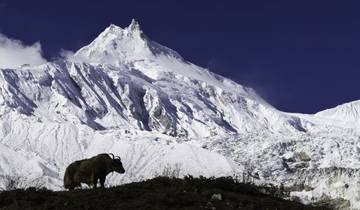
- Hiking & Trekking
- Mountain Hikes
- In-depth Cultural
- Christmas & New Year
Manaslu Circuit Trek
For a guy that hasn't left the state of Texas in many years, i was very adamant about travelling in general. But after watching some documentary in you-tube and Netflix about Nepal, i started to have different perception about travelling. With some research i came across "Adventure Himalayan Travel and treks".Met Rana the correspondence via email, who was really helpful about all the question i had before travelling. I made the Trip there in April for Manaslu Circuit Trek. From my short Breath taking experience, i couldn't have found a better correspondence and group of highly experienced travel guide and porter. The company had great pre-planed accommodation for all guests and adjustable schedule for the travelers comfort. The trek was incredible, i haven't had so much fun in a long time, i am even thinking of doing some trekking here locally, and planning a trip to the state of Washington. on the last note, I recommend the Nepali tea and "Dal Bhat", which is their traditional food if anyone is going to make the trip to Nepal in the future. Thank you Rana for a great time and hope to see you guys soon.

My long-awaited dream of visiting Nepal and its mountains was finally real when I contacted Nepal Hiking Team for Manaslu Circuit Trekking. I believed it was one of the best options for treks in the country and when I expressed my views and queries, Nepal Hiking Team answered them promptly and made all of the arrangements. When I arrived, I was greeted at the airport and I immediately knew that I was going to be in good hands as my guide- Kul, made the transfer to the Hotel from the airport fun and relaxing. When the trek began, KUL was always there beside me, taking care of all of my needs. I only had to say it to KUL and he would somehow make it work, even in the remote Himalayan villages that we were in. It was the best trek Kul was definitely the best guide that I could have ever asked for! I loved my trip with Nepal Hiking Team and they get my recommendation for anyone visiting Nepal. They do not disappoint!
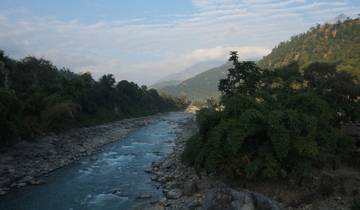
Manaslu Circuit Larke Pass Trek 14 Days
Sarba's ability to offer other options the day I arrived in Nepal was a blessing. There were banda's (strikes and so we were unable to do a lot of the planned things on the itinerary. He was able to offer me some fantastic options such as the trip through the Katmandu Valley to some beautiful accommodation from where we did some local walks. Sarba learnt and understood my needs, and the things I would enjoy, very quickly. The places he took me to eat were amazing, dining with the local sherpa people and eating the best momos! Sarba's knowledge is brilliant. I felt I was in safe, trustworthy hands the whole time. Nothing was a problem. I am so looking forward to returning to Nepal and travelling with Sarba and Nepal Nomad as soon as possible. I would highly recommend this company if you wish to see the best of Nepal, no matter what your fitness or age, Sarba will provide you with a very memorable experience.

We completed the Manaslu circuit trek from Approved Holidays and we had a wonderful trek and would definitely recommend asking for this company. Prakash was so friendly and kind and really knowledgeable about all the regions, Nepalese history, villages, customs and answered all of our questions. He took care of all of our needs on the trek, he had a great sense of humour and prepared anything we needed. We would definitely recommend this trek. Thank you Prakash, you made our trek so memorable.!
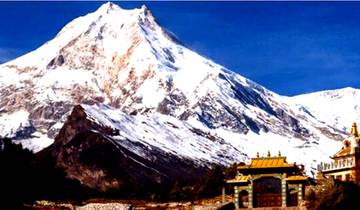
Manaslu Circuit Trek 15 Days
Our experience with Sherpa Expedition And Trekking l was fantastic! Our guide, Dorje Sherpa, did a great job to make our trip smooth, fun, and fit our needs. Ram Barakoti offered great communication and help with any questions we had leading up to the trek. I would definitely recommend going with Sherpa Expedition and Trekking!
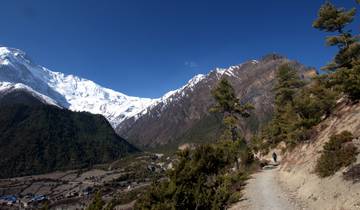
It was my dream trip! Finally I made it! I enjoyed every steps of my Manaslu circuit trek in Nepal. Very impressed with my guide and porter. They are amazing! Thanks Global Adventure for taking care of our trek and giving the best Guide and porter.
- 10% deposit on some dates Some departure dates offer you the chance to book this tour with a lower deposit.
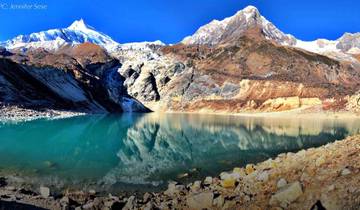
Manaslu Circuit Trek (Official)
Got a chance to see some beautiful stuffs just like some sweet ***bitch***

Manaslu Circuit Trekking (Manaslu Round Trek)
After a few changes from the original itenirary we did Annapurna circuit. All was satisfactoryAllow extra time in Pokhara- very special place.
- Book With Flexibility This operator allows you to rebook your dates or tours with them for free, waiving change fees.
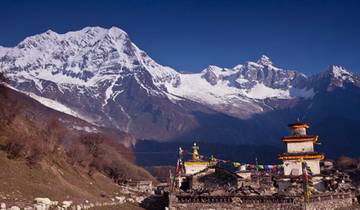
Short Manaslu Circuit Trek
I did this trek with my friend in May 2022. We arrived in Kathmandu and held up 1 more day to prepare the Trek permit by Sherpa Expedition and Trekking Team. All the administrations were given by the organization as guaranteed. The cost was entirely sensible contrasting with numerous different agencies.
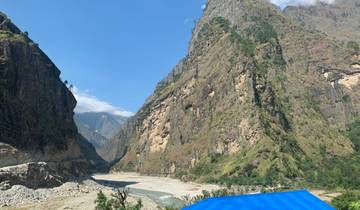
The Manaslu Circuit trek was an incredible adventure, filled with stunning mountain views and a challenging yet rewarding journey. Despite the mixed weather conditions, the trek was an experience of a lifetime. The meticulous planning and organization by Sherpa Expedition and Trekking made the entire trek hassle-free. One of the highlights of the trek was our guide, who proved to be an invaluable asset throughout the journey. His knowledge and expertise made the hike even more enjoyable and insightful. He shared fascinating stories about the local culture, history, and the surrounding mountains, enriching our experience along the way. His presence and guidance made the trek feel safe and well-guided. Sherpa Expedition and Trekking truly exceeded expectations with their professionalism and attention to detail. The trek was well-organized, and every aspect was taken care of, allowing us to fully immerse ourselves in the breathtaking landscapes. The challenging moments of the trek were always well worth it, thanks to the guidance and support provided by our guide. We I highly recommend Sherpa Expedition and Trekking for the Manaslu Circuit trek. Their commitment to excellence, along with the knowledge and assistance of their guides, make them a top choice for any trekking adventure. This was an unforgettable journey, and I would not hesitate to choose them again for future treks.
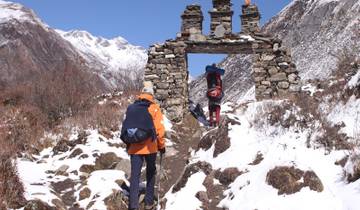
Manaslu Circuit Trek 17 days
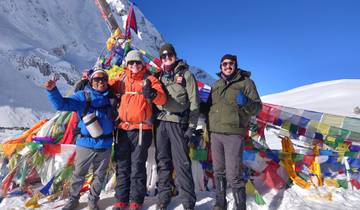
Together with my two buddies and our guide Pasang, I undertook a 14-day hike. I can't wait for another trip with Mount Adventure Vacations because it was such a lovely experience. Despite being a vegan, I had zero issues eating while hiking. My diet was readily accommodated by the personnel, and they made sure I was never served anything that wasn't vegan. Our group finished a day or two early than expected because we traveled more quickly than was anticipated. To ensure that everyone was content and comfortable, Pasang discussed our pace and the distance we would cover each day. From the moment we arrived at KTM to the moment we left, Pasang took care of everything and was very helpful in making recommendations for what to do with our spare time. I will recommend Mount Adventure Vacations to everyone who wants to travel to Nepal because this was an incredible experience. I'm grateful for the wonderful experience. Thank you.

Manaslu Circuit Trek- 14 Days
Embarking on the Manaslu Circuit Trek with Sherpa Expedition and Trekking was one of the best decisions I have ever made. This journey was nothing short of spectacular, and I would highly recommend it to anyone looking for an unforgettable trekking experience. The scenery on the Manaslu Circuit Trek was absolutely breathtaking. From towering mountains to serene valleys, every step of the way offered a stunning view. The beauty of the surroundings was truly awe-inspiring and left me in constant awe throughout the trek. It was like walking through a postcard-perfect landscape every single day. The hiking itself was interesting and varied. The trail was well-marked and provided a good mix of challenging ascents and descents, as well as more relaxed sections. This kept the trek exciting and engaging, ensuring that there was never a dull moment. The physical exertion was well worth it, as each new challenge brought a sense of accomplishment and a deeper connection with the natural surroundings. One of the standout aspects of the Manaslu Circuit Trek was the lack of crowds. Unlike some of the more popular trekking routes in the region, this trek offered a more peaceful and intimate experience. It was a true luxury to be able to enjoy the beauty of the surroundings without the hustle and bustle of large crowds. This allowed for a deeper appreciation of the natural environment and a greater sense of tranquility. The cultural exposure on this trek was also a highlight. Visiting remote villages and interacting with the local people provided a fascinating glimpse into their way of life and traditions. It was a humbling experience to be welcomed into their communities and learn from their rich cultural heritage. This added a whole new dimension to the trek and made it a truly enriching journey. I cannot conclude this review without mentioning the exceptional guide provided by Sherpa Expedition and Trekking, Dawa. His professionalism and knowledge were evident throughout the trek, and his positive attitude made spending over two weeks alone with him an absolute joy. His expertise and guidance were invaluable, and he went above and beyond to ensure that every aspect of the trek was enjoyable and safe. In summary, the Manaslu Circuit Trek with Sherpa Expedition and Trekking was an incredible adventure. The stunning scenery, interesting hiking, lack of crowds, and cultural exposure made it a truly memorable journey. I would highly recommend this trek to anyone seeking an extraordinary and rewarding experience in Nepal.
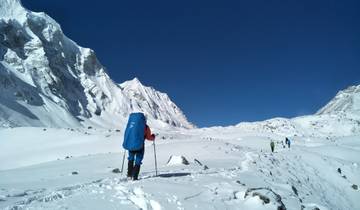
Manaslu Circuit Trek ( Larke-La Pass 5106 m) -18 Days Full package
It was a very good trip and full of new experiences. Everything worked out wonderfully with the organizer and they took care of taken care of everything. I am especially satisfied with my guide Rodna, who was always helpful, courteous and always had an eye on my health. Not entirely unimportant on this type of trip. He also often showed me things besides the standard routes, which made the trip something very special,
What people love about Manaslu Circuit Trek Tours
The assistance and support provided by tour operator Adventure Himalayan Travels was outstanding. Owner Mr. Rana helped us throughout, from planning, preparation and customization, to greeting us at the airport and bidding us farewell at the end of our trip. The guide Rudra was outstanding as well. It was a great pleasure trekking with him. He was very sociable but knew the right balance between assisting us where necessary and keeping a distance to not be pushy or overly present, so we could have our privacy. Rudra knew the route very well and always did his best to get us the best possible accommodation at the lodges along the trek. Porter Kanza did a great job as well, carrying our luggage with a smile. Mr Rana customized the trek to Annapurna Base Camp because we decide that the “Manaslu Circuit Trek” could be too taxing for first time trekkers. Be prepared for very basic accommodation in various lodges. Apparently, there simply are no more luxurious alternatives along the ABC route. The natural beauty and scenery was stunning though. All in all, we had a great trip, can fully recommend Adventure Himalayan Travels and will definitely return to Nepal.
Amazing experience. Well planned and organised. Recommended.
Manaslu Circuit Trek Tours starting in:
- Kathmandu (54)
- Hiking & Trekking (62)
- Personalized (52)
- Fully Guided (44)
- Family (37)
- Active (32)
- Partially Guided (25)
- Custom (14)
- Private (10)
- Small Group (43)
- 2 Week Tours (22)
- 3 Week Tours (32)
- Spring 2024 (50)
- Summer 2024 (46)
- Fall / Autumn 2024 (52)
- Winter 2024 / 2025 (47)
- Spring 2025 (41)
- Summer 2025 (29)
- Fall / Autumn 2025 (38)
- Winter 2025 / 2026 (29)
- April 2024 (38)
- May 2024 (49)
- June 2024 (45)
- July 2024 (38)
- August 2024 (39)
- September 2024 (49)
- October 2024 (51)
- November 2024 (51)
- December 2024 (45)
- January 2025 (35)
- February 2025 (34)
- March 2025 (41)
- April 2025 (38)
- May 2025 (35)
- June 2025 (28)
- July 2025 (26)
- August 2025 (27)
- September 2025 (35)
- October 2025 (36)
- November 2025 (36)
- Manaslu Circuit
Travel Styles
- Budget (16)
- Singles and Solo (44)
- For Couples (16)
- Seniors (21)
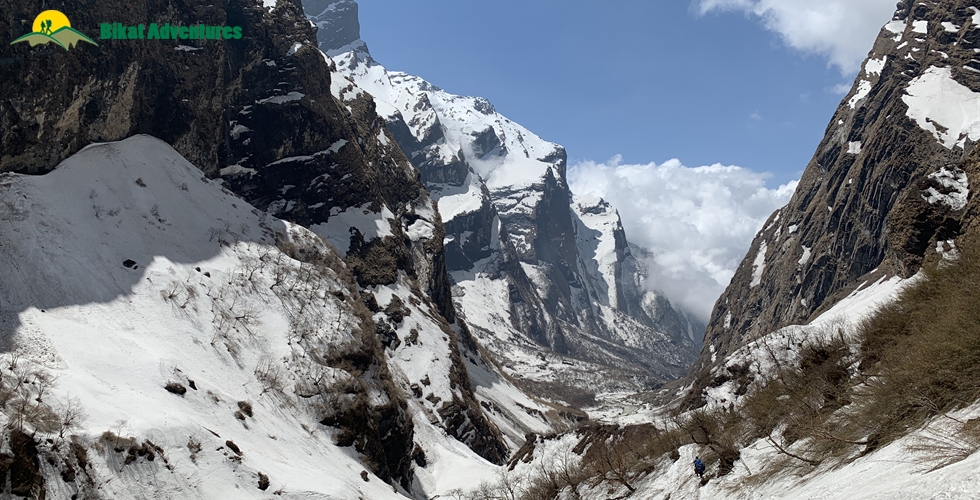
Manaslu Circuit Trek
Available batches, brief description, brief itinerary, detailed itinerary, what's included.
- Accommodation in Kathmandu
- Accommodation in guesthouse/lodge on all trek days
- Permits (Upto the amount charged for Indian nationals)
- Safety Equipment includes static rescue rope, seat harness, carabiners, pulleys
- Experienced guide
- Portage of 10kg personal luggage
What's Not Included
- Any Expense of personal nature.
- Any Expense not specified in the inclusions list.
- Any meals during the trek/road journey/hotel accomodation
- Any tip to porters or guides which is a customary thing in Nepal
- Backpack Offloading of more than 10 kg
- Travel Insurance and Rescue Evacuation in case of emergency
- Gaiters, microspikes and sleeping bags (wherever necessary) are not included and thus have to rented from Kathmandu by you).
- Additional Fee for Foreign Nationals for Permits
Are you Eligible for this Adventure?
Max Altitude

BRS Level Required
Manaslu Circuit Trek is a level 5 adventure on the Bikat Rating Scale.
Packing List
Frequently asked questions, eligibility, is this adventure good for me, what’s a good fitness benchmark for this adventure, what skills do i need to complete this adventure, what is the minimum and maximum age limit, about the activity, where is it located, what are some of its highlights, what are some of its challenges, what is the best season for this, what is the accommodation type, what is the temperature like here, is it technically challenging, connectivity, how do i reach the starting point, is there cellular network available throughout, where is the nearest atm, if i choose to travel to the base with you, what is the pick-up point, what time is the drop-off on the last day, what are the nearby attractions that i can explore, equipment & gear, what equipment is provided to us, what can i rent from you, where will i receive the rented items, where do i have to return the rented items, what gear do i need to bring, are there local shops to rent/buy equipment, facilities & additional services, can i offload my bag, can i leave any extra luggage i carry at the base of this adventure, what are the meals like, what are the washroom/ toilet facilities like, what should i do if i get my period on this adventure, what are the medical facilities available to me on this adventure, are there any electricity charging points on this adventure, mandatory documents, what documents do i need to carry, do i need insurance for this, do i need a permit for this, certification, do you provide a certificate of completion, when and how will i get the certificate of completion, international travel, will i need a visa, when should i apply for the visa, what kinds of insurance do i need to travel here, what is the specialty of this when compared to other mountain ranges, till which month can i make a booking for this, what is the qualification of the outdoor leader provided to us, how do you choose your outdoor leaders, is it safe for women, what is the ratio of outdoor leader to participants, what do you do in case of an emergency, what are the rescue options on this adventure, how do you choose your equipment, can i attempt this adventure if i have a specific medical condition, sustainability, what kind of camping do you practice on your outdoor adventures, why are you against fixed camping in the outdoors, how do you manage overcrowding on certain trails, what are some things to remember when using a dry toilet, why should i avoid wet wipes in the outdoors, where should i dispose of my sanitary waste if i am on my period, why should i carry my own utensils on an outdoor adventure, booking process, what happens after i make the payment, do you create a whatsapp group of participants before the start date of the activity, do i need to submit a medical certificate, do i need to submit an undertaking form.
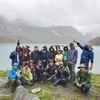
Small Group Size
Our batch sizes are capped at 15 for smaller treks with the trek leader and trekker ratio of 1:8. This ratio, in our years of experience, has proven to deliver the best trekking experience for individuals as well as groups. Capping the size of the group ensures individual attention to each trekker so that no signs of distress or need during the trek go unnoticed. It also helps to form a more cohesive cohort with better group energy which helps define the rhythm and pace of days on the trek. As you go higher up on the BRS scale, since the stakes are higher, expeditions have an even smaller group size with the ratio of expedition leader to climber set at 1:2.
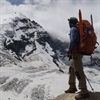
Qualified Trek Leaders
We follow a rigorous regime of hiring and training our experts in the field. Each trek leader is a certified mountaineer with years of experience in the field. In addition to their qualification, they also go through practical and situational training to tackle any and all kinds of sudden conditions that may present themselves on the ground. Being unpredictable is the core nature of the mountains but being ready for any circumstance as best as possible is a controllable asset that we try to nurture. Our field experts are also trained in basic medicine and first-aid response. Watch: Forerunners - The Making of A Trek Leader At Bikat Adventures
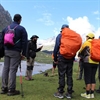
Guided Progression
Since Bikat Adventures is a learning-based organization, we help you climb up the ladder of difficulty within the sphere of outdoor adventure systematically. Our on-ground training modules are designed to handhold you through the upskilling process so that you are ready to take on bigger challenges.
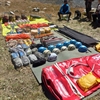
Equipment Quality and Check
All the gear used on our treks and expeditions is tried and tested, maintained for good quality, and is overall top-notch in quality and condition. We are continually looking to obtain the best of everything there is in the market so as to ensure optimum safety.
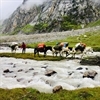
Support Systems
Along with the staff you see on-ground, we have a team of superheroes working in the background to give you the best experience possible. Our background team also comprises local staff from each area who know the region best. Having local support helps with studying the area, pre-planning, execution, and in receiving timely support in case of emergencies in these remote locations.
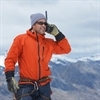
Communication
Our on-field staff is in constant contact with our teams based in primary locations so as to eliminate any avoidable delay in reaching additional help and support when required. We try to use the best tools for communication available, including satellite phones, in regions where they are not restricted.
What our customers Say

Cancellation Policy
Cash refund
Cancellations up to 30 days prior to departure date
5% deduction
Cancellations between 30 days to 15 days prior to departure date
50% deduction
Cancellations within 15 days prior to departure date
Voucher refund
Cancellations up to 5 days prior to departure date
No Deduction
Cancellations within 5 days prior to departure date
- Cash refund is applicable only in case of bookings made without using any promotional offer code or vouchers
- This is only a brief of cancellation terms. For finer details please refer Detailed Cancellation Policy.
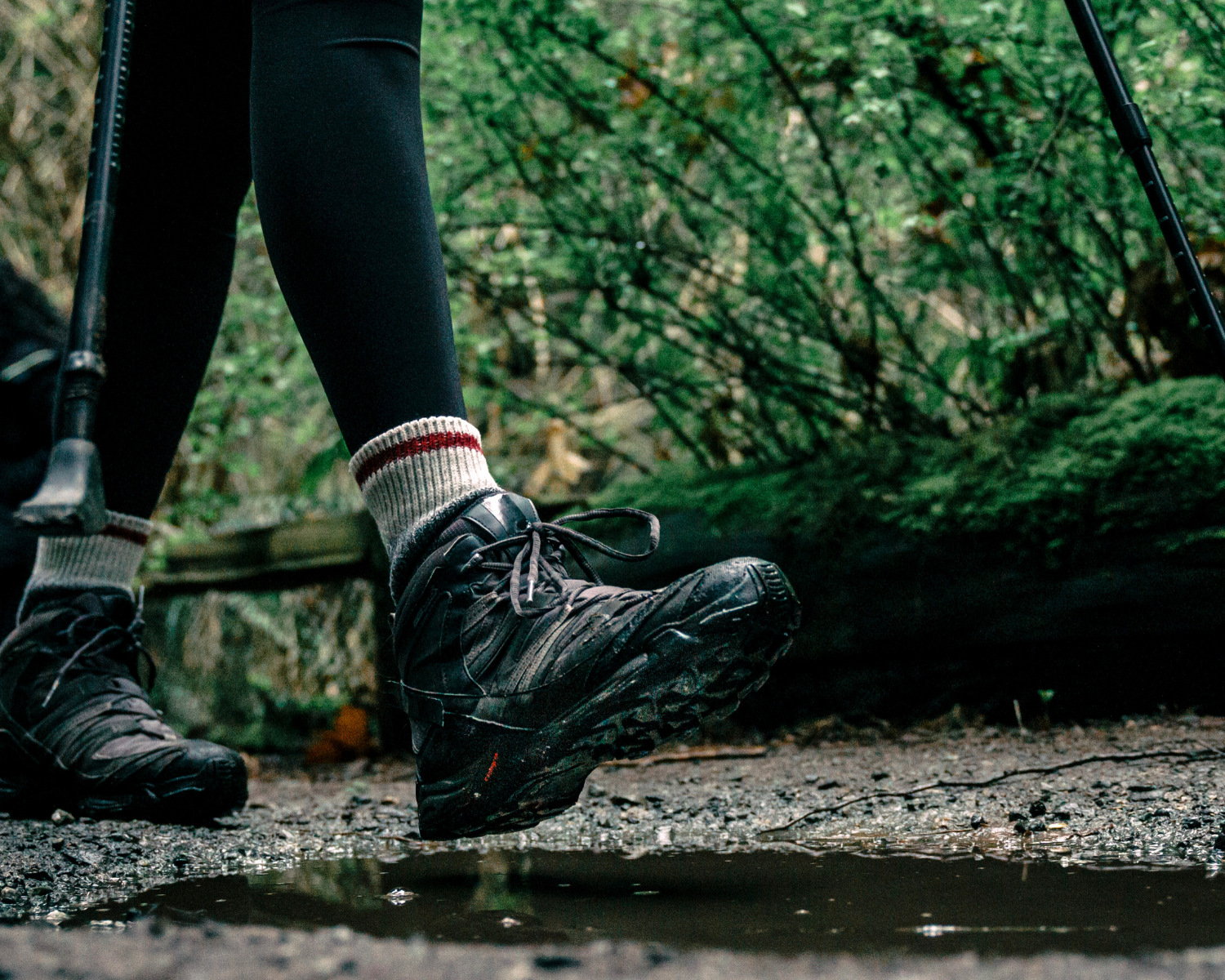
Subscribe for latest updates & offers
Similar adventures, enter your email, events by categories.

Mountaineering

Scuba Diving
Events by months.
- January July
- February August
- March September
- April October
- May November
- June December
Events By Nights
- 5 & More Night
- Environmental Policy
- Privacy Policy
- Term & Conditions
- Work With Us
- Address: 303, 3rd Floor, Tower B4, Spaze Itech Park, Sector 49. Gurgaon
- Pre Sale - 8448680062 , Post Sale - 8588878499, 9667639126
Bikat Adventures
- Cancellation & Refunds
- Content Sharing
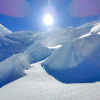
© 2024 Bikat Adventures - All Rights Reserved
Powered by: novel knett software solutions, submit enquiry.
Our Selection of the best destinations of Nepal allows travelers to see the real beauty of the Himalayan country
Experiences curated by our team of passionate travelers for you to experience Nepal authentically
Being one of the best destination management companies in Nepal, our day tours are designed to show you the best destinations in Nepal in a limited time

- Our Companies
- Impact Report 2022
- Impact Report 2020-2021
Manaslu Circuit Trek
Trip overview.
The Manaslu Circuit Trek is one of the best trekking routes in Nepal. It retains the impression of remoteness and of being off the beaten path. This trek takes you around the Manaslu Conservation Area, leading you deep into the Himalayas, where you can explore the breathtaking view of the 8th highest mountain of the world, Manaslu at 8163 meters. Manaslu means “Mountain of the spirit”, derived from Sanskrit word “manasa” meaning intellect or soul.
The Manaslu Circuit Trek features everything you’d want from a classic trek in Nepal: epic scenery, intimate encounters with local people and their ancient culture. The Manaslu circuit takes you from the steamy lowlands with their terraces of rice and millet, through the mighty gorges of the Budi Gandaki with its turquoise waters and amazing waterfalls. Suspension bridges in Manaslu trek are in a league of their own for both length and height. The yearly monsoon often washes minor bridges away leaving trekkers to use semi-submerged rocks.
Trip Highlights of Manaslu Circuit Trek
- Larkya La Pass (5106 meters), the maximum elevation
- The trekking trail is wild and remote yet there are basic tea houses
- The Budi Gandaki River, a deep long gorge, with many suspension bridges
- Stunning views of some of the highest peaks in the world, Mt. Manaslu (8163m), Cheo Himal (7126m), Larkya Peak (6219m), Nemjung (7139m), Himalchuli (7893m), Siringi Himal (7187m), Ganesh Himal (7163m), Gaygi Kung and Annapurna II (7937m)
- The vibrant ecosystem of Manaslu conservation area
Drive from Kathman du to Soti Khola via Arughat.
You start from your hotel by private jeep and drive through the hilltop village of Dhading leading you to Soti Khola via Arughat. You can expect a dusty and bumpy drive as the road passes along beautiful rural communities, small towns, green terrace farms and lush hills.
- Altitude: 600 meters (Soti Khola)
- Duration: 7-8 hours approx.
- Accommodation: Basic Tea House
Trek from Soti Khola to Machha Khola
Starting from Soti Khola, you trek through the countryside past paddy fields and waterfalls, passing through isolated settlements of houses with dark slate roofs. Cross a suspension bridge over the Budi Gandaki River and, following the rocky trail, you head onto the village of Machha Khola.
- Altitude: 900 meters (Maccha Khola)
- Duration: 6-7 hours approx
Trek from Machha Khola to Jagat
Following the narrow trail cross the Thado Khola you reach Khorla Besi. Passing through villages accompanied by the beautiful mountain views you will eventually reach a hot spring “Tatopani” where you can relax for a while. Then climb to bridges to cross Budi Gandaki and head towards Dobhan. Further on you enter the Manaslu Conservation Area and reach the beautiful paved village of Jagat.
- Altitude: 1410 meters (Jagat)
- Accommodation in Basic Tea House
Trek from Jagat to Deng
- Altitude: 1804 meters (Deng)
- Duration: 6-7 hours approx.
Trek from Deng to Namrung
Today is one of the most important and culturally significant sections of the Manaslu trekking. First, cross the Budhi Gandaki river and climb up to the bridge, where you’ll climb a bit further to join a trail from Bhi. Then head west up the valley passing through lush forests, alpine vegetation, and quaint villages housing ethnic groups of the Manaslu region, with major peaks starting to appear in the distance.
Even though there is another route, you will take the trail through Prok. This village has a beautiful vantage point of the snow-capped Siringi Himal. Take a break here and then continue to cross the Budi Gandaki several times today passing several gompas along the way. The trail then follows the river upstream through a dense forest and leads to a narrow gorge. Keep going until you notice the forest becomes less dense. This rewarding part of the walk is a magnificent way to experience the Manaslu Conservation Area. You’ll eventually make one last steep climb to reach Namrung Village.
- Altitude: 2630 meters (Namrung)
Trek from Namrung to Lho Gaon
- Altitude: 3150 meters (Lho Gaun)
- Duration: 4-5 hours approx.
Trek from Lho Gaon to Samagaon
- Altitude: 3530 meters (Sama Gaon)
Rest Day in Samagaon
Trek from Samagaon to Samdo
Your route descends to the Budi Gandaki River and you follow it to a bridge over a side stream. You’ll then pass several mani walls as the valley begins to widen. The mountain views along this route are amazing and get you close to the Tibetan border.
This is an easy trek on a shelf above the river that passes juniper and birch forests in Kermo Kharka. Drop down and cross the Budhi Gandaki over a wooden bridge, and then climb steeply onto a promontory between two forks of the river. You’ll come to a stone archway and continue walking until you reach the village of Samdo. Here you might see caravans of yaks returning with loads from Tibet. If you’re lucky you can visit some of the local houses and drink chhyang (Tibetan barley beer), or salt butter tea with the locals.
- Altitude: 3860 meters (Samdo)
- Duration: 6-7 hours. approx
Trek from Samdo to Larkya Phedi (aka Dharamsala)
- Altitude: 4480 meters (Larkya Phedi)
- Duration: 4-5 hours. approx.
Trek from Dharmasala to Bimtang via Larkya La Pass
- Altitude: 3720 meters (Bimtang) / 5106 meters (Larkya La Pass)
- Duration: 8-6 hours. approx.
Trek from Bimtang to Tilche
- Altitude: 2300 meters (Tilche)
- Duration: 5-6 hours. approx
Trek from Tilche to Chamje
- Altitude: 1410 Meters (Chamje)
- Duration: 6-7 Hours. Approx
Drive to Besisahar and back to Kathmandu
- Duration: 3 hours approx (Chamje to Besi Sahar)/ 3 hours. approx (Besi Sahar to Kathmandu)
Services Included
- Private transport as per group size to and from the trekking region
- Local transport Chamje to Besisahar
- Manaslu Conservation Area Project (MCAP Permit)
- Annapurna National Park permit (ACAP)
- Trekkers Information Management System (TIMS)
- English speaking trekking guide
- 01 Porter for 2 trekkers/ maximum 15 kgs luggage per porter
- Accommodation in basic tea house on sharing basis
Services Excluded
- All meals while on trek
- Travel and medical insurance including evacuation and cancellation (including helicopter evacuation)
- Expenses of personal nature such as bar bills, mineral water, laundries, telephone calls, internet facility, Electronic Device Charge, Hot Water shower
- Tips and gratuities
- Any item not specified as included
- Expenses arising from unforeseen circumstances beyond the control of Royal Mountain Travel
Impact Footprints
- Partnership for the Goals: Choice of accommodation is based on locally owned teahouse
- Life on Land: Permit fees for Manaslu and Annapurna Conservation Areas to curtail overexploitation and maintain authenticity.
- Decent work and Economic Growth: Source of income for local people who will serve you during the trek.
You may also like:

Excursion with a Monk

Explore Kathmandu on Rickshaw

Explore Panauti – Cycling Around Kathmandu Valley
How long is the manaslu circuit trek, what is the best season for manaslu circuit trekking in nepal, is the manaslu circuit trek in nepal difficult, can i trek to manaslu without a guide and porter, do i need a permit for manaslu trek, how cold is it in manaslu.
RMT Team Typically replies within an hour
Tour du Manaslu
- Voyage Asie
- Voyage aventure Népal
Tour du Manaslu - Trek Népal - Trekking Manaslu - Tour du Manaslu
Le Manaslu (8163m) se contourne par le col du Larkya La (5150m), au travers d'un itinéraire où le voyageur retrouve le Népal d'antan. Dans cet Himalaya encore sauvage, défilent les plus belles facettes de ce pays de trekking : camaïeu des cultures en terrasses, torrents émeraude, forêts de bambous, de pins et de rhododendrons, vastes alpages où paissent les yacks. Dans les collines, les Gurungs ont bâti de beaux villages aux maisons de pierre et de bois. Plus haut, tout près de la frontière, les Samapas, peuple de type tibétain, préservent une culture authentique, au pied des magnifiques sommets de l’Himal Chuli, du Kang Guru, et bien sûr du Manaslu. Ce trekking, voisin du "classique" tour des Annapurnas, reste un itinéraire nettement moins fréquenté et donc plus sauvage.
- Un trekking varié, moins fréquenté que le tour des Annapurnas
- Les villages traditionnels et le contact avec les Népalais
- Un itinéraire aménagé avec nuits en lodges
- La variété des paysages traversés
- La religion hindouiste en début de trekking puis bouddhiste tibétaine
Les niveaux du voyage
Niveau physique
plus de 6h d'activité par jour en moyenne ou un dénivelé moyen de 800 à 1000m
Ce voyage demande un certain goût de l’effort pour vivre pleinement l’expérience. Vos habitudes peuvent être affectées, notamment le confort, l’hygiène, la nourriture, l’engagement physique et mental. Une bonne capacité d’adaptation est préférable. Le voyage s’adresse à des personnes qui cherchent une expérience mémorable.
De 3500 à 4500 mètres
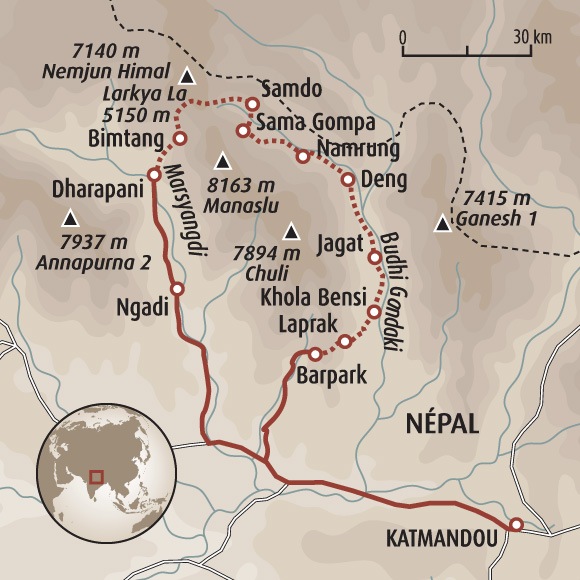
Vol pour Katmandou
Vol pour Katmandou.
Katmandou (1350m)
Accueil par votre guide à l'aéroport puis transfert à l'hôtel et temps libre pour découvrir Katmandou. Repas libres. Note : ces dernières années la pression des "porteurs de bagages" à la sortie de l'aéroport de Katmandou devient de plus en plus importante, et nos guides subissent malheureusement eux aussi cette pression. Sachez que le pourboire usuel pour ce "service" est de 100 Rps (1€) par personne.
Katmandou - Barpark (1915m)
Départ en bus pour Gorkha (4 à 5 heures de route). Puis par la piste nous rejoignons Barpak (5h de piste). La deuxième partie de la route peut être en mauvais état après de fortes pluies. Petit déjeuner, déjeuner et dîner inclus. Note : Terres d'Aventure fait le choix de débuter le Tour du Manaslu par le village de Barpark. Même si les altitudes sont plus élevées en début de trekking, cet itinéraire permet de s'affranchir des zones de construction et d'élargissement de pistes entre Soti Khola et Khola Bensi.
- Véhicule privatisé, entre 9h et 10h
Barpark - Laprak (2100m)
La première partie de la journée commence par une montée raide pour rejoindre Pushu Danda, situé à 2800m. Par temps clair, superbe vue sur le Bouddha Himal et le Ganesh Himal. Nous descendons ensuite vers le village Gurung de Laprak où nous passons la nuit. Petit déjeuner, déjeuner et dîner inclus.
- entre 5h et 6h
Laprak - Singla - Khola Bensi (885m)
L'objectif de la journée est de rejoindre la rive droite de la Burhi Gandaki, rivière que nous longerons jusqu'à sa source. Nous descendons dans un premier temps jusqu'à la rivière Maccha Khola que nous traversons par un pont suspendu. Nous remontons ensuite jusqu'au village de Singla (2300m). De là, une longue descente avec de nombreuses marches à travers rizières et champs de millet nous permet d'atteindre Khola Bensi. Petit déjeuner, déjeuner et dîner inclus.
- entre 6h30 et 7h
Khola Bensi - Jagat (1330m) - Salleri (1345m)
Montée progressive le long des premières gorges en passant par le village de Tatopani, lieu de sources chaudes. Le chemin change de rive et, après une montée un peu raide, rejoint le très beau village aux ruelles pavées de Jagat (1330m). Continuation à Salleri (1345m), village de maisons en pierres, entouré de champs cultivés. Petit déjeuner, déjeuner et dîner inclus.
- entre 6h et 6h30
Salleri - Deng (1875m)
Etape qui démarre par un sentier en balcon, parfois taillé au-dessus de la rivière. Traversée de Philim puis plusieurs hameaux et d'immenses forêts de pins de l'Himalaya. Par la suite les gorges se resserrent, et nous changeons plusieurs fois de rive pour suivre le cours de la Burhi Gandaki qui s'incline vers l'ouest. Nous arrivons à Deng (1875m), premier village où l'influence bouddhisme tibétain est présente. Petit déjeuner, déjeuner et dîner inclus.
Deng - Namrung (2615m)
Les villages "tibétains" se succèdent avec leurs "manis" (murs de pierres gravées) et les moulins à prières, signes du changement culturel. Le sentier est parfois délicat suite à des éboulements. Traversée de forêt humide, où nous pouvons apercevoir quelques singes. Montée raide avant d'atteindre Namrung (2615m), un beau village typique avec son poêle construit au milieu de la rue principale et ses femmes travaillant sur leur métier à tisser. Petit déjeuner, déjeuner et dîner inclus.
Namrung - Sama Gompa (3525m)
Montée à travers une forêt d’épicéas. Vue sur les montagnes qui forment la frontière avec le Tibet. Lho (3110m), que nous traversons, est un beau village de pierres sèches entouré de champs d’orge, avec vue sur le monastère construit sur ses hauteurs. Nous parvenons ensuite à Sama Gompa, le village le plus important de la vallée, situé sur un vaste plateau herbeux. Petit déjeuner, déjeuner et dîner inclus.
Sama Gompa - Samdo (3860m)
En fonction de la météo et de votre niveau de fatigue, montée possible ce matin au bord du glacier du Pung Gyen, au pied de l'impressionnante face est du Manaslu. Superbe panorama ! Partiellement fondu, le glacier laisse derrière lui plusieurs lacs couleur émeraude (3h30 à 4 heures de marche aller-retour, dénivelés +575m/-575m). Nous remontons ensuite la vallée plein nord en pente douce. Après avoir longé un immense mani de plus de 150m de long, une courte, mais raide, montée nous mène au village traditionnel de Samdo (3860m), le dernier avant le Tibet. Promenade dans ses ruelles, où nous pourrons croiser quelques femmes sur leur métier à tisser. Arrêt possible au monastère du village. Pour les ''courageux'', possibilité de monter l'après-midi au nord du village où en général paissent des chèvres (dénivelés +100m/-100m) : vue époustouflante sur l'Himal Chuli (7893m) au sud. Petit déjeuner, déjeuner et dîner inclus.
- entre 4h30 et 5h
Samdo - Dharmashala (Larkya Phedi) (4465m)
Courte descente pour rejoindre la rivière et prendre une vallée perpendiculaire à celle qui conduit au Tibet. Remontée par un sentier en balcon jusqu'au village en ruines de Dharmashala (4465m). Petit déjeuner, déjeuner et dîner inclus.
- entre 2h30 et 3h
Dharmashala - Larkya La (5150m) - Bimtang (3720m)
Départ à l'aube pour une montée sur moraine (parfois enneigée) assez longue, mais très progressive, jusqu’au sommet du col du Larkya La (5150m). Seule la partie terminale est un peu raide. L'altitude de 5150m est celle annoncée par beaucoup de GPS. Panorama grandiose sur les sommets du Larkya Himal, du Cheo et du Kang Guru. Descente raide vers un petit lac (très glissante en cas de neige dans les pentes) où nous déjeunons. Nous changeons ensuite de vallée et arrivons à Bimtang (3720m) au creux de la vallée. Petit déjeuner, déjeuner et dîner inclus.
- entre 7h30 et 8h
Bimtang - Tilije (2245m)
Descente et superbes vues sur le Ngadi, l’Himal Chuli et la face nord du Phungri. Nous regagnons la forêt de rhododendrons (en fleur au printemps) peuplée de singes langurs. Nous redescendons en plaine, en longeant la rivière jusqu'au village de Tilije (2245m) aux hauts murs de pierre, sorte de ''frontière'' mixant hindouisme et bouddhisme. Petit déjeuner, déjeuner et dîner inclus.
Tilije - Dharapani (1960m) - Bhulbule ou Bensishar (850m)
Nous marchons jusqu'à Dharapani où nous rejoignons la vallée de la Marsyangdi et donc le "classique" tour des Annapurnas. Nous rejoignons ensuite Ngadi puis Bhulbule ou Bensishar par la piste en jeep. Petit déjeuner, déjeuner et dîner inclus.
- entre 1h30 et 2h
- Véhicule privatisé, entre 4h et 4h30
Bhulbule ou Bensishar - Katmandou
Départ en bus qui nous conduit à Katmandou en 8 heures de route environ. Petit déjeuner et déjeuner inclus.
- Véhicule privatisé, entre 7h30 et 8h
Temps libre en fonction de l'heure de départ de votre vol, transfert à l'aéroport et vol retour. Important : dans certains cas, en fonction des disponibilités, vol au départ de Katmandou en début de journée et arrivée à destination le même jour en fin de journée. En cas de vol de nuit, le départ se fera de Katmandou en fin de journée et l’arrivée à destination le jour 17. Seules les personnes munies d'un billet d'avion sont autorisées à pénétrer à l'intérieur de l'aéroport de Katmandou, nos guides ne peuvent donc pas vous accompagner jusqu'au comptoir d'enregistrement.
Arrivée à destination
Fin du voyage.
- Depuis plusieurs années le Népal s’est lancé dans la construction de nouvelles routes. La situation évoluant sans cesse, il est possible que le départ et/ou la fin du trekking soient par conséquence modifiés afin d’essayer de vous éviter de marcher sur une route. Des lodges se construisent le long de cet itinéraire mais leur niveau de confort est très sommaire, inégal et n'est pas comparable aux lodges de la région des Annapurnas ou de l'Everest. Sur le tour du Manaslu il peut faire très chaud durant les premières étapes (moins de 1000m d'altitude), spécialement au printemps. Les temps de marche sont donnés à titre indicatif. En fonction du niveau des participants, de la météo et/ou de l'état du terrain, ils peuvent varier, en plus comme en moins. Pour les étapes en altitude, le niveau d'acclimatation joue aussi un rôle dans la durée des marches.
Ces tarifs sont valables pour des départs de Paris. Des départs d'autres villes sont possibles, n'hésitez pas à nous en faire la demande. Les prix indiqués ne sont valables que pour certaines classes de réservation sur les compagnies aériennes qui desservent cette destination. Ils sont donc susceptibles d'être modifiés en cas d'indisponibilité de places dans ces classes au moment de la réservation.
- Le transport aérien international et les taxes d’aéroport
- Les transferts terrestres nécessaires au bon déroulement du voyage
- L'encadrement par un guide népalais francophone
- L’assistance d’une équipe népalaise pour votre trekking (Sirdar, Sherpa, porteurs…)
- L’hébergement et les repas tel que décrit au programme
- Les permis de trekking et droits d’accès aux parcs
- L’accès au service médical de l’Ifremmont, spécialisé sur l’altitude, ouvert 24h/24 et 7j/7 (dans la mesure où une communication GSM ou satellite peut être établie).
- Le service d’assistance téléphonique, 24h/24 et 7j/7, en cas d’urgence, pendant toute la durée de votre voyage
- Les assurances
- Les frais d'inscription
- Les frais de visa à l’arrivée à Katmandou
- Les repas non prévus au programme
- Les entrées des sites non prévus au programme
- Les boissons, les dépenses personnelles et les pourboires
- Les douches dans les lodges (200 à 500roupies/douche)
- Le supplément chambre individuelle (hôtel uniquement, impossible de garantir une chambre single en lodge)
- Les suppléments pour les éventuels excédents de bagage pour les vols internationaux
- Les frais de transferts aéroport en cas de vol différent de celui du groupe.
ASSURANCE En cas d'urgence médicale pendant le trek, les frais de recherche et secours en montagne peuvent être très élevés. L'inscription à ce voyage est donc soumise à l'obligation d'être couvert par une assurance prenant en charge les frais de recherche et premiers secours, sans limite d’altitude, d’un montant d’au moins 10.000 euros, quelle que soit la raison médicale y compris le Mal Aigu des Montagnes et d’une couverture d’assistance et rapatriement à hauteur de 30.000 € minimum, Pour cela, deux possibilités : - Vous pouvez souscrire notre assurance Tranquillité auprès de votre conseiller voyage (en supplément du prix du voyage). - Vous pouvez nous présenter une attestation d'assurance souscrite par vos soins répondant aux garanties citées préalablement au moment de votre inscription. Supplément chambre individuelle pour les nuits en hôtel (à la demande) : nous contacter pour disponibilité et prix. Possibilité de louer un sac de couchage à Katmandou : à réserver dès l'inscription mais à payer à votre arrivée au Népal (70€ en espèces).
Envie de partir en famille ou avec vos amis aux dates que vous souhaitez ?
2 nuits en hôtel à Katmandou 12 nuits en lodge pendant le trek A Katmandou vous serez logés à l’hôtel Royal Singi Hotel : à 15 minutes à pied du quartier de Thamel et de Durbar Square, l’hôtel est idéalement situé pour arpenter les rues très animées de Katmandou. Il est possible de laisser un bagage à Katmandou contenant des affaires propres pour votre retour et/ou non utiles pour le trekking (prévoir un sac souple léger et un petit cadenas). En cas d’indisponibilité de cet hôtel, un hébergement similaire en confort et situation sera proposé dans Katmandou. Qu’est-ce qu'une nuit en lodge ? Le terme de lodge, utilisé au Népal pour décrire ces hébergements de montagne, peut prêter à confusion. En effet, ces hébergements se rapprochent plus de nos refuges français, mais ils ne font en aucun cas référence à un lodge ou "écolodge" comme dans d’autres pays. Il s’agit le plus souvent de maisons aménagées avec des chambres pour deux ou trois personnes, une salle de vie commune et une cuisine. Le confort diminue souvent avec l'altitude, et l'isolation, tant phonique que thermique, laisse parfois à désirer. Le confort est très variable en fonction des étapes et des régions de trekking. Les chambres des lodges ne sont pas chauffées, il est donc indispensable d’avoir un bon duvet. De la même façon, les salles communes peuvent ne pas être chauffées, nous vous conseillons de vous équiper d’une veste chaude pour les fins de journées et soirées. Certains lodges ont des douches (l’eau est souvent froide) mais qui sont très généralement payantes (entre 200 et 500 NPR/douche). Afin de participer activement à la lutte contre le déboisement au Népal, nous vous invitons à prendre des douches chaudes uniquement si l’eau est chauffée par panneaux solaires ou au gaz. Les toilettes sont rudimentaires et peuvent être à l’extérieur du lodge. De plus en plus de lodges disposent de l’électricité mais le fonctionnement reste aléatoire et l’accès n’est pas forcément garanti à chaque étape. Pensez à vous équiper de batteries additionnelles pour vos appareils photo et/ou d’un chargeur solaire, idéal pour recharger téléphone, montre GPS ou lampe frontale. Les charges sont majoritairement payantes (entre 100 et 600 NPR/charge en fonction de l’altitude ou de l’isolement du lodge). L’accès au Wi-Fi via le réseau 3G/4G est de plus en plus démocratisé sur les itinéraires classiques de trekking. Les connexions sont également payantes (entre 200 et 600 NPR/connexion), lentes et très aléatoires. Supplément chambre individuelle possible uniquement à l’hôtel à Katmandou (sous réserve de disponibilité). Dans les lodges, nous ne pouvons pas réserver de chambre individuelle : à voir sur place avec votre guide pour disponibilités et prix.
- Détail du voyage
- Formalités et santé
- Pays et climat
- Tourisme responsable
- Code voyage : NEP021 Télécharger la fiche technique À savoir avant de partir
plus de 6h d'activité par jour en moyenne ou un dénivelé moyen de 800 à 1000m
Bien choisir le niveau de votre voyage
De 4 à 15 participants
Le plat national traditionnel est le "dal bhat", littéralement "lentilles riz". Le riz blanc (bhat) est accompagné d’une soupe de lentilles (dal). Il est très souvent agrémenté de légumes épicés et, parfois, d’un peu de viande. Les Népalais mangent généralement ce plat deux fois par jour. Afin de vous apporter la plus grande diversité possible dans les repas tout en composant avec les contraintes locales, votre sirdar et votre guide se chargeront de la composition des menus avec les équipes de cuisine (pour les treks sous tente) ou avec les cuisiniers des lodges. - Petit déjeuner : au Népal, une journée démarre par le "morning tea". Il est généralement accompagné de pain tibétain, toast, chapati ou pancake, d’œufs sous différentes formes (omelettes, œufs brouillés, œufs durs…) et parfois de muesli ou porridge. - Déjeuner : en fonction des étapes, repas chaud, généralement composé d’un plat principal (riz sauté avec des légumes, pâtes, pommes de terre, curry, assortiments de légumes). Thé ou café. - A votre arrivée à la fin de votre étape journalière, généralement vers 16-17h, un encas avec des biscuits et du thé vous est proposé. - Dîner : habituellement servi tôt (vers 18h30-19h), il se compose généralement d’une soupe ou d’une entrée, d’un plat chaud (dal bhat, pâtes, pommes de terre, légumes…), d’un dessert. Thé ou café. - Boissons : à chaque repas nous prévoyons deux tasses de thé ou café par personne. Les autres boissons seront à votre charge. L’eau pendant les journées de trekking et les repas reste également à votre charge. Pour votre consommation d’eau pendant toute la durée de votre voyage, nous vous conseillons d’emmener des pastilles purifiantes pour l’eau que vous trouverez au robinet des lodges (type Micropur Forte ou Aquatabs). Il est possible de trouver facilement des bouteilles d’eau tout le long du trek mais nous déconseillons cette solution, la gestion des déchets en particulier plastique étant très compliquée au Népal. - Collation : votre guide remettra à chaque participant à l’hôtel à Katmandou une pochette avec des collations pour l’ensemble du voyage (barres énergétiques, fruits secs et chocolats). Note : lors de passage de col ou pour des étapes exceptionnellement longues, il est fréquent de partir à l'aube, voire de nuit, les petits déjeuners peuvent être moins importants. Le complément de vivres énergétiques est donc important. Important : si vous suivez un régime spécifique, que vous avez des contraintes alimentaires ou des allergies particulières, n’hésitez pas à l’indiquer à votre conseiller dès votre inscription. Nos équipes sur le terrain feront le maximum pour répondre à votre demande, mais sachez que certaines contraintes locales ne nous permettent pas de vous garantir une grande diversité de menus alternatifs. Pour les voyages impliquant une grande dépense énergétique, nous vous invitons à anticiper en prévoyant éventuellement plus de vivres de courses (barres énergétiques, fruits secs, chocolats…) pour vous assurer des apports caloriques suffisants.
Accompagnateur Terres d'Aventure népalais francophone. C’est votre guide depuis votre arrivée à Katmandou jusqu’à votre départ. Il a en charge la réussite de votre voyage, donc n’hésitez pas à lui poser des questions et, surtout, à suivre ses conseils ! L’équipe népalaise durant le trekking : • Le Sirdar (ou Sardar) est le responsable de toute l’équipe. Très souvent il a commencé comme porteur, puis kitchen-boy puis parfois cook, et est respecté par l’ensemble de l’équipe. • Le Cook (uniquement pour les trekkings sous tente) est le cuisinier : responsable de tous les repas. • Kitchen-boy (uniquement pour les trekkings sous tente) : assistant cuisinier, leur nombre varie en fonction de la taille du groupe. Il aide le cuisinier d’une manière très active, et c’est l’étape obligatoire avant de devenir un jour cook… • Sherpa : pas toujours de l’ethnie Sherpa, il est chargé de l’aide active auprès des clients. Leur nombre varie en fonction de la taille du groupe. • Porteur : le Népal étant un pays de montagne, la tradition du portage humain date de la nuit des temps et perdure aujourd’hui. Les Népalais qui pratiquent ce métier sont pauvres, même s’il est vrai que le revenu qu’ils gagnent en portant est supérieur à ce qu’ils gagneraient autrement. Sans trekking, les populations montagnardes vivraient plus pauvrement encore, et les plus touchés seraient les porteurs. Au Népal, il n’existe aucune législation sur le poids de leur charge hormis pour les expédions. Seul existe un syndicat d’obédience maoïste qui essaye d’imposer aux agences de trekking (et seulement à elles), un poids maximum (30 kg) ainsi qu’un salaire minimum pour les porteurs (1600 roupies environ par jour). Ce qui veut dire que les porteurs qui ravitaillent les lodges ne sont pas soumis à cette "pression" des maoïstes… Parallèlement à cela, beaucoup de porteurs qui travaillent pour les agences demandent plus de 30 kg pour être ainsi mieux payés. Au sein d’ATR (Agir pour un Tourisme Responsable), nous nous sommes engagés pour qu'à chaque kilo au-delà de 30 kg, une rémunération supplémentaire soit versée au porteur. Mais afin d’éviter les abus, et surtout les charges au-delà de 40/45 kg, nous vous demandons de faire vous aussi un effort en ce qui concerne le poids de votre sac qui ira sur le dos des porteurs : - maxi 13 kg pour un trekking en lodge - maxi 16 kg pour un trekking sous tente - maxi 20 kg pour un trekking avec ascension de sommet et/ou expédition D’autre part, Terres d’Aventure veille à ce qu’une assurance soit prise pour eux et qu’un équipement spécifique leur soit alloué lors de passage de col en altitude (même si souvent des porteurs refusent de mettre les chaussures par manque d’habitude…).
• Transferts en minibus ou bus privatisé entre Katmandou et les début et fin du trekking. Certaines portions peuvent se faire en Jeep. • Porteurs durant le trek : vous ne portez que vos affaires de la journée.
Sur vols réguliers entre la France et Katmandou. Les compagnies que nous sommes le plus susceptible d’utiliser sont Turkish Airlines, Qatar Airways et Emirates. Dans le cas d’Emirates, le vol Dubaï/Katmandou est opéré par Fly Dubaï (compagnie low cost d’Emirates sans service à bord) Important : les compagnies aériennes changent parfois leurs horaires de départ/arrivée : matin au lieu du soir et inversement. Il est donc possible que les premier et dernier jours du programme soient modifiés en fonction des rotations aériennes du moment.
Visite médicale : Etre en bonne santé est essentiel pour profiter pleinement de votre voyage Terres d'Aventure ! Si votre dernière visite médicale date quelque peu, c’est l’occasion d’effectuer un bilan de santé en expliquant à votre médecin les principales caractéristiques de votre voyage (climat, altitude, difficulté…) ; une visite chez votre dentiste est aussi une excellente initiative. Ces conseils vous concernent tout particulièrement puisque vous allez entreprendre un voyage lointain et en altitude. Nous vous conseillons de consulter le site de l'Ifremmont pour vous rapprocher d'un centre de consultation de médecine de montagne le plus proche de chez vous. Le MAM (Mal Aigu des Montagnes) : Ce voyage se déroule à une altitude élevée. Certaines personnes peuvent souffrir de malaise (maux de tête, gonflement, perte d'appétit). La plupart de ces symptômes disparaissent généralement en quelques jours mais il arrive qu'ils empirent et peuvent évoluer en maladies graves ; œdèmes pulmonaires ou cérébraux. Il n'existe pas de médicaments préventifs au MAM. Le diurétique Diamox se révèle souvent efficace, mais vous devez vous assurer auprès de votre médecin que ce médicament ne vous est pas contre-indiqué. L'altitude a aussi pour conséquence de raviver les problèmes dentaires ou autres douleurs chroniques. Pensez-y avant de partir. Pendant le voyage forcez-vous à boire beaucoup et à éliminer. Prévenez le guide de votre état de santé, même en cas de troubles légers. Infos sur les problèmes liés à l'altitude : www.ifremmont.com
Vous devez conditionner l’ensemble de vos affaires en 2 sacs : 1 sac à dos et 1 grand sac de voyage. 1 - Le sac à dos : Sac à dos de randonnée d’une capacité de 30 à 35 litres environ, il vous sera utile pour le transport de vos affaires personnelles durant la journée. Il vous servira aussi en tant que bagage à main lors de vos déplacements pour toutes vos affaires fragiles (appareil photo…), de valeur (lorsque votre hébergement ne dispose pas de coffre-fort) et pour vos éventuels médicaments. Il sera en cabine lors des transports aériens. Généralement, le poids des bagages cabine est limité à 10 kg par personne. 2 - Le grand sac de voyage : Il doit contenir le reste de vos affaires. Vous recevrez avant votre départ des étiquettes Terres d'Aventure, qui vous permettront d’identifier vos bagages avec vos nom et adresse, et faciliteront le regroupement des sacs aux arrivées à l’aéroport. Il sera en soute lors des transports aériens. Le poids des bagages en soute vous sera indiqué sur votre convocation ou billet. Nos recommandations : • Enregistrez en bagage en soute le maximum de choses et ne conservez dans votre bagage à main que ce qui est absolument indispensable à votre voyage. • Equipez-vous pour l'avion de votre tenue de randonnée et prenez vos affaires de première nécessité notamment vos médicaments, en cas de problème d'acheminement de vos bagages. • En cas de problème d’acheminement de votre bagage du fait de la compagnie aérienne, Terres d’Aventure et notre partenaire local vous accompagnent pour l’acheminement de ce bagage jusqu’à Katmandou. Les frais d’acheminement de votre bagage sur votre lieu de trek resteront à votre charge. Votre assurance voyage vous permet d’acheter les éléments de première nécessité, pensez à prévenir votre guide pour l’ouverture de votre dossier. • Merci de noter que les contrôles de sécurité sont devenus très stricts aux aéroports : mettez les couteaux, ciseaux, limes à ongles dans votre sac en soute. Des réglementations strictes sont en vigueur concernant les bagages en soute et en cabine. Nous vous conseillons vivement de vous renseigner sur les différentes restrictions et de consulter les informations présentes sur les sites des compagnies aériennes, des aéroports ou sur le site de la direction de l’aviation civile : https://airbag.dsac.aviation-civile.gouv.fr/WD220AWP/WD220Awp.exe/CONNECT/AirBag
• Nous vous fournissons sur place un sac de type "Duffel bag" d’environ 70 litres. Ce sac vous sera remis à votre arrivée à votre hôtel à Katmandou, il remplace durant la durée du trek votre sac de voyage que vous pourrez laisser à l’hôtel. Il permet de faciliter le travail des porteurs et d’éviter l’usure de votre sac pendant le trek. Ce sac n’est pas étanche. • Au Népal, sur les vols intérieurs, la limitation du poids des bagages est de 10 kg par personne pour le bagage en soute et 5 kg pour le bagage à main. • Il est possible de laisser un bagage à Katmandou contenant des affaires propres pour votre retour et/ou non utiles pour le trekking.
Liste d’équipement donnée à titre indicatif et à adapter selon vos besoins et vos habitudes. • 1 paire de sous-gants en soie ou laine • 1 paire de gants en polaire avec membrane coupe-vent (Windstopper) • 1 paire de gants chaud de haute montagne avec membrane imperméable et respirante (Gore-Tex) • 1 chapeau / casquette • 1 bonnet et 1 buff • 1 paire de chaussures de marche basse et légère pour le voyage et/ou 1 paire de sandale • 1 paire de chaussures de trekking • 1 paire de guêtres (facultatif) • paires de chaussettes laine / Coolmax pour la partie trek • Sous-vêtements • 1 ensemble sous-vêtements (haut et bas) chaud (matière synthétique ou laine mérinos) (facultatif) • 1 pantalon léger pour les journées de visite • 1 pantalon de trekking léger et 1 short • 1 pantalon de trekking avec membrane coupe-vent (Windstopper) • 1 surpantalon avec membrane imperméable et respirante (Gore-tex) • tee-shirt manches courtes et manches longues (privilégier des matières respirantes) • sous-pulls en polaire • 1 veste polaire chaude • 1 veste ou gilet en duvet ou matière synthétique • 1 veste en duvet • 1 veste avec membrane imperméable et respirante (Gore-tex) • 1 cape de pluie
• 1 paire de bâtons télescopiques • 1 paire de lunettes de catégorie 4 avec protections latérales • 1 paire de lunettes de catégorie 3 pour le trek (paire de secours en cas de casse) • 1 lampe frontale et batterie/piles de rechange • 1 paire de petits crampons facilement ajustables (type Camp Ice Master 22) • bouchons d'oreilles anti-bruit • 1 couteau multi-usage • 1 briquet • 1 thermos et/ou une gourde • 1 couverture de survie • chaufferettes • nécessaire de toilette léger • crème solaire haute protection et stick pour les lèvres • sacs de compressions étanches • 2-3 grands sacs poubelles et Ziploc de différentes tailles pour organiser et protéger vos affaires • papier toilette (et Ziploc pour le stockage au sec)
• 1 sac de couchage avec une température dite "confort" de -10°/-15°C • 1 drap de sac (en soie ou polaire) • 1 taie d'oreiller (confort et hygiène) Possibilité de louer un sac de couchage à Katmandou, température confort -15°C, à réserver dès l'inscription mais à régler à votre arrivée au Népal (70€ en espèces pour l’intégralité du voyage). Note : location possible sous réserve de disponibilité. Il est important de noter que la taille des duvets convient uniquement à des personnes ne mesurant pas plus de 1,80m. Prévoir son propre drap de sac.
• Vos médicaments habituels • Médicaments contre la douleur : paracétamol de préférence • Antidiarrhéique (type Lopéramide ou Tiorfan…) • Pansement intestinal (type Smecta) • Traitement antibiotique à large spectre : prévoir 8 jours de traitement (sur prescription médicale) • Collyre (poussière, ophtalmie) et crème antibiotique pour les yeux • Pastilles purifiantes pour l’eau (type Micropur Forte ou Aquatabs) • Bande adhésive élastique (type Elastoplast, en 6 cm de large) • Jeux de pansements adhésifs et compresses désinfectantes • Double peau (SOS Ampoules de marque Spenco, disponible en magasins de sport, en pharmacie, parapharmacie...) • Pommade anti-inflammatoire • Traitement pour rhume et maux de gorge (pastilles) • Répulsif anti-moustiques efficace en zone tropicale • Biafine • Diamox en comprimé pour la prévention ou le traitement du mal aigu des montagnes (sur prescription médicale)
Votre accompagnateur sera en possession d'une trousse de premiers secours (sans médicaments).
• Trousse de premiers secours • Caisson hyperbare
PERMIS DE TREKKING Afin d’obtenir votre permis de trekking, il est impératif que vous nous retourniez dès l’inscription la photocopie des 2 premières pages de votre passeport ainsi que celle d’une photo d’identité. Pour ce faire, merci de télécharger les champs adéquats dans votre espace client (https://www.terdav.com/EspaceClient/Account/LogOn) ou de nous envoyer les copies à l’adresse suivante : [email protected] DEMANDE DE VISA Le visa peut être demandé à l'arrivée, à l'aéroport de Katmandou. Pour voir la procédure de demande de visa à l'arrivée veuillez consulter la rubrique Visa. Un tutoriel d'aide au remplissage de demande de visa à l'arrivée est envoyé automatiquement par mail lors de votre inscription. Veuillez trouver ci-dessous les informations nécessaires pour compléter votre demande de visa : Dans la partie "Address in Nepal", vous devez indiquer l’adresse de votre premier hébergement. - Royal Singi Hotel : Lal Durbar, Kamaladi, Katmandu 44600, Nepal ASSURANCE En cas d'urgence médicale pendant le trek, les frais de recherche et secours en montagne peuvent être très élevés. L'inscription à ce voyage est donc soumise à l'obligation d'être couvert par une assurance prenant en charge les frais de recherche et premiers secours, sans limite d’altitude, d’un montant d’au moins 10.000 euros, quelle que soit la raison médicale y compris le Mal Aigu des Montagnes et d’une couverture d’assistance et rapatriement à hauteur de 30.000 € minimum. Pour cela, deux possibilités : - Vous pouvez souscrire notre assurance Tranquillité auprès de votre conseiller voyage (en supplément du prix du voyage). - Vous pouvez nous présenter une attestation d'assurance souscrite par vos soins répondant aux garanties citées préalablement au moment de votre inscription. VOYAGER AU NEPAL Les conditions d’entrée, de séjour et de déplacement au Népal évoluent et sont mises à jour régulièrement sur le site conseil aux voyageurs. Dans le cadre de la préparation de votre voyage, nous vous invitons à consulter l’ensemble des mesures mises en place sur Conseils aux voyageurs - Népal . Vous êtes un voyageur en provenance de Belgique ou de Suisse, nous vous invitons à vous diriger vers les sites suivants et sélectionner la destination de votre séjour : - Belgique - Suisse
Passeport en cours de validité, valable 6 mois après la date de retour, pour les ressortissants français, belges et suisses. Pour les autres nationalités, nous sommes à votre disposition pour vous accompagner dans vos démarches. Afin de parer à toute éventualité, on veillera à disposer d’un passeport comportant le nombre de pages vierges requis ou suffisant (généralement 3, dont 2 en vis-à-vis). Passeport d’urgence. Ce document n’étant pas accepté partout, il faudra s’assurer, avant d’en faire la demande éventuelle, qu’il est reconnu par le pays concerné par le voyage ; on vérifiera également s’il implique une demande de visa (ce qui peut être le cas même pour des pays où on en est dispensé avec un passeport ordinaire). Si vous voyagez avec vos enfants, sachez que, dorénavant, les mineurs, quel que soit leur âge, doivent eux aussi avoir un passeport individuel. La législation française stipule que les mineurs voyageant avec leurs deux parents, ou un seul des deux, n'ont pas besoin d'être en possession d'une autorisation de sortie du territoire. En revanche, ce document est obligatoire (depuis le 15 janvier 2017) si cette condition d'accompagnement n'est pas remplie. Dans ce dernier cas, l'enfant devra présenter : passeport (ou carte d'identité, selon les exigences du pays de destination) ; le formulaire d’autorisation de sortie du territoire, signé par l'un des parents titulaires de l'autorité parentale (le formulaire d’autorisation de sortie du territoire est accessible sur le site www.service-public.fr) ; une photocopie du titre d'identité du parent signataire. Lorsqu’un mineur voyage avec l’un de ses parents dont il ne porte pas le nom, il est fortement conseillé soit de pouvoir prouver la filiation (https://www.service-public.fr/particuliers/vosdroits/F15392), soit de présenter une autorisation de sortie du territoire (formulaire Cerfa n° 15646*01) dûment remplie et signée par l’autre parent avec copie de sa pièce d’identité. Cette autorisation ne dispense pas de l’accomplissement de toute autre formalité spécifique à la destination concernant les mineurs. De nouvelles mesures de sécurité sont entrées en vigueur dans les aéroports : les appareils électroniques (smartphones, tablettes, portables…) doivent être chargés et en état de fonctionnement pour tous les vols allant ou passant par les Etats-Unis et Londres. Les agents de contrôle doivent pouvoir les allumer. Par précaution, ayez votre chargeur à portée de main. Si votre appareil est déchargé ou défectueux, il sera confisqué. Cette mesure étant susceptible d’être étendue à d’autres aéroports, nous vous conseillons de charger vos appareils électroniques avant le vol quelle que soit votre destination. Permis de conduire : pour éviter tout désagrément, il peut-être utile, même pour les pays extra-européens reconnaissant officiellement sur leur territoire la validité du permis français, de se procurer également un permis de conduire international ou, à défaut, une traduction assermentée du permis français.
Visa obligatoire pour les ressortissants français, belges ou suisses. Pour les autres nationalités, nous sommes à votre disposition pour vous accompagner dans vos démarches. Le visa peut être demandé à l’arrivée, à l'aéroport de Katmandou. Dès l’entrée au Népal, les voyageurs doivent remplir une carte d’arrivée (Arrival Card) ainsi qu’un formulaire de demande de visa touristique. Ce dernier document peut être rempli avant l’arrivée en visitant le site https://nepaliport.immigration.gov.np/ ou à l’entrée dans le pays en utilisant les kiosques automatiques disponibles au point de contrôle. Nous vous conseillons fortement de remplir ce formulaire en ligne avant le départ afin de gagner du temps à l’arrivée. A la fin de cette procédure un fichier est généré, il faut l’imprimer. Ce document n’étant valable que deux semaines, on ne doit compléter le formulaire en ligne que 14 jours maximum avant un départ. Il est à présenter à l'arrivée, avec son passeport et une copie de celui-ci, au comptoir d'établissement des visas. Si le voyageur a déjà voyagé au Népal, il doit aussi fournir une copie de son ancien visa népalais. Le paiement s’effectue sur place lors de la délivrance du visa. Le prix du visa est fixé à : - 30 dollars US (ou équivalent euros, billets uniquement), pour un visa de 15 jours (entrées multiples) ; - 50 dollars US (ou équivalent euros, billets uniquement), pour un visa de 30 jours (entrées multiples) ; - 125 dollars US (ou équivalent euros, billets uniquement), pour un visa de 31 à 90 jours (entrées multiples). Le visa est gratuit pour les enfants de moins de 10 ans. Pour les séjours de moins de 3 jours, les visas gratuits n'existent plus (prendre un visa « 15 jours »). En cas de voyage combiné Inde-Népal, il est à noter que la loi indienne interdit d’entrer en Inde, ou au Népal depuis l’Inde, avec des roupies indiennes (conséquence logique de l’interdiction d’importer et d’exporter des roupies indiennes). Les contrevenants s’exposent à des sanctions.
Pas de vaccin obligatoire, sauf fièvre jaune pour les voyageurs en provenance de zones où la maladie peut être présente.
Il faudra, comme pour tous les voyages (et, peut-être, plus encore ici qu´ailleurs), vérifier qu'ont été faits, en l'absence d'immunité connue, les vaccinations (ou leurs rappels) contre diphtérie, tétanos, coqueluche, poliomyélite , hépatites A et B, rougeole surtout pour les enfants. Il est, en outre, souhaitable (car il s'agit souvent de voyages « difficiles ») d'être immunisé contre typhoïde, rage, concernant l'encéphalite japonaise, la vaccination est conseillée aux expatriés et, pendant la mousson (période de circulation du virus), aux voyageurs ayant des activités de plein air dans la province du Teraï (rizières, parc de Chitwan), inutile pour les trekkeurs au-delà de 1 500 m.
Le paludisme ne sévissant pas au-dessus de 1800 m, les treks et les expéditions d’altitude ne sont pas concernés. La seule province impaludée est le Teraï, région très touristique (safaris, rafting…). La prévention passera, d'abord, par une protection rigoureuse contre les piqûres de moustiques (vecteurs potentiels dans le Teraï, non seulement de paludisme, mais aussi, sur un mode épidémique, de dengue, de chikungunya, de zika ou d'encéphalite japonaise) : répulsifs peau et vêtements, moustiquaires imprégnées. Elle devra être complétée par la prise d'un traitement préventif par atovaquone-proguanil ou doxycycline, sur prescription médicale. Compte tenu du risque d'effets indésirables, la prescription de méfloquine (Lariam) ne sera proposée aux voyageurs qu'en cas de bonne tolérance lors de voyages antérieurs ou de contre-indication aux autres médicaments actifs.
Les risques alimentaires sont fréquents pendant les treks, au cours desquels boire abondamment est une nécessité absolue. Si vous n'êtes pas sûr de l'eau qui vous est proposée, vous pourrez boire du thé. Respectez les règles habituelles de l´hygiène alimentaire : lavage des mains, aliments cuits et chauds… L'hygiène corporelle, en particulier des pieds, est, bien sûr, capitale. L’altitude est le problème principal auquel sera confronté le voyageur. Il nous parait indispensable d´insister sur les risques de la haute montagne. Il faut savoir qu'un trek au Népal (sans parler d’une ascension du « Toit du monde ») constitue souvent un réel effort physique et qu'au-delà de 4000 m, il est important de tester la capacité du voyageur. Plus que les examens classiques (électrocardiogramme, radiographie pulmonaire), qui ne révèleront que des contre-indications relatives, il peut être utile de faire évaluer, dans un centre spécialisé, la résistance de l'organisme à la baisse de la pression d'oxygène rencontrée en haute montagne (test à l'hypoxie). La sensibilité au mal des montagnes est individuelle : elle n'est pas fonction du degré d'entraînement, ni de la condition physique. Elle peut être répétitive pour un même sujet à une même altitude. Elle semble être dépendante de facteurs constitutionnels, encore mal définis. La prévention du mal aigu des montagnes passe par certaines règles, bien connues des montagnards chevronnés : d'abord avoir en tête que, dans l'Himalaya, l'altitude n'est pas comparable à celle des plus hauts massifs alpins (les camps de base y sont installés plus haut que les plus hauts sommets européens) ; s'acclimater, en séjournant quelques jours à une altitude intermédiaire ; entre 3 500 et 4 500 m, l'ascension ne doit pas excéder 500 m par jour ; le bivouac devra, chaque fois que c’est possible, être installé moins haut que l'altitude atteinte dans la journée. Dès les premiers signes de mal des montagnes (maux de tête, nausées, fatigue intense, vertiges), il faut arrêter la montée, traiter les symptômes, boire abondamment et, en cas de persistance, ne pas hésiter à redescendre. L'apparition de ces signes doit être considérée comme une alerte et imposer l'arrêt immédiat de l'ascension et la redescente, sous peine de voir s'installer les redoutables complications que seraient l'œdème pulmonaire et l'œdème cérébral de haute altitude. Les traitements préventifs (acétazolamide et inhibiteurs calciques) pourront être conseillés par le spécialiste, avant le départ. Les traitements (dexaméthasone, caisson hyperbare portable) ne seront utilisés que par des coéquipiers qualifiés (guide secouriste ou médecin). L'altitude peut exposer à 3 autres risques : le froid et le vent, responsables de gelures et d'hypothermie ; les chutes, responsables de fractures ou d'entorses ; le soleil, dont vous devez savoir vous protéger ; tant du rayonnement direct (crèmes à très haut indice de protection, supérieur à 40), que de la réverbération (port de lunettes de type « intégral »). Il est impératif de contracter une assurance de rapatriement sanitaire couvrant les frais de recherche et garantissant le recours possible à un hélicoptère en cas d’accident en montagne. L’attention des randonneurs et des alpinistes est attirée sur la nécessité de bien vérifier les montants garantis par leur police d’assurance (le tarif d’une évacuation héliportée s’élevant au minimum à 3 000 dollars US alors que le plafond des frais couverts par les assurances allant de pair avec l’usage d’une carte bancaire est généralement inférieur) et de s’assurer que le contrat ne comporte pas de clause restrictive au-delà d’une certaine altitude. Si vous sortez des sentiers de randonnée, soyez très attentifs au distinguo établi dans les contrats entre les secours proprement dits et les opérations de recherche.
Les installations médicales sont précaires même à Katmandou. Il faudra donc, en cas de problème grave, contacter sa compagnie d'assistance et les services des l'ambassade de France à Katmandou ou à Delhi.
Ce voyage fait partie de ceux que nous qualifions de voyage en milieu isolé ou de voyage en altitude. Pour vous permettre de vivre cette expérience en toute sécurité, nous avons mis en place un partenariat avec l’Ifremmont, l’institut de formation et de recherche en médecine de haute montagne, basé à Chamonix. Durant votre voyage, vous pourrez donc bénéficier d’un service médical d’urgence. Ce service vous permet d’avoir accès par téléphone 24h/24 et 7j/7 à un médecin spécialiste de l’altitude et des conditions isolées. En cas de problème médical, vous serez mis en relation par votre guide avec l’un des médecins. Vous avez également la possibilité de réaliser une téléconsultation avant départ. Celle-ci est optionnelle et son coût est de 50€. En cas de doute sur une pathologie particulière qui vous concerne, nous vous recommandons vivement d’avoir recours à cette téléconsultation. Elle vous permettra de faire le point avec des médecins spécialistes de l’altitude. Vous partirez donc rassuré et avec des consignes claires. Il est important de préciser que le service médical d’urgence ne remplace pas une assurance rapatriement. Il s’agit d’un service de téléconsultation médicale qui permet de poser un premier diagnostic. Soucieux d’assurer toujours plus votre sécurité lors de nos voyages, nous avons souhaité intégrer ce service de manière totalement gratuite pour nos clients.
Printemps : de mars à mai, les journées sont ensoleillées et les températures de plus en plus clémentes. La vue sur les montagnes est de moins en moins bonne à mesure que la mousson approche, mais c’est aussi la période de floraison des rhododendrons, absolument magnifique, entre 2000 et 3800m d’altitude. Le ciel est dégagé le matin mais peut rapidement se couvrir à la mi-journée avec une nébulosité importante. Été : de juin à septembre, les masses d’air humide du golfe du Bengale se heurtent à la chaîne himalayenne. En s’élevant, elles se refroidissent et se condensent pour retomber sous forme de pluie : c’est la mousson. Ses effets sont très inégaux à travers le pays. Elle perd graduellement de son intensité en se déplaçant du sud-est vers le nord-ouest. Certaines régions sont donc moins touchées par la mousson : le nord de la zone de l’Annapurna (Manang, Naar, Phu), le Haut-Dolpo et le Mustang. Automne : d’octobre à mi-décembre, le ciel est normalement d’un bleu profond, le soleil souvent radieux et la vue sur les montagnes est la plupart du temps cristalline. C’est une période optimale pour le trekking. Les températures sont plutôt agréables dans la journée mais peuvent être froides, surtout la nuit en altitude. Depuis plusieurs années, les effets du réchauffement climatique engendrent un décalage dans la période de mousson avec de potentielles précipitations début octobre. Même si les températures sont plus fraiches en novembre et début décembre, cette période est idéale pour arpenter les itinéraires de trekking avec généralement moins de trekkeurs sur les sentiers. Hiver : de mi-décembre à fin février, les chutes de neige peuvent être abondantes, rendant parfois impraticables plusieurs cols de haute altitude. Le trekking est toujours possible, mais à des altitudes inférieures à 4000m à cause du froid. Le temps est très clair et la visibilité sur les montagnes excellente. Us et coutumes • "Namasté" est une expression que l’on utilise partout pour vous saluer. La signification "exacte" est : "que vos qualités soient bénies". Elle se prononce en général mains jointes et en s’inclinant. • On se déchausse avant d’entrer dans tous les monuments religieux ou dans les maisons, en prenant soin de placer ses chaussures semelles contre terre. • On ne pénètre jamais dans une cuisine qui n’est pas la sienne sans y avoir été invité. • On contourne toujours les "stupas" et "chörtens" par la gauche (sens des aiguilles d’une montre). • Le feu est sacré, spécialement chez les Sherpas, donc ne jetez aucun détritus dedans. • Ne jamais manger dans l’assiette ni boire dans le verre d’autrui. • Si vous voulez suivre la coutume locale en mangeant un "dal bhat" avec la main, n’utilisez que votre main droite. • Il est mal vu de désigner quelqu’un, ou même une statue, avec le doigt. • Lorsque vous êtes assis, évitez de pointer votre pied vers quelqu’un. • Pour répondre OUI, les Népalais effectuent un signe latéral de la tête qui correspond plus à un "je ne sais pas" voire à un NON français. • En couple, ne soyez pas trop "démonstratifs" : évitez de vous embrasser en public et même de vous tenir la main.
Le développement du trekking au Népal a modifié l’équilibre écologique des vallées que nous traversons. A titre d’exemple, un trekkeur en lodge consomme en moyenne 4 à 5 kg de bois par jour, et l’activité de chaque lodge implique l’abattage d’un hectare de forêt par an alors que le Népal manque déjà de bois et que l’érosion des sols provoque glissements de terrain et inondations. Le tourisme "consomme" beaucoup d’espaces de qualité ; ainsi, des endroits réservés à l’agriculture sont désormais transformés en terrains pour camper, des habitations deviennent des lodges pour accueillir les trekkeurs etc… Le piétinement excessif en dehors des sentiers provoque également de réelles dégradations de la végétation (tiges brisées, pertes de matière organique) et de la qualité des sols (baisse de perméabilité, érosion, etc…). Nous vous prions donc de marcher sur les sentiers durant votre trekking ou vos balades. Des efforts énormes ont été entrepris par les Népalais pour gérer au mieux les déchets inévitablement liés à cette fréquentation de plus en plus importante, mais la lutte contre la pollution doit être l’affaire de chacun. Même si vous constatez que certains endroits sont déjà pollués, vous devez ramasser tous vos déchets (papiers, mouchoirs en papier, boîtes, etc…). De même, comme signalé au début de ce chapitre, le déboisement est un problème grave au Népal. Aussi, nous vous demandons d’éviter de prendre des douches (plus ou moins chaudes d’ailleurs) dès lors que l’eau est chauffée au feu de bois et non pas à l’aide de panneaux solaires, de plus en plus nombreux au Népal, surtout dans la région de l’Everest et celle des Annapurnas. Le tourisme représente 3,5% du PIB, 15% des devises étrangères et près de 300 000 emplois directs ou indirects. Au Népal comme dans beaucoup d’autres pays, le tourisme peut, soit aggraver les inégalités, la pauvreté et la dégradation de l’environnement, soit s’efforcer de les réduire : c’est l’affaire de tous sans exception…
Nous absorbons 100% des émissions de CO2 générées par le transport aérien et terrestre de votre voyage. Au travers de nos projets de reforestation, nous contribuons chaque année à la captation de centaines de milliers de tonnes de gaz à effet de serre, équivalent à la totalité des émissions liées à nos voyages. Ces projets sont toujours porteurs d'un objectif de développement économique autonome pour les populations locales. Pour en savoir plus www.insolitesbatisseurs.org
Nous avons toujours eu à cœur de développer un tourisme responsable. Depuis nos débuts, nous créons des voyages différents grâce à toutes les ressources de la terre, mais avec le devoir d'en assurer la pérennité pour les générations futures. Eau et énergie, rémunération et prévoyance, il y a tant à faire durant nos voyages ! Ainsi, nous œuvrons pour systématiser l'utilisation de ressources durables et pour limiter les impacts sociaux et environnementaux de notre activité.
Guides et cartes sont disponibles dans la Librairie de Voyageurs du Monde située au 48 rue Sainte-Anne 75002 Paris
• "Le grand guide du Népal", Ed. Gallimard • "Grands treks au Népal", E. Jamen, Ed. de la Boussole • "Le Toit du Monde (Népal Tibet Bhoutan)", Ed. Solar • "Népal, Tibet", Guide du Routard, Ed. Hachette • "Les clefs de l'Himalaya", Jean Denis, Ed. Cerf, un ouvrage exhaustif sur les religions • "Offrandes, 365 pensées de maîtres bouddhistes", D. et O. Föllmi, Ed. de la Martinière • "Moi, Bouddha", José Frèches, Ed. XO éditions • "Le bouddhisme pour les Nuls", J. Landaw et S. Bodian, Ed. First Editions • "Annapurna, premier 8000", Maurice Herzog, Livre de Poche • "Deux lotus en Himalaya", D. Bourgeois, Ed. Flammarion (récit d’une expédition au Manaslu) • "Le Népal et ses populations", Marc Gaboriau, Ed. Kailash. A votre arrivée au Népal nous vous offrirons un lexique de poche franco-népali.
• Carte Nepa Maps : "Manaslu" au 1/125 000ème • Carte Mandala : "Manaslu-Ganesh Himal" au 1/125.000ème • Carte générale Népal, Nelles Verlag Une carte de la région de votre trekking vous sera offerte à votre arrivée à Katmandou.

Toutes les appréciations affichées ci-dessous proviennent uniquement de personnes qui ont voyagé avec nous. À leur retour, nos clients reçoivent un e-mail qui leur propose de faire part de leurs impressions. Bons ou mauvais, les avis sont publiés sur le site, à condition qu'ils respectent notre charte éditoriale .
Nous avions choisi ce tour en raison de sa faible fréquentation et de sa grande authenticité. De ce point de vue ce voyage a répondu à nos attentes et nous a permis de découvrir des paysages variés et d'approcher la culture locale au cours de la traversée des nombreux villages et hameaux. Incontestablement, ce voyage nous laissera une empreinte durable. Un regret : que notre guide, sympathique et attentionné au demeurant, n'ait pas davantage partagé avec le groupe ses connaissances sur son pays et l'environnement traversé. Enfin,le tour proposé par TERDAV ne propose la montée au monastère Pung Gyen qu'en option ce qui est dommage, car pour l'avoir faite, le site est grandiose.
Nous avons fait le tour du Manaslu sur une douzaine de jours et nous avons adoré, tant les paysages, que la découverte d'une culture, ou encore la gentillesse de l'équipe et du guide. Ce dernier (Assim Tamang) totalement francophone et francophile s'est montré extrêmement prévenant, notamment pour le passage du col, et nous a fait découvrir la richesse de son pays. Au final nous avons eu qu'à nous louer d'avoir une nouvelle fois appel à Terre d'aventures.
Fantastique trek dans la région du Manaslu. Notre petit groupe, accompagné par une équipe népalaise dynamique , d'une gentillesse et d'une bienveillance incroyables, a traversé des paysages grandioses, de la jungle luxuriante aux forêts de pins , en passant par le col de Larkya La. Une aventure sportive et humaine à la hauteur des somptueux sommets himalayens. L'accueil des népalais dans les villages traversés a toujours été très chaleureux et plein de belles surprises. Un voyage inoubliable !
Plus de 45 ans d'expérience du voyage d'aventure
12 agences en France et à l'étranger
100 conseillers spécialistes à votre service
Des voyages 100% carbone absorbé
1 magazine inspirationnel pour rêver
Une assistance 7j/7 et 24h/24 pendant votre voyage
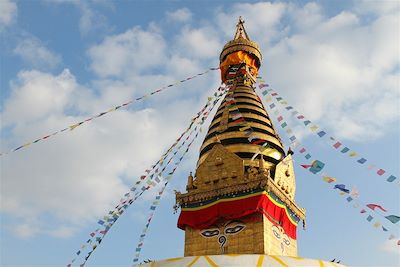
à partir de 3 990 €
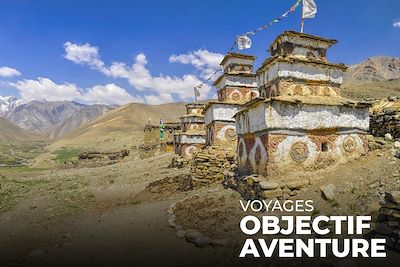
à partir de 7 990 €
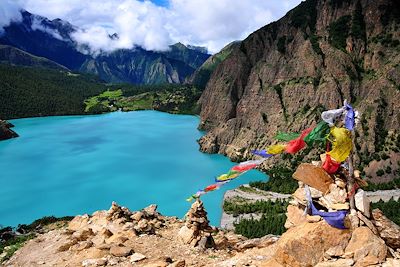
à partir de 5 490 €
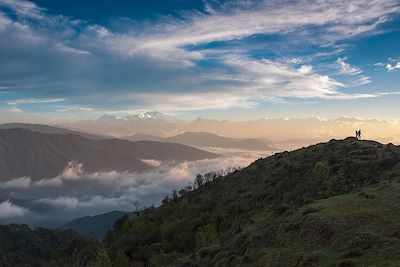
à partir de 5 390 €
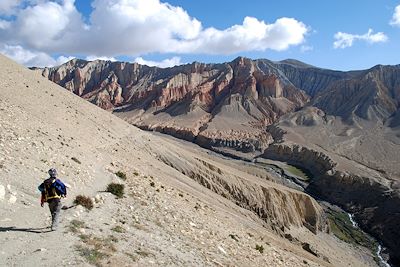
à partir de 4 790 €

I Wish to Travel
Manaslu trek.
- USD 1760.00 starting from
- We can customize the trip as per your requirement.
- Price according to the size of the group.
- We can help you to fit in your budget.
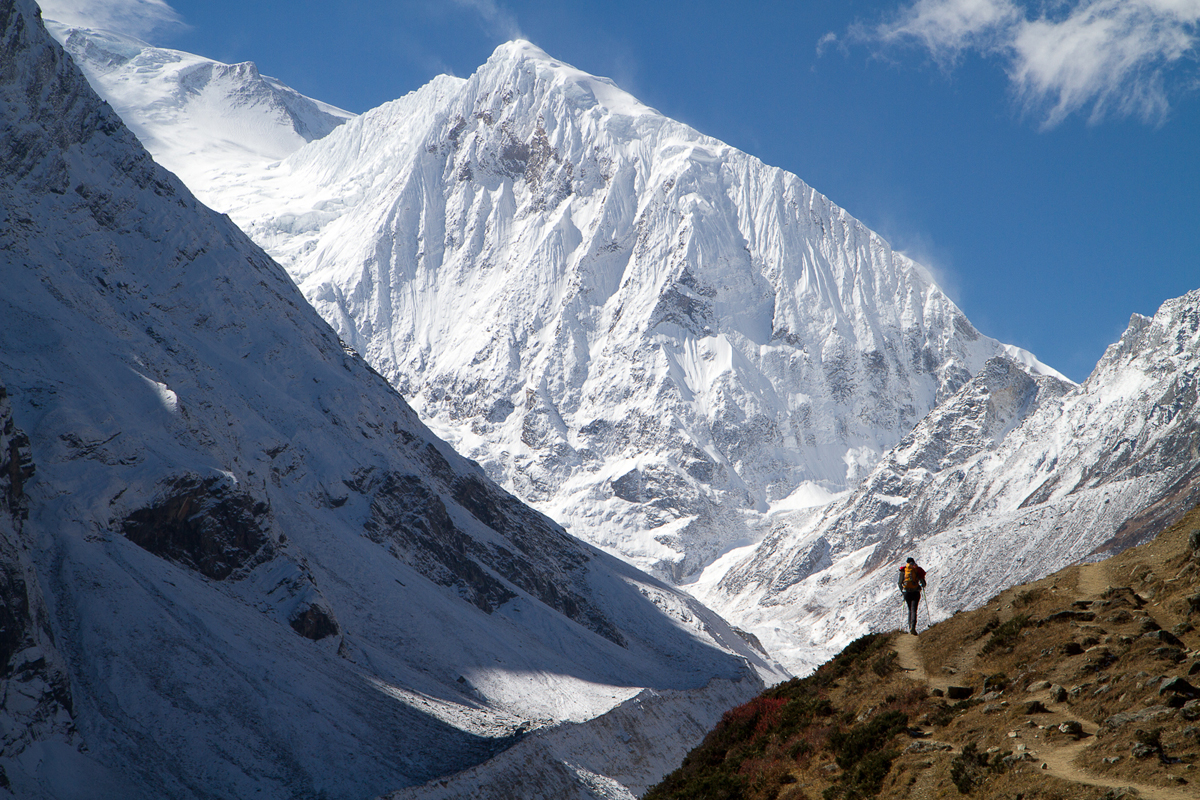
- Level of Trek: Difficult
- Best Period: March - April & October - November
- Duration: 18 Days
- Number of walking days: 13
- Highest Altitude: 5160 Meters
- Accomodation: Hotel in Kathmandu & Lodge during trek
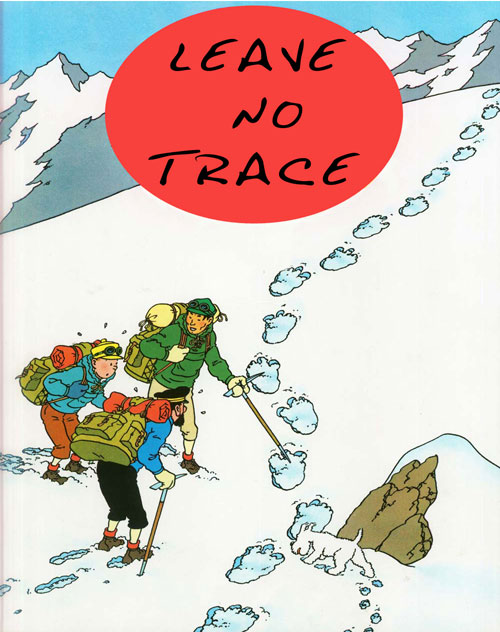
For your next trek with us in the Himalayas, travel light and aware: Base Camp offers you a biodegradable soap made in Nepal, to leave no trace ...
1 ARRIVAL IN KATHMANDU
2 full day sightseeing in kathmandu.
A day to discover the gems of Kathmandu Valley, visit Pashupatinath, the holiest Shiva shrine for Hindus dating back to the 12 th century. It also serves as the cremation grounds for Hindus, while pilgrims come to bathe in the sacred Bagmati River. We then move across to Boudha, the largest Buddhist stupa where devotees circumambulate throughout the day. Both these monuments are designated UNESCO World Heritage Sites. Then we walk through the delightfully narrow streets of old Kathmandu. After lunch, we drive to Bhaktapur, a beautiful medieval city of the Newar people with exquisite temples, museums and galleries. - Self meal - Accommodation: Same hotel
3 KATHMANDU - GORKHA - BALUWA (600M) - BARPAK (2000 M)
4 barpak - laprak (2 200 m) gumda (1800 m), 5 gumda - khorla bensi (970 m), 6 khorla bensi – jagat (1370 m), 7 jagat – philim - eklebhatti – pewa (1800m), 8 pewa - ghapsya (2380 m), 9 ghapsya - lhö gaon (3100 m).
With luck, we will meet many pilgrims, some coming from Tibet following the famous salt route. After crossing many villages sometimes housing monasteries, climbing gradually, we will end up with a steep climb bringing us to the large village of Lhö Gaon. The closer we get to the village, the clearer the view will be until we see the Manaslu on which we can observe the sunset as well as the morning light when we wake up the next day. Depending on the weather and time of arrival, we will have the opportunity to take a walk before dark to the monastic school located on top of a hill on the outskirts of the village. - Ascent: 800 meters - Walking time: 6h30 - Accommodation: Lodge
10 LHÖ GAON (3100 M) – PUNGYEN GOMPA (4060 M) – SHYALA GAON (3400 M)
11 shyala - samagaon (3550 m).
Day of walking facing the Manaslu through the stone villages and the first steppe panoramas. Once installed at the Samagaon lodge, always depending on the time and the climate, we can take a leisurely walk to Lake Birendra, a magnificent sky blue, surrounded by numerous cairns. You will then have the opportunity to overlook the valley to admire the view as well as to acclimatize thanks to a break by the lake at 3900m. - Ascent: 600 meters (350 meters to go to the lake) - Descent: 400 meters (350 meters to return from the lake) - Walking time: 4 (+2h walk for the lake) - Accommodation: Lodge
12 SAMAGAON - SAMDO (3800 M) + WALK & ACCLIMATATION
We climb up gradually to arrive at the village of Samdo. Then, if the weather and our own conditions are favorable, we can take an acclimatization walk of 1 or 2 hours up to 4000 m. on one of the bordering mountains. - Ascent: + 400 m. - Walking time: 4hr - Accommodation: Lodge
13 SAMDO - DHARMASALA (4 460M)
In Samdo, we may have the opportunity to see an improvised trade between Tibetans and local people. We climb gradually through the glacial valley followed by an hour of steep climbing and reach the foot of the Larkya Glacier. We spend the night in tents in the village of Dharmasala. We then set up a fixed camp planned for those who wish to climb up to Larkya Pass (5,106 m). - Ascent: + 800 m. - Walking time: 4 hr - Accommodation: Lodge
14 DHARMASALA - LARKE PASS - BHIMTHANG (3 600M)
It’s going to be a long day, so we start early, leaving by 4 am, under the starry sky with our headlamps on. As we climb up, we watch the dawn of a new day and the surrounding mountains lit up by the colorful morning light. We cross the Larkya La Pass and from the top, the view is simply astounding. Then, it is a long and steep descent over a dry path to Bhimthang where we overnight in a lodge. - Ascent: + 800 m. - Descent: - 1400 m. - Walking time: 8 hr - Accommodation: Lodge
15 BHIMTANG - DHARAPANI (1860 M)
Descent into the forest to the river to arrive at the village of Tiliche inhabited by Manangi Tibetans. We continue our descent to Dharapani: the junction point to take the Annapurna trail/night in Dharapani - Descent: 1940 meters - Walking time : 6 hrs - Accommodation: Lodge
16 DRIVE DHARAPANI – BAHUNDANDA (1310 M) (HOT SPRING AT JAGAT IF POSSIBLE)
17 drive bahundanda - besisahar – kathmandu.
1h30 by local jeep reserved then we find a private vehicle to return from Besisahar to Kathmandu. Free time - 5+1h30 hrs drive / 7 hours drive from Jagat - Accommodation: Hotel Holy Himalaya in BB or similar
18 DEPARTURE
What's included, what's not included, see price for private trip, fix departure dates and confirmation.
- Date Price per person Reservation Status
- 10/06/2024 - 06/10/2024 - 23/10/2024 price per person USD 1760 Book Now confirm
- - 11/06/2024 20/10/2024 - 06/11/2024 price per person USD 1760 Book Now not confirm
- 11/03/2024 - 03/11/2024 - 20/11/2024 price per person USD 1760 Book Now confirm
Suppliments
>> Single room in Kathmandu (3 nights): 90 US$
CLIENT REVIEW
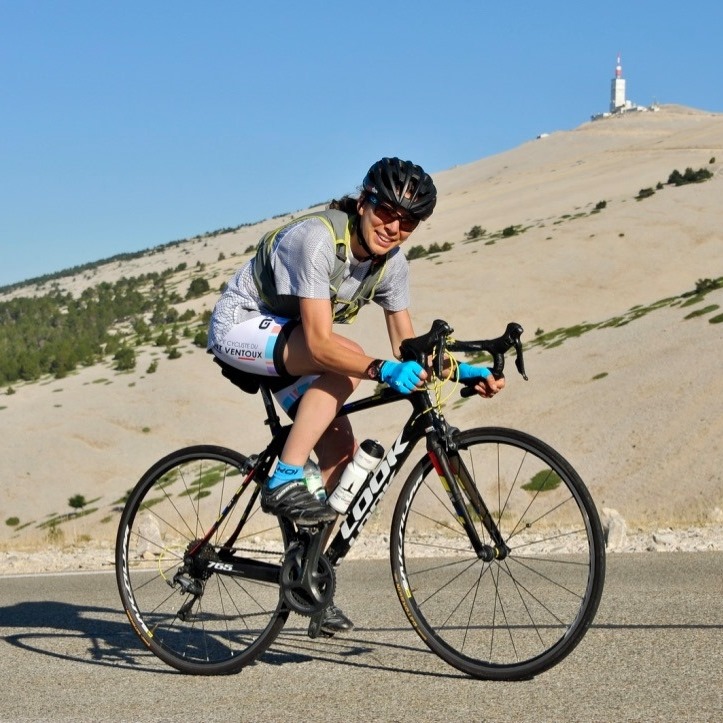
Laurianne Petit Trip (Voyage) : MANASLU TREK Date of Trip : 17/12/19 - 02/01/20
Dear Jérôme and Fabien, A second experience with your agency. What can I say about the marvelous trek, perfect in every way (lodge, "off the beaten track" aspect, meetings and routes…) Above all, I would like to point out to Stéphan: • The exceptional competence, kindness and attentiveness of Pasang, • The courage, skill and incredible work that went beyond porting Mingma. A second guide with the same qualities! They were an incredible and complementary team. Sanu, our driver, is also a traveling companion that we appreciated! So a big thank you for this experience, this dream fulfilled. We will be happy to come back to you! Best regards, Laurianne Petit.
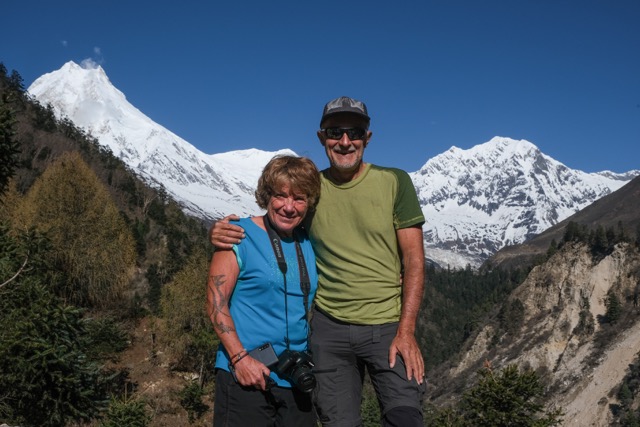
Pierre FOLLAN Trip (Voyage) : MANASLU TREK Date of Trip : 14/04 - 01/05/2019
last April we did trek with Base Camp agency to Around Manaslu. It was a beautiful trek, everything went very well. I plan to return in September, October, November to Nepal.
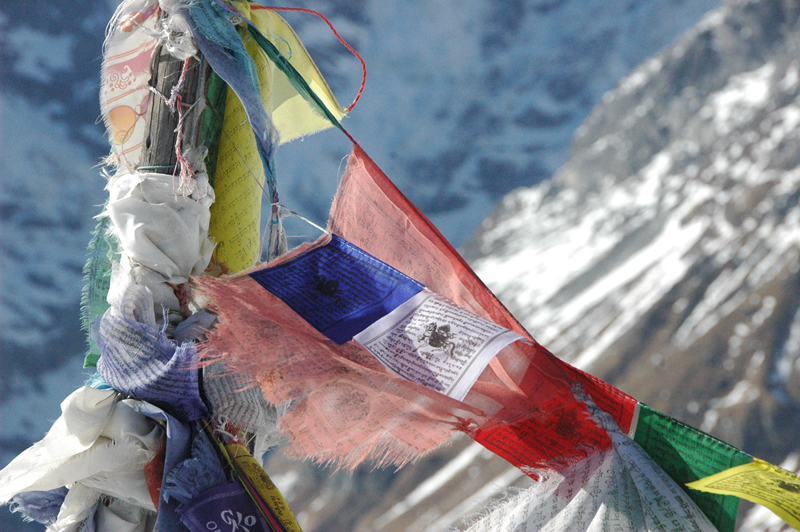
Evelyne & Nacerdine BELLAL Trip (Voyage) : MANASLU TREK Date of Trip : 20/10 - 06/11/2019
Evelyne et Nacer Bellal
MORE ITINERARIES
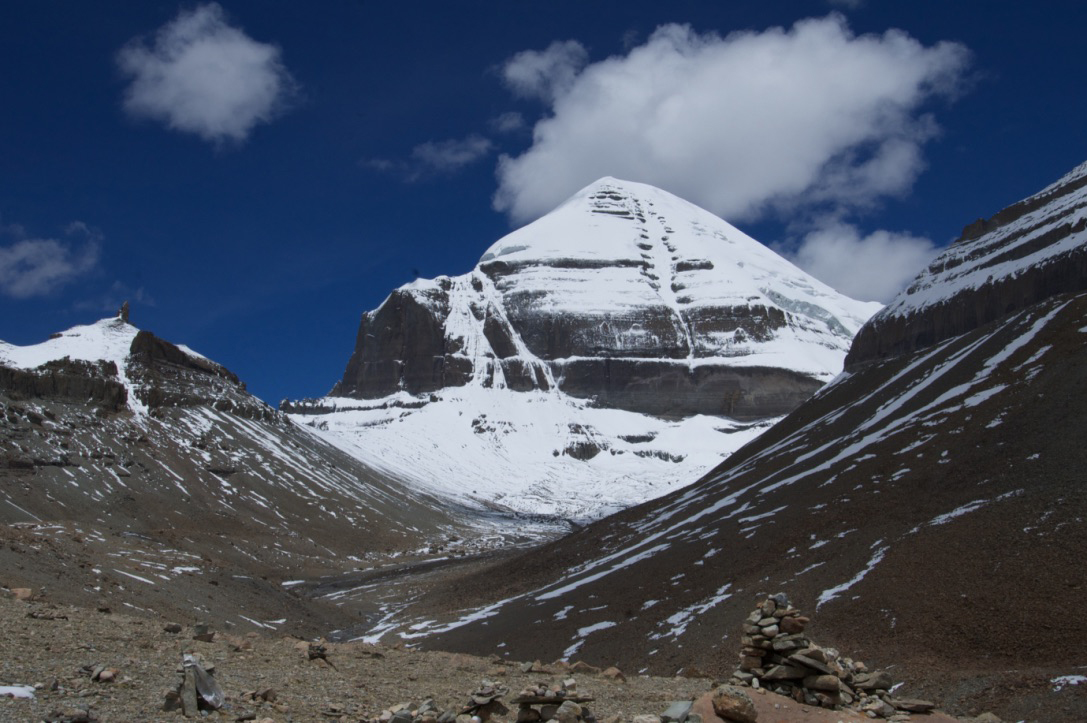
- Aragon (Ordesa - Aneto)
- Bardenas Reales
- Béarn (vallées d'Aspe et d'Ossau)
- Catalogne - Costa Brava
- Encantats - Val d'Aran
- Haute-Garonne - Luchonnais
- Hautes-Pyrénées (Néouvielle - Gavarnie)
- Pays Basque
- Pays Cathare
- Picos de Europa
- Pyrénées Orientales
- Sierra de Guara
- Camino del Norte
- Camino Francés
- Chemin d'Arles
- Via de la Plata
- Via Lusitana (chemin portugais)
- Voie du Puy-en-Velay
- Massif Central
- Normandie - Iles anglo-normandes
- Pays Basque français
- Pays de la Loire
- Provence Côte d'Azur
- Pyrénées françaises
- Vosges - Alsace
- Grèce - Cyclades
- Kirghizistan
- Ouzbékistan
- Tadjikistan
- Île Maurice
- Hautes-Pyrénées
- Vendée - Charente-Maritime
- République Tchèque
- Voyage à vélo
- Voyage à pied
- Balade et découverte
- Balnéo - Thalasso
- Croisière - Bateau
- Multiactivités
- Randonnée avec animal de bât
- Iles et littoral
- Culture et nature
- Forêt tropicale
- Terres polaires
- Fleuves et canaux
EN GROUPE ACCOMPAGNÉ
Intégrez un petit groupe (de 4 à 15 personnes) avec un accompagnateur ou un guide de montagne sur des dates déjà programmées. Le départ se fait lorsque le minimum de participants est atteint : la date est alors confirmée. La formule accompagnée est souvent à l’origine de belles amitiés.
VOYAGES EN LIBERTÉ
Vous êtes autonome : vous partez en voyage avec qui vous voulez et sur les dates de votre choix avec traces GPX, topo-guide et cartes. Vous ne bénéficierez pas des services d'un accompagnateur, sauf sur quelques séjours à l'étranger. Dans tous les cas, un représentant local est sur place. Notre appli “Mon eTopo Balaguère” est disponible sur certains circuits.
VOYAGES EN FAMILLE
En groupe accompagné ou en liberté, nos voyages spécialement conçus pour les familles sont adaptés à l’âge de vos enfants avec des randonnées plus courtes ou des dénivelés limités, mais toujours avec des activités ludiques !
- Qui sommes-nous ?
- Balaguère pratique
Tour du Manaslu
Tous nos treks et randonnées à pied, le voyage en résumé.
Un itinéraire en boucle tout aussi grandiose que le tour des Annapurna, mais bien moins fréquenté, un best off au Népal ! Une montée progressive nous conduit au village de Samdo et au col, le Larkya pass (5 200 m), après avoir traversé tous les étages de la végétation, des rizières en espalier aux ambiances minérales de la montagne et des glaciers. Le sourire et la gentillesse des Népalais resteront probablement un souvenir tout aussi fort que les paysages…
En groupe accompagné
Intégrez un petit groupe avec guide sur des dates déjà programmées. Le départ se fait lorsque le minimum de 4 à 5 personnes est atteint : la date est alors confirmée.
17 jours - 16 nuits. 11 jours de marche
Trek - Népal
Groupe : de 4 à 12 participants
Type d'hébergement : refuge, gîte d’étape, dortoir
Hébergements parfois rustiques, surtout caractérisés par le fait de dormir en dortoirs collectifs de taille variable (de 4 à plus de 10 personnes...). Dans les refuges, la douche n'est pas forcément possible (ou parfois qu'à l'eau froide) ni incluse ; si payante, elle sera à régler sur place par vos soins.
Itinérance : randonnée itinérante
Impose d’arriver à l’étape chaque soir et de changer souvent d’hébergement.
Pour personne très habituée aux séjours de randonnée, pratiquant une activité sportive soutenue au moins 2 fois par semaine. Rythme soutenu.
CO2 100% absorbé :
La Balaguère absorbe 100% de ses émissions carbones. Vous pouvez nous aider à absorber celles liées à votre voyage en participant à hauteur de 10 euros par personne lors votre inscription.
DATES ET PRIX ou poser gratuitement une option Nous sommes actuellement en train de réactualiser les dates et tarifs de ce voyage. Ces informations seront disponibles prochainement.
Les prix affichés ci-dessous sont calculés pour un adulte en fonction des variantes éventuelles (hébergement, aéroport…) et de la date de départ. Pour les voyages en famille : Les réductions enfants et adolescents seront appliquées lors de la prochaine étape.
- {{ departsTitle }}
- {{ item.label }} : {{ item.value }}
- {{ label }}
Du {{ startDate }} au {{ endDate }}
{{webNotes}}
{{ depart }}
Qui est inscrit ?
{{ prediscountPrice }}
{{ price }}
PROMO - {{ discount }} €
Le prix comprend
Le prix ne comprend pas.
- Nous vous proposons en partenariat avec assurinco un forfait complet “assur vacances” (contrat n °6783) : assurance multirisque Annulation + Assistance rapatriement, assurance option COVID comprise.
- Les événements garantis en cas d'annulation : accident, maladie, décès de l'assuré ou du conjoint, des ascendants et descendants, licenciement économique, modifications de congés (voir conditions d'annulation). Le forfait Assur Vacances vous couvre aussi pour le rapatriement, le départ et le retour impossibles, les bagages et l'interruption de séjour.
QUI EST INSCRIT ?
Nombre de personnes minimum :
Nombre de personnes maximum : environ
Nombre de places restantes :
Les participants ( inscrits)
Les intéressés ( devis ou option)
Vous allez adorer
Le temps disponible dans le village de Samdo, le plus haut village de la vallée et la rencontre avec ses habitants.
La contribution à un projet de développement dans un village isolé.
Un trek sportif.
L'excursion sur le glacier de Pungyen.
JOUR PAR JOUR
- paris - katmandou.
Vol entre Paris et Katmandou.
- Hébergement: à bord.
Arrivée à l'aéroport et accueil par un chauffeur. Installation à l'hôtel à Patan. Selon l'heure d'arrivée, vous aurez l'occasion de découvrir la ville de Patan et son ambiance.
- Hébergement: hôtel
- Patan - Macchakhola (930m)
Depuis Katmandou, nous nous dirigeons vers Dhading par une bonne route puis la route devient une piste pour rejoindre Arughat. De là, nous suivons une piste en construction, pour nous rendre à Sothi Khola, puis Macchakhola. La végétation le long de la Budhi Gandaki est subtropicale : bananiers, manguiers, ananas. Dans le cas où la route serait endommagée suite à la mousson, nous passerons la nuit à Soti Khola.
- Temps de transfert: 7 à 9h
- Hébergement: lodge
- Macchakhola - Jagat (1370 m)
Nous quittons Macchakhola pour emprunter un sentier en montée douce longeant la Budhi gandaki. Nous passons à Tatopani pour découvrir des sources chaudes. La vallée, étroite, est ponctuée de cascades magnifiques. Traversée d'un dernier pont suspendu et le sentier à flanc de montagne atteint le gros bourg de Jagat, là où la vallée s'élargit. Jagat marque l'entrée du Parc national du Manaslu. Vous pourrez aussi y admirer un magnifique chorten de pierres qui marquent le début de l'influence tibétaine.
- Temps de marche: 7h
- Dénivelé: + 1210m / - 790m
- Jagat - Deng (1860m)
Nous traversons les villages de Salleri et Sirdi Bash. La vallée y est plus large. On y observe de nombreux moulins à eau. Nous empruntons ensuite une montée jusqu'au village de Philim (centre administratif de la région). Déjeuner à Philim. Depuis Phillim, le chemin alterne entre la rive droite et la rive gauche, aidé en cela par de superbes ponts suspendus. Le sentier, tantôt à découvert, tantôt en forêt, permet d'observer à la fois des rhododendrons arborescents, des pins et des bambous. Nous atteignons le hameau de Deng. Nous entrons alors réellement en pays bothias (habitants d'origine tibétaine). Vous pouvez y observer les enfants vêtus de chubas de laine tissée ainsi que les femmes portant des tabliers colorés.
- Dénivelé: + 820m / - 710m
- Deng - Prok
Nous quittons Deng pour passer sur un pont puis nous montons jusqu'à Rana (1910 m). Les maisons de pierres, aux toits en gros bardeaux, se confondent avec les champs. Nous déjeunons à Bihi Phedi. Le sentier creusé dans la falaise continue à s'élever doucement. Au loin, on observe le plateau de Prok : pour l'atteindre, nous quittons le sentier classique de trek pour nous élever par un sentier en forêt, rive droite. La montée continue jusqu'à la petite centrale hydroélectrique de Prok et les moulins à eau puis rude montée pour atteindre le plateau et les belles maisons de Prok au soleil.
- Temps de marche: 4h30
- Dénivelé: + 920m / - 330m
Journée avec les habitants de Prok. Les femmes tissent de belles ceintures colorées, les hommes poussent des charrues à socle tirées par des Dzos ou, suivant la saison, récoltent l'orge. C'est l'occasion de partager un peu de la vie paysanne en Himalaya. Vous pouvez aider la communauté villageoise en faisant un don au comité des femmes ou bien en achetant sacs ou tissus tissés. Visite de la maison des femmes et du dispensaire. Célébration bouddhiste au monastère du village. Dîner en famille.
- Distance: 14,7km
- Prok - Lho (3180m)
Nous descendons jusqu'au village de Ghap. La marche ; toujours rythmée par le passage des ponts suspendus et les rencontres avec les paysans portant leurs charges sur leurs fronts ; traverse des forêts d'épicéas Montée à Namrung (2550 m) où nous nous arrêtons pour le déjeuner, au pied d'un beau monastère. On se remet en marche en passant par Bengsam et ses grands champs verdoyants et traversons ensuite les villages de Lhi et Shyu. La montée continue jusqu'au grand bourg de Lho (3 130 m) où vous pouvez observer les maisons aux toits en terrasses imbriquées les unes contre les autres. Vous jouirez de vues magnifiques sur le Manaslu (8 156 m) et l'Himal Chuli (7 893 m). Possibilité de visiter le superbe monastère qui surplombe le village.
- Dénivelé: + 1140m / - 400m
- Distance: 24,7km
- Lho à Samagaon (3525m) par Pungen Glacier (4000m)
L'objectif de la journée est une excursion vers le glacier de Punggen (4 000 m). La montée débute en forêt où nous pourrons peut-être observer les faisans de l'Himalaya. Pause à Shyala pour profiter d'un panorama saisissant sur le Manaslu et les sommets voisins à 7 000 m. Nous sommes ici entourés de sommets enneigés tout proches." Puis montée abrupte le long d'un torrent impétueux, qui ensuite se radoucit pour finir par une montée douce jusqu'au monastère de Punggen édifié par Milarepa. La vue est tout simplement prodigieuse, entourée de sommets de 7 000 et 8 000 m : le Himal Chuli, le North Peak, le Ngadi Himal (Peak 29) et le Manaslu. Vous jouissez d'un moment magique dans cette solitude de glace. Puis, nous redescendons pour rejoindre le sentier de Samagaon, grand village aux maisons serrées. Le monastère y domine sur une petite colline. Nuit en lodge à Samagaon.
- Temps de marche: 6h30
- Dénivelé: + 990m / - 760m
- Distance: 18,5km
- Samagaon - Samdo (3880 m) (variante possible par le Camp de Base du Manaslu (4400 m).
Les participants les plus entraînés peuvent monter au Camp de base du Manaslu. Il faut emprunter une montée raide pour vous émerveiller devant les cascades de glace et approcher à nouveau le Manaslu par sa face Nord cette fois-ci. En saison d'expédition, vous atteignez un camp de tentes où des alpinistes du monde entier se retrouvent. Solution plus facile, aller directement à Samdo avec le reste de l'équipe. Le long de la Budhi Gandaki, la montée est douce. Vous observez que les bouleaux succèdent aux mélèzes et atteignez ainsi Samdo (2880 m). Dernier village avant le col de Larkya, ses maisons de pierres s'imbriquent les unes contre les autres. Les yacks vivent au rez-de-chaussée, les habitants à l'étage où ils accèdent par une échelle de bois.
- Temps de marche: 2h30 ou 6h30 selon le choix
- Dénivelé: + 440 ou 1450m / - 50 ou 750m
- Distance: 9,5 ou 14,6km
Vous passez la journée à Samdo pour vous reposer et faire la connaissance des habitants d'origine Tibétaine : https://www.samdoavenir.org/fr/. C'est l'occasion de passer du temps dans le village et d'aller à la rencontre des femmes du comité des femmes très actives et de l'institutrice de l'école. Les plus courageux ont aussi la possibilité de faire une excursion en direction du Tibet avec un jeune guide local.
- Samdo - Dharamsala (4460m)
En quittant Samdo, on traverse une rivière où l'on peut observer une micro centrale électrique. Puis commence une lente montée progressive.au cœur des paysages de haute montagne, ponctuée parfois du souffle des avalanches descendant au loin du Larkya Himal. Passage par des Yakkharka, habitations pastorales d'été. Nuit au lieu dit Dharamsala.
- Temps de marche: 3h
- Dénivelé: + 940m / - 50m
- Distance: 8,6km
- Dharamsala - Bimtang (3590 m) par le Larkey Pass (5160 m)
Départ tôt le matin (vers 4 h du matin) pour monter progressivement vers le col de Larkya. Le sentier que nous emprunterons suit le côté nord d'un glacier et rejoint la moraine rocailleuse. La montée est sans difficulté technique, mais longue. Après un passage à proximité d'un petit lac, nous commençons une montée raide jusqu'à un cairn décoré de drapeaux de prières marquant le col de Larkya. Vous jouissez alors d'une vue magnifique sur le Himlung Himal, le Cheo Himal, et l'Annapurna II. Puis, vous entamez une descente dans la neige puis dans les cailloux. Arrivée à Bimtang, village d'été entouré de sommets enneigés. Nuit en lodge à Bimtang.
- Temps de marche: 8h
- Dénivelé: + 700m / - 1500m
- Distance: 24,5km
- Bimtang - Darapani (1960 m)
En quittant Bimtang, nous descendons jusqu'à la rivière Dudh Khola. Nous marchons sur les vestiges d'un glacier dégringolant du Cheo Himal et évoluons dans une forêt de rhododendrons. De là, vous jouissez d'une belle vue sur le Kampung Himal. Nous marchons jusqu'à Tilige (2300 m), ce grand village gurung aux boiseries sculptées. Puis, nous empruntons un sentier sur l'autre versant de la Dudh Khola jusqu'à Darapani (1920 m) sur le sentier du tour des Annapurnas où les lodges sont désormais équipés de douches chaudes et les magasins bien achalandés.
- Temps de marche: 7h15
- Dénivelé: + 350m / - 2150m
- Distance: 26,3km
- Darapani - Besisahar - Patan
Nous prenons la jeep pour nous rendre à Besisahar en empruntant une piste impressionnante creusée dans la falaise. Arrivée à Besisahar, un véhicule nous attend pour nous conduire à Patan.
Temps libre et transfert pour l'aéroport, en fin de journée pour un retour sur Paris ou nuit à l'hôtel et vol le lendemain.
- Hébergement: hôtel ou dans l'avion
- Katmandou - Paris
Arrivée à Paris
SAMDO AVENIR Si vous voulez aider une ONG, nous vous conseillons de vous rapprocher de cette association : https://samdoavenir.org/fr/ L'association Samdo Avenir vise à contribuer au développement éducatif, sanitaire et économique de communautés villageoises népalaises. Sa vocation est la scolarisation des enfants tenus à l'écart de l'école, que ce soit pour des raisons d'éloignement géographique ou de manque de ressources. Le projet concerne les villages de Samdo et Magarsalu, l'objectif est principalement de scolariser les enfants jusqu'à la fin du cycle secondaire. En parallèle de cet objectif, un deuxième volet du projet est de favoriser un développement économique autonome de ces deux villages. Il est possible de faire un don ou de parrainer des jeunes.
INFOS TECHNIQUES
Détails pratiques, formalités et santé, infos covid.
Difficile, 5 à 7 heures de marche par jour pendant 11 jours, avec possibilité de quelques passages dans la neige. Altitudes : de 900 m à 5 160 m (le jour du passage du col de Larkya la marche peut durer 9 h). Il est nécessaire d'être en bonne condition physique et d'avoir le "pied montagnard". Lors de ce séjour, pour des raisons de sécurité, il est prévu un caisson hyperbare et un téléphone satellitaire.
DÉPART GARANTI À PARTIR DE (pers.)
Groupe limité environ à (pers.).
Uniquement les affaires de la journée.
ENCADREMENT
À partir de 4 participants, guide de trekking népalais francophone et secondé d'un assistant guide.
HÉBERGEMENT
En lodge (hébergement rustique de type refuge, la plupart du temps en chambre double) pendant le trek, en hôtel de bonne catégorie à Patan ou Katmandou, 1 ou 2 nuits dans l'avion.
La nourriture locale est saine et abondante : au petit-déjeuner, thé, chocolat chaud, toasts, confiture, œufs et céréales. Les déjeuners et dîners sont composés de salades, de salami, œufs, fromage, pommes de terre frites, poulets et toujours du riz…
DÉPLACEMENTS
En minibus entre Katmandou et Arughat et jeep publique entre Arughat et SotiKhola.
POUR FAIRE LE BON CHOIX
Accédez à nos explications détaillées sur le type de randonnée, le niveau les hébergements, et la notion de portage... Comment choisir son séjour ?
TRANSPORT BAGAGES
Pendant la randonnée, les bagages sont portés par des porteurs.
Les bagages
1 sac de voyage ou un grand sac à dos pour contenir l'ensemble de vos affaires de façon étanche (dans des sacs plastiques par exemple). Proscrire les sacs rigides ou valises. 1 petit sac à dos (30 à 50 l) pour les affaires de la journée et les treks
Les vêtements
1 chapeau et 1 bonnet 1 buff plusieurs tee-shirts sous-vêtements en fibre thermique ou mérinos (haut et bas) 1 fourrure polaire chaude ou un bon pull en laine, 1 veste polaire coupe-vent ou softshell 1 veste de montagne (ou gore tex) 1 veste en duvet 1 cape de pluie 1 pantalon de montagne (trekking) déperlant 1 pantalon de voyage détachable ou pantalon léger 1 legging 1 short 1 paire de gants ou de moufles de montagne + 1 paire de gants de soie (si le séjour se déroule en altitude ou en milieu hivernal) 3 ou 4 paires de chaussettes de marche. Privilégier la laine ou les chaussettes spécifiques randonnées. Évitez le coton (ampoules) 1 maillot de bain 1 paire de bonnes chaussures de marche déjà rodées et tenant bien la cheville 1 paire de chaussures de rechange 1 paire de guêtres (facultatif) des vêtements et des chaussures confortables pour le soir
Le matériel à emporter
1 nécessaire de toilette minimum (produits biodégradables), lunettes de soleil de bonne qualité 2 gourdes d'un litre et/ou un thermos 1 couteau pliable (à mettre en soute) 1 lampe frontale et piles de rechange 1 réveil de voyage (départs matinaux) 1 paire de bâtons télescopiques 1 drap de sac en soie ou polaire 1 sac de couchage chaud (confort - 10°) + une couverture de survie des chaufferettes (à glisser dans vos moufles) votre appareil photo, batteries de secours, chargeur et un adaptateur
Autres précisions équipement
Pour ce séjour, merci de prévoir en plus : - une doudoune chaude pour le soir et les passages en altitude - des guêtres, - des gants de ski ou en gore tex et chauds. Il est possible de louer du matériel, type sac de couchage, sur place à Katmandou (environ 2 €/j). Merci de nous avertir avant, si vous souhaitez louer du matériel, afin de vous laisser du temps sur place à votre arrivée. D'autre-part, une recrudescence de dingue sévit au Népal, pensez à prendre des répulsifs à moustiques puissants. Enfin, nous vous conseillons : - De ne pas vous encombrer inutilement (le poids des bagages à confier aux porteurs est de 12 kg maximum). Vous aurez la possibilité de laisser des affaires à l'hôtel à Katmandou que vous retrouverez à la fin de votre trek. - De ne pas lésiner sur la qualité du matériel qui devra, pour les vêtements, être léger, solide et chaud. - L'idéal est d'avoir son propre matériel que l'on connaît et dont on est sûr. Mais s'il vous manque la moindre pièce d'équipement, vous pourrez l'acheter ou le louer à Katmandou qui reste le principal centre de location à des prix, très raisonnables. - Lors de votre enregistrement, pensez à mettre dans votre bagage en soute, votre couteau de poche et tout objet tranchant ou piquant, sinon il vous sera confisqué à l'embarquement.
Matériel fourni par la Balaguère
- sac d'expédition - sur-sac Lors de nos treks au Népal, nous mettons à votre disposition sur place à Katmandou, un sac d'expédition dans lequel vous pourrez glisser vos affaires de randonnées pour les jours de marche. Ce sac sera protégé dans un sur-sac, porté par les porteurs et acheminé à l'étape du soir. Ce sac contiendra donc vos affaires de trek uniquement et ne devra pas dépasser 12-13 kg/personne. Cela vous laisse la possibilité de voyager avec des valises/sacs à roulettes, bien plus commodes dans les transports en France et au Népal et de laisser des affaires propres pour votre retour à Katmandou. À la fin de votre séjour au Népal, vous remettrez sac d'expé et sur-sac à notre équipe sur place.
Pièce d'identité
Passeport valide plus de 6 mois après la date de retour.Les mineurs doivent posséder leur propre passeport. ATTENTION : l'autorisation de sortie du territoire est obligatoire pour tout mineur voyageant sans ses deux parents. A compter du 15/01/17, tout mineur qui voyage à l'étranger sans être accompagné de ses parents devra être muni de sa pièce d'identité en cours de validité (carte d'identité ou passeport selon la destination), d'un formulaire signé par l'un des parents titulaire de l'autorité parentale (autorisation de sortie du territoire), de la photocopie de la pièce d'identité du parent signataire. Pour plus d'informations nous vous invitons à vous rapprocher de votre mairie.
Informations à jour au 03/04/2023 Visa à faire pour le Népal : - auprès de l'ambassade du Népal a Paris - en ligne sur le site https://www.immigration.gov.np/ - ou à l'arrivée à l'aéroport de Katmandou. Si vous optez pour le visa a l'arrivée, prévoir 200$ ou l'équivalent en € pour le règlement (système de paiement en ligne générant de longues files d'attente et la connexion web n'est pas très fiable). Pour information coût : - 35$ pour un visa de 15 jours maximum - 55$ pour un visa de 30 jours maximum Schéma vaccinal COVID Prévoir de présenter un schéma vaccinal complet ou un test PCR négatif de moins de 72 heures. Formulaire à remplir avant l'entrée sur le territoire : https://ccmc.gov.np/ Conserver le code barre généré et par précaution, penser à l'imprimer.
Infos complémentaires
Prévoir 1 photo d'identité qui servirat localement pour établir les permis de trekking. Fournir au moment de votre inscription le scan de votre passeport + le scan d'une photo d'identité. Dans le cas où vous ne souscririez pas à l'assurance de la Balaguère, merci d'amener une attestation de votre assurance mentionnant la prise en charge des secours en montagne par hélicoptère.
Vaccins obligatoires
Pas de vaccination obligatoire mais s'assurer d'être à jour pour Diphtérie, Tétanos et Polio (DTP rappel tous les 10 ans) et tuberculose. Typhoïde et hépatites conseillées.
Le climat à Katmandou
Powered by Froala Editor
DÉCALAGE HORAIRE
+ 3H30 en été / + 4h45 en hiver
Infos covid spécifique au séjour
Nous vivons désormais avec le COVID et connaissons tous les gestes barrières et les préconisations sanitaires. Néanmoins, nous vous conseillons pour votre tranquillité d’esprit, de vous tester avant votre départ. Si la France n’oblige plus à l’isolement en cas de contraction du covid depuis le 1er février 2023, il n’en est pas de même dans tous les pays. Ainsi, si vous êtes contaminé à l’étranger, c’est la législation d’isolement (ou pas) du pays qui s’applique. Si vous vous inscrivez seul(e) en chambre à 2 lits (« twin »), vous acceptez d'assumer les conséquences éventuelles liées au partage de la chambre (et donc de la salle de bain et des sanitaires) avec une autre personne du groupe vaccinée ou non-vaccinée. Dans le cas contraire, nous vous recommandons de souscrire à l'option « supplément chambre individuelle » dans la mesure des possibilités. Le guide (pour les séjours accompagnés) sera à votre écoute. Digne de confiance, n'hésitez pas à lui confier en premier lieu vos craintes ou problèmes. Il fera le maximum pour vous apporter son aide et tâcher de résoudre la situation de manière efficace. Par ailleurs, lui et les hôtes qui vous recevront (hôteliers, restaurateurs, transporteurs, équipes locales...) sont les garants du bon déroulement du séjour et vous demanderont d'appliquer certaines consignes sanitaires, si cela est nécessaire.
AVIS DE VOYAGEURS
Privatisation du voyage.
Constituez votre propre groupe sur ce circuit à la date de votre choix à partir de 8 personnes pour un circuit à l'étranger, à partir de 10 personnes pour une randonnée en France ou dans les Pyrénées (sauf exception).
Tous les treks et randonnées Népal
Les voyageurs qui aiment ce voyage ont aimé également
Népal le langtang et lacs de gosainkund, à la frontière du tibet, népal tour des annapurnas, népal trek en solu, authenticité et monastères, balcon sur l'everest, népal extension à chitwan.
You are using an outdated browser. Please upgrade your browser to improve your experience and security.
- Payez maintenant
- Rejoindre un groupe
Tour du Manaslu
Vallée de la rivière Budki Gandaki. Si, ciel claire au sommet du col de Larke Pass (5135m ) vues splendides, grandioses…….sur le Cleo Himal (6820m), le Nemjung (7140m), le Gyaji Kang (7038m) et le Kang Guru (6981m). Vallées des rivières Dulh klola et Marsyangdi. L’authenticité des villages de Samdo et Samagon au pied du Manaslu.
2 - 15 Persons
Hôtels et lodges
Moyen / assez difficile
Mars - Mai / Sept - Nov
Tourisme / trekking
Vos affaires de la journée
Aperçu du voyage
Le tour du Manaslu est l’un des itinéraires de trekking les plus populaires de l’Himalaya. Quoique voisin, ce trek est moins fréquenté que celui du célèbre massif ( tour des Annapurna , séparé par la vallée profonde, grandiose de la Marsyangdi, a conservé un caractère très particulier où se conjugue vie ancestrale et tradition. Plus difficile, n’est pas recommandé aux randonneurs occasionnels. Ce circuit plus spectaculaire presque intact, plus scénique.
Ses sentiers plus ardus. Cette région est protégée par un parc naturel, pour s’y déplacer, il faut un permis spécial, ouvert à la randonnée depuis 1991. Depuis peu de temps, tout au long de ce parcours des lodges (teahouses) sont nées. Question de choix : les puristes peuvent effectuer ce trek en camping. Nous entrons dans l’univers mythique de la haute montagne , de la vie traditionnelle tibétaine (allée et venue incessant de caravanes de yacks commerçant avec le Tibet si proche de nos yeux : quelques encablures !).
Beauté des paysages, diversités des villages, le Manaslu (8163 m) se détachant, 8éme sommet emblématique de notre planète (à partir de Jagat, il sera toujours présent).
Les points forts durant votre séjour
- Quoique voisin, ce trek est moins fréquenté que celui du célèbre massif
- Quoique voisin, ce trek est moins fréquenté qu
Outline Iitinéraire
- Day 1 : Arrivée par votre vol international à l’aéroport Katmandou (Tribhuvan).
- Day 2 : Visite guidée et commentée par un guide culturel des principaux sites historiques de Katmandou.
- Day 3 : KTM - Arughat : 150 kms environ effectué en bus local.
- Day 4 : Arughat - Soti Khola (620 m) : 5 heures de marche environ.
- Day 5 : Soti kola – Machha Khola (900m). 6 heures de marche environ.
- Day 6 : Machha Khola – Jagat (1340m). 7 heures de marche environ.
- Day 7 : Jagat – Dyang (1860m). 7 heures de marche environ.
- Day 8 : Dyang - Namrung ( 2540m). 7 heures de marche environ.
- Day 9 : Namrung – Syala (3590m). 6 heures de marche environ.
- Day 10 : Syala - Sama gompa (gaon)(3390m) via Pungen Gompa. 7 heures 30 de marche environ.
- Day 11 : Journée libre pour l’acclimatation.
- Day 12 : Sama gompa – Samdo (3690m). Durée du trajet environ 4 heures.
- Day 13 : Samdo – Dharmasala ( 4460m) : 5 heures de marche environ.
- Day 14 : Dharmasala – Bhimthang (3590m) via Larke La (5215m). Durée du trajet entre 7 et 8 heures.
- Day 15 : Bhimthang - Tilje (2300m). Durée du trajet environ 6 heures 30.
- Day 16 : Tilje - Tal ( 1680m). Durée du trajet environ 6 heures 30.
- Day 17 : Tal – Jagat (1300m). 6 heures de marche environ.
- Day 18 : Jagat – Ngadi ( 920m). 6 heures de marche environ
- Day 19 : Début matinée départ de Ngadi en bus local pour KTM.
- Day 20 : Journée libre à KTM.
- Day 21 : Départ vers votre pays.
Detailed Iitinéraire
Null jour 01: arrivée par votre vol international à l’aéroport katmandou (tribhuvan)..
Accueil par le représentant de notre agence, transfert et installation à votre hôtel. Altitude 1350 m.
null Jour 02: Visite guidée et commentée par un guide culturel des principaux sites historiques de Katmandou.
Pashupatinath « gardien du Népal », est le plus sacré des sanctuaires de Shiva (dieu de la Vie et de la Mort) sur la rivière Bagmati (lieu de crémation). Multitudes de petits temples avec leurs Sadous, éparpillés dans une forêt où vit une importante population de singes.
Le grand stupa bouddhiste Bouddhanath est le plus grand du monde. Sa tour carrée, dont chaque face, porte striés de rouge, les immenses yeux divins (éternels) fixant chaque point cardinaux. Ambiance certaine au milieu des vapeurs d’encens, chants et prières tibétaines.
Nous terminerons notre visite en montant un immense escalier de cinq cents marches bordé de sculptures d’animaux apocalyptiques qui nous conduit au vaste ensemble de Swoyambhunath l’un des stupas les plus anciens de la vallée de KTM implanté sur le sommet d’une colline. Enchevêtrement de temples et de sanctuaires des deux religions.
null Jour 03: KTM - Arughat : 150 kms environ effectué en bus local.
Suivant la circulation, les arrêts, incidents de parcours éventuels, il faut compter environ 6 heures de route.
null Jour 04: Arughat - Soti Khola (620 m) : 5 heures de marche environ.
Début de la randonnée. L’acclimatation très progressive. Remontons la riviére Budhi Gandaki (quelques plages de sable) entourée de champs cultivés et irrigués, jusqu’au hameau de Kokhethar. Les singes nombreux viendront peut être vous souhaiter « Namasté ».Traversons les jolies villages (Magar/Gurung), atteignons la rivière de Arkhat, montée sur kyoropani.
null Jour 05: Soti kola – Machha Khola (900m). 6 heures de marche environ.
Descente légère, passage d’une crête jusqu’à Almara, puis piste forestière jusqu’à Riden Gaon. La vallée se sépare en deux, longeons le Budhi Gandaki, traversons le village de Lambesi. Le paysage change franchement, les rives de pentes boisées se transforment peu à peu en falaises Chemin empierré, montées et descentes. Plus haut, à Lapbesi, la vallée s’élargit de nouveau, suivons large lit de sable blanc.
null Jour 06: Machha Khola – Jagat (1340m). 7 heures de marche environ.
Les cultures se font de plus en plus rares. Longeons la rivière Budhi Gadaki rive gauche entre ses 2 falaises jusqu’à Tatopani (sources chaudes thermales pour les autochtones). Ce village dispose d’un dispensaire. Passons rive gauche, suivons une route forestière à travers nombreux éboulis, franchissons la rivière Dovan Klola très tumultueuse, traversons le village de Dovan. Montées et descentes. Traversons un plateau, un long pont suspendu de 93 m environ au dessus du Yaru Khola (rapide), grimpettes raides, long escalier, très hautes falaises rocheuses, arrivons à Jagat (1er village de ce nom sur ce parcours, rien à voir avec le second se trouvant en fin de trek) : village typique aux fenêtres sculptées, aux ruelles pavées. Première Stupa ou Chöten indiquant l’entrée dans une région d’obédience bouddhiste tibétaine. Poste de contrôle.
null Jour 07: Jagat – Dyang (1860m). 7 heures de marche environ.
2 rivières se rejoignent en double cascades : spectacle magnifique. Montée jusqu’à Saguleri, vue sur la Sringi Himal (7117m), continuons en direction de Sirish. La vallée se rétrécit, encaissée à l’extrême, parois abruptes. Le paysage devient alpin, magnifiques forêts de pins bordent le chemin. Empruntons un sentier en balcon taillé dans la falaise, en dessous le vide. Traversée du joli village de Nyak. Vue sur les massifs du Ganesh Himal et Himal Chuli.
null Jour 08: Dyang - Namrung ( 2540m). 7 heures de marche environ.
Traversées de villages tibétains ( Bihi,Ghap, chhak ) avec leur « mami / murs de pierres gravées » et les moulins à prières. Le sentier peut être délicat (parfois des éboulements).Traversées de plusieurs ponts suspendus aux allures…A 20 minutes au-dessus du village étape, vous pourrez visiter les 2 Gompas, à la lisière d’une forêt où vivent singes, daims et autres animaux.
null Jour 09: Namrung – Syala (3590m). 6 heures de marche environ.
Montée à travers forêt d’épicéas et bambous. Magnifique vue sur les crêtes formant frontière avec le Tibet. Traversées des villages de Barjhang entouré de ses champs d’orge suivant la saison, Sho gardé à son entrée et sortie par deux Chörtens (le protégeant des mauvais esprits. Plafonds et murs internes recouverts de peintures religieuses). Soudain apparaissent le seigneur Manaslu, l’Himal Chuli (7893m). Traversée du beau village Lho fait de pierres sèches. Un raide chemin nous conduit à Shyala, village de bûcherons : époustouflante vue panoramique.
null Jour 10: Syala - Sama gompa (gaon)(3390m) via Pungen Gompa. 7 heures 30 de marche environ.
Null jour 11: journée libre pour l’acclimatation., null jour 12: sama gompa – samdo (3690m). durée du trajet environ 4 heures..
Sommets impressionnants avec leurs glaciers. Tout au long de ce trajet, vous côtoyez Mani Korlo (moulin à prières) et Mani Dong (mur de pierres sculptées). Un grand Khani blanc marque l’entrée de Samdo (village le plus haut de la région, construit par les réfugiés tibétains).
null Jour 13: Samdo – Dharmasala ( 4460m) : 5 heures de marche environ.
Montée très progressive. Sommets et glaciers toujours aussi resplendissants, murs gravés de prières. Possibilité l’après midi de se promener sur les hauteurs environnantes, peut-être rencontrer quelques cervidés himalayennes ( Naurs en bandes).
null Jour 14: Dharmasala – Bhimthang (3590m) via Larke La (5215m). Durée du trajet entre 7 et 8 heures.
Départ à la lampe frontale tôt le matin : la haute montagne est là. Montée progressive du col (peut être enneigé quelque soit la saison) longeons le côté du lac du glacier, en point de mire, le très beau pic Larke (6219m). Atteignons le dessus de la moraine : c’est le col de Larke (5125m), où les drapeaux de prière claquent au vent. La descente en est raide à travers des moraines, panorama grandiose et fabuleux sur le cirque du Péri Himal. A Bhimthang, vous pourrez le soir admirer le coucher de soleil sur le Nemjung et le Gyuli Kang.
null Jour 15: Bhimthang - Tilje (2300m). Durée du trajet environ 6 heures 30.
La route est plus facile (vue sur l’immense cirque ouest du Manaslu). Début de montée douce à travers les rizières en direction du col de Karcha La, puis descente à travers une magnifique forêt de figuiers et de rhododendrons avec glaciers en arrière plan. Progressons le long du Dudh Khola véritable torrent.
null Jour 16: Tilje - Tal ( 1680m). Durée du trajet environ 6 heures 30.
Descente le long du Dudh Klola jusqu’à Thonje, point de mélange des eaux avec la rivière Maryangdi, rejoignons la piste retour du tour des Annapurna. Belle cascade à Tal.
null Jour 17: Tal – Jagat (1300m). 6 heures de marche environ.
2éme village de même nom sur ce trek. Descente de la vallée en longeant le tumultueux cours d’eau.
null Jour 18: Jagat – Ngadi ( 920m). 6 heures de marche environ
6 heures de marche environ à travers champs de maïs, millet ou de riz, descente sur les berges de le rivière Marsyangdi. Traversée des villages de Syange et Bahundanda.
null Jour 19: Début matinée départ de Ngadi en bus local pour KTM.
Installation à l’hôtel. Après midi libre.
null Jour 20: Journée libre à KTM.
Null jour 21: départ vers votre pays..
En fonction des horaires de votre vol, transfert le matin ou l’après midi à l’aéroport, puis vol retour vers votre pays.
Le tarif comprend
- Transfert Aéroport / Hôtel (Aller et retour).
- 4 nuits dans un hôtel 2 étoiles à KTM avec petit déjeuner.
- Permis spécial pour Manaslu.
- La taxe d’entrée dans le parc des Annapurna et Manaslu, le nouveau permis de trekker’s Information Management System (TIMS) qui permet d’accéder, en sécurité, aux régions de trekking.
- La pension complète pendant toute la durée du trek.
- L’hébergement en lodge en chambre double.
- L’encadrement par un guide professionnel accompagnateur francophone, accompagné de son équipe {adjoint(s) guide(s)} et porteurs (un porteur pour 2 personnes), leur assurance.
- Les visites commentées par un guide culturel des principaux lieux de KTM le 2éme jour à KTM.
- Tous les moyens de transport pendant votre séjour.
Le tarif ne comprend pas
- Tous les repas pris à KTM, sauf les petits déjeuners.
- Toutes les boissons, avant, pendant, après les repas (excepté 3 boissons chaudes : thé, café, jus de citron concentré……. par jour).
- Bien entendu vos visas d’entrée en territoire népalais, vos assurances indispensables.
- Les visites de lieu(x) en option.
- Les pourboires d’usage laissés à votre discrétion.
Prix et date
Nepal Society Treks and Expediton est une société française basée à Katmandou qui organise une variété de randonnées et de circuits d'aventure. Toutes nos dates sont garanties à 100% jusqu'à et à moins qu'il n'y ait pas de troubles politiques, de catastrophes naturelles ou d'épidémies dans la destination.
- Non disponible
null Why Tour du Manaslu
George mule.
Contrary to popular belief, Lorem Ipsum is not simply random text. It has roots in a piece of classic Latin literature from 45 BC, making it over 2000 years old. Richard McClintock, a Latin professor at Hampden-Sydney College in Virginia, looked up of the more obscure Latin words, consectetur, from a Lorem Ipsum passage, and going through the cities of the word in classic literature, discovered the undoutable source.
- Paiement tout compris
- Réservation facile
Avez-vous une question?
N'hésitez pas à nous envoyer un message. Nous sommes une équipe qualifiée et nous serons ravis de vous répondre.
- +9779851113536
- [email protected]

Se renseigner
Do not hesitage to give us a call. We are an expert team and we are happy to talk to you.
Related Tours
Annapurna base camp, annapurna sanctuary, annapurna circuit, personnaliser votre voyage.
Nom et prénom
Adresse e-mail
Choisissez le pays
Afghanistan Albania Algeria Andorra Angola Antigua & Deps Argentina Armenia Australia Austria Azerbaijan Bahamas Bahrain Bangladesh Barbados Belarus Belgium Belize Benin Bhutan Bolivia Bosnia Herzegovina Botswana Brazil Brunei Bulgaria Burkina Burundi Cambodia Cameroon Canada Cape Verde Central African Rep Chad Chile China Colombia Comoros Congo Congo {Democratic Rep} Costa Rica Croatia Cuba Cyprus Czech Republic Denmark Djibouti Dominica Dominican Republic East Timor Ecuador Egypt El Salvador Equatorial Guinea Eritrea Estonia Ethiopia Fiji Finland France Gabon Gambia Georgia Germany Ghana Greece Grenada Guatemala Guinea Guinea-Bissau Guyana Haiti Honduras Hungary Iceland India Indonesia Iran Iraq Ireland {Republic} Israel Italy Ivory Coast Jamaica Japan Jordan Kazakhstan Kenya Kiribati Korea North Korea South Kosovo Kuwait Kyrgyzstan Laos Latvia Lebanon Lesotho Liberia Libya Liechtenstein Lithuania Luxembourg Macedonia Madagascar Malawi Malaysia Maldives Mali Malta Marshall Islands Mauritania Mauritius Mexico Micronesia Moldova Monaco Mongolia Montenegro Morocco Mozambique Myanmar, {Burma} Namibia Nauru Nepal Netherlands New Zealand Nicaragua Niger Nigeria Norway Oman Pakistan Palau Panama Papua New Guinea Paraguay Peru Philippines Poland Portugal Qatar Romania Russian Federation Rwanda St Kitts & Nevis St Lucia Saint Vincent & the Grenadines Samoa San Marino Sao Tome & Principe Saudi Arabia Senegal Serbia Seychelles Sierra Leone Singapore Slovakia Slovenia Solomon Islands Somalia South Africa South Sudan Spain Sri Lanka Sudan Suriname Swaziland Sweden Switzerland Syria Taiwan Tajikistan Tanzania Thailand Togo Tonga Trinidad & Tobago Tunisia Turkey Turkmenistan Tuvalu Uganda Ukraine United Arab Emirates United Kingdom United States Uruguay Uzbekistan Vanuatu Vatican City Venezuela Vietnam Yemen Zambia Zimbabwe
Nombre de participants
Date de voyage prévue
Numéro de contact
Refer a Friend
Hey! Check out this package. I thought you might like this trip. Please do give a view. Package Name: Annapurna Panorama Trek - 12 Days

- Vous êtes ici:
- Destination
- Trek au Nepal
Tour Manaslu 14j
.jpg)
A propos Tour Manaslu 14j
- Notre agence Terres du Nepal vous propose ce trek du Tour du Manaslu qui reste une destination exceptionnelle et soumise à des autorisations spécifiques. Donc peu fréquentée. C’est un des treks les plus spectaculaires du Népal autour du 5ème plus haut sommet du monde. L'itinéraire, nécessitant une bonne condition physique, emprunte le même chemin que les caravanes de yaks. L'essence du trek est typiquement tibétaine.
- Avant le départ, 1 journée (ne doit pas être un samedi) pleine à Kathmandu est nécessaire pour obtenir les permis spéciaux pour le Manaslu
Extensions et aménagements possibles avec les treks de :
- Tour des Annapurnas
- Camp de base des Annapurnas
- Khopra community
- Vallée de Nar Phu
- Ambiance tibétaine
- Région sauvage
- La vallée de Pungen Gompa au pied du Manaslu
- Col Larke Pass à 5200m
Itinéraire avec plusieurs variantes, pouvant être allongé ou écourté. Possibilité de continuer par le tour des Annapurnas et le passage du Thorong La
Jour 01: De Kathmandu à Soti Khola
Départ de l'agence avec le guide. Trajet en bus local (environ 9 h) pour rejoindre le début du trek.
Véhicule privé sur demande
- Pension Complète
Jour 02: De Soti Khola à Kolabesi
Chemin en longeant la rivière et les falaises et en observant la piste en construction. +420m ; -330m
Jour 03: De Kolabesi à Salleri
Petit chemin escarpé longeant la rivière. Montée progressive. +780m ; -400m
Jour 04: De Salleri à Dyang
~ 5 heures de marche en passant par des villages et des forêts de pins. +1000m ; -490m
- Penson Complète
Jour 05: De Dyang à Namrung
Les villages et la marche prend dorénavant un air de bouddhisme tibétain avec des vues plus dégagées. +1290m ; -520m
Jour 06: De Namrung à Syala
Nous nous approchons du Tibet, par les forêts de bambous et de rhododendrons. +950m ; -400m
Jour 07: De Syala à Samagaon
Marche vers Samagaon en effectuant en crochet par Pungen et son monastère de Milarepa (visite possible mais aléatoire). Nous surplombons un glacier. Panorama superbe à 360°. +700m ; -360m
Jour 08: Samagaon – Acclimatation.
Acclimatation à l'altitude : Excursion possible au camp de base du Manaslu. A/R. ~ 7 heures de marche. Possibilité de faire des excursions plus courtes (lac Birendra).
Jour 09: De Samagaon à Samdo
Nous poursuivons jusqu’au dernier village avant le Tibet. Samdo. Nous arrivons au pied de l’immense glacier de Larkya. +375m
Jour 10: De Samdo à Dharamsala
Courte journée pour s’acclimater avant le col. Nuit en tente si manque de place au lodge. Condition rustique. +640m ; -50m
Jour 11: De Dharamsala à Bhimtang
Nous partons tôt pour passer le col Larke (5200 m) et éviter le brouillard. Panoramas magnifiques sur plusieurs sommets, puis, descente en logeant les moraines. +720m ; -1590m
- Pension complète
Jour 12: De Bhimtang à Kharche
Descente et arrêt au joli village de Karche. Belles vues. - 890m
Jour 13: De Kharche à Tal/jagat
Nous longeons les gorges de la Marshyangdi river en empruntant la piste du tour des Annapurnas (chemin alternatif de l’autre côté de la rivière). +400m ; - 1400m
Jour 14: De Jagat à Kathmandu
Nous rejoignons la capitale en bus local. Environ 2h30 jusqu’à Besi Sahar puis environ 7h jusqu’à Kathmandu. Journée longue et peu confortable.
Option véhicule privé sur demande.
- Petit déjeuner et déjeuner
Détails du tarif
Tarif sur demande…. Contactez notre agence.
Prix basé sur le programme ci-dessus et ajustable selon les modifications que vous souhaitez y apporter.
- Tous les transferts inscrits dans le programme
- En trek: logement en lodges et en pension complète (sauf boissons).
- Permis de trek.
- Un guide et un porteur pour 2 pendant les jours de trek (salaire, assurance, équipement).
- Hôtel et repas à Kathmandu
- Dépenses personnelles et pourboires .
- Cf. Conditions générales de l’agence et la rubrique Conseils au Népal.
Qu'est ce qu'une journée type de trek ?
Les horaires ne sont pas figées et le guide est à votre écoute. Voici une journée type de trekking au Népal :
- 07h00 : Réveil en douceur et préparation du sac
- 07h30 : Petit déjeuner commandé la veille
- 08h00 : Paquetage du sac à dos et départ en trek. Marche à votre rythme. Pauses fréquentes pour se reposer, boire, prendre des photos... Les snacks ne sont pas inclus, prévoyez gourmandises.
- 11-12h00 En fonction de l'éloignement, de votre rythme de marche, arrêt déjeuner dans le lodge d'un village
- 13-14h00 Reprise de le marche. Après midi plus courte que le matin. Si vous avez des porteurs, ils marchent à leur ryhtme, mais ne sont jamais très loin.
- 15-17h00 Arrivée au lodge . Thé, repos. Temps libre. Vous pouvez visiter le village en compagnie du guide ou seul ou pouvez marcher davantage, discuter avec les locaux, lire, faire de la lessive, vous laver, jeux de carte, écriture, discuter avec les autres voyageurs de tous pays ! Commande du repas pour le soir
- 18h30-19h30 Diner dans la salle à manger, autour du poële à bois ou à bouses de yaks
- 20h-22h Couché à votre guise en fonction de votre fatigue ou de vos occupations
Ou laisser nos bagages pendant le trek ?
Les affaires dont vous n'avez pas besoin pendant le trek resteront dans les hôtels de Kathmandu et/ou de Pokhara. C'est gratuit et 100% sûr
Quelles attitudes ne pas adopter ?
- En montagne et en campagne, il n'est pas recommandé de s' habiller trop court . Evitez les shorts ou les maillots trop décolletés
- Ne montrez pas de signes d' affections trop démonstratifs (les baisers ou les longues accolades ne sont pas dans les moeurs)
- Demandez avant de prendre quelqu'un en photo. Mais si la personne fait partie du paysage, pas de souci !
- Enlevez vos chaussures avant de rentrer dans une maison
- Ne donnez pas d'argent ou d'objets (crayons, bonbons) à ceux qui mendient, surtout envers les enfants : Cela les incitent à davantage attendre de la part des occidentaux
- Ne pas boire d' alcool sur les chemins
Electricité - téléphone - internet ?
- Un adaptateur n'est pas utile.
- L'électricité est presque toujours disponible. Une recharge coûte parfois 100-200 roupies en altitude. Si le système de panneau solaire de certains lodges n'offre pas assez de puissance, vous ne pourrez pas recharger vos appareils.
- Téléponie et internet : Cf. l'onglet Hébergements et Communication dans Infos Pratiques
S'il fait froid la nuit, mettez vos batteries au chaud dans votre sac de couchage. Elles se déchargeront moins vite.
Quel est le budget à prévoir pour les extras ?
- Cf Pourboires
- Boissons : Environ 5 euros / jour / personne si vous ne consommez que des boissons chaudes (thé, café, chocolat chaud...). Au moins le double si vous consommez des sodas, au moins le triple si vous consommez de l'alcool.
- Douches chaudes : Environ 3 euros la douche chaude (solaire ou gaz ou seau d'eau)
- Recharge de batterie : 1 - 2 euros la recharge
- Wifi : 2 - 4 euros la connexion par lodge
Les tarifs varient. Parfois certains servicent sont gratuits (à basse altitude). Plus l'altitude augmente, plus les tarifs augmentent
Que faire en cas de mal des montagnes ?
En fonction des symptômes du mal , le guide s'adapte et vous conseille. Tout d'abord, il faut éviter tout effort superflus et boire boire boire BOIRE
- Si cela reste des maux de têtes qui s'atténuent (à l'aide du paracétamol), vous pouvez vous reposer ou continuer à marcher là votre rythme
- Si les maux de tête persistent et s'accompagnent des autres symptômes comme : essoufflement, fatigue prononcée, perte d'appétit, nausées, pas sommeil alors il faut redescendre en altitude.
- Si les capacités physiques sont très diminuées, le guide contact l'agence à Kathmandu pour organiser un rapatriement en hélicoptère
- En fonction de la gravité, des désirs et de la taille du groupe, celui-ci peut être amené à se scinder. Par exemple, un porteur peut rester avec la personne en difficulté pendant que le reste du groupe continue avec le guide
guide trek - guide culturel - assistant - porteur - sherpa : kesako ?
En fonction de la taille du groupe et du circuit, nos équipes sont composés de :
- Guide de trek : Guide professionnel ayant une licence d'Etat. Cependant leur niveau de compétence ne doit pas être comparé avec les guides occidentaux, notamment pour leurs connaissances culturelles. Ils ont plutôt des capacités d'accompagnateur. Leur expérience faisant le reste. Ils sont souvent issus des régions montagneuses.
- Guide Culturel : Guide professionnel ayant une licence d'Etat, obtenue grâce à un niveau scolaire équivalent à Bac +4. Ce sont donc des personnes pouvant vous apporter davantage de connaissances
- Assistant : Pour des groupes d'au moins 6 personnes, il aide le guide à encadrer le groupe. Logistique, sécurité... Sa fonction se nomme aussi ''Sherpa'' qui, à l'origine est le nom d'une ethnie du Népal, vivant dans l'Himalaya
- Porteur : Membre du voyage à part entière, il portera vos affaires personnelles pendant le trek. Généralement, un porteur porte les affaires de 2 personnes. 20 Kg maxi de bagage / porteur
Y a t-il beaucoup de monde ?
De mi octobre à mi novembre et au mois d'avril, ce sont les 2 périodes les plus touristiques. En dehors de cela, la fréquentation est raisonnable
Qu'en est-il de l'eau ?
- Vous pouvez vous ravitailler en eau tout au long de la journée de trek. Si ce n'est pas le cas, le guide vous préviendra.
- Il est possible de remplir votre gourde au robinet dans les lodges, les fontaines publiques, certaines sources. C'est gratuit. Il faut alors la purifier par précaution (pastilles, gourdes flitrante...). Cf Paragraphe '' Equipement '' dans '' Infos Pratiques ''
- Il est possible d'acheter de l'eau bouillie ou purifiée dans les lodges. C'est alors à votre charge.
- Il est aussi possible d'acheter de l'eau minérale. Mais nous ne le conseillons pas et c'est désormais interdit dans certaines région pour limiter l'usage du plastique et la pollution engendrée.
- L'eau chaude est toujours payante et non incluse que ce soit pour consommer ou pour se doucher.
Faut-il un sac de couchage ?
Oui c'est indispensable. Il y a souvent des couvertures, mais celles-ci ne sont pas toujours propres ou disponibles.
Pour le matériel à emporter en trek , merci de consulter l'onglet Equipement de la rubrique Infos Pratiques
Pourboires ?
Oui, c'est fortement attendu. Merci de consulter la rubrique Argent et Pourboires dans '' Infos pratiques ''
Avis des voyageurs
une aventure inoubliable !
C'est avec Terre du Népal que nous sommes partis mon fils (âgé de 12 ans) et moi sur les routes ...

Tour du Manaslu avec Suvhadin
Merci Lolo pour l’organisation prétrek au top. Un grand merci à Soubedin notre cher guide, souriant et prévenant, qui a ...
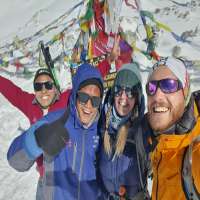
Expérience incroyable
20 jours autour du Manaslu et des Annapurna... Ou comment marquer notre voyage au Népal ! ...
Super trek !
Superbe expérience avec ce très beau trek. Le guide et le porteur ont été extrêmement sympathiques et attentifs. De très ...
Envie de revenir
Super expérience avec Terres du Nepal pour notre premier trek! Une très bonne organisation qui nous permet de profiter pleinement ...
Circuits similaires
Khopra Community Trek 11j
Ganesh Himal Ruby Valley trek 9j
Vallée de Kathmandu 5j
Panchase 6j
Mohare Danda Poon Hill 8j
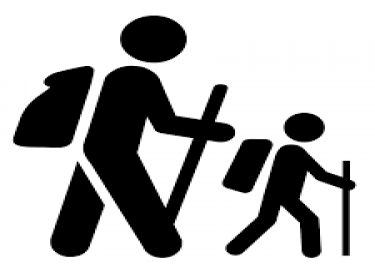
Jhinu Danda en famille 8j
Tamang Heritage 8j
Pikey Peak 9j
Ramechhap authentique 7j
Mardi Himal 9j
Sanctuaire Annapurna ABC 10-13j
Tour Annapurna 12j / 16j

Everest Base Camp 13j
Gosaikund Helambu 9j
Langtang Gosaikund 13j
Vallée Nar Phu 13j
Everest Base Camp & Gokyo 16j
Haut Mustang 15j

We use cookies to ensure that we give you the best experience on our website.

IMAGES
COMMENTS
Day 3 : Kathmandu to Maccha Khola [1,400m/4,593 ft]: 8 - 9 hours:: Our Manaslu Circuit Trek begins as we drive from Kathmandu to Machha Khola, located across the Budi Gandaki river. We will drive along the Mahesh River and Trishuli River before we continue driving toward the Maccha Khola. Overnight stay at Maccha Khola.
The Manaslu Circuit hike passes ten Himalayan peaks of more than 21,300 feet, including the 8000er, Manaslu (26,781 feet), which is the eighth-highest mountain on Earth. The Manaslu trek is a 110-mile hike that is a great alternative to Everest Base Camp hike or the Annapurna Circuit hike. The trek usually takes between 14 and 17 days.
July 10, 2023. HIKING, NEPAL. The Manaslu Circuit Trek is an off-the-beaten-path trail in the Himalayas of Nepal. The route leads you up and around the base of Mount Manaslu as you stay each night in different Tibetan villages along the way. The scenery is incredible, especially the last few days of the circuit as you reach heights of above ...
Manaslu Circuit Trek is the most beautiful as well as demanding treks in Nepal. Trekking in Manaslu is a delightful experience with a blend of adventure, scenery, culture, lifestyle, and wildlife. Located in the western part of Nepal, this trek provides you with an opportunity to encircle around the world's 8th highest massif, Mt. Manaslu.
The Manaslu Circuit Trek features everything you'd want from a classic trek in Nepal: Epic scenery, intimate encounters with local people and their ancient culture, and a 17,000-foot (5,100 m) Himalayan pass crossing. Kimkim's trusted partners in Nepal organize weekly group departures during the spring and fall trekking seasons, as well as private treks that can run on any date from February ...
Overview of the Manaslu Circuit Trek. The Manaslu Circuit Trek typically takes between 13-18 days to complete a full circuit of Mount Manaslu. The trek starts and finishes in the town of Arughat after completing a clockwise loop around the mountain. The total trekking distance is around 160km, with most days covering between 5-8 hours of walking.
Beginning in the green Himalayan foothills, the trek journeys around the eighth-highest mountain in the world, Mount Manaslu (8,163 m), and crosses over a high alpine pass to finish in the Annapurna Region. Typical Trekking Itinerary: 13-15 Days. Total Distance: 175 km.
Difficulty by Distance: Located in the west-central part of Nepal, the total distance of the Manaslu circuit covers is about 177 km. You'll be walking for 15-20km on daily basis for about 10 ...
Trekking Route: Embark on an unforgettable journey as you navigate the circuit around Mount Manaslu, the eighth-highest peak globally. The trek commences in Arughat or Soti Khola, guiding you through enchanting villages, dense forests, and high-altitude landscapes. Key stops along the route include Deng, Namrung, Lho, Samagaon, and Samdo.
If you are into remote trekking and love to push your limits, then the Manaslu circuit is one of the excellent adventure packages for you in Nepal. Tourism License: 281051/078/079 +977 9841380469
High-Altitude Rescue and Evacuation. The Manaslu Circuit Trek involves traversing high-altitude terrains, including the challenging Larke Pass. At such elevations, the risk of altitude sickness is real. Your travel insurance should cover emergency high-altitude rescue and evacuation to the nearest medical facility.
Manaslu Circuit Trek is the best for its unique culture, Buddhism, and teahouse trail which crosses Larkya La Pass 5106 m while simultaneously reaching the world's 8th highest mountain - Mt. Manaslu (8163m). The 12 Days Manaslu Circuit Trek is one of the most enthralling best seller trekking trails in Nepal just after EBC and ABC Trek.
Dans la région de Gorkha se situe un trek souvent négligé mais incroyablement beau: le Tour du Manaslu (ou Circuit du Manaslu). De la richesse culturelle aux panoramas montagneux en passant par l'endurance physique, il offre aux visiteurs tout ce qu'ils peuvent souhaiter d'une vraie aventure himalayenne. Ouvert aux randonneurs en 1991, le sentier suit …
Find the right tour package for you through Manaslu Circuit Trek. We've got 69 trips going to Manaslu Circuit Trek, starting from just 11 days in length, and the longest tour is 26 days. The most popular month to go is October, which has the most tour departures.
The Manaslu Circuit Trek in Nepal is renowned as one of the most remote and outstanding trekking routes, leading you to an impressive altitude of 5,110M. The trek takes you on an offbeat path around the eighth-highest peak in the world, Mt. Manaslu (8163 M). This trek is a paradise for those looking for a less crowded trail that takes you ...
The Manaslu Circuit Trek is one of the best trekking routes in Nepal. It retains the impression of remoteness and of being off the beaten path. This trek takes you around the Manaslu Conservation Area, leading you deep into the Himalayas, where you can explore the breathtaking view of the 8th highest mountain of the world, Manaslu at 8163 ...
Tour du Manaslu - Trek Népal - Trekking Manaslu - Tour du Manaslu ... Sur le tour du Manaslu il peut faire très chaud durant les premières étapes (moins de 1000m d'altitude), spécialement au printemps. ... Dans la partie "Address in Nepal", vous devez indiquer l'adresse de votre premier hébergement. - Royal Singi Hotel : Lal Durbar ...
18 Days. USD 1760.00 starting from. Home. Package. MANASLU TREK. Valley of Light and the Mountains of the Spirits. Through the valleys and plateaus, we leave for 13 days of walking in the heart of the Samapa country, at the foot of Manaslu (8163m): Off the beaten track in a still very wild Himalaya which gives the impression of being in Nepal ...
Népal Extension à Chitwan. 17 jours - 16 nuits. 11 jours de marche. Réalisez le tour du Manaslu, un itinéraire de trek grandiose avec les paysages exceptionnels du Népal (rizières, montagnes, glaciers) et des nuits en lodges.
Voisin du très mythique tour des Annapurnas, le trek du Manaslu est pourtant tout aussi grandiose et bien moins fréquenté. Il offre en prime un vrai tour du massif et de très nombreux points de vue sur la huitième plus haute montagne du monde et sur les sommets de l'Himalchuli. Des sentiers de la forêt subtropicale, au glacier de ...
Le Manaslu (8163 m) trône, isolé, à l'écart des foules. Comparable à bien des égards au tour des Annapurnas, le trekking du tour du Manaslu se déroule dans une vallée de moindre fréquentation. La construction récente de lodges voit ce circuit évoluer au fil des ans. La gompa (monastère) de Sama, dans un amphithéâtre au pied du ...
Le tour du Manaslu au Népal est l'un des itinéraires de trekking les plus populaires de l'Himalaya. ... La pension complète pendant toute la durée du trek. ... Nepal Society Treks and Expediton est une société française basée à Katmandou qui organise une variété de randonnées et de circuits d'aventure. Toutes nos dates sont ...
A propos Tour Manaslu 14j. Notre agence Terres du Nepal vous propose ce trek du Tour du Manaslu qui reste une destination exceptionnelle et soumise à des autorisations spécifiques. Donc peu fréquentée. C'est un des treks les plus spectaculaires du Népal autour du 5ème plus haut sommet du monde. L'itinéraire, nécessitant une bonne ...
8 likes, 0 comments - treknepal2024 on December 17, 2023: "Mount Manaslu ️ Manaslu is the eighth-highest mountain in the world at 8,163 metres (26,781 ft) above sea ...